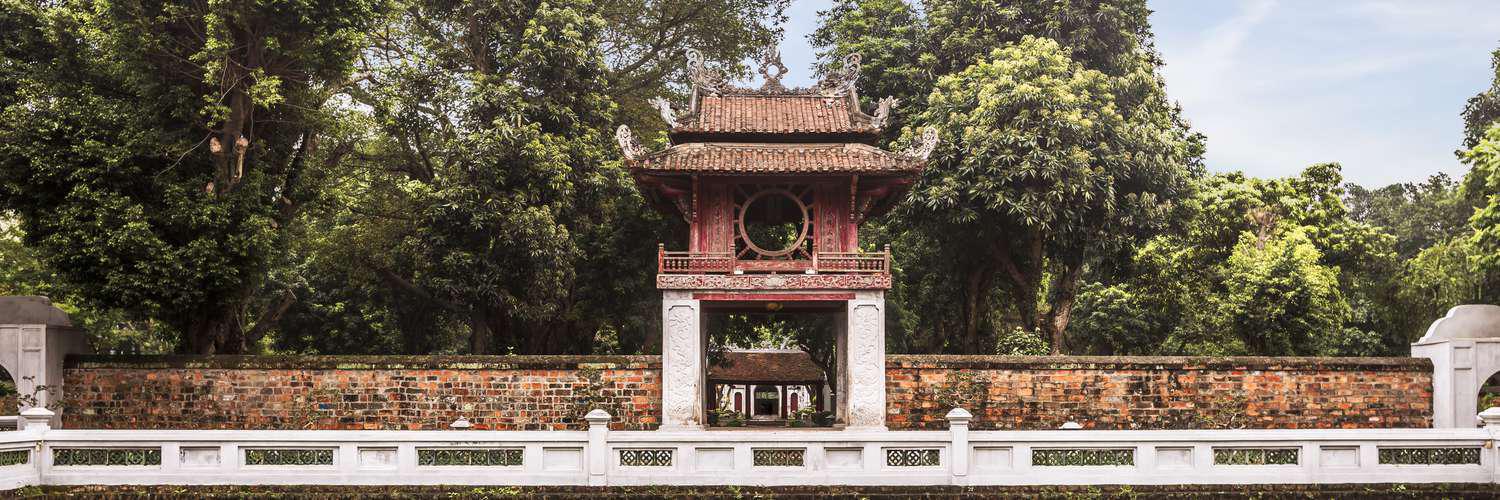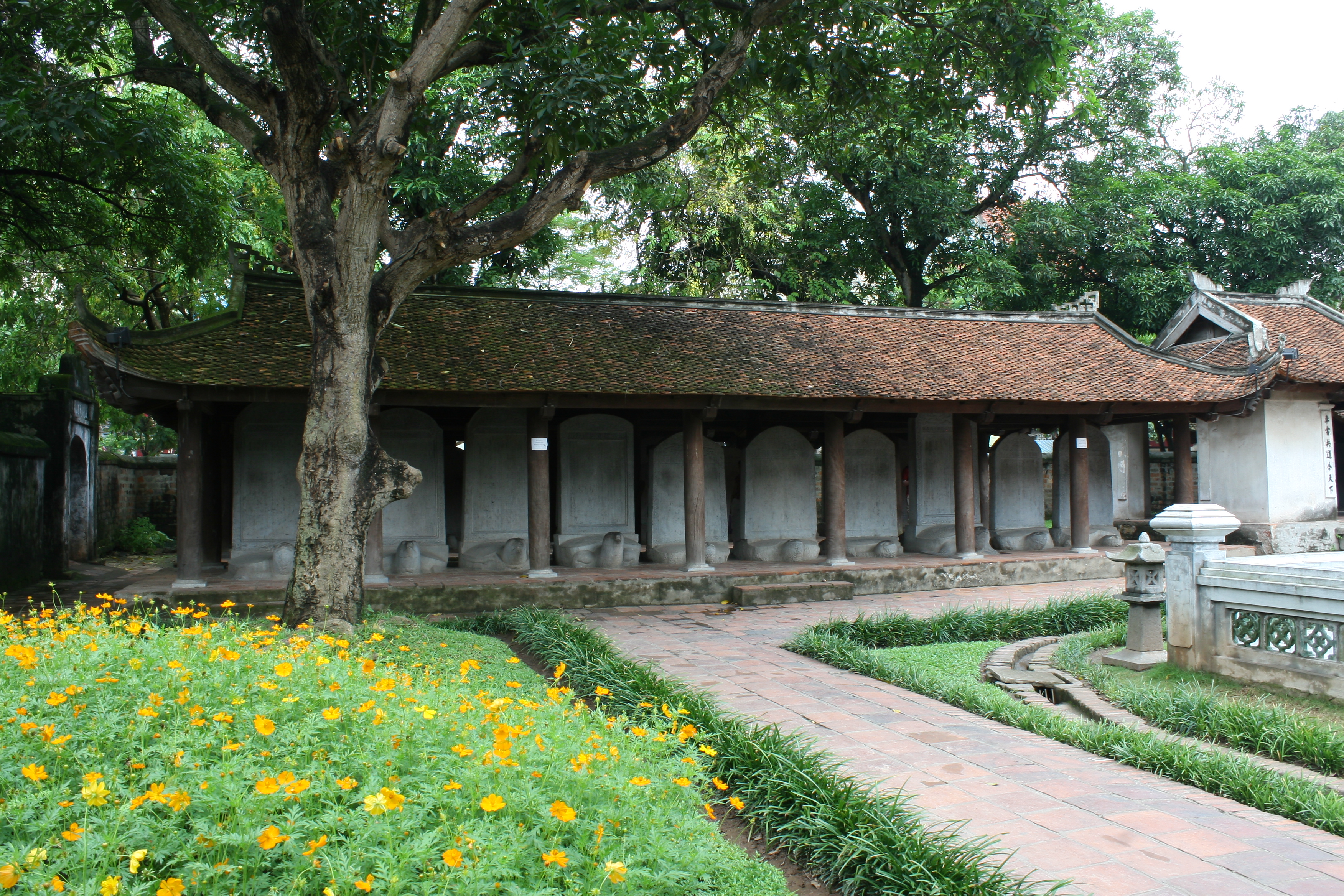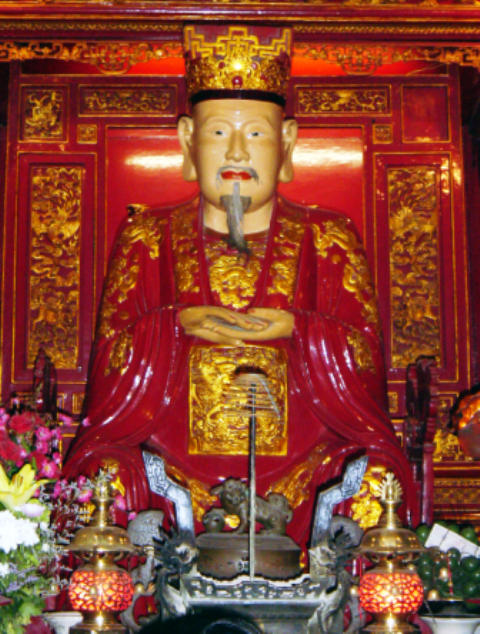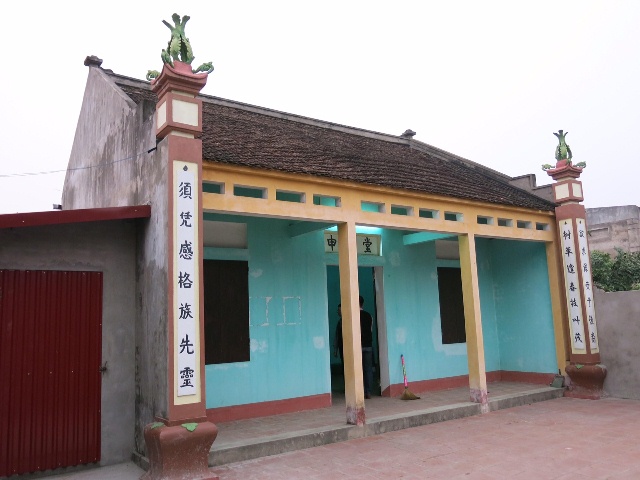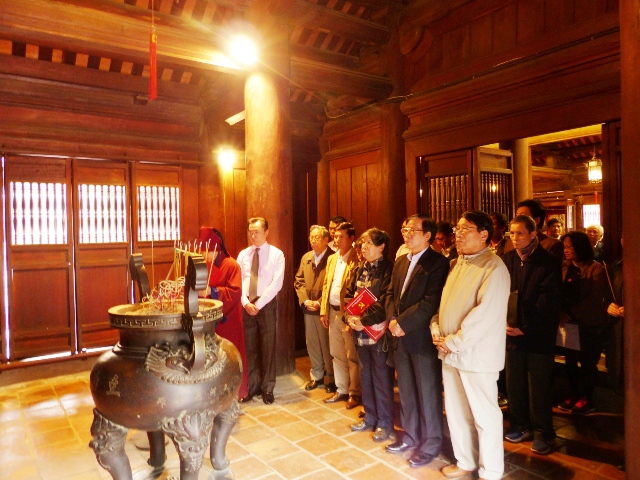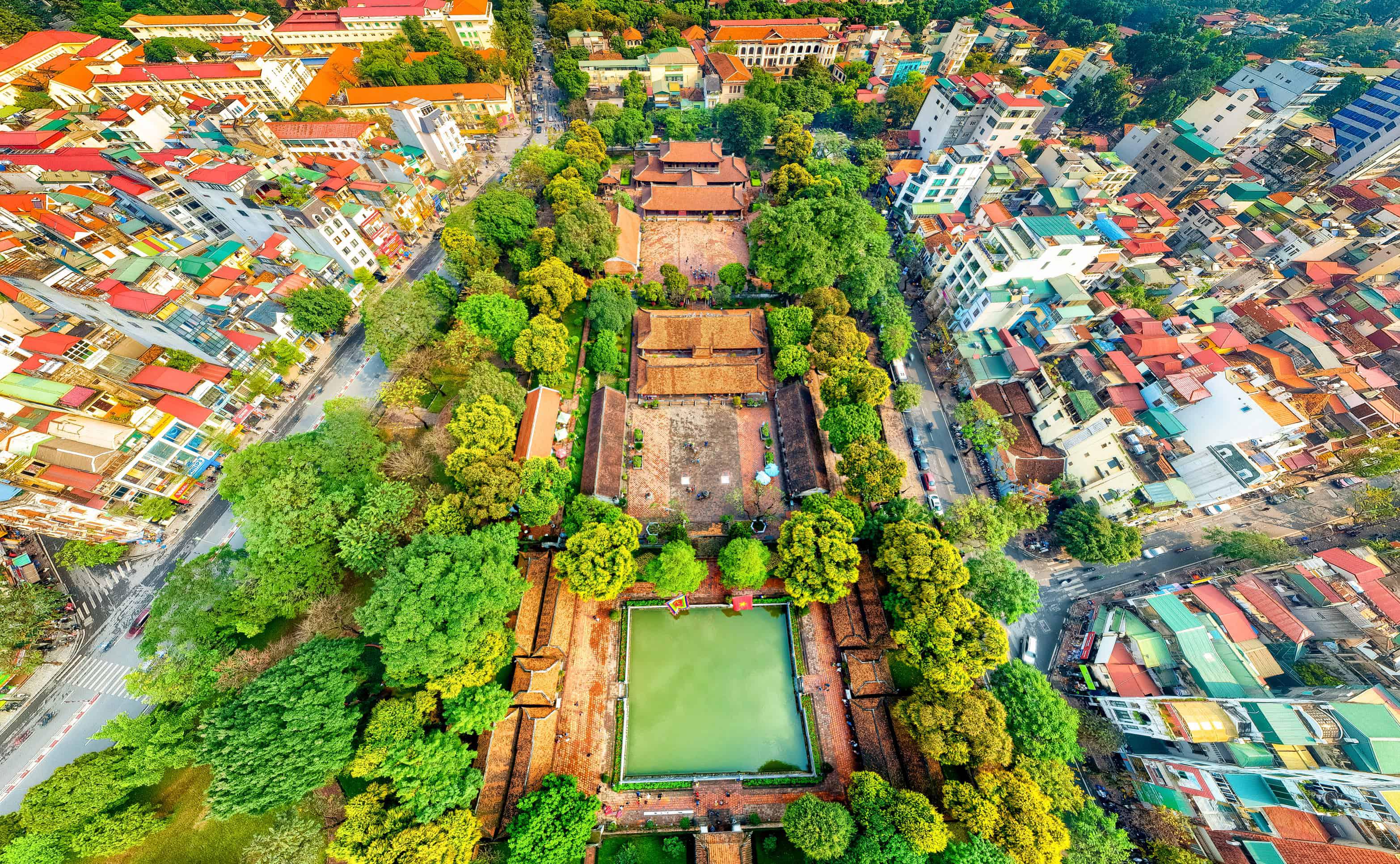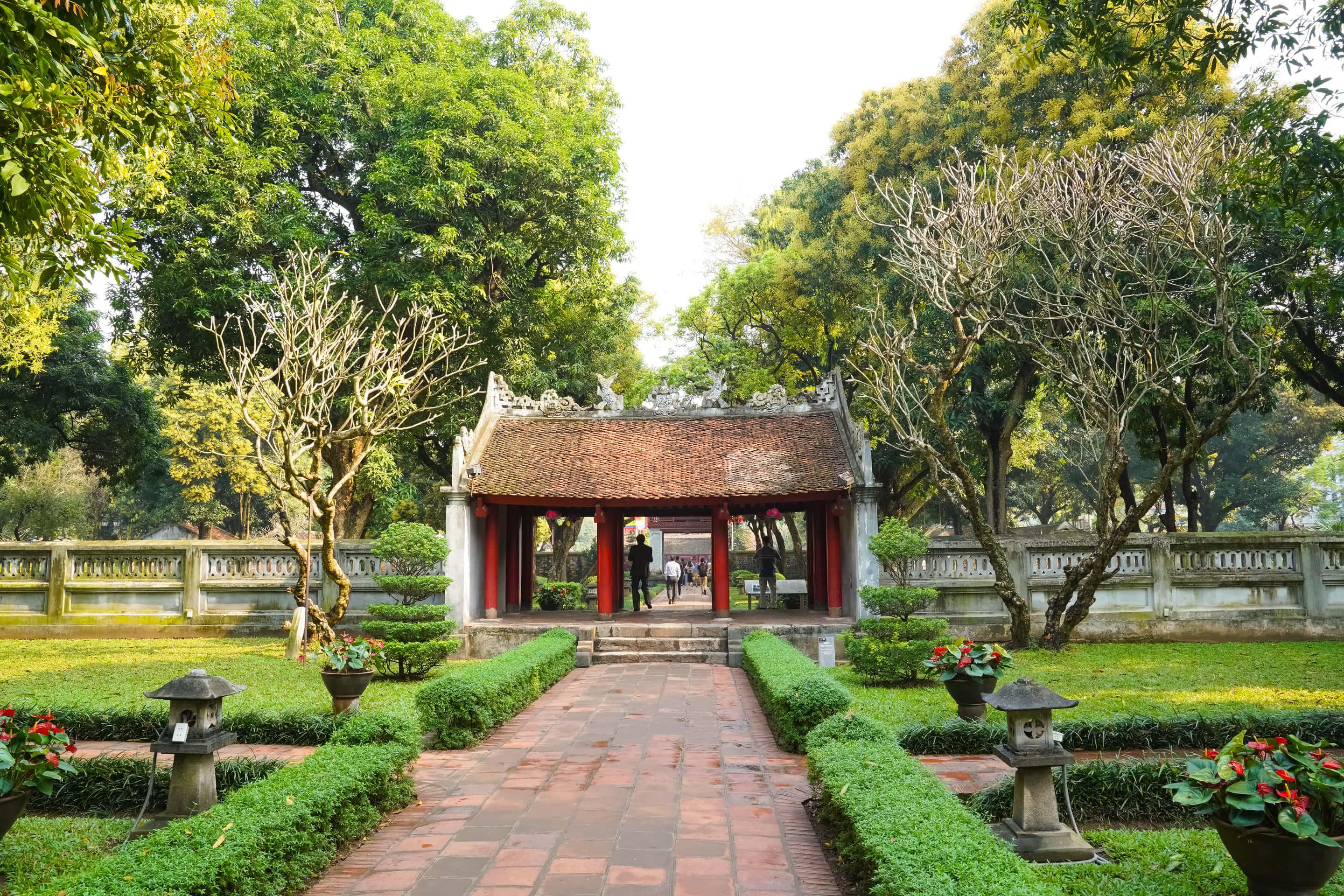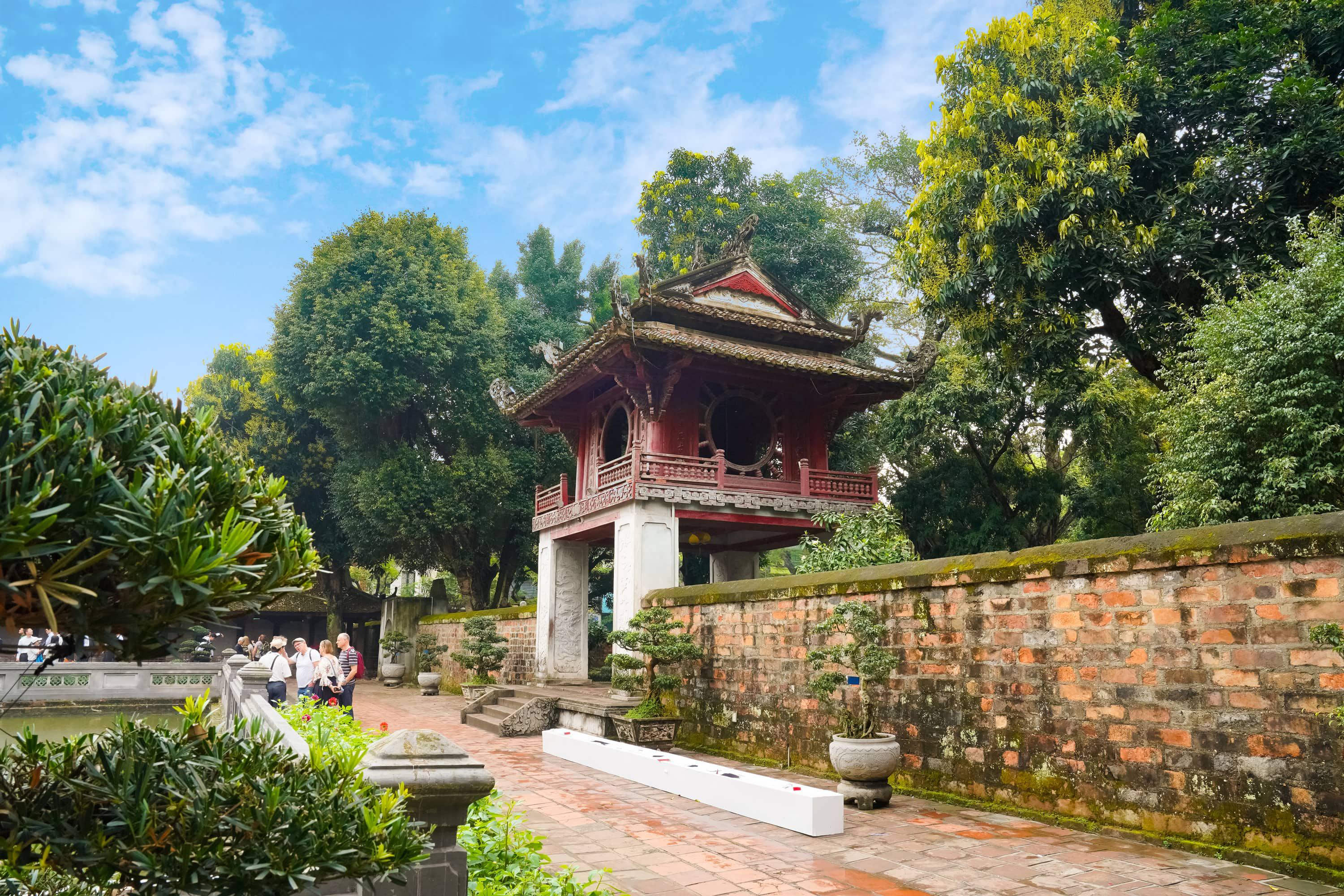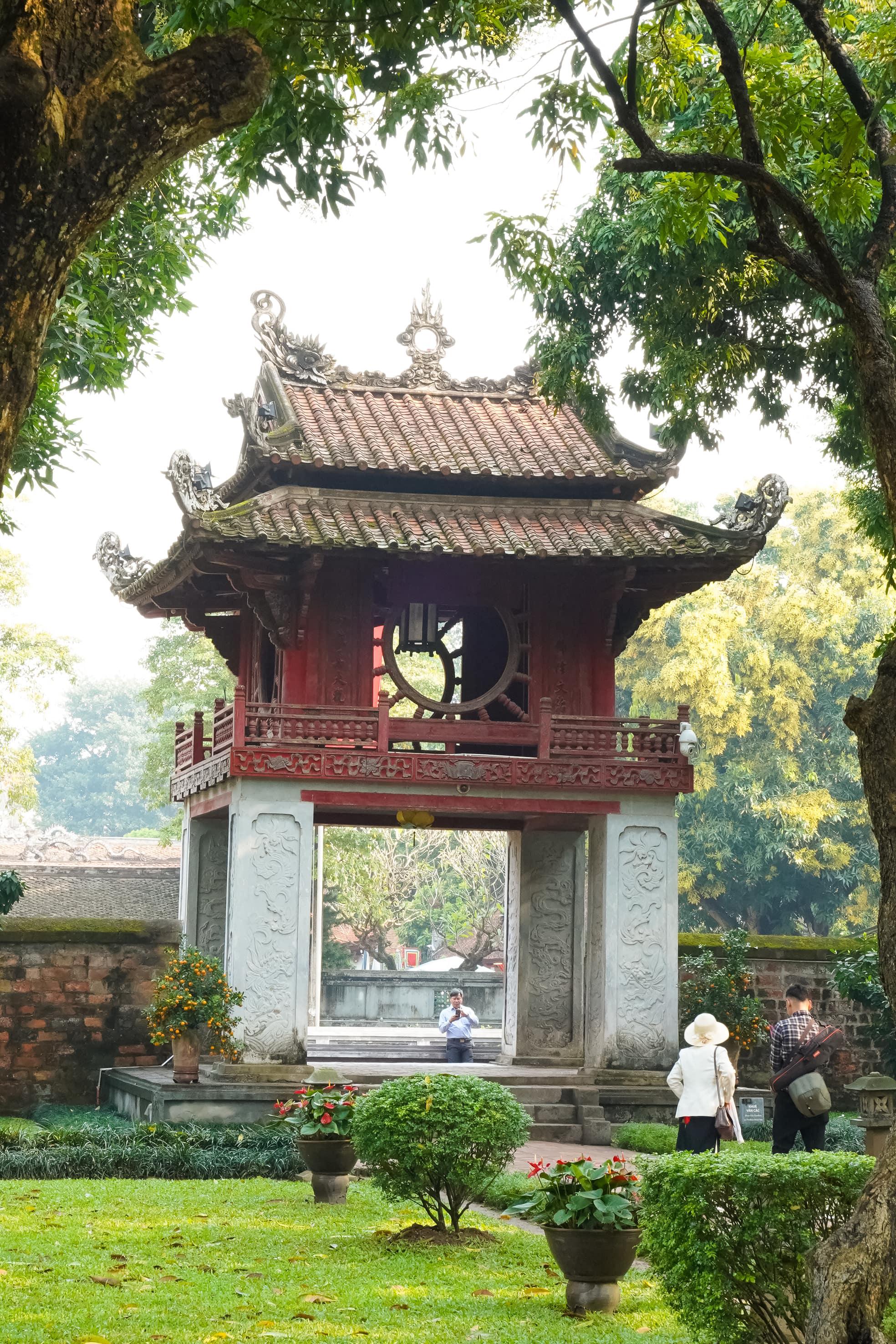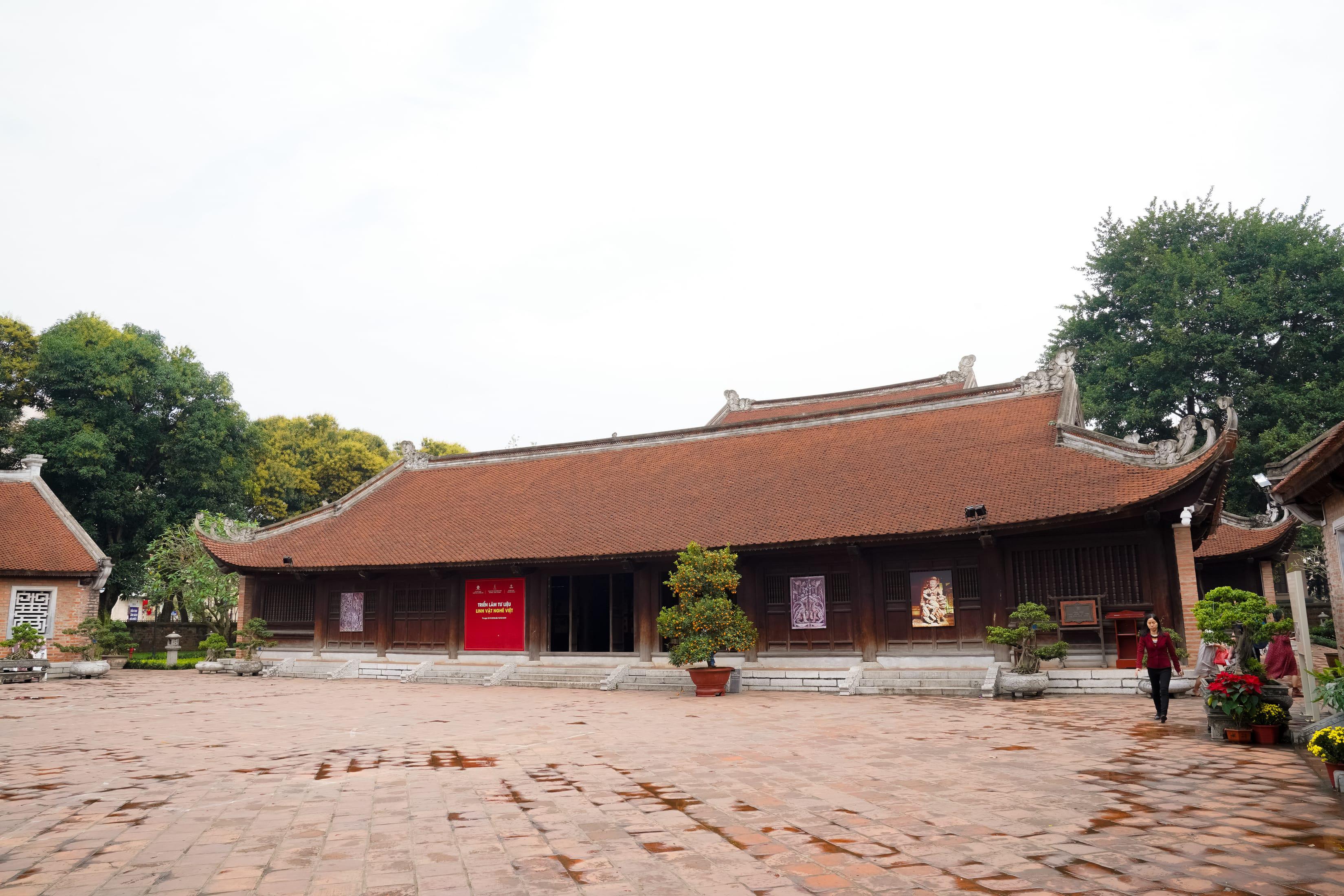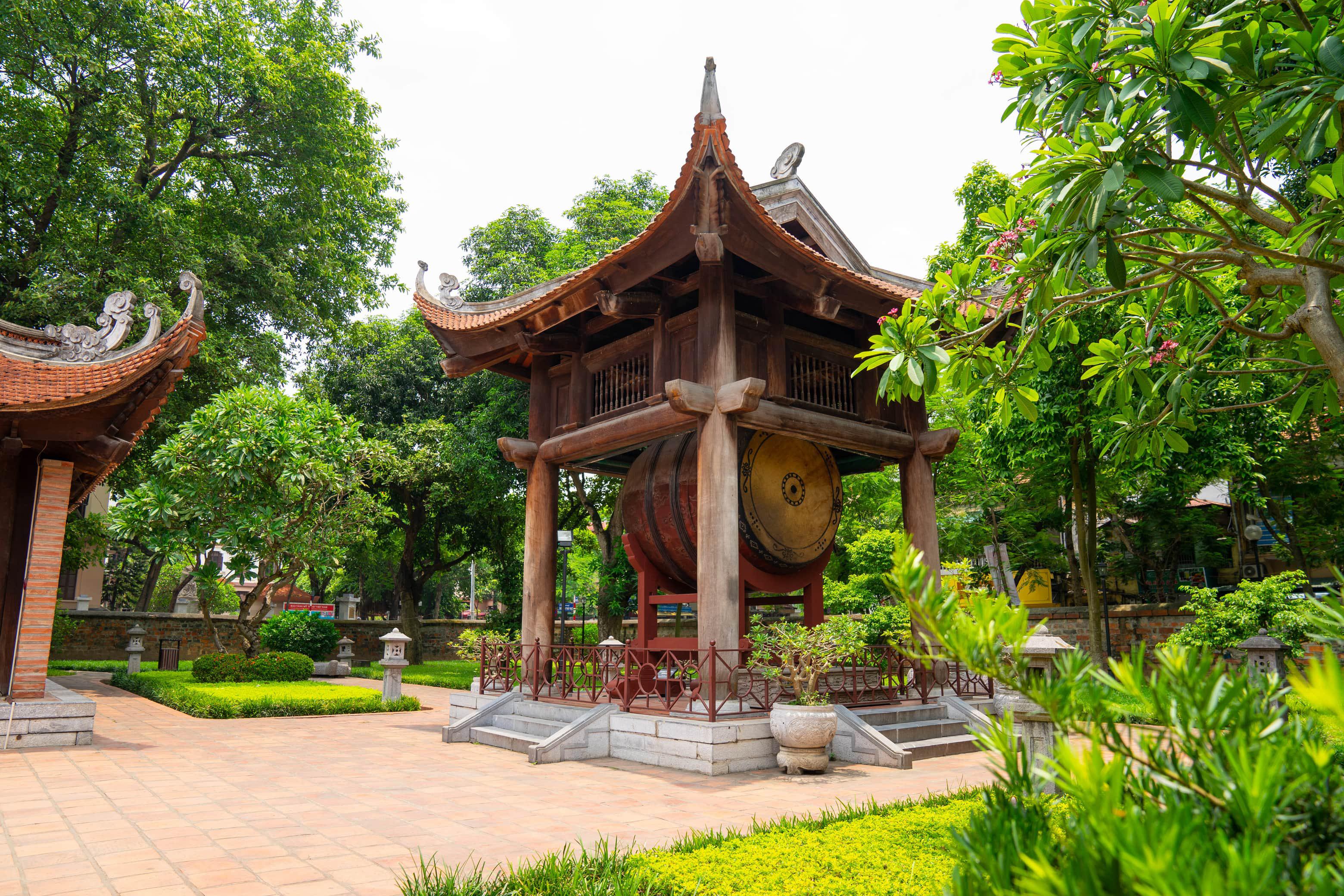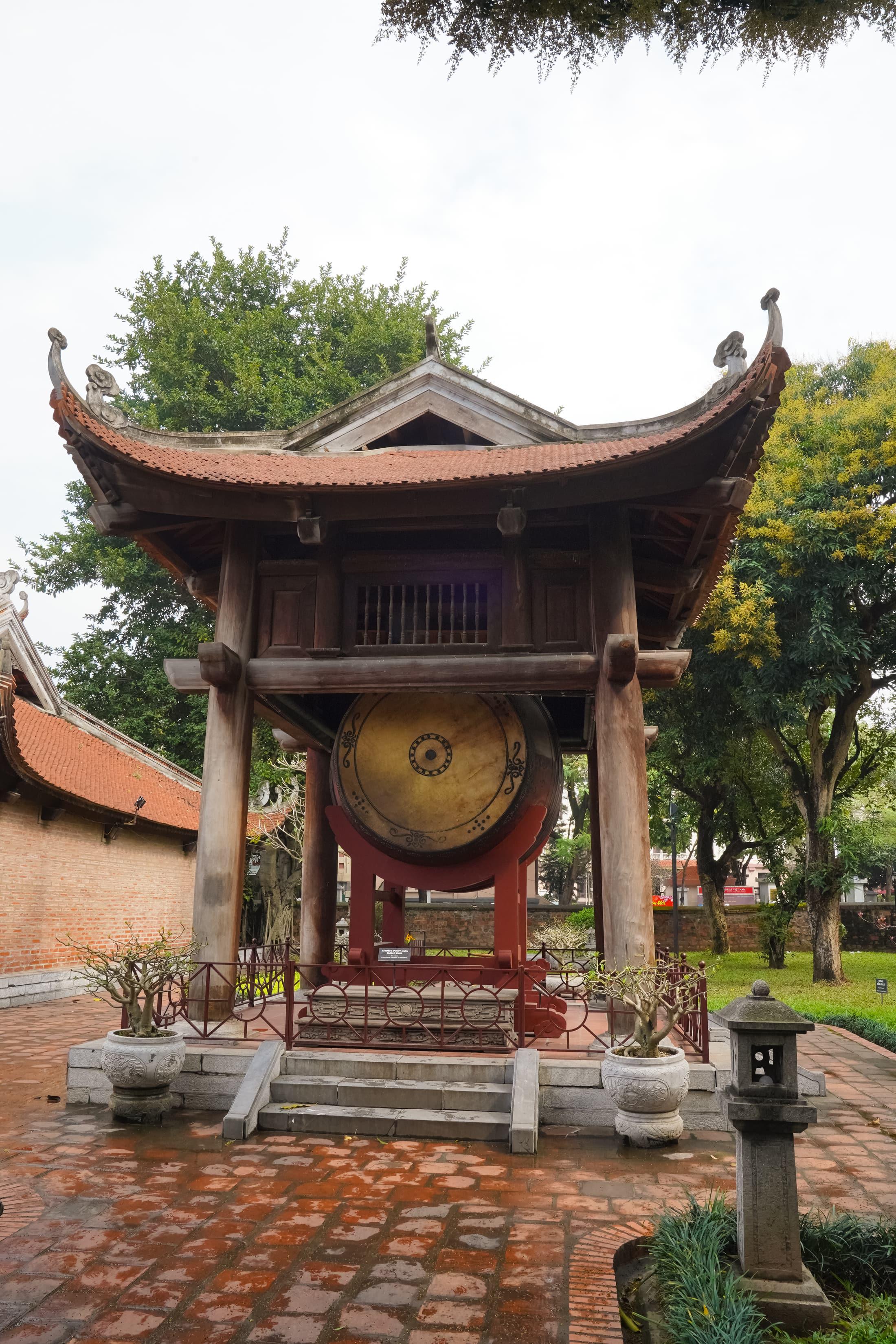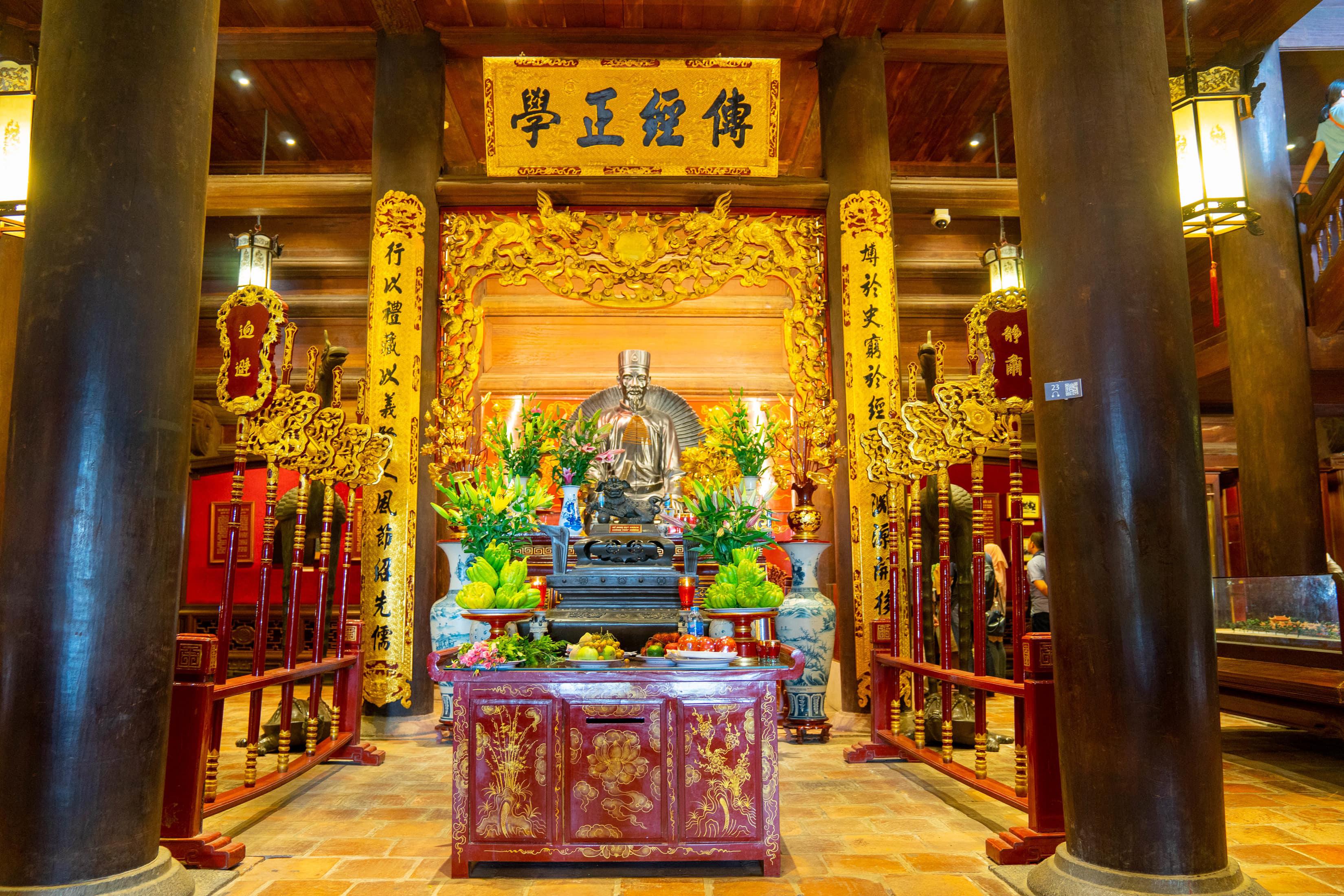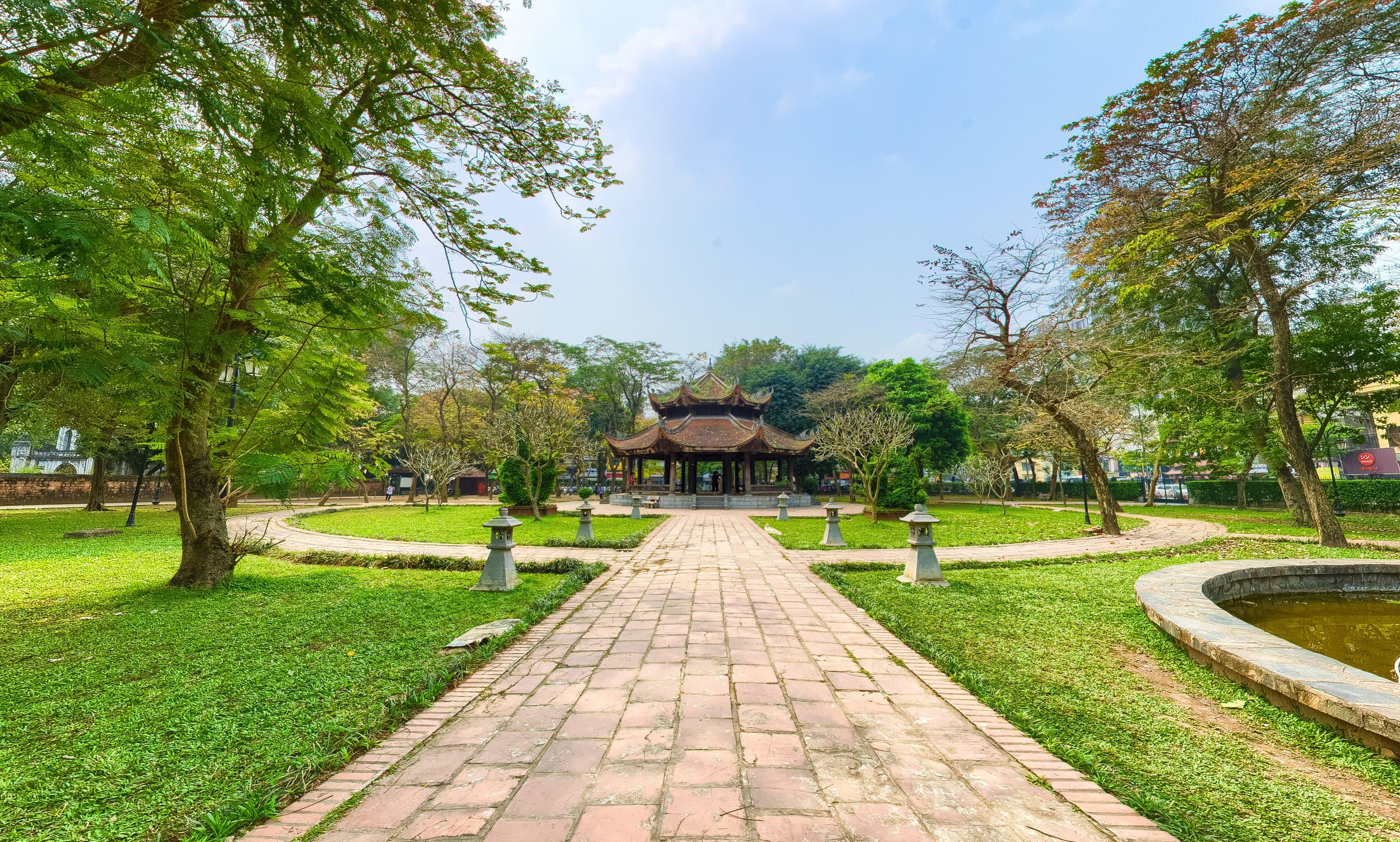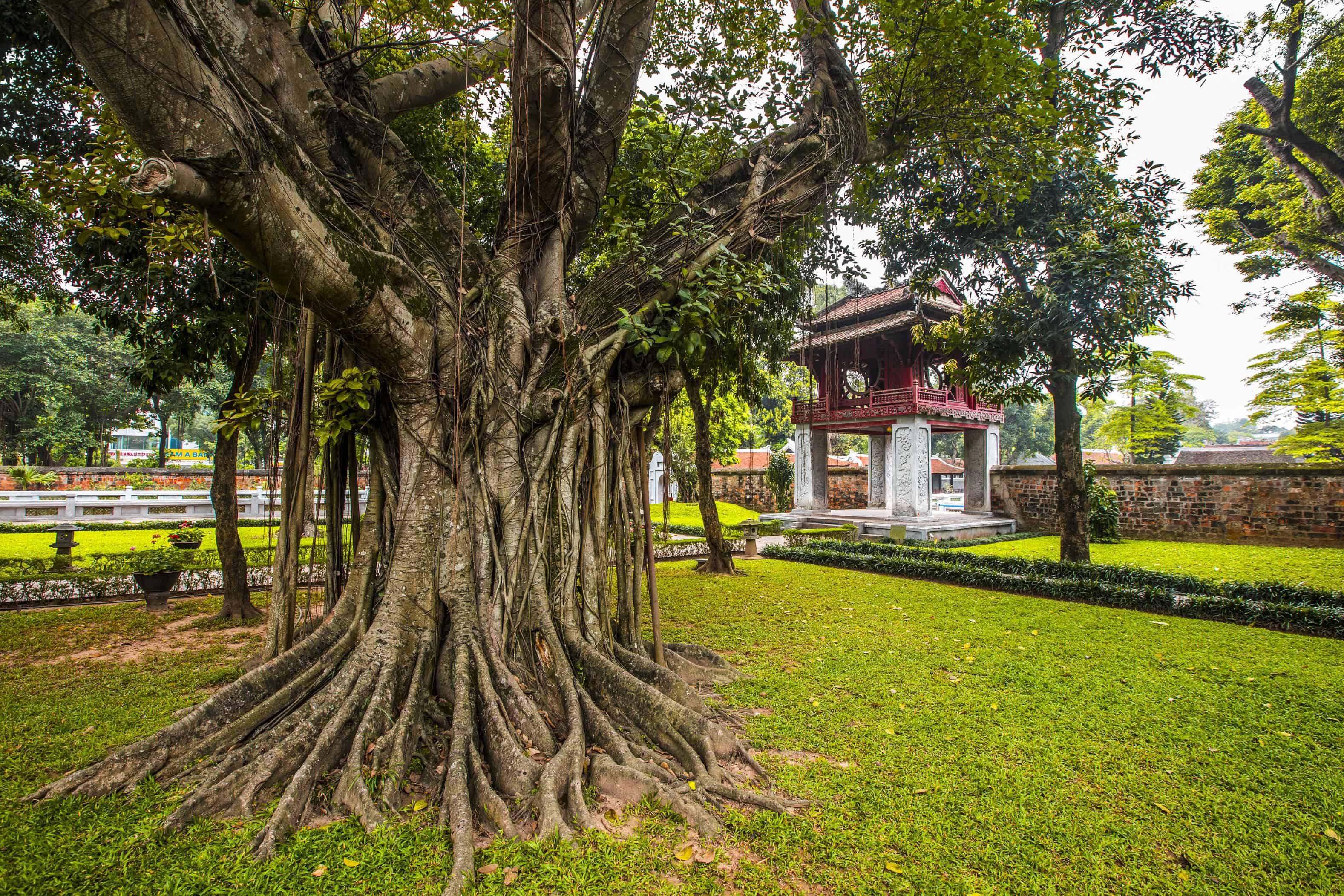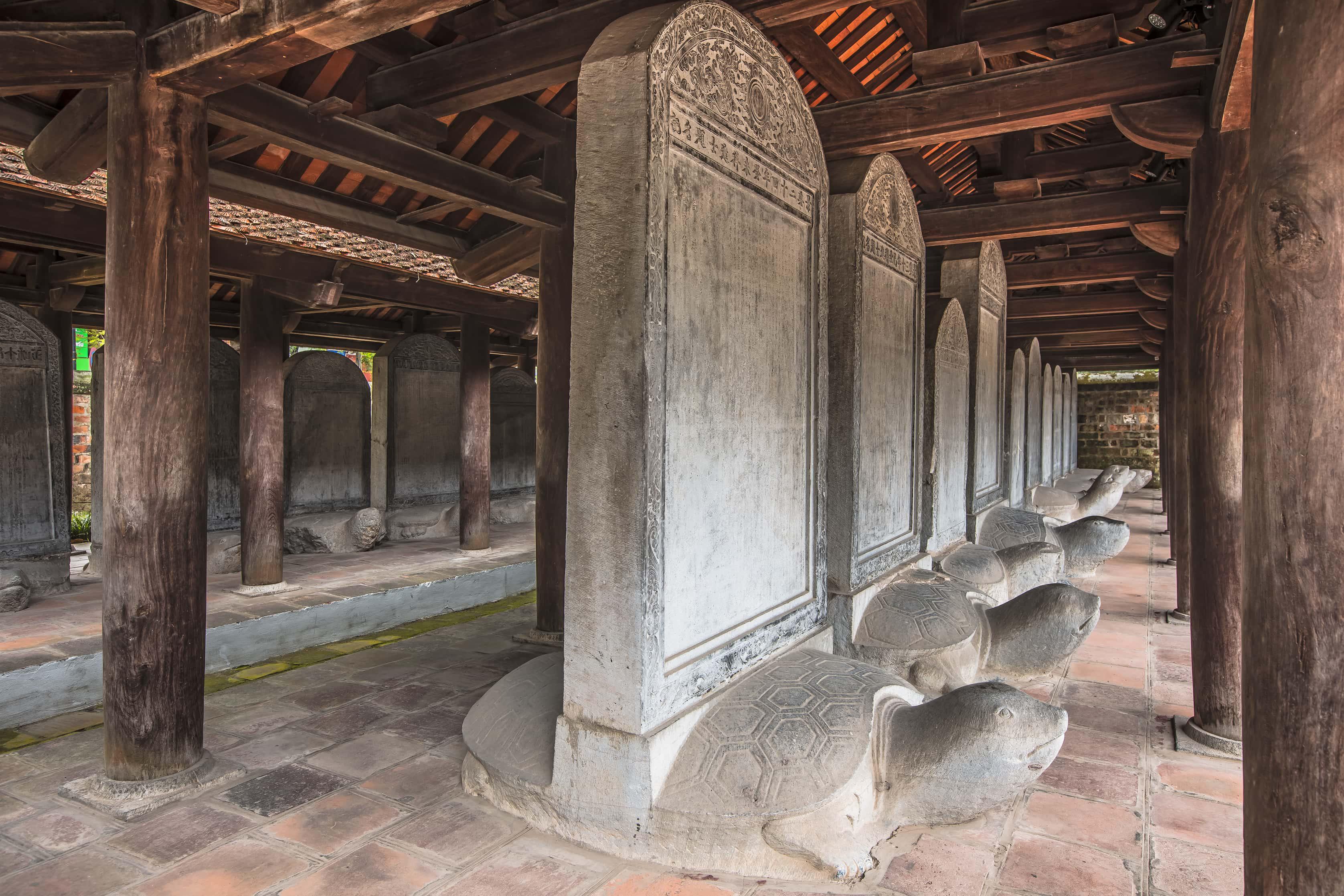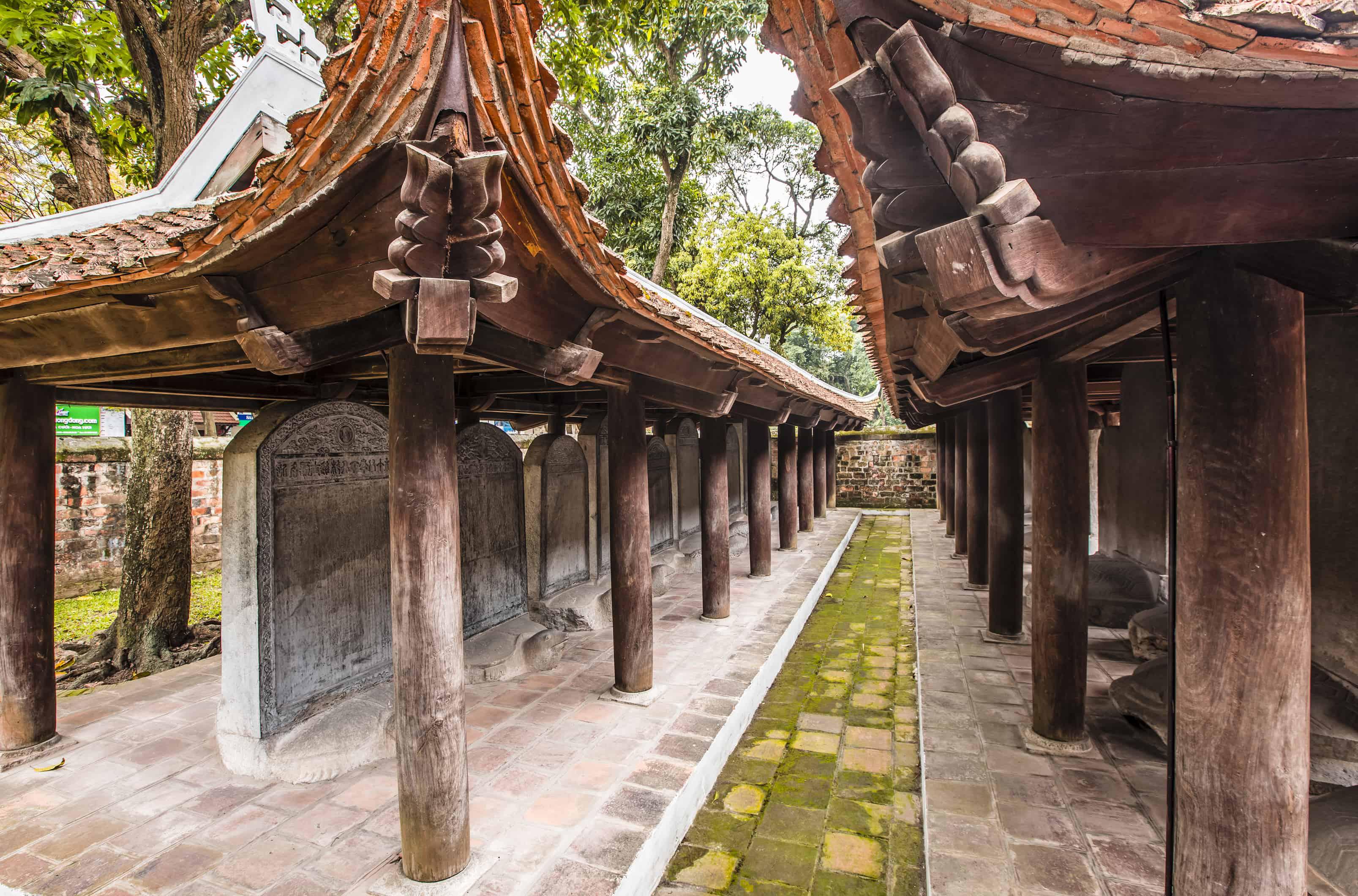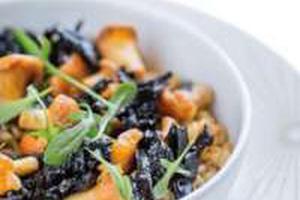FIRST-GRADE LAUREATE TRẦN SÙNG DĨNH – A YOUNG AND OUTSTANDING TALENT
The history of Vietnam’s civil service examinations under the Early Lê dynasty, particularly during the reign of His Majesty Lê Thánh Tông, is regarded as a period of remarkable prosperity and development. Within this context, many outstanding scholars emerged, contributing to the formation of a well-ordered educational system grounded in Đạo học. First-grade Laureate Trần Sùng Dĩnh stands out as a representative figure of this gifted young generation of intellectuals.
According to the book Các nhà khoa bảng Việt Nam (Vietnamese Laureates), Trần Sùng Dĩnh was born in 1465, a native of Đông Khê Commune, Thanh Lâm District (corresponding to Đông Khê Hamlet, An Lâm Commune, Nam Thanh District, former Hải Hưng Province; today part of Hải Phòng City). His registered residence was in Mẫn Nhuế Commune of the same district. He was the elder brother of Second-grade Laureate Trần Năng, indicating a family distinguished by a strong tradition of learning and examination success.
The Đinh Mùi examination, held in the 18th year of the Hồng Đức reign (1487), was one of the major Doctoral Laureate–selecting examinations under His Majesty Lê Thánh Tông, producing 60 Doctoral Laureates. In this examination, Trần Sùng Dĩnh achieved the highest honor, ranking First-grade Laureate (Đệ nhất giáp Tiến sĩ cập đệ Đệ nhất danh)—that is, Trạng nguyên—at the age of only 23.
Following his success, Trần Sùng Dĩnh was highly valued by the court and rose to the position of Minister of Finance, serving as the head of the Ministry of Finance, with responsibility for national finances, land administration, and the people’s livelihood. This appointment demonstrates that he was not only accomplished in examinations and literature but also possessed strong practical abilities and enjoyed the trust of the monarch.
In the field of literature, although his surviving works are limited in number, Trần Sùng Dĩnh nonetheless left a distinct mark. Five of his poems, composed in response to poems by His Majesty Lê Thánh Tông, are preserved in the Complete Anthology of Vietnamese Poetry (Toàn Việt thi lục) compiled by Lê Quý Đôn. The honour of exchanging poetry with the king—himself a renowned scholar and the leading figure of the Tao Đàn literary circle—reflects Trần Sùng Dĩnh’s high level of learning and his literary standing among the intellectual elite of his time.
After his death, Trần Sùng Dĩnh was venerated by the local community as a Beneficent Deity (Phúc thần), a form of posthumous honour reserved for individuals of virtue and talent who made significant contributions to the country and society. This recognition attests to his lasting influence, not only in historical records but also in the cultural life of the people.
The life and career of First-grade Laureate Trần Sùng Dĩnh offer a vivid testament to Vietnam’s enduring spirit of respect for learning and esteem for the virtuous and talented. They also contribute to the enduring values of the Vietnamese educational tradition—a tradition that has been nurtured, honoured, preserved, and continuously transmitted at Văn Miếu - Quốc Tử Giám to this day.
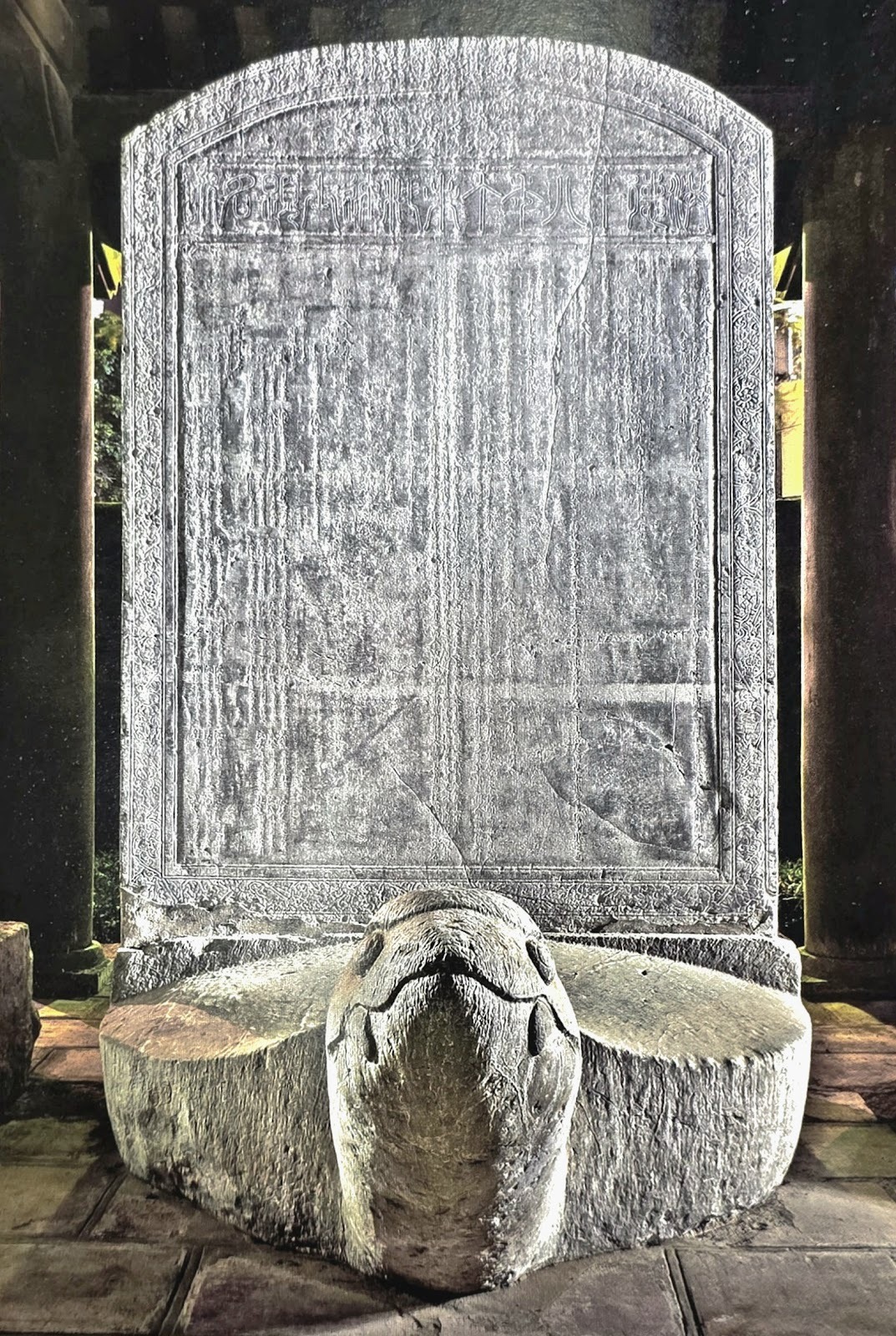
The Doctoral Laureates’ Stele of the Đinh Mùi Examination, Hồng Đức 18 (1487), at Văn Miếu - Quốc Tử Giám
Nhan Vu
TL: LH
HOÀNG GIÁP VŨ HỮU (1444 – 1530)
Vũ Hữu (1444 – 1530) tự là Ước Trai, người xã Mộ Trạch, huyện Đường An, Hải Dương (nay là xã Đường An, Hải Phòng). 20 tuổi, ông đỗ Đệ nhị giáp Tiến sĩ xuất thân khoa Quý Mùi niên hiệu Quang Thuận 4 (1463) đời Lê Thánh Tông. Ông làm quan đến chức Lễ Bộ Thượng thư. Ông là bác của Vũ Đôn, cao tổ của Vũ Lương.

Tên tuổi Hoàng giáp Vũ Hữu được vinh danh trên bia Tiến sĩ khoa Quý Mùi niên hiệu Quang Thuận 4 (1463) hiện lưu giữ tại Di tích Văn Miếu – Quốc Tử Giám
Ông là người cứng cỏi, luôn giữ mình trong sạch. Hương ước làng Mộ Trạch có quy định: Hễ ai đỗ đại khoa, dân làng góp tiền mừng con lợn, chủ nhà phải khao làng một con trâu. Khi Vũ Hữu đỗ Tiến sĩ, nhà nghèo quá nên buộc phải mua trâu khao làng mà không có tiền mua trâu cày ruộng. Chi tiết ấy không chỉ nói lên sự nghiêm cẩn của lệ làng, mà còn phản chiếu khí tiết và sự hy sinh thầm lặng của một bậc sĩ tử bước ra từ truyền thống khoa bảng.
Sau khi đỗ đạt, Vũ Hữu đã có nhiều đóng góp cho đất nước. Đời Lê Thánh Tông, ở kinh đô Thăng Long, các cửa Đoan Môn, Đại Hương, Đông Hòa của kinh thành xây từ đời Lý bị sụt lở quá nhiều. Triều đình bàn cho tu sửa lại. Vua sai ông dự trù tính toán nguyên liệu và nhân công cần thiết cho việc sửa chữa. Ông đến từng cửa thành, đo đạc chiều cao, thấp, rộng hẹp, lập phép tính và đôn đốc thi công. Sau khi tu sửa xong, nguyên vật liệu, nhân công mà ông dự trù coi như vừa đủ khiến mọi người đều phục tài. Nhà vua khen tài tính toán của ông và thưởng cho 100 mẫu ruộng, ngợi khen là “tay thần toán”.
Không chỉ là một quan lại giỏi thực hành, Vũ Hữu còn là người đặt nền móng cho việc hệ thống hóa tri thức toán học đương thời. Ông viết “Lập thành Toán pháp”, tổng hợp kiến thức hình học và số học, góp phần khẳng định vai trò của khoa học trong quản lý và xây dựng quốc gia. Dù tác phẩm này ngày nay không còn, nhưng tên tuổi của ông vẫn được ghi nhận như một nhà toán học tiêu biểu của thời Lê sơ.
Gia đình Vũ Hữu cũng có truyền thống khoa bảng, đỗ đạt cao. Con cháu ông có nhiều người đỗ Tiến sĩ. Cháu đời thứ 7 là Tiến sĩ Vũ Lương, đỗ Tiến sĩ khoa Quý Mùi (1643). Cháu đời thứ 8 là Vũ Đình Lâm, con Vũ Lương đỗ Hoàng giáp khoa Canh Thân (1670) và Vũ Trọng Trình, đỗ Tiến sĩ khoa Ất Sửu (1685). Cháu đời thứ 9 là Vũ Đình Thiều, đỗ Tiến sĩ khoa Canh Thân (1680). Cháu đời thứ 10 là Vũ Đình Ân, đỗ Tiến sĩ khoa Nhâm Thìn (1712). Hiện nay, tại Văn Miếu – Quốc Tử Giám vẫn còn bia Tiến sĩ khắc tên Vũ Hữu cùng năm người cháu của ông – như một minh chứng sinh động cho truyền thống hiếu học, tinh thần hiền tài và sự tiếp nối bền vững của một dòng họ gắn bó sâu sắc với lịch sử khoa cử của dân tộc.
An Nhiên
Tham khảo:
-
Các nhà khoa bảng Việt Nam, Ngô Đức Thọ, NXB Văn học
2. Công dư tiệp ký - quyển 1, Vũ Phương Đề, NXB Giáo dục
HOÀNG GIÁP NGÔ NGỌC – THE PIONEER OF THE SCHOLARLY TRADITION OF VỌNG NGUYỆT VILLAGE
Hoàng giáp Ngô Ngọc (1455–?), literary name Tiềm Xuyên, was a native of Vọng Nguyệt village, Yên Phong district, Bắc Ninh province (now Tam Giang commune, Bắc Ninh province). He was one of the most outstanding figures in the Kinh Bắc region, the first to earn the Doctoral Laureate degree in Vọng Nguyệt, and is regarded as the founding laureate of the Ngô lineage in this locality.
According to the genealogy of the Ngô family, his father, Ngô Nguyên, originally came from Tam Sơn Commune, Đông Ngàn District (now Tam Sơn Ward, Bắc Ninh Province). During the reign of Lê Thái Tông (1433–1442), Ngô Nguyên settled in Vọng Nguyệt village and received protection and assistance from a Chu clan official, a descendant of the Chu lineage’s founding ancestor in the area. Recognising Ngô Nguyên as a dignified man of exceptional aptitude, this Chu official married his daughter, Chu Thị Bột, to him.
Ngô Ngọc grew up in a household marked by strict moral discipline and propriety: his father devoted himself wholeheartedly to service at court, while his mother was a virtuous and capable woman, praised as a model of “chaste widowhood from a distinguished family” (tiết phụ tinh môn). Notably, his maternal grandfather, a learned official of the Chu family, personally instructed and guided Ngô Ngọc from an early age. This solid foundation proved decisive, nurturing his commitment to learning and enabling his advancement along the path of the civil service examinations.
At the age of thirty-three, Ngô Ngọc sat for the National Examination and was awarded the degree of Second-ranked Doctoral Laureate (Hoàng giáp) in the Đinh Mùi examination of Hồng Đức 18 (1487), under the reign of Lê Thánh Tông. This achievement marked a milestone in the intellectual maturation of Vọng Nguyệt village within the Confucian scholarly tradition of the Early Lê dynasty. Prior to Ngô Ngọc, the town had never produced the Doctoral Laureate examinations. His success not only inaugurated the Ngô family’s illustrious scholarly tradition but also laid the cornerstone for the examination heritage of the entire village.
After attaining his degree, he was appointed to the Lễ khoa (Office supervising the Ministry of Rites) with the rank of Đô Cấp sự trung. The system of the Six Supervisory Offices (Lục khoa) was instituted from the reign of Nghi Dân (1459), originally comprising Trung thư khoa, Hải khoa, Đông khoa, Tây khoa, Nam khoa, and Bắc khoa. During the Hồng Đức era, the administrative system was revised: Trung thư khoa became Lại khoa, Hải khoa Hộ khoa, Đông khoa Lễ khoa, Nam khoa Binh khoa, Tây khoa Hình khoa, and Bắc khoa Công khoa. Each office was headed by a Đô Cấp sự trung (Senior Supervising Secretary, upper seventh rank) and assisted by Cấp sự trung (Supervising Secretary, upper eighth rank). Subsequent dynasties followed this arrangement without alteration.
The responsibilities of these offices centred on inspection and supervision over law, regulations, and administrative conduct from the central government down to provincial, district, and communal levels. Although modest in rank, the Đô Cấp sự trung of the Six Offices held significant authority, including the right to impeach officials for misconduct and, together with the Ngự sử đài (Procurator), to recommend, evaluate, and assess officials during periodic performance reviews.
The post of Đô Cấp sự trung entailed heavy responsibilities, overseeing a ministry charged with crucial domains such as court ritual, diplomacy, education, and the civil service examinations. The officeholder was required to be thoroughly versed in ceremonial institutions, knowledgeable about customs and cultural practices, and adept in dealings with officials of higher rank. That the court entrusted Ngô Ngọc with leadership of the Lễ khoa attests to his erudition, rigour, and sound judgment. In recognition of his enduring service and exemplary moral character, he was posthumously conferred the title Đặc tiến Kim tử Vinh lộc Đại phu.
Beyond his official career, Hoàng giáp Ngô Ngọc was also a great teacher within his family. He instructed his descendants, fostering a spirit of reverence for learning, and became a moral and intellectual pillar of both lineage and village. Owing to the scholarly foundation he established, the Ngô family achieved the rare distinction of “five successive generations of laureates” in the history of the examinations.
The succeeding generations attained distinction as follows:
His son, Ngô Hải (Ngô Nhân Hải), attained the degree of Second-ranked Doctoral Laureate (Hoàng giáp) in the Mậu Thìn examination of Đoan Khánh 4 (1508), under Lê Uy Mục.
His eldest grandson, Ngô Trừng (1540–?), achieved first place in the National Examination (Hội nguyên) and was awarded the degree of Second-ranked Doctoral Laureate in the Canh Thìn examination of Diên Thành 3 (1580), during the reign of Mạc Mậu Hợp.
Ngô Nhân Triệt (courtesy name Mai Hiên, sobriquet Thịnh Đức), eldest son of Ngô Trừng, achieved first place in the National Examination and attained the degree of Third-ranked Co-laureate Doctor (Đệ tam giáp Đồng Tiến sĩ xuất thân) in the Đinh Mùi examination of Hoằng Định 8 (1607), under Lê Kính Tông.
Ngô Nhân Tuấn (1595–?), son of Ngô Nhân Triệt, attained the degree of Third-ranked Co-laureate Doctor in the Canh Thìn examination of Dương Hòa 6 (1640), during the reign of Lê Thần Tông.
Thus, from Hoàng giáp Ngô Ngọc to the fifth generation represented by Ngô Nhân Tuấn, the Ngô family produced Doctoral Laureates without interruption. The eminent scholar Phan Huy Chú respectfully recorded: “Vọng Nguyệt village of Yên Phong district has the Ngô family; beginning with Ngô Ngọc, who attained the principal list in the Hồng Đức era, five successive generations passed the Doctoral Laureate examinations—truly a rarity through the ages.”
Endowed with keen intelligence, profound learning, and austere moral integrity, Hoàng giáp Ngô Ngọc not only brought honour to his lineage and homeland but also opened the path for the enduring scholarly tradition of Vọng Nguyệt village. His name is inseparably linked with the Confucian learning of Kinh Bắc, standing as an enduring testimony to the spirit of learning and aspiration sustained across centuries.
Tài liệu tham khảo:
-
Phan Huy Chú, Lịch triều hiến chương loại chú, tập I
-
Đại Việt sử ký toàn thư, tập II, Nxb Khoa học xã hội, H.2011, tr. 495.
-
Đại Việt sử ký toàn thư, tập II, sđd, H.2011, tr. 449.
-
Ngô Đức Thọ (Chủ biên), Văn Miếu – Quốc Tử Giám và 82 bia Tiến sĩ, 2002
-
Ngô Đức Thọ (Chủ biên), Các nhà khoa bảng Việt Nam. NXB Văn Học, 1993
-
Trung tâm hoạt động VHKH Văn Miếu – Quốc Tử Giám, Hội thảo khoa học: Truyền thống văn hóa, khoa bảng dòng họ Ngô làng Vọng Nguyệt,Yên Phong, Bắc Ninh.
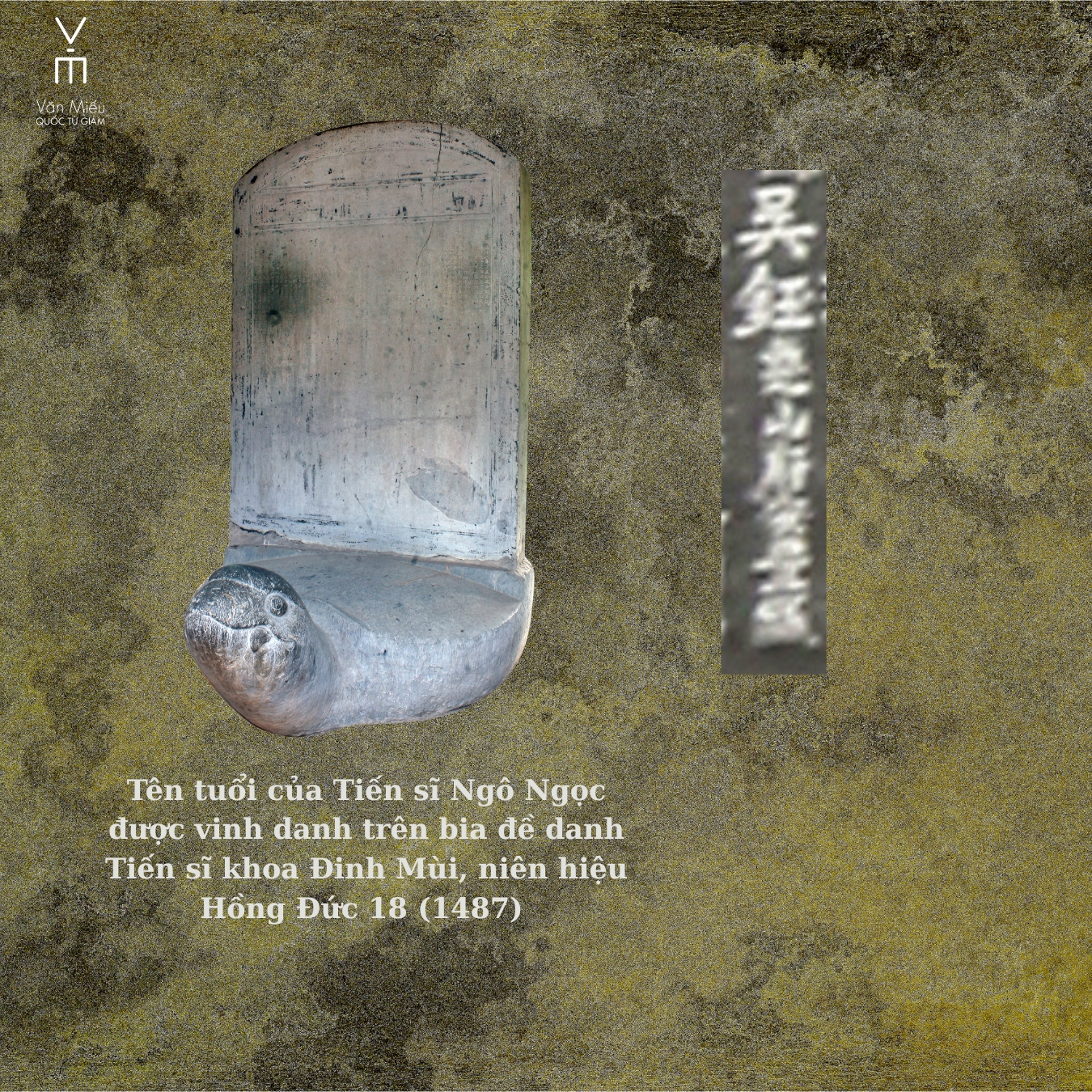
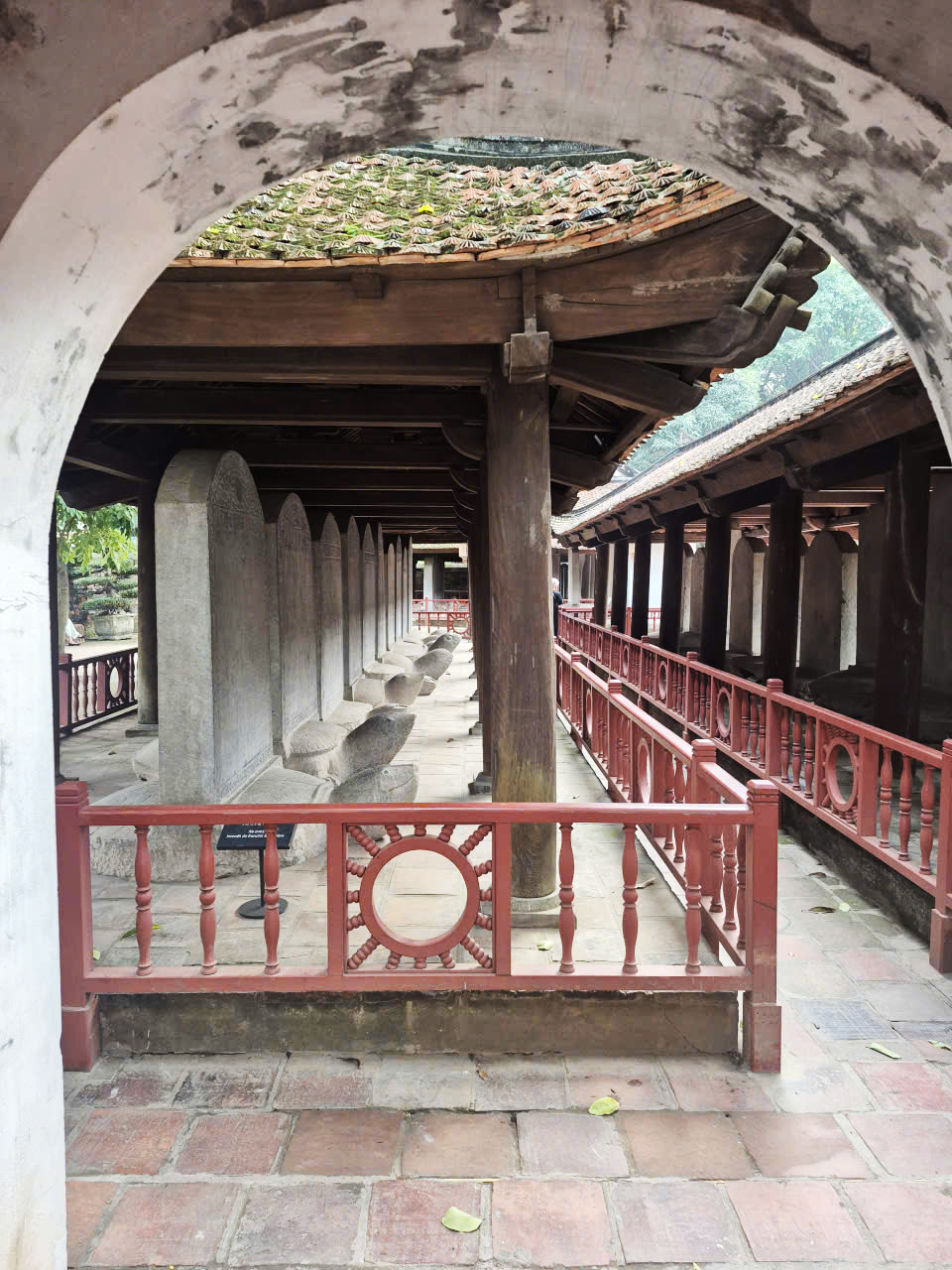
Dãy nhà bia nơi đặt tấm bia khoa Đinh Mùi, niên hiệu Hồng Đức 18 (1487)
LH
RECTOR OF QUỐC TỬ GIÁM HÀ CÔNG TRÌNH
Hà Công Trình (1434–1511), also known as Hà Tông Trình, courtesy name Tuấn Nghị, sobriquet Master Đồng Giang, was a distinguished statesman, eminent Confucian scholar, and exemplary educator of the Early Lê dynasty. He was born in Đông Tỉnh village, Phù Lưu Canton, Thiên Lộc District, Nghệ An Prefecture, a locality now part of Tùng Lộc Commune, Hà Tĩnh Province.
He came from a prestigious lineage renowned for its loyalty and integrity. His great-grandfather, Hà Mại, held the title Phụ quốc Thượng tướng quân and the rank of Thượng vị hầu, serving as the military governor of Nghệ An. He rendered excellent service during the resistance war against the Ming invasion in the early fifteenth century. His grandfather, Hà Tông Chính, titled Hoàng bảng Đại tướng quân, was likewise an accomplished general during the Early Lê dynasty. Raised in an illustrious family steeped in patriotism, loyalty to the throne, and scholarly cultivation, Hà Công Trình received a classical Confucian education early on, imbued with the virtues of loyalty and filial piety, and firmly set his life's ambition on the path of learning and state service.
At the age of thirty-three, he attained the degree of Đệ nhị giáp Tiến sĩ xuất thân (Second-Grade Doctoral Laureate, commonly called Hoàng giáp) in the Bính Tuất National Examination of the 7th year of Quang Thuận (1466), under the reign of King Lê Thánh Tông – the apex of a flourishing era renowned for its meritocratic policies and reverence for governance through literary learning. After receiving his degree, he was appointed to various important positions, including Minister of Public Affairs (Thượng thư Bộ Công), Minister of Justice (Thượng thư Bộ Hình), and Minister of Military Affairs (Thượng thư Bộ Binh). He was at times entrusted with the honourable post of Nhập thị Kinh diên, which allowed him to enter the palace to lecture to the Crown Prince and the King.
In 1498, upon the accession of King Lê Hiến Tông, he concurrently assumed the position of Nhập nội Kinh diên and Rector (Tế tửu) of Quốc Tử Giám, the supreme educational institution of the realm. According to the Đại Việt sử ký toàn thư and the Doctoral Laureates' stele of the Nhâm Tuất (1502) examination still preserved at Văn Miếu – Quốc Tử Giám, his name appears alongside the high officials who served as principal examiners that year: "Minister of Rites, Left Instructor of the Left Spring Palace, concurrently Grand Academician of the Eastern Pavilion Đàm Văn Lễ; Minister of Rites, concurrently Reader-in-Waiting of the Imperial Academy and Director of the Imperial Academy Nguyễn Bảo; Left Vice Minister of Rites, concurrently Academician of the Eastern Pavilion Lê Ngạn Tá; Rector of Quốc Tử Giám Hà Công Trình; Director of Studies Hoàng Bồi; Court Gentleman of the Ministry of Ceremonies Nghiêm Lâm, who presented the examination papers."
As Rector, Hà Công Trình, together with other academic officials, contributed to the consolidation and refinement of the national Confucian educational system. He participated in the compilation, adjustment, and standardisation of examination regulations, particularly those governing the Regional Examinations (thi Hương), and clearly defined the qualifications of candidates and the responsibilities of examination officials to ensure fairness and integrity. The regulations and principles he helped to formulate and implement were duly recognised by the court of Lê Hiến Tông and adopted as models, thereby upholding a righteous and disciplined scholarly environment.
In the Nhâm Tuất (1502) Doctoral Laureates Examination, he was appointed Độc quyển during the Royal Examination (thi Đình)—a crucial role involving the reading of candidates' essays before His Majesty, offering assessments, and advising on the final ranking. This position was reserved only for scholars of profound learning and upright virtue, typically those holding senior posts within Quốc Tử Giám, such as Rector or Director of Studies. His appointment clearly attested to his scholarly prestige and moral integrity.
Alongside his work administering Quốc Tử Giám, Hà Công Trình enjoyed the absolute trust of the monarch, being repeatedly assigned the prestigious duty of Nhập thị Kinh diên, personally instructing the Crown Prince within the palace—an honour bestowed only upon the most virtuous and erudite scholars.
In 1504, at the age of seventy, he was granted retirement, thus concluding a life devoted to education and the Confucian civil service. He passed away on the 19th day of the First Month, Tân Mùi (1511), at the age of seventy-seven.
Throughout more than seven decades of life, Hà Công Trình stood as a model of upright service, wholly dedicated to the court and to the nation's learning. His name is solemnly inscribed on the Doctoral Laureates' steles at Văn Miếu – Quốc Tử Giám, forever honoured as an erudite Rector and venerable teacher who contributed significantly to the educational tradition of Đại Việt during the Early Lê dynasty.

Tài liệu tham khảo:
-
Ngô Đức Thọ (chủ biên), Các nhà khoa bảng Việt Nam, NXB Văn học, 2006, tr. 102
-
Quốc sử quán triều Nguyễn, Khâm định Việt sử thông giám cương mục, Nxb Khoa học Xã hội, 1998, tập I, tr. 1162.
-
Đại Việt sử ký toàn thư, tập II, Nxb Văn hóa – Thông tin, Hà Nội, 2004, Tr. 147.
-
Hội thảo khoa học Tế tửu, Tư nghiệp Quốc Tử Giám Thăng Long, 2015
LH
TẾ TỬU QUỐC TỬ GIÁM HÀ CÔNG TRÌNH
Hà Công Trình (1434 – 1511), còn có tên là Hà Tông Trình, tự Tuấn Nghị, hiệu Đồng Giang tiên sinh, là một danh thần, danh Nho và danh sư tiêu biểu của triều Lê sơ. Ông sinh ra tại xã Đông Tỉnh, tổng Phù Lưu, huyện Thiên Lộc, trấn Nghệ An; nay thuộc xã Tùng Lộc tỉnh Hà Tĩnh.
Ông xuất thân trong một gia đình vọng tộc nhiều đời trung nghĩa. Cụ nội là Hà Mại, từng giữ chức Phụ quốc Thượng tướng quân, tước Thượng vị hầu, trấn thủ Nghệ An – người có công lớn trong cuộc kháng chiến chống quân Minh xâm lược đầu thế kỷ XV. Ông nội là Hà Tông Chính, Hoàng bảng Đại tướng quân, cũng là vị tướng tài danh thời Lê sơ. Sinh trưởng trong một dòng họ hiển hách, có truyền thống yêu nước, trung quân, cần học, Hà Công Trình sớm được giáo dục trong môi trường Nho học, thấm nhuần đạo lý trung hiếu và chí hướng lập thân bằng con đường khoa bảng.
Năm 33 tuổi, ông đỗ Đệ nhị giáp Tiến sĩ xuất thân (Hoàng giáp) khoa Bính Tuất, niên hiệu Quang Thuận 7 (1466), đời vua Lê Thánh Tông – một triều đại hưng thịnh, nổi tiếng với chính sách trọng dụng hiền tài, đề cao văn trị. Sau khi đỗ đạt, ông được bổ dụng và lần lượt đảm nhận nhiều trọng trách trong triều như Thượng thư Bộ Công, Bộ Hình, Bộ Binh, và từng được cử giữ chức Nhập thị Kinh diên – một vị trí danh dự, trực tiếp vào cung giảng sách cho Thái tử và vua.
Năm 1498, khi vua Lê Hiến Tông lên ngôi, ông được kiêm giữ chức Nhập nội Kinh diên, kiêm Tế tửu Quốc Tử Giám, đứng đầu cơ quan giáo dục tối cao của đất nước. Theo ghi chép trong Đại Việt sử ký toàn thư và văn bia Tiến sĩ khoa Nhâm Tuất (1502) hiện còn tại Văn Miếu – Quốc Tử Giám, tên ông được khắc cùng các đại thần chủ khảo khoa thi năm đó: “Lễ bộ thượng thư Tả xuân phường tả dụ đức kiêm Đông các đại học sĩ Đàm Văn Lễ, Lễ bộ thượng thư kiêm Hàn lâm viện thị độc chưởng Hàn lâm viện sự Nguyễn Bảo, Lễ bộ tả thị lang kiêm Đông các học sĩ Lê Ngạn Tá; Quốc Tử Giám Tế tửu Hà Công Trình, Tư nghiệp Hoàng Bồi, Thái thường tự khanh Nghiêm Lâm dâng quyển lên đọc.”
Trong vai trò Tế tửu, Hà Công Trình cùng các học quan đã góp phần củng cố, hoàn thiện hệ thống giáo dục Nho học nước ta. Ông tham gia vào việc soạn định, chấn chỉnh và chuẩn hóa quy chế thi cử, đặc biệt là kỳ thi Hương ở các địa phương; đồng thời quy định rõ tư cách thí sinh và trách nhiệm của quan lại giám khảo, bảo đảm sự nghiêm minh, công bằng trong thi cử. Những thể lệ và nguyên tắc giáo dục mà ông tham gia xây dựng, triển khai đều được triều đình thời Lê Hiến Tông ghi nhận và áp dụng, góp phần duy trì nền học phong chính trực và khuôn phép.
Năm Nhâm Tuất (1502), trong kỳ thi Tiến sĩ, Hà Công Trình được cử làm Độc quyển – một vị trí quan trọng trong thi Đình, chuyên đọc quyển thi của thí sinh trước mặt Hoàng đế, nêu nhận định, đánh giá và tham khảo ý kiến cho việc định thứ bậc cuối cùng. Chức vụ này chỉ dành cho các bậc học giả đạo cao, đức trọng, có học vấn uyên thâm và giàu kinh nghiệm, thường là những người đang giữ các chức vụ cao trong Quốc Tử Giám như Tế tửu hoặc Tư nghiệp. Việc Hà Công Trình được cử vào vị trí này thể hiện rõ uy tín học thuật và phẩm chất chính trực của ông.
Bên cạnh công việc điều hành Quốc Tử Giám, Hà Công Trình còn được vua tin cậy giao trọng trách Nhập thị Kinh diên, trực tiếp giảng dạy trong cung cho Thái tử – một nhiệm vụ đặc biệt cao quý, thể hiện sự tin tưởng tuyệt đối của triều đình đối với tài năng và đức độ của ông.
Đến năm 1504, khi đã ở tuổi thất thập, ông được triều đình cho về trí sĩ, kết thúc một cuộc đời tận tụy với giáo dục và sự nghiệp khoa bảng. Ông qua đời ngày 19 tháng Giêng năm Tân Mùi (1511), hưởng thọ 77 tuổi.
Suốt cuộc đời hơn bảy thập kỷ, Hà Công Trình là một tấm gương mẫu mực, hết lòng phụng sự triều đình, cống hiến cho nền giáo dục nước nhà. Tên tuổi ông được khắc ghi trang trọng trên bia Tiến sĩ tại Văn Miếu – Quốc Tử Giám, mãi mãi được hậu thế tôn vinh là một vị Tế tửu uyên bác, nhà giáo khả kính của nền giáo dục Đại Việt thời Lê sơ.

Tài liệu tham khảo:
-
Ngô Đức Thọ (chủ biên), Các nhà khoa bảng Việt Nam, NXB Văn học, 2006, tr. 102
-
Quốc sử quán triều Nguyễn, Khâm định Việt sử thông giám cương mục, Nxb Khoa học Xã hội, 1998, tập I, tr. 1162.
-
Đại Việt sử ký toàn thư, tập II, Nxb Văn hóa – Thông tin, Hà Nội, 2004, Tr. 147.
-
Hội thảo khoa học Tế tửu, Tư nghiệp Quốc Tử Giám Thăng Long, 2015
LH
TẾ TỬU QUỐC TỬ GIÁM HÀ CÔNG TRÌNH
Hà Công Trình (1434 – 1511), còn có tên là Hà Tông Trình, tự Tuấn Nghị, hiệu Đồng Giang tiên sinh, là một danh thần, danh Nho và danh sư tiêu biểu của triều Lê sơ. Ông sinh ra tại xã Đông Tỉnh, tổng Phù Lưu, huyện Thiên Lộc, trấn Nghệ An; nay thuộc xã Tùng Lộc tỉnh Hà Tĩnh.
Ông xuất thân trong một gia đình vọng tộc nhiều đời trung nghĩa. Cụ nội là Hà Mại, từng giữ chức Phụ quốc Thượng tướng quân, tước Thượng vị hầu, trấn thủ Nghệ An – người có công lớn trong cuộc kháng chiến chống quân Minh xâm lược đầu thế kỷ XV. Ông nội là Hà Tông Chính, Hoàng bảng Đại tướng quân, cũng là vị tướng tài danh thời Lê sơ. Sinh trưởng trong một dòng họ hiển hách, có truyền thống yêu nước, trung quân, cần học, Hà Công Trình sớm được giáo dục trong môi trường Nho học, thấm nhuần đạo lý trung hiếu và chí hướng lập thân bằng con đường khoa bảng.
Năm 33 tuổi, ông đỗ Đệ nhị giáp Tiến sĩ xuất thân (Hoàng giáp) khoa Bính Tuất, niên hiệu Quang Thuận 7 (1466), đời vua Lê Thánh Tông – một triều đại hưng thịnh, nổi tiếng với chính sách trọng dụng hiền tài, đề cao văn trị. Sau khi đỗ đạt, ông được bổ dụng và lần lượt đảm nhận nhiều trọng trách trong triều như Thượng thư Bộ Công, Bộ Hình, Bộ Binh, và từng được cử giữ chức Nhập thị Kinh diên – một vị trí danh dự, trực tiếp vào cung giảng sách cho Thái tử và vua.
Năm 1498, khi vua Lê Hiến Tông lên ngôi, ông được kiêm giữ chức Nhập nội Kinh diên, kiêm Tế tửu Quốc Tử Giám, đứng đầu cơ quan giáo dục tối cao của đất nước. Theo ghi chép trong Đại Việt sử ký toàn thư và văn bia Tiến sĩ khoa Nhâm Tuất (1502) hiện còn tại Văn Miếu – Quốc Tử Giám, tên ông được khắc cùng các đại thần chủ khảo khoa thi năm đó: “Lễ bộ thượng thư Tả xuân phường tả dụ đức kiêm Đông các đại học sĩ Đàm Văn Lễ, Lễ bộ thượng thư kiêm Hàn lâm viện thị độc chưởng Hàn lâm viện sự Nguyễn Bảo, Lễ bộ tả thị lang kiêm Đông các học sĩ Lê Ngạn Tá; Quốc Tử Giám Tế tửu Hà Công Trình, Tư nghiệp Hoàng Bồi, Thái thường tự khanh Nghiêm Lâm dâng quyển lên đọc.”
Trong vai trò Tế tửu, Hà Công Trình cùng các học quan đã góp phần củng cố, hoàn thiện hệ thống giáo dục Nho học nước ta. Ông tham gia vào việc soạn định, chấn chỉnh và chuẩn hóa quy chế thi cử, đặc biệt là kỳ thi Hương ở các địa phương; đồng thời quy định rõ tư cách thí sinh và trách nhiệm của quan lại giám khảo, bảo đảm sự nghiêm minh, công bằng trong thi cử. Những thể lệ và nguyên tắc giáo dục mà ông tham gia xây dựng, triển khai đều được triều đình thời Lê Hiến Tông ghi nhận và áp dụng, góp phần duy trì nền học phong chính trực và khuôn phép.
Năm Nhâm Tuất (1502), trong kỳ thi Tiến sĩ, Hà Công Trình được cử làm Độc quyển – một vị trí quan trọng trong thi Đình, chuyên đọc quyển thi của thí sinh trước mặt Hoàng đế, nêu nhận định, đánh giá và tham khảo ý kiến cho việc định thứ bậc cuối cùng. Chức vụ này chỉ dành cho các bậc học giả đạo cao, đức trọng, có học vấn uyên thâm và giàu kinh nghiệm, thường là những người đang giữ các chức vụ cao trong Quốc Tử Giám như Tế tửu hoặc Tư nghiệp. Việc Hà Công Trình được cử vào vị trí này thể hiện rõ uy tín học thuật và phẩm chất chính trực của ông.
Bên cạnh công việc điều hành Quốc Tử Giám, Hà Công Trình còn được vua tin cậy giao trọng trách Nhập thị Kinh diên, trực tiếp giảng dạy trong cung cho Thái tử – một nhiệm vụ đặc biệt cao quý, thể hiện sự tin tưởng tuyệt đối của triều đình đối với tài năng và đức độ của ông.
Đến năm 1504, khi đã ở tuổi thất thập, ông được triều đình cho về trí sĩ, kết thúc một cuộc đời tận tụy với giáo dục và sự nghiệp khoa bảng. Ông qua đời ngày 19 tháng Giêng năm Tân Mùi (1511), hưởng thọ 77 tuổi.
Suốt cuộc đời hơn bảy thập kỷ, Hà Công Trình là một tấm gương mẫu mực, hết lòng phụng sự triều đình, cống hiến cho nền giáo dục nước nhà. Tên tuổi ông được khắc ghi trang trọng trên bia Tiến sĩ tại Văn Miếu – Quốc Tử Giám, mãi mãi được hậu thế tôn vinh là một vị Tế tửu uyên bác, nhà giáo khả kính của nền giáo dục Đại Việt thời Lê sơ.

Tài liệu tham khảo:
-
Ngô Đức Thọ (chủ biên), Các nhà khoa bảng Việt Nam, NXB Văn học, 2006, tr. 102
-
Quốc sử quán triều Nguyễn, Khâm định Việt sử thông giám cương mục, Nxb Khoa học Xã hội, 1998, tập I, tr. 1162.
-
Đại Việt sử ký toàn thư, tập II, Nxb Văn hóa – Thông tin, Hà Nội, 2004, Tr. 147.
-
Hội thảo khoa học Tế tửu, Tư nghiệp Quốc Tử Giám Thăng Long, 2015
LH
TẾ TỬU QUỐC TỬ GIÁM HÀ CÔNG TRÌNH
Hà Công Trình (1434 – 1511), còn có tên là Hà Tông Trình, tự Tuấn Nghị, hiệu Đồng Giang tiên sinh, là một danh thần, danh Nho và danh sư tiêu biểu của triều Lê sơ. Ông sinh ra tại xã Đông Tỉnh, tổng Phù Lưu, huyện Thiên Lộc, trấn Nghệ An; nay thuộc xã Tùng Lộc tỉnh Hà Tĩnh.
Ông xuất thân trong một gia đình vọng tộc nhiều đời trung nghĩa. Cụ nội là Hà Mại, từng giữ chức Phụ quốc Thượng tướng quân, tước Thượng vị hầu, trấn thủ Nghệ An – người có công lớn trong cuộc kháng chiến chống quân Minh xâm lược đầu thế kỷ XV. Ông nội là Hà Tông Chính, Hoàng bảng Đại tướng quân, cũng là vị tướng tài danh thời Lê sơ. Sinh trưởng trong một dòng họ hiển hách, có truyền thống yêu nước, trung quân, cần học, Hà Công Trình sớm được giáo dục trong môi trường Nho học, thấm nhuần đạo lý trung hiếu và chí hướng lập thân bằng con đường khoa bảng.
Năm 33 tuổi, ông đỗ Đệ nhị giáp Tiến sĩ xuất thân (Hoàng giáp) khoa Bính Tuất, niên hiệu Quang Thuận 7 (1466), đời vua Lê Thánh Tông – một triều đại hưng thịnh, nổi tiếng với chính sách trọng dụng hiền tài, đề cao văn trị. Sau khi đỗ đạt, ông được bổ dụng và lần lượt đảm nhận nhiều trọng trách trong triều như Thượng thư Bộ Công, Bộ Hình, Bộ Binh, và từng được cử giữ chức Nhập thị Kinh diên – một vị trí danh dự, trực tiếp vào cung giảng sách cho Thái tử và vua.
Năm 1498, khi vua Lê Hiến Tông lên ngôi, ông được kiêm giữ chức Nhập nội Kinh diên, kiêm Tế tửu Quốc Tử Giám, đứng đầu cơ quan giáo dục tối cao của đất nước. Theo ghi chép trong Đại Việt sử ký toàn thư và văn bia Tiến sĩ khoa Nhâm Tuất (1502) hiện còn tại Văn Miếu – Quốc Tử Giám, tên ông được khắc cùng các đại thần chủ khảo khoa thi năm đó: “Lễ bộ thượng thư Tả xuân phường tả dụ đức kiêm Đông các đại học sĩ Đàm Văn Lễ, Lễ bộ thượng thư kiêm Hàn lâm viện thị độc chưởng Hàn lâm viện sự Nguyễn Bảo, Lễ bộ tả thị lang kiêm Đông các học sĩ Lê Ngạn Tá; Quốc Tử Giám Tế tửu Hà Công Trình, Tư nghiệp Hoàng Bồi, Thái thường tự khanh Nghiêm Lâm dâng quyển lên đọc.”
Trong vai trò Tế tửu, Hà Công Trình cùng các học quan đã góp phần củng cố, hoàn thiện hệ thống giáo dục Nho học nước ta. Ông tham gia vào việc soạn định, chấn chỉnh và chuẩn hóa quy chế thi cử, đặc biệt là kỳ thi Hương ở các địa phương; đồng thời quy định rõ tư cách thí sinh và trách nhiệm của quan lại giám khảo, bảo đảm sự nghiêm minh, công bằng trong thi cử. Những thể lệ và nguyên tắc giáo dục mà ông tham gia xây dựng, triển khai đều được triều đình thời Lê Hiến Tông ghi nhận và áp dụng, góp phần duy trì nền học phong chính trực và khuôn phép.
Năm Nhâm Tuất (1502), trong kỳ thi Tiến sĩ, Hà Công Trình được cử làm Độc quyển – một vị trí quan trọng trong thi Đình, chuyên đọc quyển thi của thí sinh trước mặt Hoàng đế, nêu nhận định, đánh giá và tham khảo ý kiến cho việc định thứ bậc cuối cùng. Chức vụ này chỉ dành cho các bậc học giả đạo cao, đức trọng, có học vấn uyên thâm và giàu kinh nghiệm, thường là những người đang giữ các chức vụ cao trong Quốc Tử Giám như Tế tửu hoặc Tư nghiệp. Việc Hà Công Trình được cử vào vị trí này thể hiện rõ uy tín học thuật và phẩm chất chính trực của ông.
Bên cạnh công việc điều hành Quốc Tử Giám, Hà Công Trình còn được vua tin cậy giao trọng trách Nhập thị Kinh diên, trực tiếp giảng dạy trong cung cho Thái tử – một nhiệm vụ đặc biệt cao quý, thể hiện sự tin tưởng tuyệt đối của triều đình đối với tài năng và đức độ của ông.
Đến năm 1504, khi đã ở tuổi thất thập, ông được triều đình cho về trí sĩ, kết thúc một cuộc đời tận tụy với giáo dục và sự nghiệp khoa bảng. Ông qua đời ngày 19 tháng Giêng năm Tân Mùi (1511), hưởng thọ 77 tuổi.
Suốt cuộc đời hơn bảy thập kỷ, Hà Công Trình là một tấm gương mẫu mực, hết lòng phụng sự triều đình, cống hiến cho nền giáo dục nước nhà. Tên tuổi ông được khắc ghi trang trọng trên bia Tiến sĩ tại Văn Miếu – Quốc Tử Giám, mãi mãi được hậu thế tôn vinh là một vị Tế tửu uyên bác, nhà giáo khả kính của nền giáo dục Đại Việt thời Lê sơ.

Tài liệu tham khảo:
-
Ngô Đức Thọ (chủ biên), Các nhà khoa bảng Việt Nam, NXB Văn học, 2006, tr. 102
-
Quốc sử quán triều Nguyễn, Khâm định Việt sử thông giám cương mục, Nxb Khoa học Xã hội, 1998, tập I, tr. 1162.
-
Đại Việt sử ký toàn thư, tập II, Nxb Văn hóa – Thông tin, Hà Nội, 2004, Tr. 147.
-
Hội thảo khoa học Tế tửu, Tư nghiệp Quốc Tử Giám Thăng Long, 2015
LH
TẾ TỬU QUỐC TỬ GIÁM NGUYỄN NGHI (1588-1657)
Nguyễn Nghi (1588-1657) người xã Vân Điềm huyện Đông Ngàn, nay thuộc xã Thư Lâm, Hà Nội. Từ thuở nhỏ, Nguyễn Nghi đã nổi tiếng thông minh, ham học, ham đọc sách, lại được cha là Nguyễn Thực - Hoàng giáp khoa thi Ất Mùi (1595), chăm chú luyện rèn, nên sớm thuộc làu kinh sử. Năm 32 tuổi, ông tham dự khoa thi Kỷ Mùi, niên hiệu Hoằng Định thứ 20 (1619) và đỗ Đệ tam giáp Đồng Tiến sĩ xuất thân. Từ đó, Nguyễn Nghi chính thức bước vào con đường quan trường, được cống hiến tài năng, trí tuệ cho triều đình và đất nước.

Tên tuổi của Tiến sĩ Nguyễn Nghi được vinh danh trên bia tiến sĩ khoa thi Kỷ Mùi (1619) tại Văn Miếu - Quốc Tử Giám
Ban đầu, ông được bổ nhiệm chức Hàn lâm viện Hiệu thảo, thực hiện công việc tu soạn các bộ sử. Đây là chức vụ thường bổ nhiệm cho những người vừa mới đỗ Tiến sĩ.
Năm 1630, Nguyễn Nghi được triều đình tin tưởng cho tham gia đoàn sứ bộ sang nhà Minh (Trung Quốc). Đại Việt sử ký toàn thư ghi: “Mùa đông, tháng 11, sai chánh sứ là Trần Hữu Lễ và Dương Trí Trạch, phó sứ là bọn Nguyễn Kinh Tế, Bùi Bỉnh Quân, Nguyễn Nghi, Hoàng Công Phụ chia làm hai sứ bộ sang tuế cống nhà Minh”. Đến năm 1633, đoàn sứ bộ mới trở về: “Năm Quý Dậu, [Đức Long] năm thứ 5 [1633], ngày 20, bọn Trần Hữu Lê, Dương Trí Trạch, Nguyễn Kinh Tế, Nguyễn Nghi, Hoàng Công Phụ về đến Kinh sư vào lạy chào”.
Năm 1645, Nguyễn Nghi được thăng chức Thượng thư Bộ Lễ, coi việc ở tòa Kinh Diên, kiêm Đông các Đại học sĩ, Tế tửu Quốc Tử Giám. Việc giữ chức Tế tửu Quốc Tử Giám của Nguyễn Nghi được Phan Huy Chú ghi chép lại trong Lịch triều hiến chương loại chí như sau: “Nguyễn Nghi: Ông người làng Vân Điềm, huyện Đông Ngàn (Bắc Ninh), là con Nguyễn Thực… Năm Ất Dậu (1645), niên hiệu Phúc Thái được thăng Thượng thư Bộ Lễ, coi việc ở tòa Kinh Diên, kiêm Đại học sĩ Đông các, Tế tửu Quốc Tử Giám”.
Sau hơn 20 năm phụng sự đất nước, triều đình, năm 1645, Nguyễn Nghi đã lập nhiều công lao, được tín nhiệm để đảm trách nhiều chức vụ quan trọng trong triều: vừa là người đứng đầu của Bộ Lễ, vừa là người hầu vua đọc sách ở tòa Kinh Diên, lại vừa đảm nhiệm vai trò là người đứng đầu Quốc Tử Giám. Nguyễn Nghi đã thể hiện tâm huyết của mình trong việc giáo dục đào tạo nhân tài cho đất nước. Với vai trò là Thượng thư bộ Lễ, kiêm Tế tửu Quốc Tử Giám, ông đã tham gia làm giám khảo của khoa thi Bính Tuất, niên hiệu Phúc Thái thứ 4 (1646). Trong kỳ thi này, Nguyễn Nghi đảm nhiệm chức vụ Tri Cống cử, tức quyền hạn và trách nhiệm tương đương với Phó Chánh chủ khảo, nhưng lại là người có tiếng nói quan trọng, tư vấn về mặt chuyên môn cho vị Chánh chủ khảo (quan Đề điệu) về việc lấy đỗ hay đánh trượt từng thí sinh. Khoa thi kế tiếp năm 1650, Nguyễn Nghi vẫn tiếp tục được giữ chức vụ Tri Cống cử. Đến năm 1653, ông được thăng chức Thượng thư Bộ Lại.
Trong suốt 38 năm làm quan trong triều, Nguyễn Nghi đã đóng góp nhiều công lao cho triều đình và cho đất nước. Ông đã kinh qua nhiều chức quan trọng yếu. Với tính tình cẩn thận, chuộng thanh liêm, giản dị, đặc biệt chuyên chú chăm lo việc bồi dưỡng nhân tài, ông luôn được mọi người kính trọng. Nguyễn Nghi là tấm gương sáng cho hậu thế ngày nay học tập và noi theo./.
An Nhiên
DOCTOR PHẠM QUÝ THÍCH – AN EXEMPLARY TEACHER OF INTEGRITY AND VIRTUE
Throughout the long course of Vietnam’s cultural history, the image of the teacher has always been revered as a symbol of knowledge, morality, and noble character. Among generations of learned scholars, Doctor Phạm Quý Thích (1759–1825) stands out as an exemplary figure who embodied the finest qualities of a Confucian scholar—erudition, virtue, humility, and lifelong devotion to teaching. His life was a shining example of dedication to education and the cultivation of talents for the nation.
Phạm Quý Thích, courtesy name Dữ Đạo, literary name Lập Trai, and alternative literary name Thảo Đường cư sĩ, was a native of Hoa Đường Village, Đường An District (present-day Đường An Commune, Hải Phòng City). Later, he moved to the capital Thăng Long and resided in Báo Thiên Ward, Thọ Xương District (now Hoàn Kiếm Ward, Hà Nội).
At the age of twenty, he passed the Doctoral Examination of the year Kỷ Hợi (1779) under the reign of Emperor Cảnh Hưng, Year 40, attaining the title of Third-rank Doctoral Laureate (Đệ tam giáp Đồng Tiến sĩ). This was the final examination whose successful candidates were inscribed on the Doctoral Steles at Văn Miếu – Quốc Tử Giám, and Phạm Quý Thích was the youngest laureate of that cohort. Today, his name remains solemnly engraved on the stone stele preserved at this Special National Relic Site—a lasting testament to the scholarly spirit and moral integrity of teachers in the past.
After attaining his degree, he served the Lê Dynasty, holding such positions as Editor of the Imperial Academy (Hàn lâm viện Hiệu thảo), Procurator (Ngự sử đài), and Deputy Commissioner for the Ministry of Public Affairs (Thiêm sai tri Công phiên)—offices that required profound learning, upright conduct, and moral courage.
Despite his achievements, he remained a man of integrity and simplicity, untouched by the lure of power or wealth. When the Nguyễn Dynasty was founded, His Majesty Emperor Gia Long, aware of his reputation for learning and virtue, repeatedly summoned him to the capital *Phú Xuân to appoint him Academician (Thị trung học sĩ)—a high-ranking position in the Imperial Academy. However, Phạm Quý Thích declined the offer, requesting instead to remain in Bắc Thành (Northern Citadel) to continue teaching and nurturing young scholars.
Admiring his integrity, Emperor Gia Long appointed him Director of Education of Phụng Thiên Prefecture (Đốc học phủ Phụng Thiên), entrusting him with the responsibility for education in the Northern Citadel. Later, Emperor Minh Mệnhalso summoned him to court, bestowing silk and a carriage in honour. However, he feigned illness, travelling only as far as Thanh Hóa before returning to Bắc Thành to devote himself to teaching and poetry.
Emperor Gia Long once praised him as a man of “refined scholarship and noble integrity.” Indeed, with his vast erudition and upright character, he trained many distinguished students of both talent and virtue, among whom were:
Doctor Nguyễn Văn Lý– Third-rank Doctoral Laureate (1832), who later served as Director of Personnel Department (Lang trung Bộ Lại), Provincial Judge of Phú Yên (Án sát sứ Phú Yên), and Director of Education of Hưng Yên (Đốc học Hưng Yên);
Deputy Laureate Nguyễn Văn Siêu – a distinguished scholar of Thăng Long, who passed the Deputy Laureate Examination (Phó bảng) in 1838, later served as Academic Lecturer (Thị giảng học sĩ) and Deputy Envoy to the Qing Dynasty, and afterwards became Reader of the Imperial Academy (Hàn lâm viện Thị độc), founding the renowned Phương Đình School;
Doctor Vũ Tông Phan – Third-rank Doctoral Laureate (1826), who, after serving in government, resigned to open the Hồ Đình School by the lake, where numerous students studied under him and went on to achieve distinction.
These students later became eminent cultural figures of the 19th century, contributing significantly to the intellectual and moral heritage of Vietnam. Indeed, only a teacher of profound learning and unblemished virtue like Phạm Quý Thích could have nurtured such exemplary disciples—pillars of the nation’s cultural tradition.
Today, when visiting Văn Miếu – Quốc Tử Giám and standing before the stone stele engraved with his name, visitors not only sense the glory of a golden age of scholarship but also feel the presence of a teacher of profound virtue and simplicity—one who dedicated his life selflessly to the noble cause of education.
Doctor Phạm Quý Thích, a venerable and exemplary educator, devoted his entire life to nurturing generations of scholars and patriots, contributing to the radiant tradition of learning of the Vietnamese people. His moral integrity, vast knowledge, and lifelong dedication to education continue to be revered and honoured by posterity.

LH
TIẾN SĨ LƯƠNG CHÍ (1542 - 1610)
Lương Chí (1542 - 1610) tên thật là “Thải”, đi thi gọi là Chí - tự Nhân Hiên, quê ở xã Tào Sơn, huyện Ngọc Sơn, phủ Tĩnh Gia, nay thuộc xã Nghi Sơn, tỉnh Thanh Hóa. Lương Chí thuộc dòng dõi Thượng thư Lương Đắc Bằng (1472 - ?) ở làng Hội Triều (nay là xã Hoằng Phong, huyện Hoằng Hóa, tỉnh Thanh Hóa) và là đời thứ 6 dòng họ Lương (hay còn gọi là Lường) ở Tào Sơn. Ông sinh ra trong thời buổi loạn lạc, nhà Mạc cướp ngôi nhà Lê, tiếp sau đó nhà Lê bước vào thời kỳ Trung hưng đất nước, xây dựng cơ nghiệp tại Thanh Hóa. Ở giai đoạn này do cuộc chiến tranh Nam - Bắc triều kéo dài nên điều kiện để mở các khoa thi lựa chọn nhân tài rất hạn chế. Khi Lương Chí bước vào tuổi 47 ông mới được tham gia khoa thi Đình do nhà Lê mở để chọn nhân tài ra giúp nước và đã đỗ ở kỳ thi này cùng với 3 vị đại khoa khác người Thanh Hóa là Lê Nhữ Bật, Lương Khiêm Hanh và Lê Đình Túc.
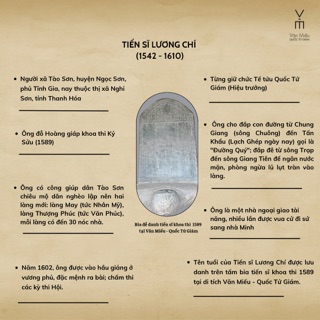
Lương Chí thời niên thiếu thông minh, ham học, theo thầy học ở tận xã Lê Xá huyện Gia Viễn, phủ Trường An. Khi tham gia kỳ thi Hương ông đã đậu Tứ trường loại ưu (thời kỳ này phủ Trường An còn thuộc lộ Sơn Nam). Sau đó ông lại ra huyện Gia Phúc, tỉnh Hải Dương để học với Tiến sĩ Nguyễn Khắc Kiệm. Sau nhiều năm tháng dùi mài kinh sử, khoa thi năm Kỷ Sửu (1589), ông đỗ Đệ nhị giáp Tiến sĩ xuất thân (Hoàng giáp). Từ đó ông làm quan trong triều, được vua tin yêu quý trọng cả về tài năng và đức độ. Sách Đại Nam nhất thống chí chép: “Ở trong triều thì bàn luận chính trị, ngoài trấn thì tham tán việc binh, tỏ nhiều công lao”.
Lương Chí còn là một nhà ngoại giao tài năng nên đã nhiều lần vua sai đi “Tuế cống” nhà Minh (Trung Quốc); rồi “cùng Vinh Quận công Hoàng Đình Ái (người xã Vĩnh Hùng, huyện Vĩnh Lộc ngày nay) đến Nam Giao quan (tức Hữu Nghị quan sau này) đàm đạo với sứ nhà Minh, ông dùng lời lẽ ứng đối hoạt bát, rõ ràng, việc nước đều được thấu đáo xong xuôi”. Có lần ông hộ giá nhà vua đi “tuần du miền núi rừng hiểm trở ở Thanh Hóa, được vua khen có công kiên nghĩa”.
Năm 1602, đời vua Lê Kính Tông, ông được vào hầu giảng ở vương phủ, đặc mệnh ra bài; chấm thi các kỳ thi Hội. Chúa Trịnh Tùng rất quý trọng ông, bèn tâu lên vua rằng: “Lương Chí có công nghị luận với nhà Minh ở Nam Giao quan, nhận được ấn tín, đi triều cống xóa được vạ Liễu Thăng và giảng dạy ở Kinh Diên, quyết đoán việc trong triều, nên thăng chức Tham tụng, Hộ bộ Thượng thư, tước Thuần Lễ bá. Năm 1609, ông được cử trông coi Quốc Tử Giám.
Trong thời gian làm quan tại triều, Lương Chí dù nắm giữ những chức trọng quyền cao, bận trăm công nghìn việc nhưng ông vẫn quan tâm, lo lắng đến quê cha đất tổ, dành nhiều công sức giúp dân Tào Sơn chiêu mộ dân nghèo lập nên hai làng mới: làng May (tức Nhân Mỹ), làng Thượng Phúc (tức Văn Phúc), mỗi làng có đến 30 nóc nhà. Ở vùng đất Tào Sơn xưa vốn đất rộng người thưa, có 4 làng ở cách xa nhau như làng Loi, làng Am, làng Đồng Bàn, làng Tào; trong đó có làng Tào nằm ở khu Mã Đội lấy nghề trồng trầu, trồng mía làm nguồn chính, đời sống thấp kém lạc hậu mọi mặt, ông đã vận động hợp nhất 4 làng lại thành nơi tập trung đông đúc và đặt tên là Tào Sơn xã. Ông lại cho đắp con đường từ Chung Giang (sông Chuông) đến Tấn Khẩu (Lạch Ghép ngày nay) gọi là "Đường Quý"; đắp con đê từ sông Trạp đến sông Giang Tiên để ngăn nước mặn, phòng ngừa lũ lụt tràn vào làng. Nhờ công đức ấy mà nhân dân Tào Sơn “có ruộng cày cấy hai vụ, mùa màng bội thu; các vườn trầu xanh mướt; học hành thi cử chiếm ưu thế trong huyện hạt, được mệnh danh là đất văn hiến, trù mật của huyện Ngọc Sơn".
Tên tuổi, công lao của Lương Chí đã được ghi danh trên bia Tiến sĩ ở Văn Miếu Hà Nội, mãi mãi là tấm gương sáng cho hậu thế noi theo.
An Nhiên
PHÙNG KHẮC KHOAN’S DIPLOMATIC TALENT
Phùng Khắc Khoan (1528–1613), popularly known as Trạng Bùng, had the courtesy name Hoằng Phu, the literary name Nghị Trai, and the pseudonym Mai Nham Tử. In 1557, he ranked first in the Regional Examination in Thanh Hóa. He later attained the title of Doctor of the Second Rank (Hoàng giáp) in the Canh Thìn examination, Quang Hưng era, year 3 (1580), under Emperor Lê Thế Tông. He was a great intellectual of the nation, a man of exceptional talent, and an eminent mandarin of the Lê dynasty.
During his fifty years of service, under several monarchs, Phùng Khắc Khoan was regarded as a trusted minister, a pillar of the state. He held many important positions, such as: Đặc tiến Kim tử vinh lộc đại phu Tán trị Thừa chính sứ ty (Specially Advanced Court Rank with Golden Seal and Purple Ribbon, Head of Provincial Justice Office), Head of Provincial Justice of Thanh Hóa, Vice Minister of Public Affairs, Vice Minister of Mandarinate, Minister of Finance, and Head Master of Quốc Tử Giám.
Phùng Khắc Khoan’s talent and virtue were renowned not only within Đại Việt but also across neighbouring countries. During his diplomatic mission to the Ming dynasty, with his eloquent literary exchanges and quick-witted responses in poetry and prose, he earned the respect of both the Ming court and envoys from Japan and Korea. Regarding this, Lê Quý Đôn recorded in A Modest Record of Observations and Knowledge: “When Phùng Khắc Khoan was sent as an envoy, though over seventy years of age, he not only argued clearly and uprightly, faithfully conveying the royal commands and strengthening the state’s institutions, but also composed thirty felicitous verses for the emperor’s birthday and over ten poems in reply to the chief and deputy envoys from Korea and Japan. His poetic talent overflowed, his style was fresh and graceful, as though he were still in his youth. Was this not indeed the aid of the sacred essence of the mountains and rivers?”
The eloquence and diplomatic acumen of Trạng Bùng Phùng Khắc Khoan commanded the admiration of neighbouring states and contributed significantly to the nation’s foreign relations. It can be said that Phùng Khắc Khoan was not only a statesman, educator, and cultural figure, but was also recognised by history as a distinguished diplomat. Deeply respected by his contemporaries, Trạng Bùng Phùng Khắc Khoan remains a shining example for future generations to study and emulate

An Nhiên
TL: LH
GOVERNOR-GENERAL NGUYỄN VĂN THÀNH – THE BUILDER OF KHUÊ VĂN CÁC
Khuê Văn Các is now a symbol of the thousand-year-old cultural capital of Hanoi, yet few may know that this unique architectural work was created during the reign of Emperor Gia Long, and its founder was the renowned Governor-General of Bắc Thành (Northern Citadel), Nguyễn Văn Thành.
Nguyễn Văn Thành (1758–1817) was originally from Giáp Tây, Bác Vọng Village, Phú Ốc Canton, Quảng Điền District, Triệu Phong Prefecture (today Bác Vọng Tây Village, Đan Điền Commune, Huế City). According to his family genealogy, from a young age, Nguyễn Văn Thành enjoyed reading military treatises and possessed martial talent. Early on, he followed his father into the army to assist the Nguyễn Lords, becoming a valiant general with great achievements, deeply trusted by Nguyễn Ánh (later Emperor Gia Long).
As a high-ranking official, he introduced numerous policies that shaped the development of Bắc Thành, implementing important reforms in education, reorganizing the administrative system, overseeing the construction of dikes and water control in the Red River Delta, safeguarding the northern border, and building notable works such as the Flag Tower of Hanoi, restoring the Thăng Long Citadel, refurbishing the Temple of Literature, and adding Khuê Văn Các.
Notably, he placed strong emphasis on reviving education, recruiting talents, and treating scholars of Bắc Thành with respect and generosity. This demonstrated his vision as a well-rounded statesman, adept in both civil and military affairs. In a memorial submitted to Emperor Gia Long, he proposed three key principles: “Select virtuous and talented individuals for official posts. Talents are hard to find and even harder to recognize. Officials responsible for governance and education must not fail in the task of selecting them.”
Thus, the construction of Khuê Văn Các was not merely an architectural endeavor but a cultural statement—using the light of the Khuê Star to illuminate the path of scholars, and the beauty of literature to nurture moral virtues. It symbolized a noble educational ideal, honoring talent, fostering a spirit of learning, and preserving Vietnam’s tradition of respect for teachers and the pursuit of knowledge.
Khuê Văn Các was commissioned by Governor-General Nguyễn Văn Thành in August, the Year of the Ox (1805). This event was recorded in Quốc sử di biên by Phan Thúc Trực: “In the eighth month of the Year Ất Sửu, Lord Thành built the Khuê Văn Pavilion at Hoài Đức School, located outside the provincial sector, in front of the Temple of Literature. Văn Canh Trần Bá Lãm presented a rhapsody praising the Khuê Văn Pavilion.”
Architecturally, Khuê Văn Các is an eight-roofed square pavilion built on a high square platform paved with Bát Tràng tiles. The lower level consists of four brick pillars with open sides, while the upper level is a wooden two-tiered structure with tubular tile roofs. The four roof corners are decorated with baked clay ornaments, and the surrounding balcony features intricately carved wooden balustrades. Each of the four sides has a circular window framed by wooden spokes radiating outward, symbolizing the Khuê Star shining in all directions.
At the center above the pavilion hangs a red lacquer and gold-gilded signboard inscribed with three Chinese characters: “奎文閣” (Khuê Văn Các). “Khuê” is the name of the brightest star in the constellation of the 28 lunar mansions. The Khuê Star comprises 16 smaller stars arranged in a zigzag pattern resembling the Chinese character for “literature” (文), and is regarded as the celestial deity governing literature and scholarship.
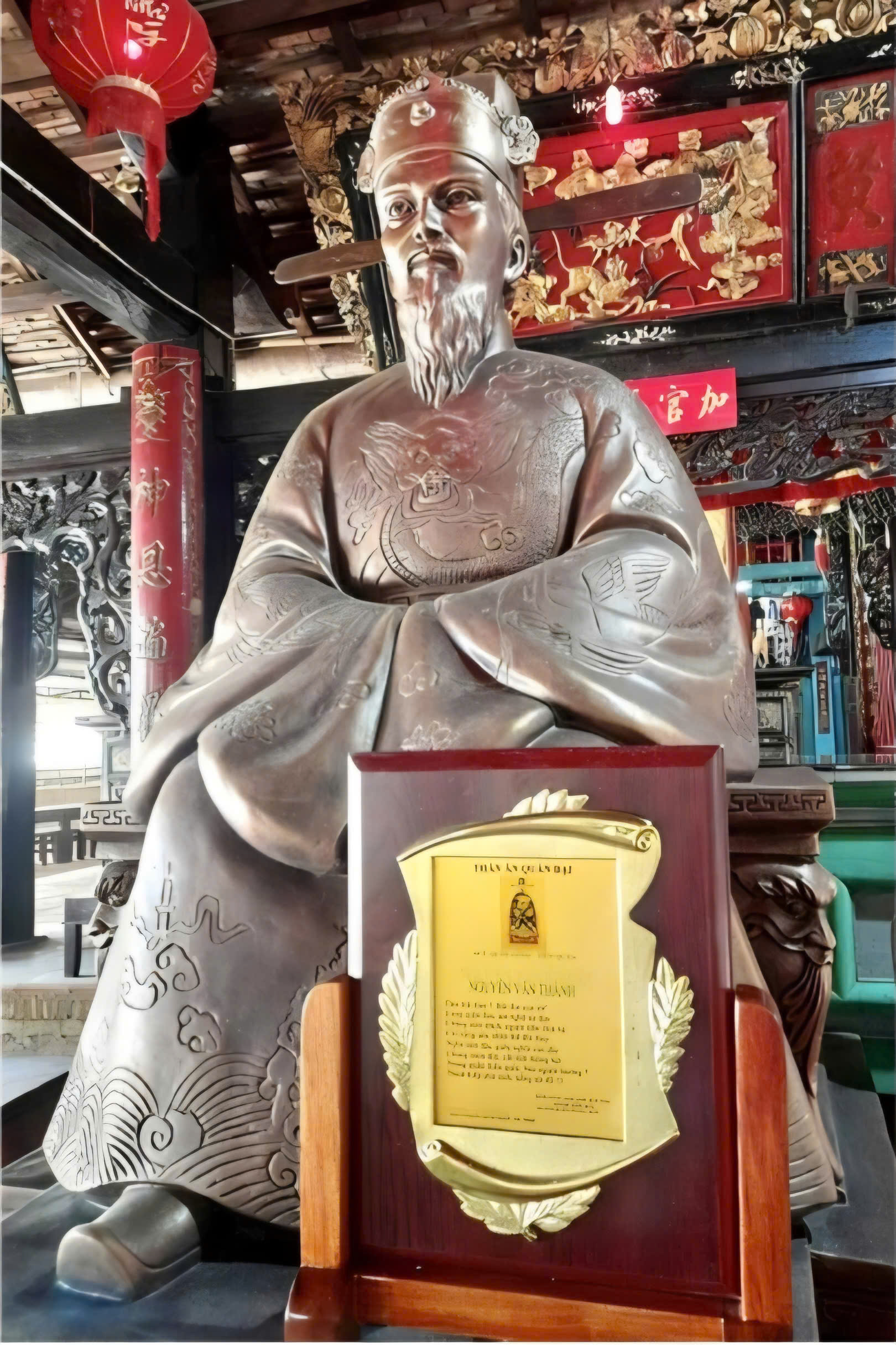
The statue of Governor-General Nguyễn Văn Thành is enshrined at Tân An Communal House in Tân An Ward, Thủ Dầu Một City, Bình Dương Province (now Phú An Ward, Ho Chi Minh City).
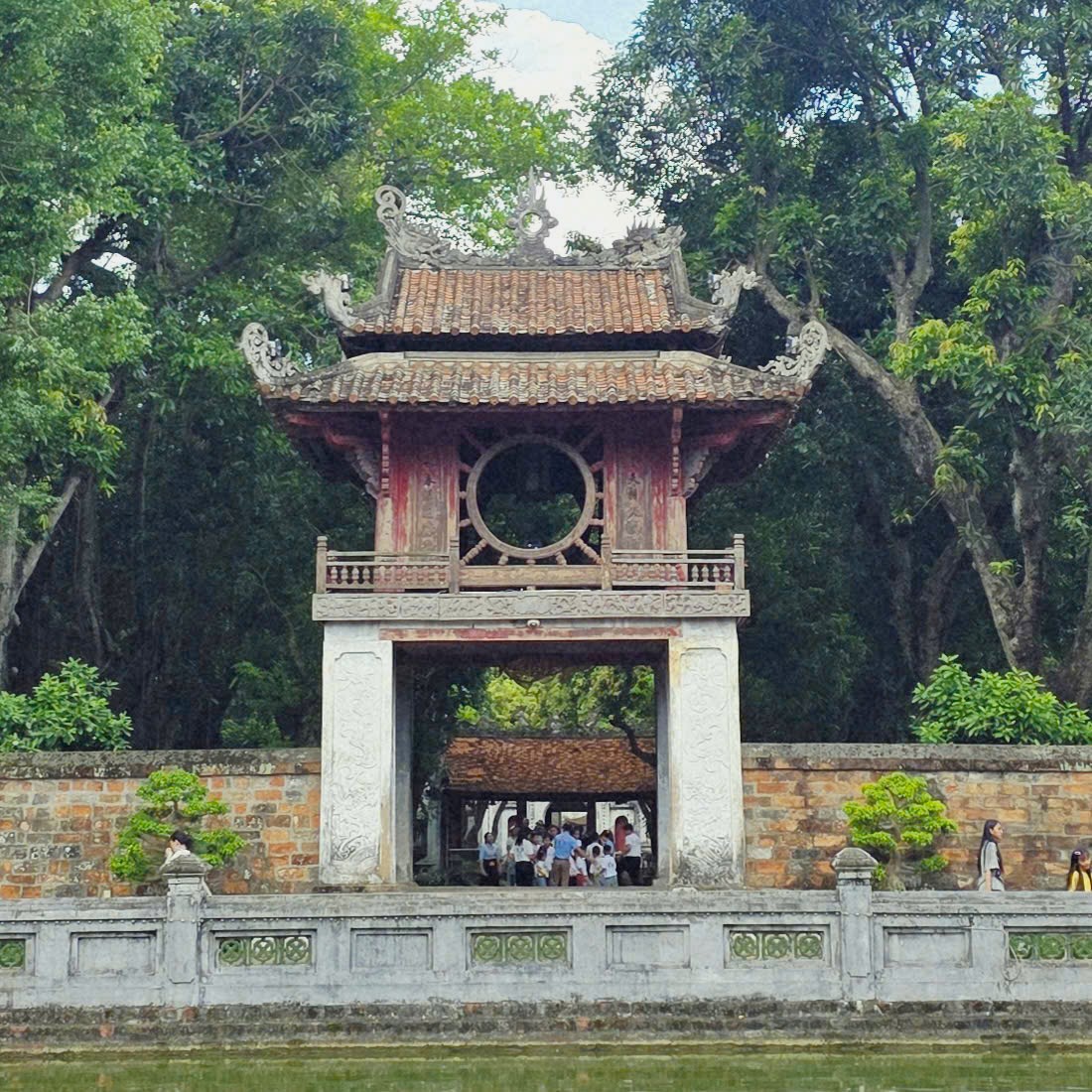
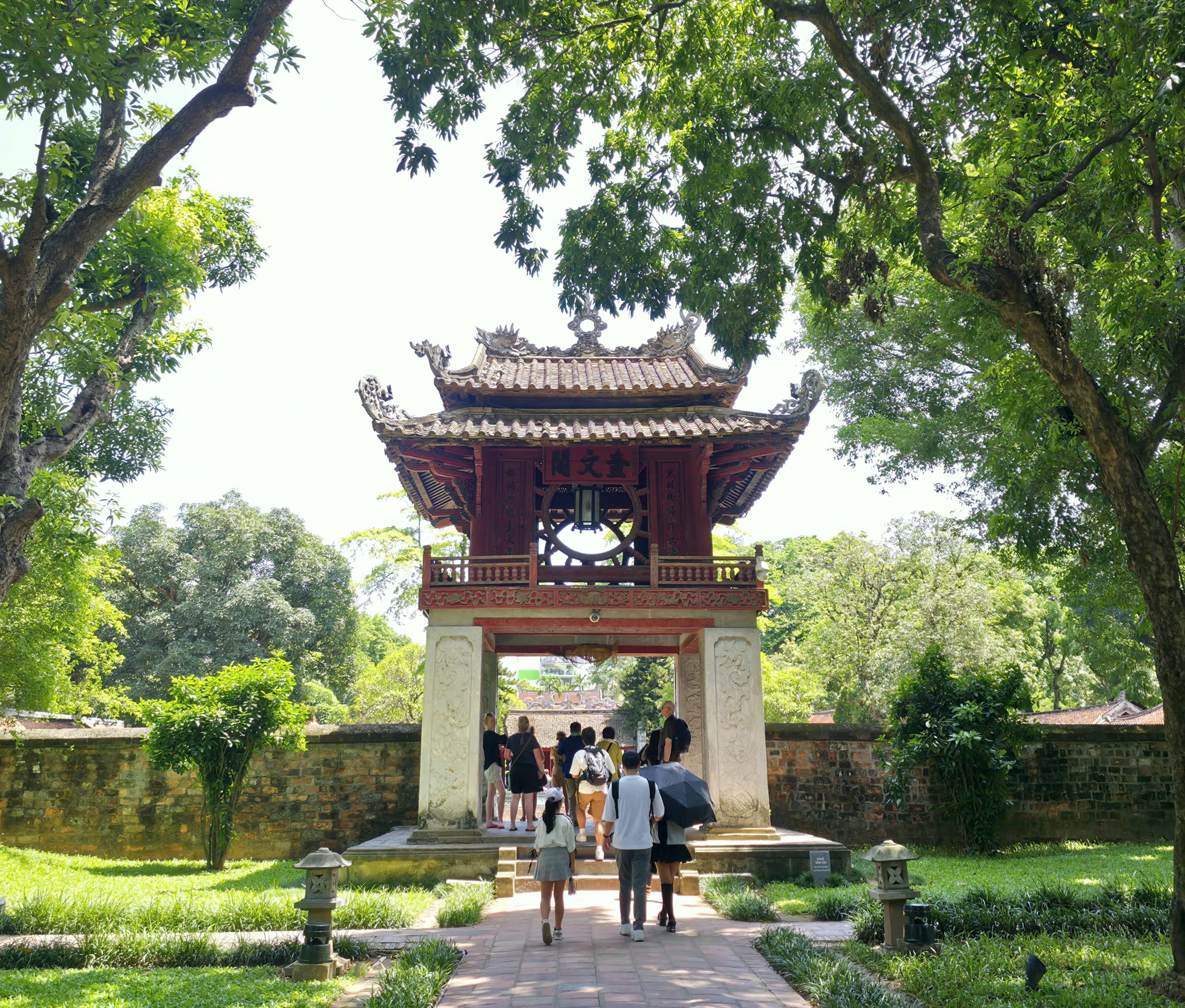
Today, standing before Khuê Văn Các—the emblem of Hanoi—visitors not only admire its unique ancient architecture but also feel inspired by the vision of its founder: a courageous Governor-General who valued education and revered talent.
DOCTORAL LAUREATE LÊ NGHĨA TRẠCH (1536–1614)
Lê Nghĩa Trạch (1536–1614), a native of Cổ Đôi village, Nông Cống district (present-day Trung Chính commune, Thanh Hóa province), was a prominent mandarin of the Lê period and the patriarch of a family renowned for its scholarly tradition.
His family was a source of pride for Nông Cống, Thanh Hóa, with three successive generations attaining the title of Doctoral Laureate, their names engraved on the Doctoral Steles at the Văn Miếu – Quốc Tử Giám. Following in his footsteps and upholding the family tradition of academic excellence, his grandson Lê Sĩ Triệt earned the Doctorate in the National Examination of 1640 (Canh Thìn year), and his great-grandson Lê Sĩ Cẩn attained the same title in the 1680 examination (Canh Thân year).
At the age of 30, Lê Nghĩa Trạch passed the National Examination in the Ất Sửu year, 8th year of the Chính Trị reign (1565) under Emperor Lê Anh Tông, ranking as a Second-Grade Laureate (Đệ nhị giáp Đồng tiến sĩ xuất thân). He was entrusted by the court with several significant positions, notably serving as Vice Minister of the Ministry of Mandarinate (Lại bộ Tả thị lang). Upon his passing, he was posthumously conferred the titles of Minister of Military Affairs (Binh bộ Thượng thư), Thái bảo, and ennobled as Nham Quận công. He was also bestowed the honorary title of Kiệt tiết tuyên lực công thần in recognition of his merits, moral character, and unwavering loyalty.
A defining moment in his political career came in 1600, when from Tây Đô, Lord Trịnh Tùng dispatched Lê Nghĩa Trạch with a letter to Grand Commandant, Duke of Đoạn, Nguyễn Hoàng, urging him to remain in Thuận Hóa as its military governor and continue remitting taxes to the Lê court to support state expenses. During this diplomatic mission to Thuận Hóa, Lê Nghĩa Trạch demonstrated exceptional eloquence, intellect, and diplomatic acumen. The mission was recorded in the official chronicle Khâm Định Việt Sử Thông Giám Cương Mục as follows:
“In the year Canh Tý, the first year of the Thận Đức reign (1600) under Emperor Kính Tông Huệ Hoàng Đế (from the 11th month onward, it was also the first year of the Hoằng Định reign – Ming calendar, Wanli 28), hearing of Kính Cung’s occupation of Đông Kinh, Lord Tùng convened a meeting with his generals. One arm of his strategy was to send Lê Nghĩa Trạch with a letter to reassure our Emperor Thái Tổ Gia Dụ at Thuận Hóa, urging him to remain as governor; simultaneously, both naval and ground troops were deployed to Tràng An.”
Historian Phan Huy Chú praised Doctoral Laureate Lê Nghĩa Trạch in his Lịch Triều Hiến Chương Loại Chí (Categorised Records of Successive Dynasties) with the following words:
“The districts of Quảng Xương and Ngọc Sơn each had seven individuals attain the Doctoral Laureate title, but Nông Cống had twenty-eight. Those who became virtuous and reputable officials succeeded one another, such as Lê Nghĩa Trạch from Cổ Đôi, who, in the Thận Đức era [1600], was dispatched to Thuận Hóa and Quảng Nam. He skillfully handled diplomatic matters, earning praise from the Southern Court (the Nguyễn lords of the Inner Realm), who acknowledged that the Lê court had such a talented envoy.”
These evaluations affirm Lê Nghĩa Trạch’s outstanding diplomatic talents and loyal service amid a period of great political upheaval.
Throughout his career, Lê Nghĩa Trạch consistently exemplified the ideals of a virtuous official: upholding discipline, respecting the law, practising integrity, and contributing to national stability. His moral conduct and statesmanship left a shining legacy, earning him the respect and affection of the people. He truly deserves the honour and emulation of future generations.

An Nhiên
LH
NGUYỄN SẰN – “THE FIVE-DAY DOCTORAL LAUREATE”
In the illustrious flow of Vietnam’s scholarly tradition, the village of Thượng Yên Quyết—colloquially known as “Paper Village,” formerly in Từ Liêm District and now part of Yên Hòa Ward, Hanoi—holds a distinguished place, having produced nine celebrated doctoral laureates. For generations, it has been known not only for its traditional dó paper craft but also as a cradle of exceptional talents devoted to the royal court and the nation. Among them, Nguyễn Sằn stands out as a remarkable figure, renowned for both his extraordinary path to academic success and his admirable service to the state.
Nguyễn Sằn was originally from Thượng Yên Quyết commune, Từ Liêm District (present-day Yên Hòa Ward, Hanoi), with ancestral roots in Dịch Vọng commune (now Cầu Giấy Ward, Hanoi). He was one of the prominent laureates during the reign of King Lê Trung Tông, earning the Second-rank laureate title in the Special Examination (Chế khoa) held in the year Giáp Dần (1554), the sixth year of the Thuận Bình era—the first such examination of its kind under the Lê Trung Hưng Dynasty.
Unlike the regular civil service examinations (Hương, Hội, and Đình), the Chế khoa was a special, royal examination decreed by the king, often consisting of a single round and held in times of national transition to recruit the most outstanding talents for essential positions at court.
According to the inscription on the Doctoral Stele commemorating the 1554 examination—currently preserved at the Temple of Literature – Quốc Tử Giám—the Chế khoa of 1554 was the first of its kind under the Restored Lê Dynasty. The king himself composed the exam question, asking about the principles of good governance in the past and present times. Officials were appointed as Chief Examiner, Presenters of Candidates, and Supervisors to administer the examination. Thirteen candidates passed and were presented to the emperor for final review and ranking. The stele inscription records:
In the year Giáp Dần (1554), the first Special Examination was established. His Majesty personally composed the essay question, asking about the philosophy of ruling the country through the ages. The Chief Examiner, Presenters of Candidates, and Supervisors followed royal orders to conduct the test. Thirteen were selected and submitted to His Majesty for review and ranking… Those who passed the examination possessed deep political insight, collaborated wholeheartedly, and contributed strategies of lasting value. Their talents would serve the country for generations to come.”
Nguyễn Sằn was one of these thirteen exceptional scholars, personally chosen by the emperor from this rigorous and prestigious examination.
What makes Nguyễn Sằn’s story even more extraordinary is that he travelled from the North to Thanh Hóa to take the examination, but arrived when the third round had already begun. He was extremely late compared to the official schedule. With only five days remaining, he earnestly petitioned to participate, and in that short window, he managed to write four essays corresponding to all four rounds of the exam. He submitted them for evaluation and was ultimately declared successful. Posterity remembers him as the “Five-Day Doctoral Laureate” (Ngũ nhật Tiến sĩ)—a title nearly unparalleled in the history of Vietnam’s civil examinations, highlighting his remarkable determination and intellectual brilliance.
After earning his degree, Nguyễn Sằn was appointed by the royal court to the position of Deputy Head of Provincial Administration (Tham chính)—a key post responsible for overseeing administration and judicial affairs in central provinces. This position was typically reserved for individuals of high scholarly achievement, moral integrity, and proven administrative capability. His appointment reflects the court’s deep trust in both his talent and character. In recognition of his loyal service and contributions to national governance, he was honoured with the prestigious title of Kiệt tiết công thần—a mark of the king’s high regard for his integrity and statesmanship.
Doctoral Laureate Nguyễn Sằn is not only a source of pride for the village of Thượng Yên Quyết but also a powerful symbol of intelligence, resilience, and the indomitable spirit of scholarly pursuit. His “Five-Day Doctor” story continues to inspire generations of students, reminding us that—regardless of circumstance—those with determination, talent, and unwavering effort will find their rightful place in the service of their country.
In the long arc of Vietnamese history, individuals like Nguyễn Sằn are vivid testaments to the enduring vitality of the Confucian educational tradition. This core value has shaped Vietnam’s cultural identity and spiritual depth over the centuries.
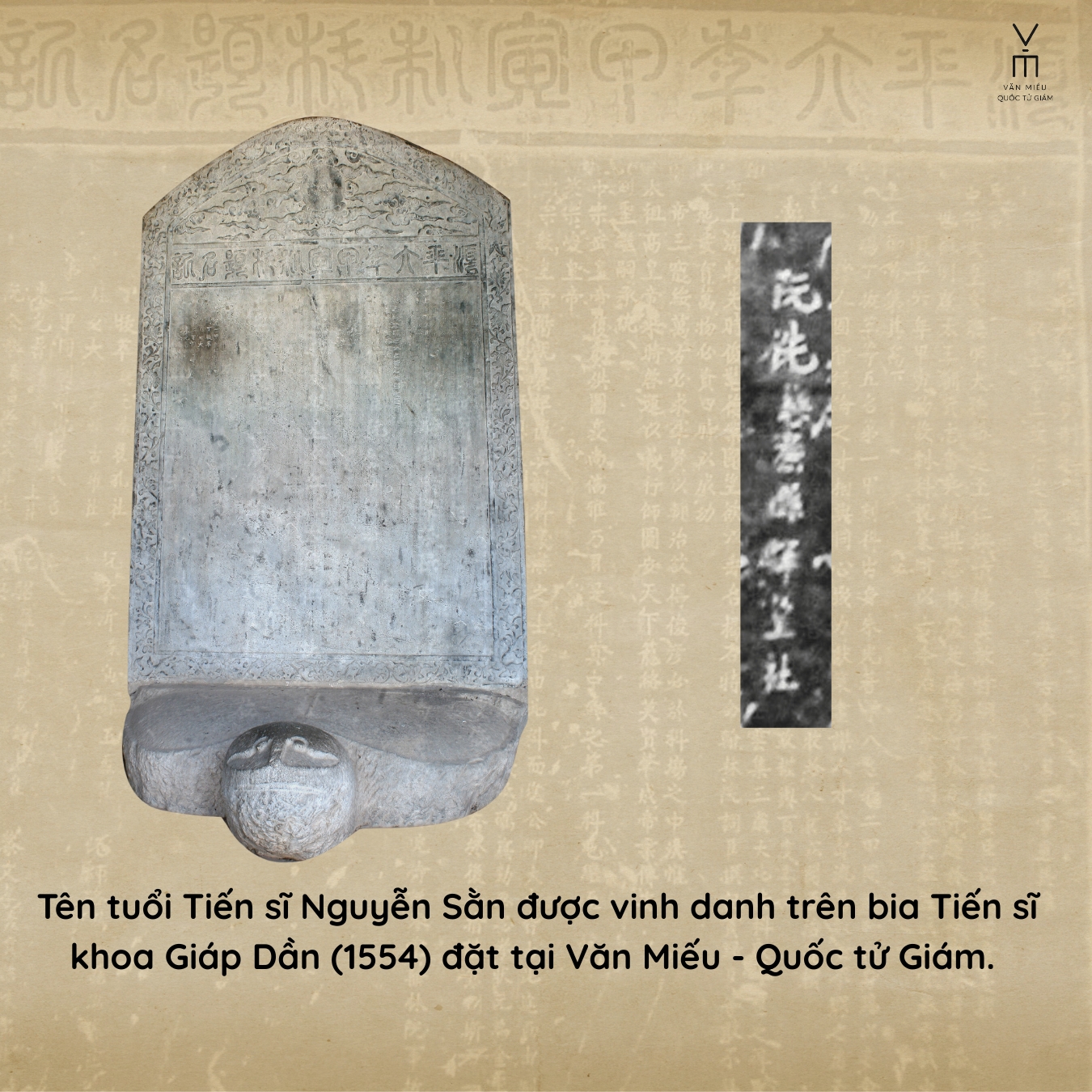
Khu vườn bia Tiến sĩ
Tài liệu tham khảo:
-
Bùi Xuân Đính, Tiến sĩ nho học Thăng Long – Hà Nội, NXB Hà Nội,2003
-
Ngô Đức Thọ, Các nhà khoa bảng Việt Nam, NXB Văn Học, 1993
NGUYỄN CÔNG THÁI – A CULTURAL AND EDUCATIONAL FIGURE OF THĂNG LONG
Nguyễn Công Thái (1684–1758) was a native of Kim Lũ village, Thanh Trì district, now Đại Kim ward, Hoàng Mai, Hanoi. He ranked third in the examination in 1715, during the reign of King Lê Dụ Tông. Throughout his career, he held several key positions in the royal court, such as Supervisor of Censors in Nghe An and Thanh Hoa, Dong Cac Academic Secretary, Vice Minister of the Ministry of Public Affairs, Minister of Rites, Tham tụng (equivalent to Prime Minister), Director of Quốc Tử Giám, and Headmaster of Quốc Tử Giám.

His name and hometown are engraved on the doctoral stele of the 1715 examination at Văn Miếu – Quốc Tử Giám.
Contributions to Education and Talent Development
Nguyễn Công Thái made significant contributions to education and the training of talented individuals for the country. As the Headmaster of Quốc Tử Giám, he played a crucial role in strengthening and developing Văn Miếu – Quốc Tử Giám, as well as Vietnam’s education system. He not only oversaw the rituals and ceremonies at Văn Miếu but, more importantly, organized the training of students at Quốc Tử Giám, nurturing them into future national talents.
In 1753, recognizing the decline of Confucian education in the 18th century, Nguyễn Công Thái submitted a petition to Lord Trịnh Doanh, requesting the abolition of the “tiền thông kinh” (a fee required to enter the regional examination). According to the "Khâm định Việt sử thông giám cương mục", this fee was originally meant to cover official expenses but later became a source of corruption. The policy allowed farmers, traders, and even butchers to submit their applications without proper qualifications, resulting in chaotic and unfair examinations where cheating and bribery were rampant.
Faced with this issue, Nguyễn Công Thái proposed eliminating the fee, ensuring that impoverished but talented scholars had a fair opportunity to participate in the examinations. Lord Trịnh Doanh approved his request, opening doors for many underprivileged students and restoring fairness in the Confucian education system of the time.
A Just and Visionary Scholar
Regardless of his position, Nguyễn Công Thái remained a man of integrity, always prioritizing public service over personal gain. He played a key role in purifying the examination system, ensuring that only competent individuals were selected for governmental roles. His efforts not only enhanced the fairness of education but also demonstrated his vision as an outstanding educator of the 18th century, making him a distinguished scholar and statesman of Thăng Long.
An Nhiên
TRUYỀN THỐNG HIẾU HỌC LÀNG ĐÔNG NGẠC QUA BIA TIẾN SĨ
Làng Đông Ngạc từ lâu đã nổi danh là một trong những vùng đất hiếu học bậc nhất cả nước, nơi sản sinh nhiều bậc hiền tài, góp phần làm rạng danh nền giáo dục nước nhà. Truyền thống khoa bảng của làng được khẳng định qua nhiều đời, với những tên tuổi được vinh danh trên bia Tiến sĩ tại Văn Miếu - Quốc Tử Giám.
Dân gian xưa có câu: “Đất Kẻ Giàn, quan Kẻ Vẽ” hay “thơ Mỗ, Phú Cách, sách Vẽ” (nghĩa là: thơ làng Đại Mỗ, Phú làng Cách Thượng Trì, văn sách làng Vẽ), để ca ngợi truyền thống khoa bảng của làng Đông Ngạc. Ngay từ cuối đời nhà Trần đã có cụ Phan Phu Tiên đỗ Thái học sinh vào năm Quý Dậu (1393), sau đó lại đỗ khoa Minh Kinh vào năm Kỷ Dậu (1429). Thời Lê có 12 người đỗ Tiến sĩ. Triều Nguyễn có 9 người thi đỗ Tiến sĩ. Như vậy, Đông Ngạc là làng khoa bảng có nhiều người đỗ Tiến sĩ trong cả nước chỉ đứng sau làng Mộ Trạch (Bình Giang - Hải Dương) và Kim Đôi (Quế Võ - Bắc Ninh). Làng Mộ Trạch có 34 Tiến sĩ, làng Kim Đôi có 22 Tiến sĩ. Làng Đông Ngạc có 21 Tiến sĩ đỗ ở tất cả các thời.
Nghiên cứu bia Tiến sĩ tại Văn Miếu - Quốc Tử Giám cho thấy, tên Đông Ngạc xuất hiện đầu tiên vào năm 1646 với tên họ của vị Tiến sĩ họ Phạm, Phạm Hiển Danh. Bia Tiến sĩ khoa thi năm 1514 ghi danh Tiến sĩ họ Phạm, quê huyện Từ Liêm, Phủ Quốc Oai. Đó là Phạm Lân Định. Theo gia phả họ Phạm thì Phạm Hiển Danh là cháu 4 đời của Phạm Lân Định, quê ở xã Đông Ngạc, Từ Liêm. Do bia Tiến sĩ thời Lê sơ chỉ ghi huyện và phủ của người đỗ mà không ghi rõ xã (làng), nên không thể xác định chính xác quê quán của Phạm Lân Định chỉ dựa vào văn bia. Tuy nhiên nhờ gia phả chúng ta xác định được ông quê ở xã (làng) Đông Ngạc. Như vậy ông chính là vị Tiến sĩ đầu tiên của làng Đông Ngạc có tên trên bia Tiến sĩ tại Văn Miếu-Quốc Tử Giám.
Khảo cứu các văn bia còn lại tại Văn Miếu-Quốc Tử Giám, chúng ta thấy tên của những vị Tiến sĩ sau đây thuộc làng Đông Ngạc:
-
Phạm Quang Trạch, xã Đông Ngạc huyện Từ Liêm, Bảng nhãn năm 1683
-
Phan Vinh Phúc xã Đông Ngạc huyện Từ Liêm, Tiến sĩ năm 1685
-
Phạm Công Hoàn, xã Đông Ngạc huyện Từ Liêm, Tiến sĩ năm 1694
-
Phạm Quang Dung, xã Đông Ngạc huyện Từ Liêm, Tiến sĩ năm 1706
-
Phạm Nguyên Ninh, xã Đông Ngạc huyện Từ Liêm, Tiến sĩ năm 1731
-
Phan Lê Phiên, xã Đông Ngạc huyện Từ Liêm, Tiến sĩ năm 1757
-
Nguyễn Đình Thạc, xã Đông Ngạc huyện Từ Liêm, Tiến sĩ năm 1779.
Như vậy, cùng với hai vị Tiến sĩ kể trên, thì làng Đông Ngạc có 9 vị đỗ đại khoa có tên ghi trên bia Tiến sĩ tại Văn Miếu - Quốc Tử Giám Thăng Long.
Những vị Đại khoa, đặc biệt là những người đầu tiên được khắc trên bia Tiến sĩ, ngoài việc ra làm quan thì họ trở thành niềm tự hào của gia đình, dòng họ nói riêng, của cả làng nói chung. Có thể nói họ chính là những người đặt nền móng cho truyền thống hiếu học và thi cử tại địa phương. Họ góp phần tạo lập một cơ sở giáo dục, một trường học cho gia đình, dòng họ mình và cả làng nói chung. Không chỉ tạo lập cơ sở vật chất, họ còn là điểm tựa tinh thần cho cả làng trong việc phấn đấu để thành đạt trong học tập. Điều này, đương nhiên không chỉ ở làng Đông Ngạc mà là một thực tế ở đại đa số các làng, xã của Việt Nam xưa. Qua đó cho thấy rõ mục tiêu của việc dựng bia của triều đình: khích lệ kẻ sĩ dùi mài kinh sử, trở thành người tài đức phục vụ quê hương, đất nước.
Việc tạo nên cơ sở giáo dục và lan tỏa không khí học hành đã góp phần tạo nên những thế hệ thành đạt, trọng đạo học, giữ vững truyền thống hiếu học cho dòng họ, cho quê hương Đông Ngạc. Kết quả trên được thể hiện rõ qua những người được ghi tên trên bia Tiến sĩ: có đến 6 người thuộc họ Phạm được ghi tên trên bia Tiến sĩ ở Văn Miếu - Quốc Tử Giám Thăng Long, đặc biệt hơn, hai khoa liền, họ Phạm, họ Phan thay nhau có tên trên bia (Khoa thi năm 1683 và khoa năm 1685), hoặc như họ Nguyễn dù có người đăng tên bảng vàng muộn, nhưng sau đó cũng có nhiều người đỗ để được khắc tên bia đá.
Các dòng họ thay nhau có người lưu danh trên bia đã thể hiện rõ truyền thống hiếu học của làng, thể hiện sự đua ganh trong việc tạo lập danh tiếng cho dòng họ, cho quê hương, đất nước. Truyền thống này kéo dài gần 400 năm kể từ năm 1514, khi Phạm Lân Định đăng tên bia đá đến năm 1879, khi Nguyễn Dự là người cuối cùng của làng được ghi tên ở bia Tiến sĩ tại Văn Miếu Huế.
Bia Tiến sĩ là động lực thúc đẩy giáo dục, đồng thời góp phần hình thành truyền thống hiếu học của dân tộc, các dòng họ và địa phương. Việc khắc tên trên bia là vinh dự lớn cho người thi đỗ và niềm tự hào của cả dòng họ.

Tài liệu tham khảo
-
Các nhà khoa bảng Việt Nam 1075-1919 Ngô Đức Thọ.
-
Kỷ yếu hội thảo Làng khoa bảng Thăng Long, Trung tâm hoạt động VHKH Văn Miếu - Quốc Tử Giám
-
Tiến sĩ nho học Thăng Long - Hà Nội, Bùi Xuân Đính,
-
Giáo dục và khoa cử nho học Thăng Long Hà Nội -Bùi Xuân Đính.
LH
TƯ NGHIỆP QUỐC TỬ GIÁM NGUYỄN VĂN CHẤT
Nguyễn Văn Chất (1422-?), hiệu là Nhuệ Hiên, người xã Vũ Di, huyện Bạch Hạc (nay là xã Vũ Di, huyện Vĩnh Tường, Vĩnh Phúc).
Năm 27 tuổi, ông đỗ Đệ nhị giáp Tiến sĩ xuất thân (Hoàng giáp) khoa Mậu Thìn niên hiệu Thái Hòa thứ 6 đời vua Lê Nhân Tông (1448). Sau khi thi đỗ, ông được triều đình tin tưởng, giao giữ nhiều chức vụ quan trọng. Ông trải qua các chức quan như đồng tu Quốc sử, Tham chính, Đô ngự sử, Hộ bộ Thượng thư… Ông là người có nhiều đóng góp to lớn trên các lĩnh vực như giáo dục, văn hóa, chính trị và quân sự…cho đất nước.
Ban đầu, ông giữ chức Tư nghiệp (Hiệu phó) Quốc Tử Giám. Sau lại giữ chức đồng tu Quốc sử (chức quan ở Quốc sử viện, nơi biên soạn Quốc sử).
Đến tháng 12, năm Bính Tuất (1466), đời vua Lê Thánh Tông, ông được cử giữ chức Tham chính, là chức quan đứng đầu Tuyên sứ ty Nghệ An. Năm Tân Mão, niên hiệu Hồng Đức (1471), ông phụ trách quân lương, trả lương kho cho quân danh Thanh Hóa. Sau được bổ nhiệm chức Đô ngự sử, đây là chức quan chuyên trách và cao nhất trong Ngự Sử Đài (can gián những việc được xem là không đúng hoặc chưa tốt của vua và quan lại).
Nguyễn Văn Chất còn là nhà ngoại giao có tài. Khi được triều đình cử đi sứ sang Trung Quốc, ông đã xuất sắc hoàn thành mọi nhiệm vụ được giao, giải quyết được những vấn đề đặt ra trong mối quan hệ giữa hai nước, hay tranh chấp một số điểm biên giới còn tồn đọng giữa hai quốc gia. Năm Canh Tuất (1480), sau khi đi sứ sang nhà Minh, về nước ông được thăng chức Hộ bộ Thượng thư (Bộ trưởng bộ Hộ, quản lý ruộng đất, thuế khoá, kho tàng, dân số và cấp phát lương bổng).
Ông còn tham gia biên soạn Việt điện u linh tục tập (nguyên tác Việt điện u linh của Lý Tế Xuyên biên soạn vào niên hiệu Khai Hựu thứ nhất, năm 1329, đời vua Trần Hiến Tông), là tác giả của phần Tục biên. Ông đưa thêm vào tác phẩm này 4 truyện: Sóc Thiên Vương, Thanh Sơn Đại vương, Càn Hải môn Tôn thần và Quản gia độ bác Đại vương.
Nguyễn Văn Chất cũng là một danh sĩ nổi tiếng, có tên trong Tao đàn nhị thập bát tú dưới triều vua Lê Thánh Tông.
Ngày nay, tên tuổi và công trạng của ông được ghi trên bia đề danh Tiến sĩ khoa Mậu Thìn (1448) đặt tại di tích Văn Miếu – Quốc Tử Giám.
Tài liệu tham khảo:
-Sách Hội thảo Khoa học Tế tửu, Tư nghiệp Quốc Tử Giám Thăng Long, 2015, Trung tâm HĐ VHKH Văn Miếu - Quốc Tử Giám.
-Sách Lịch triều hiến chương loại chí, Phan Huy Chú, trang 594/730, phần Bang giao chí.

Thúy Hồng
PRINCIPLE LÊ HỮU KIỀU (1691–1760)
Principle Lê Hữu Kiều, also known by his literary name Tốn Trai, was born in 1691 in Liêu Xá village, Đường Hào district (now part of Yên Mỹ, Hưng Yên province). He was an exceptional Lê Trung Hưng dynasty figure and a shining example of talent, virtue, and unwavering dedication to the nation. Throughout his life, he made profound contributions to cultural and political spheres, becoming a model of intellectual excellence.
According to the inscription Tốn Trai Lý Lịch Ký in his hometown, Lê Hữu Kiều was born on September 2, 1691 (the 12th year of the Chính Hòa reign). He came from a prestigious Lê family and was initially named Nhượng before changing it to Hữu Kiều. At 15, he passed the provincial examination's preliminary rounds. By 18, he excelled in the provincial examination. Lê Hữu Kiều continued to demonstrate his exceptional academic abilities, passing the Hoành từ examination at 25, which earned him an official literary position in the royal court. In 1718, at 28, he passed the national doctoral examination, marking the beginning of a promising official career.
Notably, he was an accomplished civil servant and excelled in military affairs. At 42, he was appointed governor of Cao Bằng, a vital frontier region. A year later, he was recalled to the capital and promoted to Phó Đô Ngự sử, a high-ranking supervisory position in the imperial court.
Lê Hữu Kiều also stood out as a diplomat. At 47, he was sent as Deputy Envoy to China to deliver congratulations, showcasing his diplomatic finesse and courage. For his contributions, he was promoted to Tả công and granted the noble title Liêu Đình bá. The court entrusted him with critical responsibilities during challenging times for the nation.
Lê Hữu Kiều also made significant contributions to education and talent recruitment. He was frequently appointed Tri Cống cử, overseeing major national examinations to select talent for the imperial court. His integrity ensured fairness in these examinations, contributing to the cultivation of a capable and virtuous administrative corps. Even in his later years, Lê Hữu Kiều continued to serve the nation. He held key positions such as Minister of Rites, Minister of Justice.
In 1755, at 65, he retired to his hometown. The court honored him with a Thái kỳ and eight pairs of couplets, recognizing his immense contributions. His hometown organized a grand welcome, celebrating his lifelong dedication to the nation and community.
In 1760, Lê Hữu Kiều passed away at the age of 70. The court posthumously conferred upon him the title of Thiếu phó and the noble rank of Quận công, affirming his place in history as one of the most outstanding ministers of the Lê Trung Hưng dynasty.
Lê Hữu Kiều's life symbolizes loyalty, integrity, and exceptional talent. He was a brilliant politician, educator, and skilled diplomat. His legacy remains cherished in the people's hearts and historical records, serving as an inspiring example for future generations. With his talent and dedication, Lê Hữu Kiều continues to be a source of pride for his hometown of Liêu Xá and the nation of Vietnam.

LH
NGUYỄN HUY OÁNH – PRINCIPAL OF THE QUỐC TỬ GIÁM
Nguyễn Huy Oánh (1713–1789), also known by his literary names Kính Hoa, Lựu Trai, and Thạc Đình, was from Trường Lưu Village, La Sơn District (now Trường Lộc Commune, Can Lộc District, Hà Tĩnh Province). In 1748, during the Mậu Thìn examination (9th year of Cảnh Hưng reign), he achieved the title of Đệ nhất giáp Tiến sĩ cập đệ Đệ tam danh (equivalent to third laureate). Following his success, he was appointed Đãi chế at the Academy of Literature. The following year, he became a strategic advisor in Thanh Hoa Province.
In 1750, he served as the Associate Commissioner of Nghệ An, later promoted to positions such as Academician. He also supervised regional examinations in Hải Dương and Yên Quảng and conducted official inspections in Yên Phong and Yên Việt districts. In 1759, he was summoned back to the capital and assigned additional duties, including overseeing classified matters (Tri biên phiên) and serving as an internal lecturer and deputy director of Quốc Tử Giám. He was eventually elevated to Thượng thư Bộ Công (Minister of Public Works) and the principal of Quốc Tử Giám.

In 1761, Nguyễn Huy Oánh was granted third-rank court attire to receive envoys from the Qing dynasty. Known for his eloquence, he was appointed by the Lê court in 1765 as the chief envoy to China. Upon departure, the court composed farewell poems, and many officials also wrote poetry in his honor. During his mission, the delegation received a grand welcome from the Qing emperor and officials. After a challenging year-long journey, he returned to Vietnam and was granted the noble title of Bá (Marquis).
Back in his homeland, Nguyễn Huy Oánh dedicated himself to teaching and literary pursuits, achieving remarkable accomplishments. He taught around 30 students who later passed the imperial examinations as doctoral laureates. He established the fund, which provided resources for talented but impoverished students to pursue education and examinations. He also founded the Phúc Giang Library, a vast collection of tens of thousands of books, to support teaching and learning. In recognition of his contributions, Emperor Minh Mạng of the Nguyễn dynasty, in 1824, posthumously conferred upon him the title "Phúc Giang Thư viện uyên bác chi thần" (The Erudite Deity of Phúc Giang Library).
An Nhiên
TL: LH
PRINCIPLE TRẦN DANH NINH
Trần Danh Ninh (1703 – 1766) was a famous official during the Lê dynasty, born in Bảo Triện village, Gia Định district, now Nhân Thắng commune, Gia Bình district, Bắc Ninh province. From a young age, he displayed intelligence and an intense thirst for learning. Coming from a region rich in cultural traditions, he not only absorbed knowledge from his family but also relentlessly strived to improve himself. As a child, Trần Danh Ninh demonstrated diligence, persistence, and a determined will, particularly his passion for literature and morality.
His literary talent gradually became well-known thanks to his continuous effort and determination. After participating in various exams, from the regional exams to the national and royal exams, which were used to select talented individuals for the court, Trần Danh Ninh consistently excelled and ranked first. At the age of 21, he participated in the regional exam, which was an important stepping stone in his academic career. He achieved the highest honor. This remarkable achievement at such a young age showcased his exceptional talent. At 29, he went on to pass the royal exam, ranking first in 1731, a title that confirmed his scholarly prowess and opened the door to a solid career in the imperial court. His name was later inscribed on the stone stelae at the Văn Miếu – Quốc Tử Giám.
In 1740, Trần Danh Ninh was appointed as an official at the Academic Institute, a key position in charge of reading and reviewing texts. He also became a Bồi tụng (the first ranking position) in the Lord's palace, an honor for a new court official and a challenge to prove his competence in handling complicated administrative tasks. In 1743, he was promoted to Principle at the Quốc Tử Giám, responsible for training and nurturing talents for the country. However, due to a mistake, he was dismissed from his position as Bồi tụng. Despite this, he remained determined and continued contributing to the court.
After his dismissal, Trần Danh Ninh did not become discouraged. He had opportunities to continue serving, especially when he accompanied the Lord on military campaigns in the South and achieved many victories. Due to these significant contributions, he was appointed as Academician, a senior position in charge of drafting state documents and ceremonial texts. This role required not only extensive knowledge but also integrity and high responsibility. He was later entrusted with the role of Tán lý Đông Đạo, responsible for fighting bandits, further confirming his role in maintaining the nation's peace. During this time, the court also trusted him again with the Bồi tụng position. It involved him in managing essential matters at the Khu mật Institute, the military advisory body of the court.
In the winter of 1752, Trần Danh Ninh again accompanied the Lord on a military campaign to the west. He played a crucial role in this campaign, helping to suppress the rebellion and ensure stability for the people. Due to his successes in the battle, he was promoted to the position of Vice deputy in Ministry of Public Affairs. In 1761, Trần Danh Ninh was further promoted to Thị lang of the Ministry of Rites and later as Vice deputy of the Ministry of Justice. He also concurrently held the position of Tổng tài Sử quán, the chief historian responsible for recording and compiling the dynasty's history. This prestigious position required vision, ethics, and the ability to document history impartially.
In 1766, at the age of 64, Trần Danh Ninh requested to retire and return to his homeland for his later years. The court respected his decision and honored him with the title Thượng thư of the Ministry of Rites, recognizing his lifelong contributions. However, in the spring of 1767, before he could return home, Trần Danh Ninh passed away unexpectedly at the imperial court. The court posthumously awarded him the title Thiếu bảo and gave him the posthumous name Mẫn Đạt to commemorate his contributions and noble character. The posthumous name "Mẫn Đạt" was not just a title but also a tribute from the court to a man who had dedicated his life to the country.

Tài liệu tham khảo:
-
Đại Nam Nhất Thống Chí, Phạm Trọng Điềm-Hiệu đính: Đào Duy Anh, NXB Thuận Hóa, 2006
-
Việt sử cương mục tiết yếu, Đặng Xuân Bảng, NXB KHoa học xã hội, 2000
-
Lịch triều hiến chương loại chí, Phan Huy Chú, Tập 1,NXB Giáo dục, 2001
LH
PHD TRỊNH TUỆ - A MODEL OF OVERCOMING HARDSHIP TO EXCEL IN LEARNING
Trịnh Tuệ was a distinguished figure from Thanh Hóa, leaving a notable mark in the history of Vietnam's civil service examinations and academia. Born in 1706 during the reign of King Lê Dụ Tông, Trịnh Tuệ came from a noble lineage of the Trịnh lords, yet his family lived in poverty. Despite his noble ancestry, he relied on his intelligence and determination to succeed.
Initially, Trịnh Tuệ lived in Sóc Sơn village, Biện Thượng commune, Vĩnh Phúc district (now Vĩnh Hùng commune, Vĩnh Lộc district, Thanh Hóa). Later, his family moved to Bất Quần, Quảng Xương (Thanh Hóa), where he grew up and pursued knowledge. The Voi Mountain in Quảng Xương, where he once built a private school, became the literary center of the district, serving as a historical marker of his life and career.
It is said that Trịnh Tuệ possessed extraordinary intellect, able to remember books with a single read-through. His intelligence was complemented by unwavering willpower. People in his village often recalled a saying about him: "Trịnh Tuệ wakes early, sleeps late, and forgets to eat because he never parts from his books." His dedication to learning became an inspiring story for the young people of Bất Quần.
In 1723, when he was only a junior laureate, the court highly regarded his talent, and he was appointed Vice Director of the Judicial Department. In 1736, Trịnh Tuệ reached a new milestone by passing the national exams as the Trạng Nguyên, the highest rank in Vietnam's educational system at the time.
However, his success stirred controversy, with claims that he was favored due to his noble lineage and close ties with court official Hoàng Công Phụ. This incident is recorded in Vietnamese Laureates 1075-1919, noting that the scholar community of the time believed that Trịnh Giang organized the palace examination at the Trịnh lord's residence rather than at the royal palace as per tradition, with Hoàng Công Phụ's influence securing Trịnh Tuệ's title of Trạng Nguyên. Such rumors troubled Trịnh Tuệ, and to prove himself, he invited fellow officials to question him on various topics, from history and mathematics to medicine. He responded to each question with fluency and precision, earning their respect. Later, he was promoted to The principal of Quốc Tử Giám (the first national school).
In his later years, Trịnh Tuệ returned to his homeland, the Voi Mountain, where he had once built his private school. He opened a school to teach local children, passing on his knowledge and experience to future generations. Many of his students went on to hold high ranks in government. When he passed away, the people of his homeland built a temple at the foot of Voi Mountain to honor their esteemed teacher. In the 18th century, Lê Quý Đôn, a famous scholar, visited the temple while serving as Inspector of Thanh Hóa, donating funds for its restoration and inscribing the words Temple of the Trạng Nguyên in tribute to this great scholar.
Trịnh Tuệ was also the last Trạng Nguyên of Vietnam's examination system, as subsequent national exams under the Nguyễn dynasty (from the examination in 1822 under Emperor Minh Mạng to the last one in 1919 under Emperor Khải Định) did not confer this title. Trịnh Tuệ remains a renowned scholar and a symbol of resilience and determination, a testament that true talent and virtue are recognized over time.
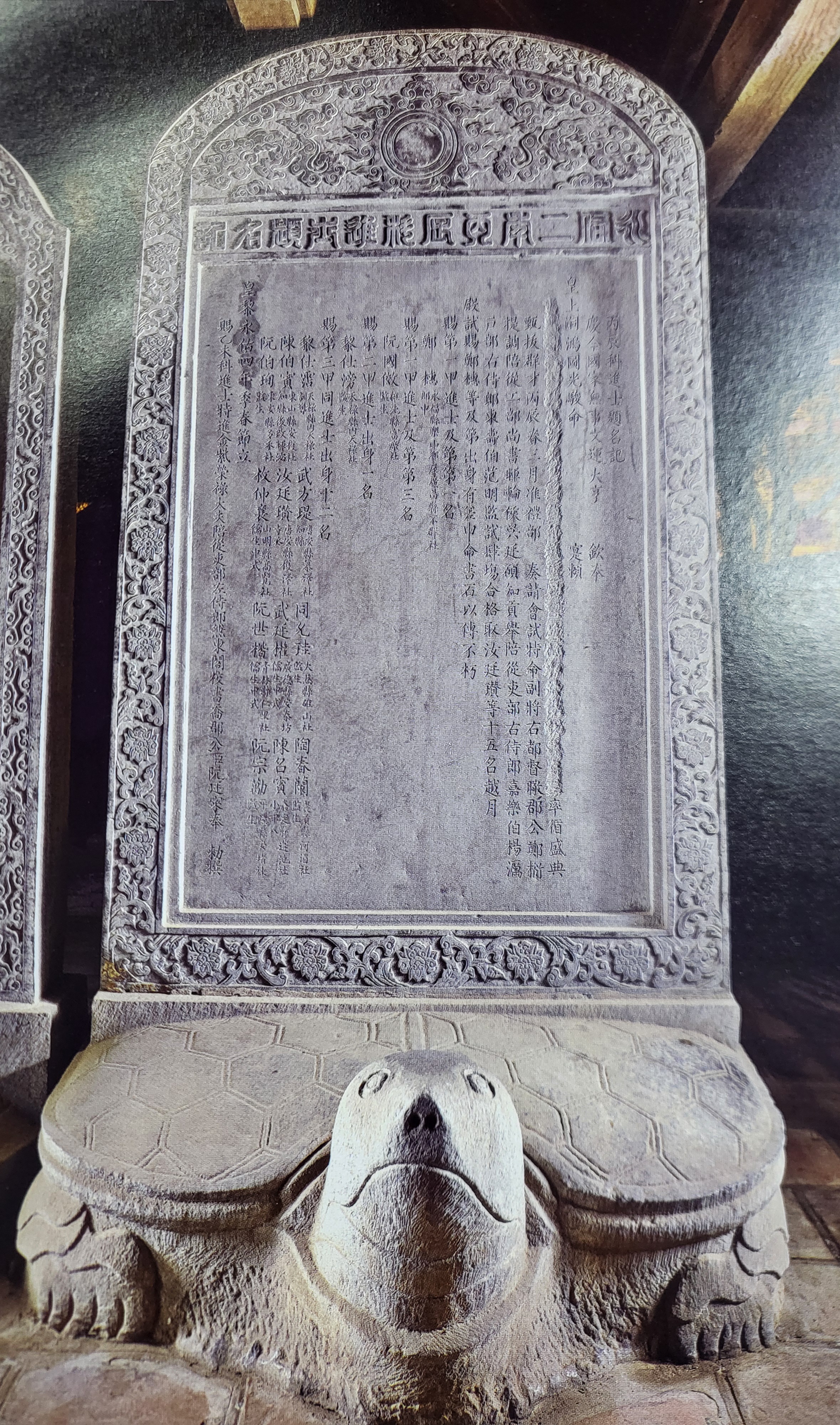
The stele honoring the laureates of the 1736 examination still bears Trạng Nguyên Trịnh Tuệ's name, placed at Văn Miếu – Quốc Tử Giám.
AV
TL: LH
-------------------------------
TÀI LIỆU THAM KHẢO
1. Các nhà khoa bảng Việt Nam 1075-1919, Ngô Đức Thọ chủ biên, NXB Văn học, 1993;
2. Kỷ yếu Hội thảo khoa học Tế tửu, tư nghiệp Quốc Tử Giám Thăng Long – Hà Nội, Trung tâm hoạt động VHKH Văn Miếu – Quốc Tử Giám, năm 2015, trang 123;
3. Văn Miếu – Quốc Tử Giám và 82 bia Tiến sĩ Thăng Long – Hà Nội, Ngô Đức Thọ chủ biên, Trung tâm hoạt động VHKH Văn Miếu – Quốc Tử Giám, năm 2002, Văn bia Tiến sĩ khoa thi năm 1736.
BẮC NINH – THE HOMELAND OF SCHOLARS WHO HELD THE POSITIONS OF TẾ TỬU AND TƯ NGHIỆP AT QUỐC TỬ GIÁM
The position of Tế tửu at Quốc Tử Giám (principal) was responsible for overseeing Văn Miéu – Quốc Tử Giám, training scholars, cultivating talents, and presiding over ceremonial rites at Văn Miếu. Beneath the Tế tửu was the Tư nghiệp (vice principal) who assisted the Tế tửu. During the Trần Dynasty, when the position of Tế tửu did not yet exist, the Tư nghiệp led the Quốc Tử Giám.
The royal court often appointed renowned Confucian scholars and high-ranking officials of high moral integrity to the positions of Tế tửu and Tư nghiệp. From the time these positions were established (in 1328) until the end of the Lê Dynasty, there were 97 Tế tửu and Tư nghiệp in the nation, with Bắc Ninh alone having 19 of these officials.

An Nhiên
TL: LH
A FAMILY WITH TWO GENERATIONS SERVING AS PRINCIPALS OF QUỐC TỬ GIÁM
This is the family of the great poet Nguyễn Du. His father, Nguyễn Nghiễm, and his older brother, Nguyễn Khản, were both high-ranking officials who held prestigious positions at Quốc Tử Giám, the institution responsible for educating the nation's most talented scholars. Both of them served as Tế tửu, the highest position at Quốc Tử Giám.
Principal Nguyễn Nghiễm of Quốc Tử Giám
Nguyễn Nghiễm was from Tiên Điền Village, Nghi Xuân District, Hà Tĩnh Province. In the 3rd year of the Vĩnh Khánh era (1731), Nguyễn Nghiễm passed the imperial examination, ranking second in the Hoàng giáp category. At just 24 years old, he was referred to as a "thiếu tuấn" (a young and brilliant talent), the youngest among the successful candidates in that examination.
After his success, Nguyễn Nghiễm served as a mandarin for over 40 years, holding many significant positions in the Lê-Trịnh court. Remarkably, although he came from a scholarly background, Nguyễn Nghiễm was also a skilled military commander, frequently sent by the court to quell uprisings. In 1767, while serving as Minister (Thượng thư), he concurrently held the role of Tri Quốc Tử Giám (Head of Quốc Tử Giám). This dual role as Tri Quốc Tử Giám was a testament to the court's trust in his abilities and virtue.
Principal Nguyễn Khản of Quốc Tử Giám
Nguyễn Khản, the son of Nguyễn Nghiễm, was also a significant figure in the court and cultural circles of his time. After passing the imperial examination in the Canh Thìn year (1760) at the age of 27, Nguyễn Khản quickly rose to become a vital mandarin, including serving as Principal of Quốc Tử Giám. Nguyễn Khản's talents were not limited to politics and administration; he was also a master of music and the arts. He composed many new musical pieces, and his songs were widely circulated among the performers of that era, a testament to his diverse and awe-inspiring talents.
Both Nguyễn Nghiễm and Nguyễn Khản played critical roles in the development of Quốc Tử Giám, the nation's premier educational institution at the time. As Tế tửu, they were directly involved in managing and overseeing the training and cultivation of the country's most exceptional scholars.
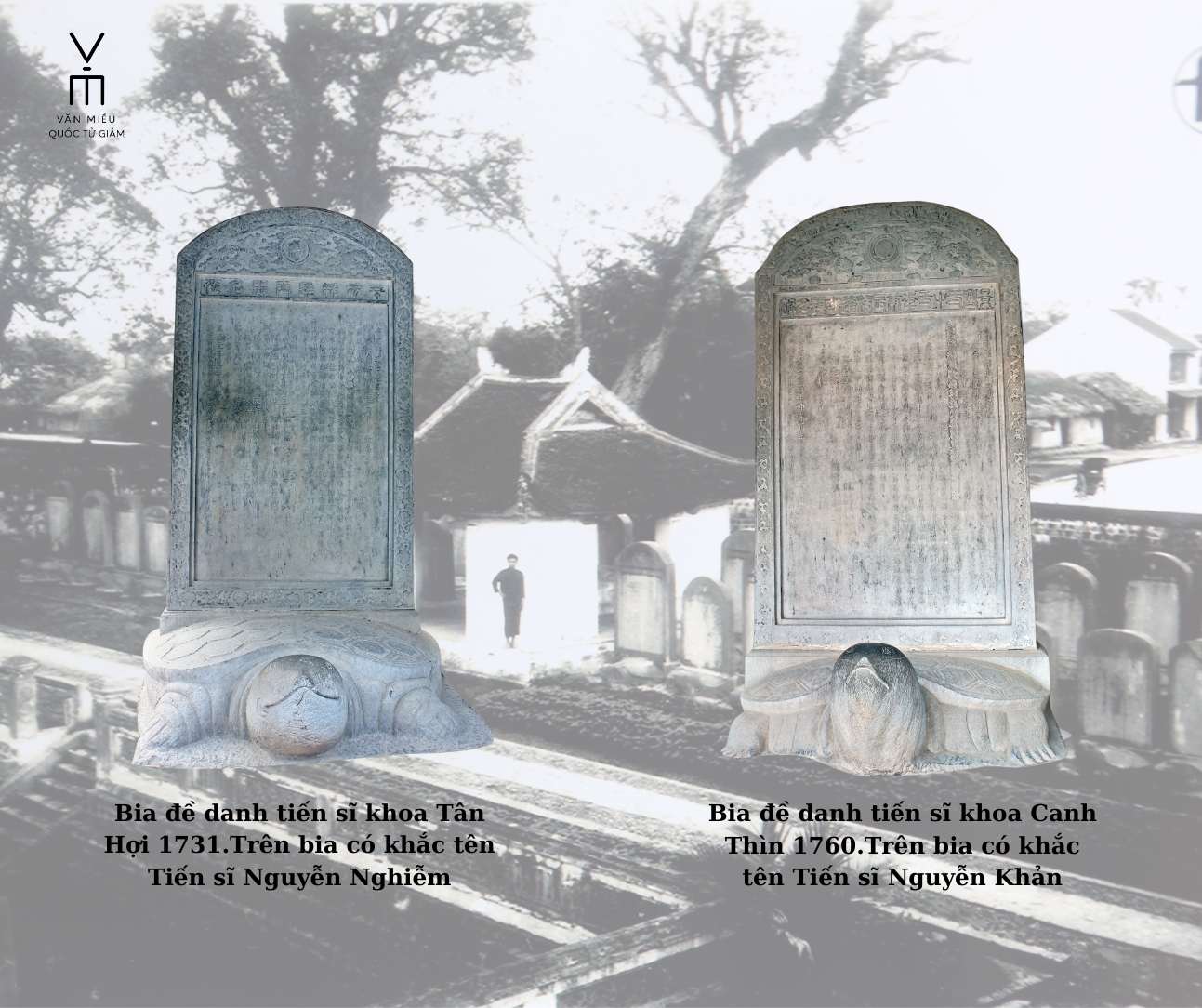
Tài liệu tham khảo:
1, Đại việt sử ký tục biên, Trung tâm khoa học xã hội và nhân văn quốc gia, Viện nghiên cứu Hán Nôm, Dịch giả: Ngô Thế Long và Nguyễn Kim Hưng, Hiệu đính: Nguyễn Đồng Chi, NXB Văn hóa thông tin, 2011
2. Văn Miếu – Quốc Tử Giám và 82 bia Tiến sĩ Thăng Long – Hà Nội, Ngô Đức Thọ chủ biên, Trung tâm hoạt động VHKH Văn Miếu – Quốc Tử Giám, năm 2002
3. Vũ Trung tùy bút, Phạm Đình Hổ, NXB Văn học, 2001
4. Bài văn bia khắc trên bia khoa thi Tiến sĩ năm 1760; 1769
5. Bức hoành phi “Cổ Kim Nhật Nguyệt” treo tại Bái Đường di tích Văn Miếu – Quốc Tử Giám
6. Chuông Bích Ung treo tại Bái Đường di tích Văn Miếu – Quốc Tử Giám
LH
THE LIFE AND CAREER OF QUỐC TỬ GIÁM PRINCIPAL NGUYỄN NGHI
Nguyễn Nghi (1588–1657) was born in Vân Điềm village, Đông Ngàn district (now Vân Điềm hamlet, Vân Hà commune, Đông Anh district, Hanoi), into a renowned aristocratic family of the time. His father, Nguyễn Thực, was a Minister and nobleman who passed the Royall Examination with the title of Hoàng giáp in 1595. From a young age, Nguyễn Nghi was immersed in a scholarly environment, displaying a love for learning and quickly mastering the classics under his father's guidance.
In 1619, at the age of 32, Nguyễn Nghi passed the royal examination as a Doctor in the Kỷ Mùi examination during the 20th year of Hoằng Đinh under Emperor Lê Kinh Tông. Like his father, his name was inscribed on the Doctoral steles at Văn Miếu – Quốc Tử Giám. After passing the exam, he was highly regarded by the court and entrusted with many essential responsibilities.
In 1630, Nguyễn Nghi was appointed Deputy Envoy on a mission to the Ming Dynasty. The Đại Việt Sử Ký Toàn Thư records: "In winter, November, the court sent Chief Envoys Trần Hữu Lễ and Dương Trí Trạch, with Deputy Envoys Nguyễn Kinh Tế, Bùi Bỉnh Quân, Nguyễn Nghi, and Hoàng Công Phụ in two diplomatic missions to pay tribute to the Ming Dynasty." After three years, Nguyễn Nghi and his delegation completed their mission and returned safely. The court gave them a grand reception, showing the importance and honor of the diplomatic missions.
After returning from his national duty, Nguyễn Nghi was given even greater responsibilities by the court. In 1645, he was promoted to Minister of Rites, bestowed the title Dương quận công, and given the role of overseeing the Kinh Diên (Imperial Academy), as well as the Academician and Tế tửu (Principal) of Quốc Tử Giám – a position responsible for the education and training of the nation's talents.
During his years dedicated to education, Nguyễn Nghi served as an examiner for the imperial exams, such as the Bính Tuất exam (1646) and Canh Dần exam (1650). In these exams, he held the position of Tri Cổng Cử, equivalent to the Vice Chief Examiner, with significant influence in advising the Chief Examiner on which candidates should pass or fail. In this role, Nguyễn Nghi was an administrator and a passionate educator devoted to cultivating talent for the nation.
In 1653, Nguyễn Nghi was promoted to Minister of Personnel, managing officials' appointment, promotion, and demotion and overseeing the allocation of salaries and ranks within the court.
In 1657, after many years of tireless service to the court and education, Nguyễn Nghi passed away at the age of 70, leaving behind deep sorrow for those who knew him. Emperor Lê, in respect, posthumously conferred upon him the title of Thái phó (Grand Tutor) and the posthumous title Cung Ý. Historical records note: "Nghi, along with his father Thực, were both promoted at the same time, serving as clean and cautious officials, holding prominent positions but valuing integrity and simplicity, focusing on nurturing talent. All his contemporaries respected him." Nguyễn Nghi remains a source of pride for his homeland and nation, a shining example for future scholars.
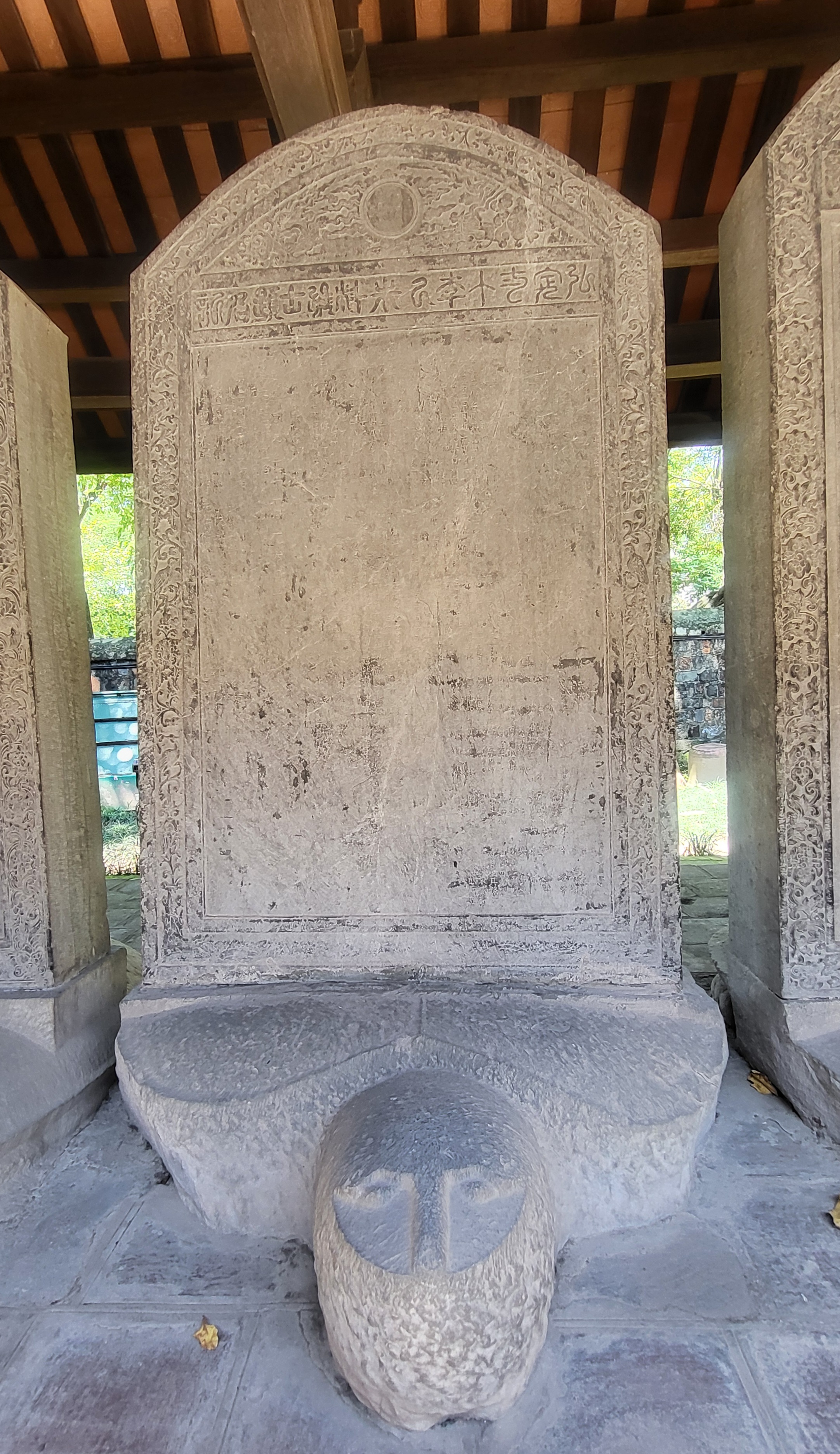
AV
TL:LH
PHD PHẠM ĐÔN LỄ (1457 – ?)
Phạm Đôn Lễ was originally from Hải Triều Village, Ngự Thiên District – now part of Phạm Lễ Commune, Hưng Hà District, Thái Bình Province. At the age of 27, he passed the Examination of the Tân Sửu year during the 12th year of the Hồng Đức reign (1481), under King Lê Thánh Tông, achieving the title of Đệ nhất giáp Tiến sĩ cập đệ Đệ nhất danh (Top Scholar). From the regional exams (Thi Hương), national exams (Thi Hội), to the royal exam (Thi Đình), he placed first in all stages, earning the title Tam nguyên Đôn Lễ (Triple-First Phạm Đôn Lễ) from his contemporaries.
Phạm Đôn Lễ served in the imperial court, eventually reaching the position of Deputy Minister (later promoted to Minister). He was later sent on a diplomatic mission, during which he learned a new mat-weaving technique from the northern region. Returning to his homeland, he taught the villagers and coastal areas this method. In Hải Triều Village, people had previously used an upright loom without horizontal support for the warp threads. Phạm Đôn Lễ introduced the horizontal loom with a support for the warp, which allowed the threads to be pulled tighter, producing mats that were more evenly woven and more beautiful. The mats from Hải Triều became famous for their fast-drying and water-resistant qualities and were adorned with patterns like the character Thọ (longevity), flowers, dragons, and phoenixes. The borders of these mats were solid and aesthetically pleasing. Thanks to this innovation, Hải Triều mats became well-known throughout the capital, and many villagers made a living from this craft.
Phạm Đôn Lễ's contributions were not forgotten after his passing. The people of Hải Triều, recognizing the impact of his innovations, built a temple in his honor. They venerated him as a guardian deity and bestowed upon him the title of 'Trạng Chiếu' (The Mat Scholar), a testament to the enduring legacy of his contributions.
Today, visitors to Văn Miếu – Quốc Tử Giám, a nationally recognized historical site, can admire the stele from the Tân Sửu examination (1481), which engraved the name and birthplace of Top Scholar Phạm Đôn Lễ.
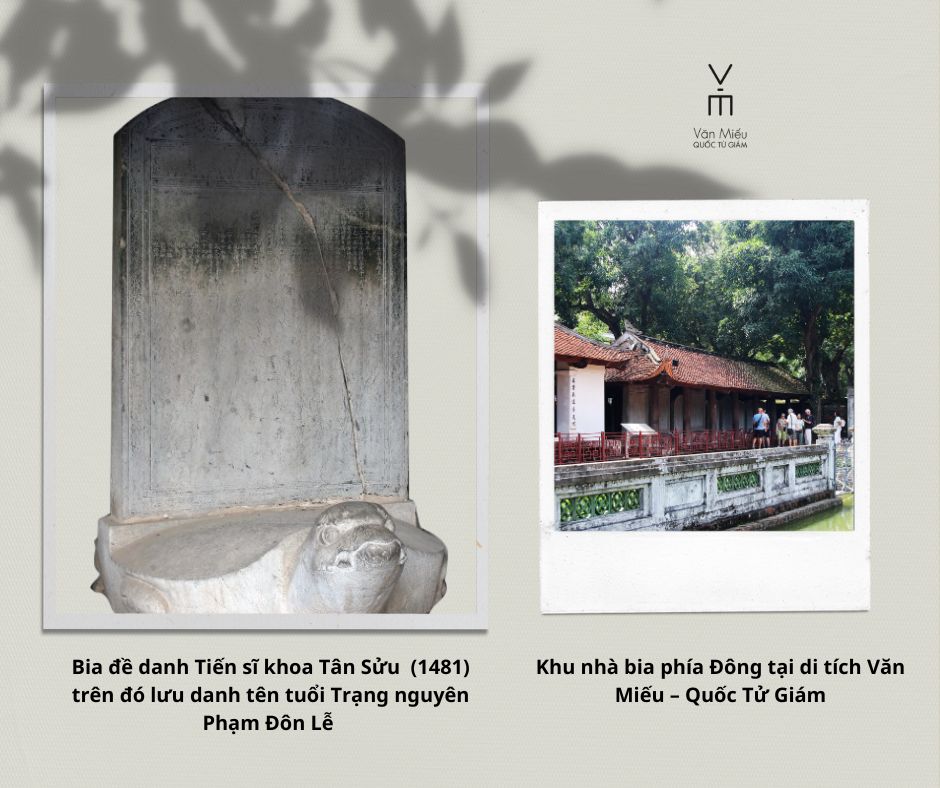
Thúy Hồng
TL: LH
TÌM HIỂU 3 VỊ TAM KHÔI KHOA MẬU TUẤT NIÊN HIỆU HỒNG ĐỨC 9 (1478)
Khoa Mậu Tuất niên hiệu Hồng Đức 9 (1478) là khoa thi lấy đỗ được nhiều nhất các vị Tiến sĩ, 62 người. Có 3 người đỗ đầu (tam khôi) của khoa thi này. Đó là Bảng nhãn Lê Quảng Chí, Thám hoa Trần Bích Hoành và Lê Ninh.
Bảng nhãn Lê Quảng Chí (1454 -?) là người xã Kỳ Phương, huyện Kỳ Anh, tỉnh Hà Tĩnh. 25 tuổi, ông đỗ Đình nguyên, Đệ nhất giáp tiến sĩ cập đệ Đệ nhị danh, Bảng nhãn (đỗ đầu) khoa Mậu Tuất niên hiệu Hồng Đức 9 (1478) đời vua Lê Thánh Tông. Sau khi thi đỗ, ông làm quan và trải qua nhiều chức vụ quan trong triều đình. Mùa hè năm Ất sửu (1505), ông được bổ chức Đông các đại học sĩ (đứng đầu cơ quan văn học của triều đình, phụng mệnh vua các bài chế, chiếu, biểu vua ban sửa chữa). Đến năm Kỷ Tỵ (1509), ông được thăng Tả thị lang bộ Lễ, đứng đầu Hàn lâm viện (chức quan sau Thượng thư, lo việc lễ nghi, tế lễ, giám sát việc giáo dục, thi cử). Ông làm quan ở triều 32 năm. Sau khi mất, ông được thăng chức Thượng thư (tương đương Bộ trưởng), được phong phúc thần. Tác phẩm của ông hiện còn 6 bài thơ chữ Hán chép trong Toàn Việt thi lục.
Thám hoa Trần Bích Hoành (1452 -?) là người xã Kim Thái, huyện Vụ Bản, tỉnh Nam Hà. Năm 27 tuổi, ông đỗ Đệ nhất giáp Tiến sĩ cập đệ đệ tam danh (Thám hoa) (đỗ thứ hai) khoa Mậu tuất niên hiệu Hồng Đức 9 (1478) đời Lê Thánh Tông. Ông làm quan đến chức Đông các (những lời vua ban, truyền về việc quan trọng của triều đình, phụng mệnh vua ban sửa chữa).
Thám hoa Lê Ninh (1448-?) người xã Liên Châu, huyện Vĩnh Lạc, tỉnh Vĩnh Phú. Ông nội Lê Hiến. 31 tuổi, ông đỗ Hội nguyên, Đệ nhất giáp tiến sĩ cập đệ đệ tam danh (Thám hoa), (đỗ thứ hai) đời Lê Thánh Tông. Từng được cử đi sứ. Ông làm quan đến chức Hộ bộ Tả thị lang, kiêm Vương phó. Khi mất được tặng chức Thượng thư (Bộ trưởng).
Tên tuổi và quê quán của 3 vị tam khôi được khắc trên bia đề danh Tiến sĩ khoa thi Mậu Tuất 1478 hiện lưu giữ tại di tích Quốc gia đặc biệt Văn Miếu – Quốc Tử Giám.

Bia đề danh Tiến sĩ khoa Mậu Tuất niên hiệu Hồng Đức 9 (1478) tại di tích Văn Miếu - Quốc Tử Giám
Thúy Hồng
THE THREE TOP SCHOLARS OF THE 1463 IMPERIAL EXAMINATION
In the Quý Mùi examination during the 4th year of Quang Thuận (1463), 44 individuals earned the title of Doctor (doctoral laureates). Their names are inscribed on a stele in Văn Miếu - Quốc Tử Giám. Among these distinguished scholars, the top three achievers (the tam khôi) were renowned for their talents and contributions. After passing the examination, they dedicated their abilities to serving the king and the country.
The first title Lương Thế Vinh (1441-?): He was from Cao Hương village, Thiên Bản district (Nam Định), and was famous for being a child prodigy. He passed the top scholar examination at the age of 22. Lương Thế Vinh served in the court, rising to the position of Academy's mandarin (explaining laws, annotating documents, poetry, etc.), and held various other roles. He drafted all diplomatic correspondence with the Ming dynasty and authored the book "Đại thành toàn pháp." (math book)
The second title Nguyễn Đức Trinh (1439 – 1472): He hailed from An Giới village, Thanh Lâm district (now part of An Sơn commune, Nam Sách district, Hải Dương). At the age of 25, he passed the second scholar examination. Nguyễn Đức Trinh was the Deputy Imperial Censor (overseeing officials' misconduct and reporting on governmental shortcomings). Unfortunately, he fell ill and died while on a diplomatic mission to the Ming dynasty to negotiate matters concerning Champa. He was posthumously honored with the title of Minister.
The third title Quách Đình Bảo (1440 - ?): He was from Phúc Khê village, Thanh Lan district (now Thái Phúc commune, Thái Thụy district, Thái Bình province). Quách Đình Bảo passed the third scholar examination at the age of 24. 1470, after a mission to the Ming dynasty, he was promoted to Minister of Mandarinate (responsible for appointments, promotions, evaluations, and dismissals of officials). In 1484, he was tasked with overseeing the construction of the first series of Doctoral steles at Văn Miếu - Quốc Tử Giám.
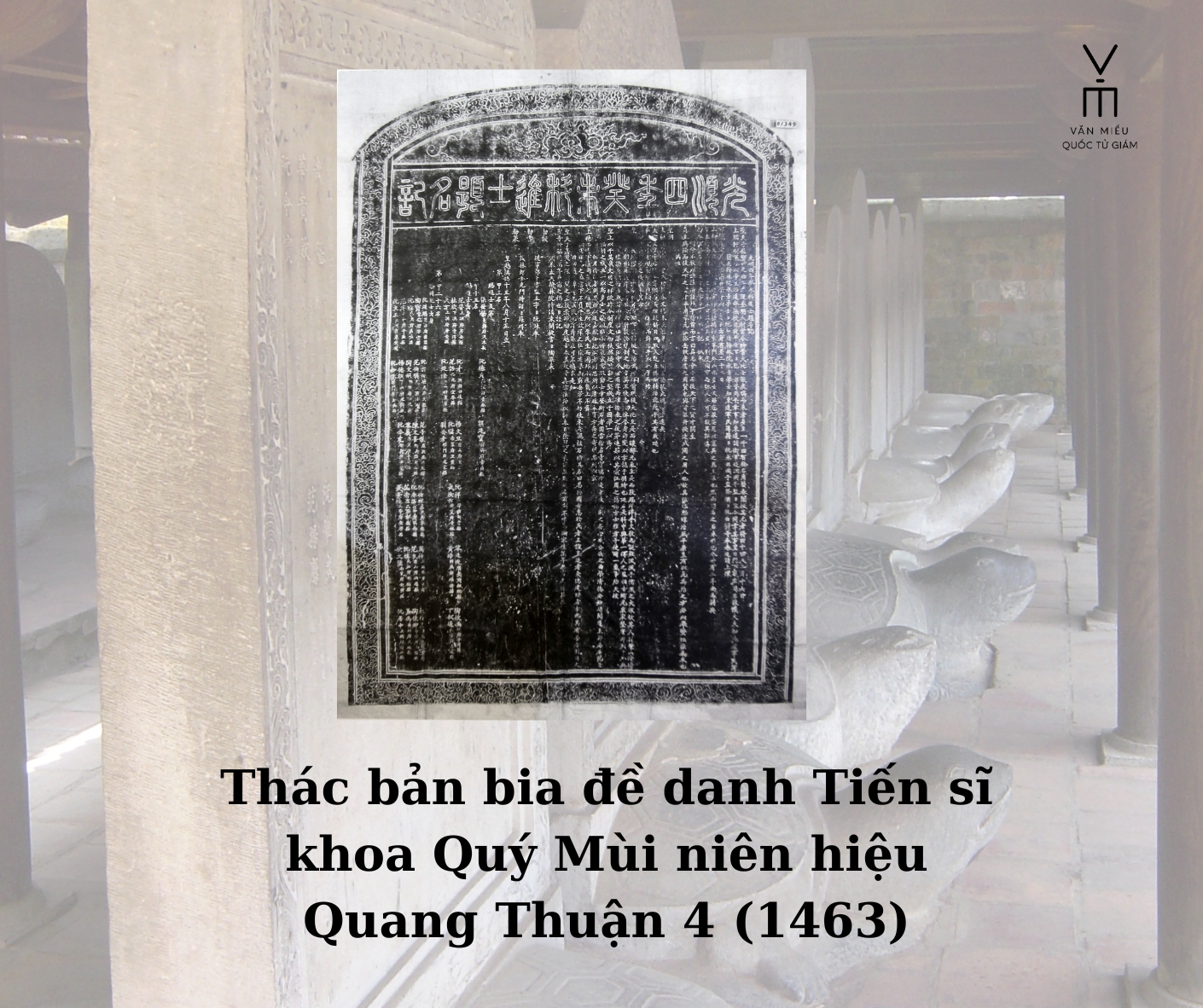
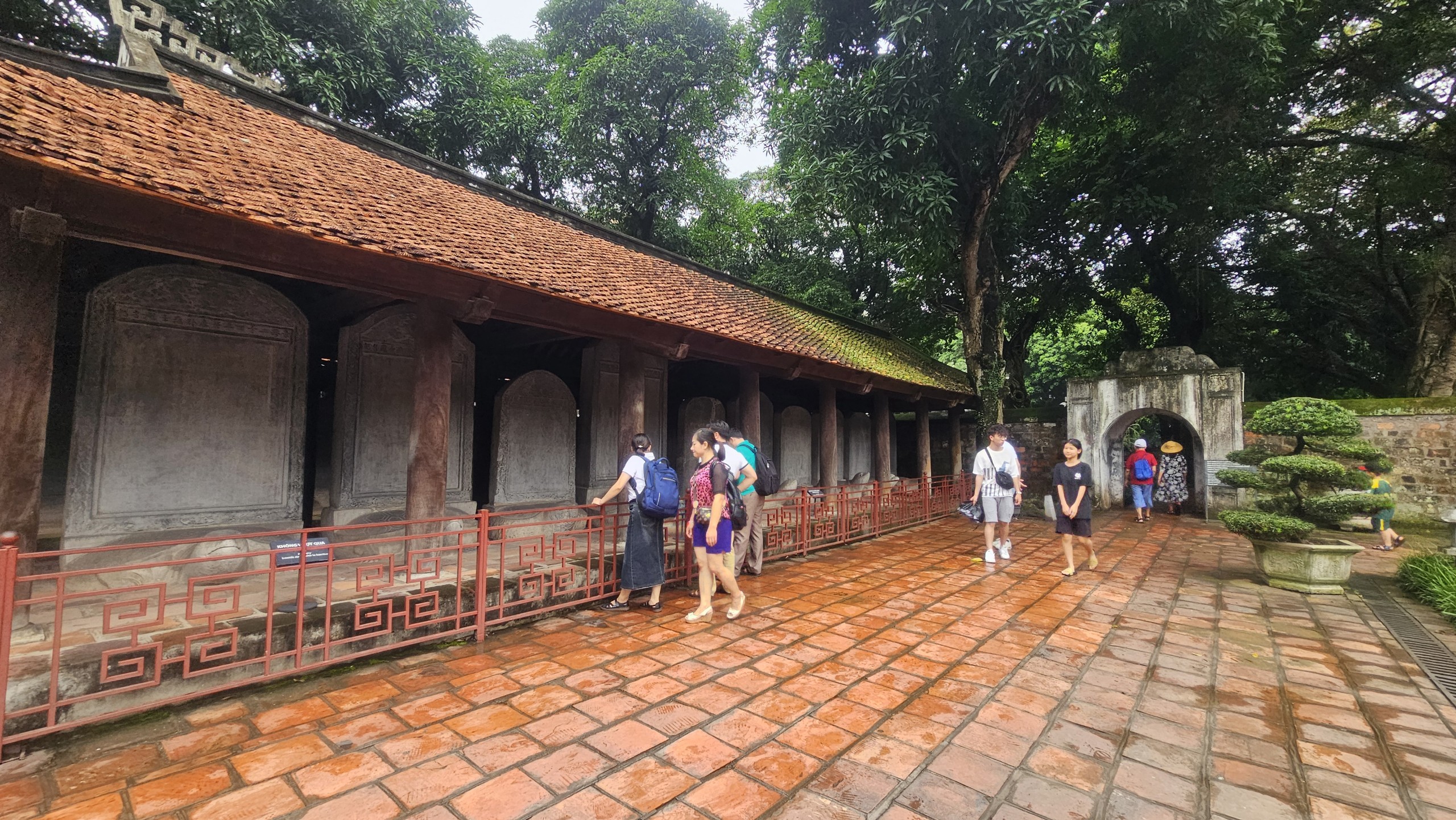
LH
HEADMASTER OF QUỐC TỬ GIÁM NGUYỄN BÁ KÝ - DOCTORATE LAUREATE OF THE 1448 EXAMINATION
Nguyễn Bá Ký (? – 1465) was from Viên Nội village, Chương Đức district (now Viên Nội commune, Ứng Hòa district, Hanoi). He passed the doctoral examination in 1448.
In 1452, he was appointed as Deputy Envoy to the Ming Dynasty. He served as Minister and taught at the Kinh Diên Hall (a special place for teaching the king). King Lê Thánh Tông highly valued his poetry and prose, which earned him frequent proximity to the king. Historical records note that he once submitted a memorial to the king, advising him to pay more attention to the classics and historical texts. He was later promoted to Principal of the Quốc Tử Giám (National University). He concurrently held the position of Grand Academic at the Văn Minh Institute (an advisory role to the king on important matters).
In 1463, while serving as Principal of the Quốc Tử Giám, he was appointed as one of the examiners for the 1463 examination. The court usually selected these positions from the most talented, virtuous, and knowledgeable officials. In November 1465, Nguyễn Bá Ký passed away. He was one of the 27 doctorate laureates of the 1448 examination who contributed their talents to building a peaceful and prosperous nation.
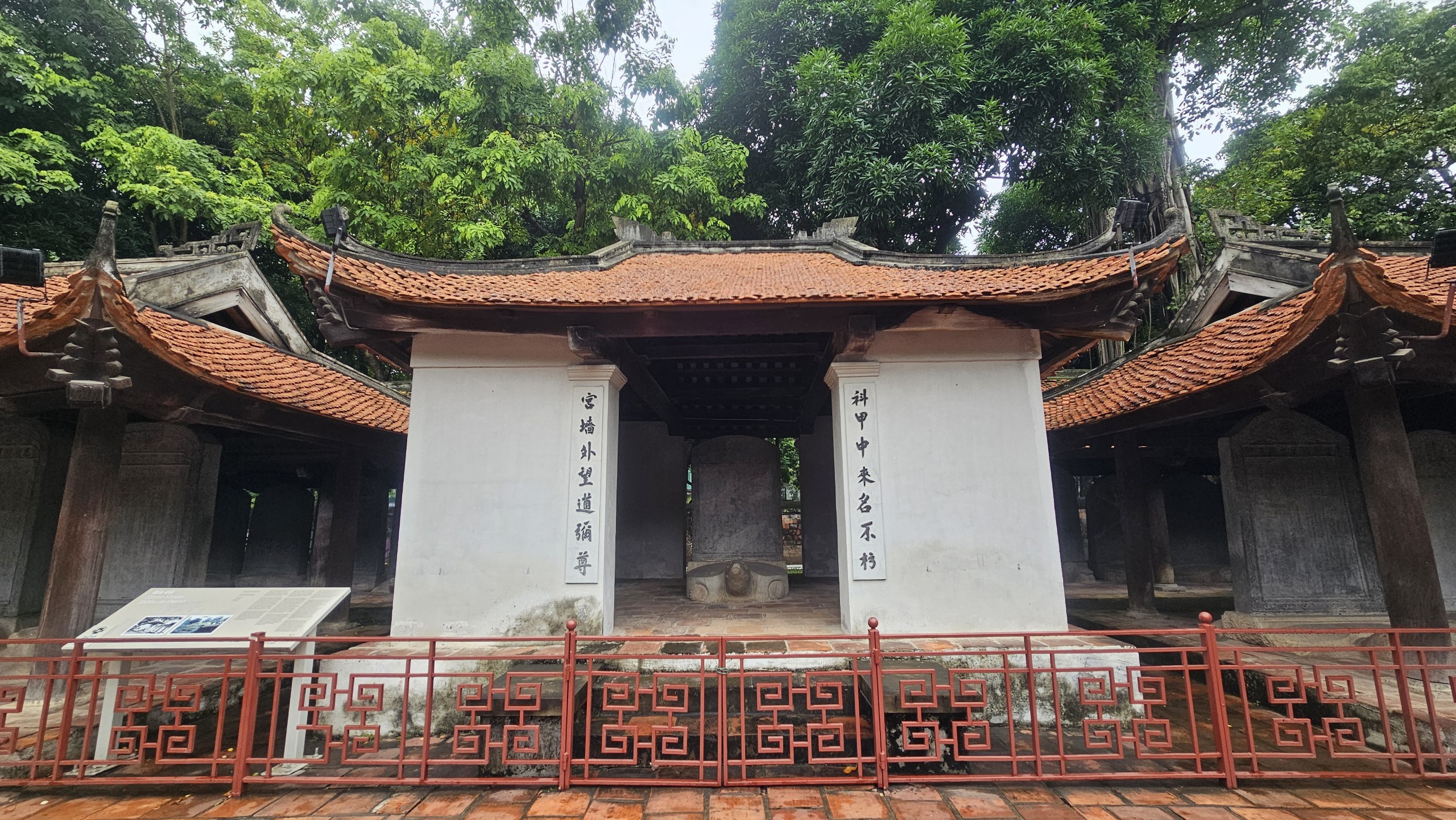
LH
THE DOCTORS OF THE 1442 IMPERIAL EXAMINATION WHO SERVED AS RECTORS AND VICE-RECTORS OF THE FIRST NATIONAL UNIVERSITY
In 1442, 33 candidates passed the imperial examination and were conferred doctoral degrees. Following their success, they significantly contributed to the nation across various fields, such as politics, history, and education.
Among them, four distinguished doctors, revered for their significant contributions to the education and training of the country's talents, stand out. As leaders of the first national university they were not only revered teachers but also talented education administrators and high-ranking officials with commendable governance abilities and high moral standing.
Nguyễn Trực, hailing from Bối Khê village, Thanh Oai district (now Song Khê hamlet, Tam Hưng commune, Thanh Oai district, Hanoi), was a man of extensive knowledge and exceptional talent. His dedication to serving the king and the country was unwavering. He once represented Vietnam in diplomatic missions to China, earning admiration from the Ming Dynasty for his eloquence and quick wit, being honored as the "Double Country Champion." Nguyễn Trực's role as an upright official, an outstanding politician frequently consulted by the king on confidential matters, and an exemplary educator was a testament to his dedication. In the fourth year of Hồng Đức (1473), he was promoted to Grand Master of Ceremonies and Chief of the first national university, becoming the head of the largest national university. A renowned poet and esteemed Tao Đàn literary society member, he was highly respected by the king and court officials. Legend has it that King Lê Thánh Tông often sought his opinion on newly composed poems.
Nguyễn Như Đổ (1424-1525), from Đại Lan village, Thanh Đàm district, Sơn Nam province (now Đại Lan hamlet, Duyên Hà commune, Thanh Trì district, Hanoi), played significant roles in numerous imperial examinations. His integrity and diligence were known far and wide, and in 1462, when the renowned Ming envoy Tiền Phổ, famous for his debates and criticisms, came to Vietnam, Nguyễn Như Đổ was entrusted by King Lê Thánh Tông to receive him. During the 12 days of his visit, Tiền Phổ was deeply impressed by Nguyễn Như Đổ's vast knowledge. He was appointed as Rector of the first national university in 1486, serving for over 10 years before retiring. Nguyễn Như Đổ lived for the past 100 years and is remembered as a rare talent in Vietnam's history.
Ngô Sĩ Liên was born in Chúc Lý village, Chương Đức district, Ứng Thiên prefecture (now Chúc Lý hamlet, Ngọc Hòa commune, Chương Mỹ district, Hanoi). He graduated at the top of the third rank of doctoral laureates. After passing the examination, he held several key positions in the court. Under King Lê Thánh Tông (1460-1497), he served as the Deputy Minister of Rites, responsible for ceremonies, sacrifices, banquets, education, examinations, clothing, seals, petitions, essays, and diplomatic missions. In the 12th year of Quang Thuận (1471), he was appointed as a historiographer, directly involved in compiling the national history at the National Institute of History. By the 10th year of Hồng Đức (1479), he completed the "Complete Annals of Đại Việt." While a historiographer, he also oversaw its teaching programs as Vice Rector of the first national university. Ngô Sĩ Liên retired and passed away in his hometown, where the villagers venerated him.
Phan Viên was from Bàn Thạch village, Thạch Hà district (now Can Lộc district, Hà Tĩnh province). While historical records about him are scarce, it is known that after passing the examination, he became the Rector of the first national university. He must have had great talent and virtue to hold such a significant position in the most prominent educational institution. His son, Phan Ứng Toản, also passed the imperial examination in 1481 and served as Rector of the Imperial Academy.
The 1442 imperial examination was the first to have its laureates' names inscribed on steles at Văn Miếu – Quốc Tử Giám 540 years ago. The names of these doctors are eternally commemorated on these steles.
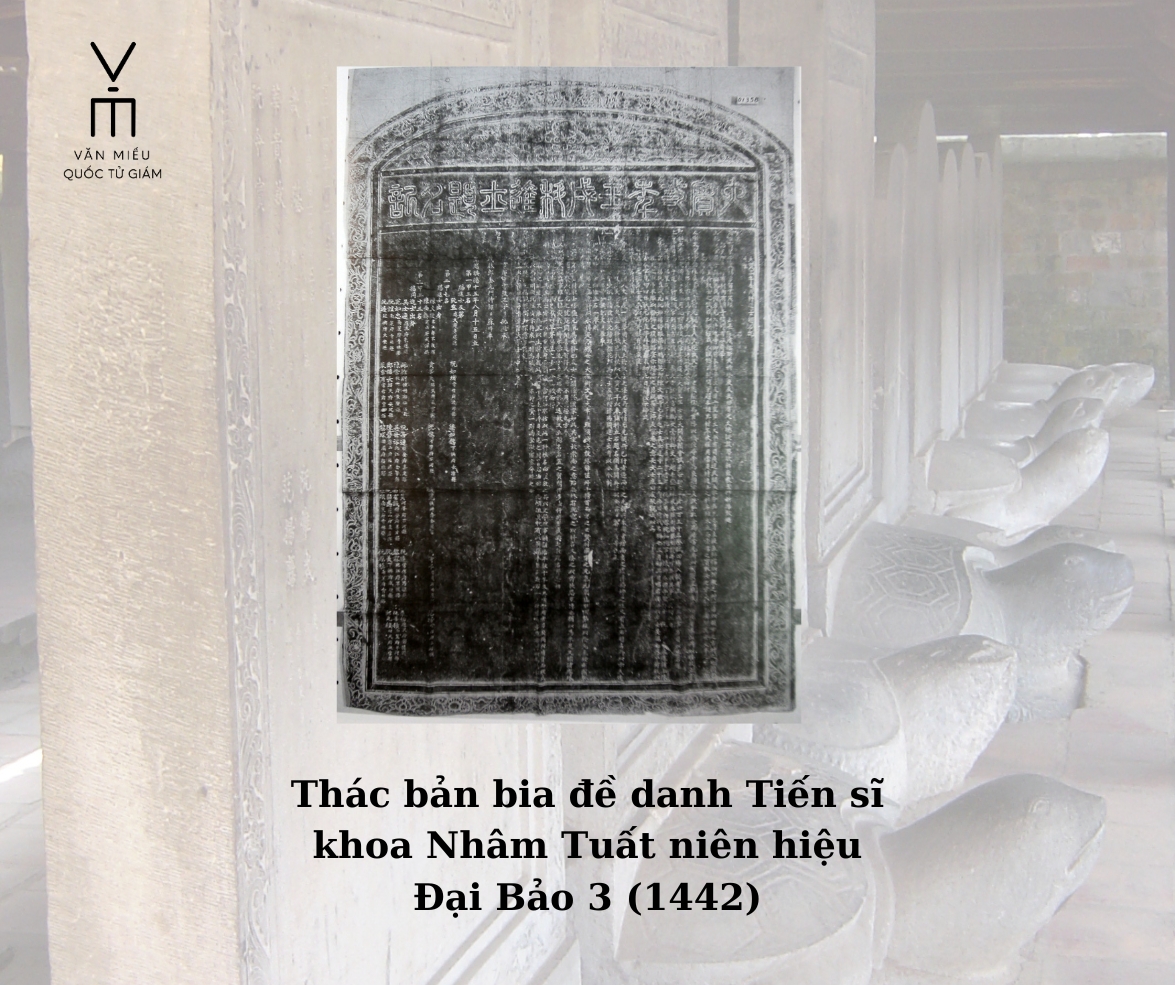
LH
THE SCHOLAR NGUYỄN NGHIỄM AND VĂN MIẾU – QUỐC TỬ GIÁM
Nguyễn Nghiễm was born in the year Mậu Tý (1708) in Tiên Điền village, Nghi Xuân district, Hà Tĩnh province. He was the father of the great poet Nguyễn Du. In the year Canh Tý (1720), he passed first in the county examination in Nghi Xuân. Four years later, in the year Giáp Thìn (1724), he passed the Hương cống examination at the Nghệ An examination hall. This marked the beginning of his significant association with Văn Miếu – Quốc Tử Giám.
In 1721, it was decreed that those who passed the regioanl exam, as well as the sons of meritorious officials and civil or military mandarins, could be appointed as Giám sinh (students) at Quốc Tử Giám. Therefore, after passing the regioanl exam, Nguyễn Nghiễm was appointed as a Giám sinh at Quốc Tử Giám. According to the Nguyễn Tiên Điền family genealogy, during his studies at the Giám, he became famous throughout the capital for his exceptional performance in regular and major examinations. In 1731, the third year of Vĩnh Khánh's reign, Nguyễn Nghiễm ranked second (Hoàng giáp). This examination saw only 12 successful candidates, of whom only three were Giám sinh. His name was inscribed on a stele at Văn Miếu a year later, marking the first of his many significant achievements.
The second time his name was inscribed on the doctoral stele at Văn Miếu – Quốc Tử Giám was in 1754 when he served as the Chief Examiner for the Hội (national examination of the year Giáp Tuất, the 15th year of Cảnh Hưng's reign. As the Chief Examiner, Nguyễn Nghiễm was responsible for overseeing the examination process, ensuring its fairness and integrity, and evaluating the performance of the candidates. His role was crucial in maintaining the high standards of education and scholarship upheld by Văn Miếu.
The third inscription of his name on the stele at Văn Miếu was in 1763. He wrote the commemorative text for the doctoral examination by royal order in 1760. This text, a testament to his literary skills and his deep understanding of Confucian education, was a reflection of his views on the importance of education in shaping the future of the nation. This stele was erected in February of the year Quý Mùi, the 24th year of Cảnh Hưng's reign (1763).
Another stele bearing Nguyễn Nghiễm's name was erected in October of the year Kỷ Sửu, the 30th year of Cảnh Hưng's reign (1769), for the doctoral examination held that year. However, this time, he was credited as the editor of the text. Typically, the authors of the inscriptions on these steles were talented writers capable of fully expressing the ideals and politics of the reigning dynasty.
When appointed to lead Quốc Tử Giám, Nguyễn Nghiễm wholeheartedly dedicated himself to stabilizing and consolidating the institution's order and promoting Confucian education. His first task, in line with higher directives, was to uphold discipline and promote Confucian values. In the year Mậu Tý (1768), he created a large plaque with the four characters “Cổ kim nhật nguyệt” Also in that year, he sought permission to cast four small bells and one large bell. Unfortunately, the four small bells no longer exist, but the large bell (Bích Ung đại chung) still hangs in the Bái Đường hall and is rung during ceremonies honoring the ancient sages at Văn Miếu.
Quốc Tử Giám served as both a place for forging and training learned and intelligent individuals to contribute to the country's educational development and a venue for Nguyễn Nghiễm to express his thoughts and aspirations concerning contemporary issues and the state.
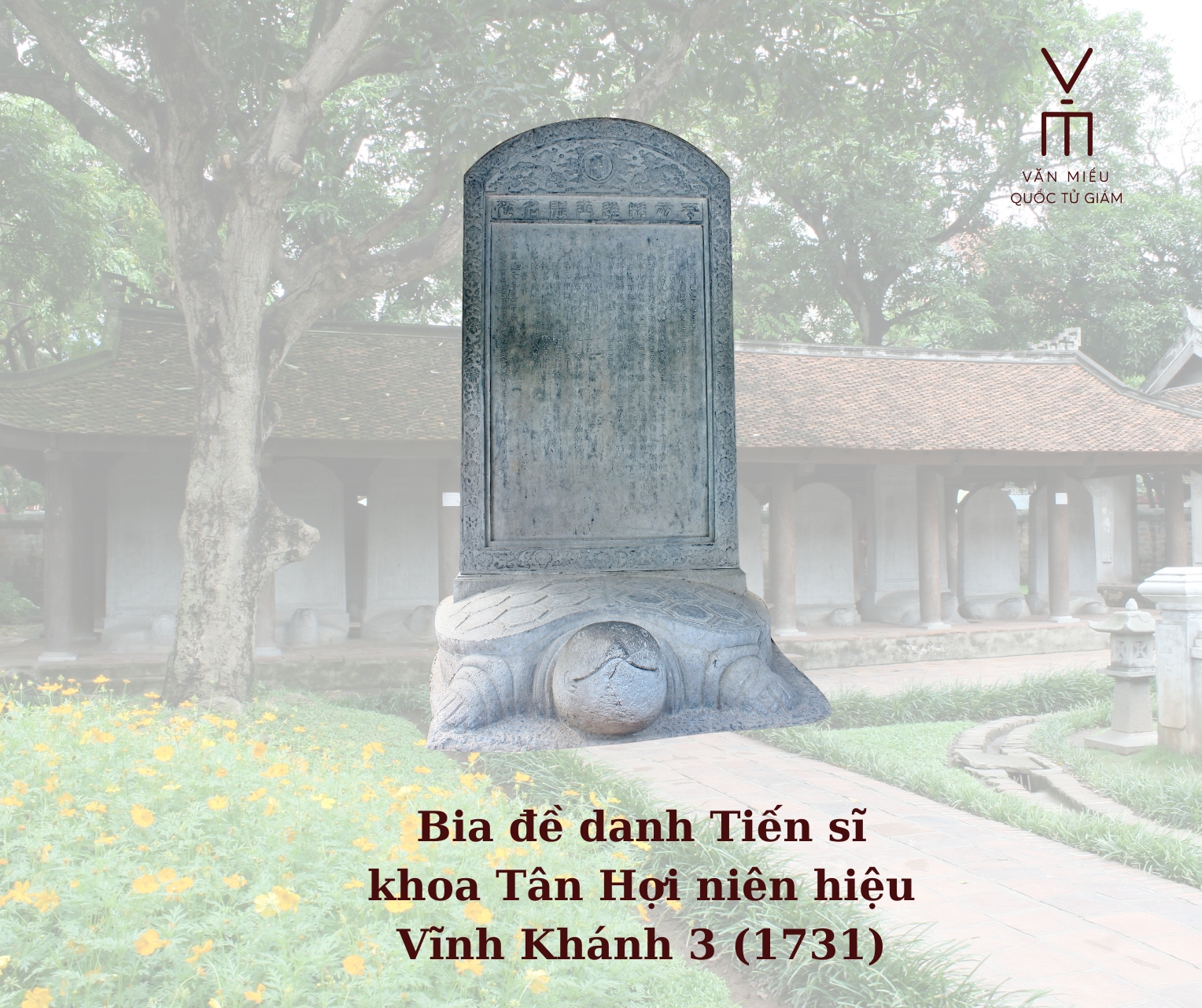
LH
LÊ VĂN THỊNH - A TRENDSETTER IN SUCCESSFUL VIETNAMESE DOCTORS.
Lê Văn Thịnh, a native of Bac Ninh province, was instilled with a love for poetry and literature by his father from a young age. His early passion for these arts not only shaped his character but also inspired those around him, as he generously shared his knowledge with friends and villagers.
His intelligence and love for reading set him apart. By the age of 13, he had a profound understanding of ancient doctrines and theories. At 18, he established a private school in Bac Ninh province, demonstrating his commitment to education and his desire to share his knowledge.
In 1075, King Lý Nhân Tông opened the first Confucian examination with three rounds, which honored Lê Văn Thịnh, a young prodigy, a trendsetter in successful Vietnamese doctors. Then, he was appointed as a high-ranking Mandarin to support the King.
In 1084, he was appointed to be assigned for national border planning, gained many contributions, and became a talented diplomat of Vietnam. Song dynasty in China returned to Vietnam, the area previously colonized, with no struggles. In 1085, Lê Văn Thịnh was appointed to the highest leadership position of an Emporer.
During his work, Lê Văn Thịnh made significant strides in social justice, reducing the punishment for crimes and the taxes for the poor farmers, a testament to his empathy and commitment to the well-being of his people.
(Ảnh: Cổng thông tin điện tử tỉnh Bắc Ninh bacninh.gov.vn)
Tham khảo:
1. Đại Việt sử ký toàn thư, Lê Văn Hưu, Phan Phu Tiên, Ngô Sĩ Liên… soạn thảo (1272 – 1697), Viện Khoa học Xã hội Việt Nam dịch, NXB Khoa học Xã hội (Hà Nội), 1993.
2. Các nhà khoa bảng Việt Nam (1075-1919), Ngô Đức Thọ chủ biên, NXB Văn học, 2006.

Tượng thờ Thái sư Lê Văn Thịnh – bậc khai khoa của các nhà khoa bảng Việt Nam tại Đền thờ Thái sư Lê Văn Thịnh (huyện Gia Bình, tỉnh Bắc Ninh)

Đền thờ Thái sư Lê Văn Thịnh (huyện Gia Bình, tỉnh Bắc Ninh)
Translator: BP
KING LÝ NHÂN TÔNG THROUGH THE EXHIBITION “PROLEGOMENON TO THE TRADITION OF EDUCATION IN VIETNAM "
At the Thái Học House in Văn Miếu – Quốc Tử Giám, there is currently an exhibition “Prolegomenon To The Tradition Of Education In Vietnam " recounting the life, career, and significant contributions of those luminaries who laid the foundation for education in Vietnam, among whom is King Lý Nhân Tông, the talented monarch of the Lý dynasty.
King Lý Nhân Tông (1066-1128) was the fourth king of the Lý dynasty, the son of King Lý Thánh Tông and Queen Ỷ Lan, known for his significant contributions to the education system and the recognition of talents.
Through various documents and artifacts displayed here, it can be seen that King Lý Nhân Tông was a wise and insightful ruler, a philosopher king who revered Buddhism, esteemed Confucianism, and notably contributed to the education, training, and recognition of talents in Vietnam.
King Lý Nhân Tông was the first student to study at the Văn Miếu. Ancient records state: "In the year 1070, Prince Càn Đức came to Văn Miếu to study Confucianism. He was the first student to study at Văn Miếu."
In 1075, King Lý Nhân Tông established the first examination session in the history of our country's Confucian examination system to select scholars for government positions. The top scorer of this examination was Lê Văn Thịnh, considered the pioneer of the nation. In 1076, the king established the Quoc Tu Giam - the first national school, selecting literati officials, anyone literate was admitted to Quốc Tử Giám. This demonstrates that King Lý Nhân Tông laid the foundation for the development of Confucianism in Vietnam, initiated the examination education system, recognized talents, and contributed to the construction of the country's culture.
In addition to promoting Confucian education, King Lý Nhân Tông was also a devout Buddhist. He and Queen Linh Nhân built many pagodas and towers in the country, such as Dai Lam Son Pagoda, An Lao Pagoda, and Vĩnh Phúc Pagoda...
In 1075, King Nhân Tông sent Lý Thường Kiệt and Tôn Đản to lead 100,000 troops divided into three routes to fight against the Song army (1075-1077). Victory at the Như Nguyệt River defense line opened up a long period of independence for the nation.
Beloved by the people, Lý Nhân Tông introduced Buddhism into social life and implemented many measures to improve agricultural productivity, such as digging irrigation canals, building dykes to prevent flooding, banning the killing of cattle for meat, and establishing granaries. The exhibition also introduces an excerpt from the Vietnamese Chronicle (Thuận Hóa Publishing House, 2005, p.1111): "In the year Đinh Tỵ (1077),... In the autumn of September, a dyke was built along the Nhu Nguyệt River for 67,380 steps. Digging canals, dredging rivers, diverting water for agriculture, repairing and building a system of dykes to prevent floods. Lý Nhân Tông also issued decrees prohibiting the killing of cattle for meat. Those who violated the decree would be punished according to the law.
He respected rituals and practiced ceremonial rituals, respected monks, priests, artists, and intellectuals. Lý Nhân Tông also directly composed music and poetry. King Lý Nhân Tông was praised as "the gatherer of myriad flowers of celestial poetry, harmonizing the sounds of Buddhism." The artistic life under the reign of King Lý Nhân Tông was truly rich and diverse, with beautiful lyrics, melodious melodies, solemn dances, and graceful dances reflecting a very peaceful and prosperous country.
With a modern and attractive design style, through historical information and documents, the exhibition "The Origin of Education" vividly portrays the life and career of King Lý Nhân Tông, as well as his significant contributions to the country's education system.
King Lý Nhân Tông also revered Buddhism, so under his prosperous reign, he built many pagodas and towers, cast bells, and sculpted statues with the desire to create beautiful landscapes for the country. He valued rituals and ceremonial practices, respected monks, priests, artists, and intellectuals..."


Thúy Hồng
TL: LH
THÁM HOA LƯƠNG NHƯ HỘC – ÔNG TỔ NGHỀ IN KHẮC GỖ Ở NƯỚC TA
Lương Như Hộc người xã Hồng Liễu, huyện Trường Tân xưa (nay là thôn Thanh Liễu, xã Tân Hưng, Hải Dương). Thời vua Lê, ông từng hai lần được cử đi sứ nhà Minh và học được nghề in khắc gỗ, về truyền dạy cho dân làng. Sau ông được dân tôn vinh là Tổ sư nghề khắc ván in sách.
Ngay từ nhỏ, Lương Như Hộc đã nổi tiếng thông minh, ham học, hiếu thảo. Năm 1442, ông đỗ Thám hoa đời vua Lê Thái Tông, tên của ông được lưu danh trên bia Tiến sĩ đặt tại Văn Miếu – Quốc Tử Giám. Ông làm quan đến chức Đô ngự sử, là người có tài, được vua tín nhiệm cử đi sứ hai lần và đây chính là cơ duyên đưa ông đến với việc học nghề in mộc bản của Trung Hoa, tạo nên dấu ấn lớn nhất trong cuộc đời ông – đó là công lao với nghề in mộc bản của nước ta.
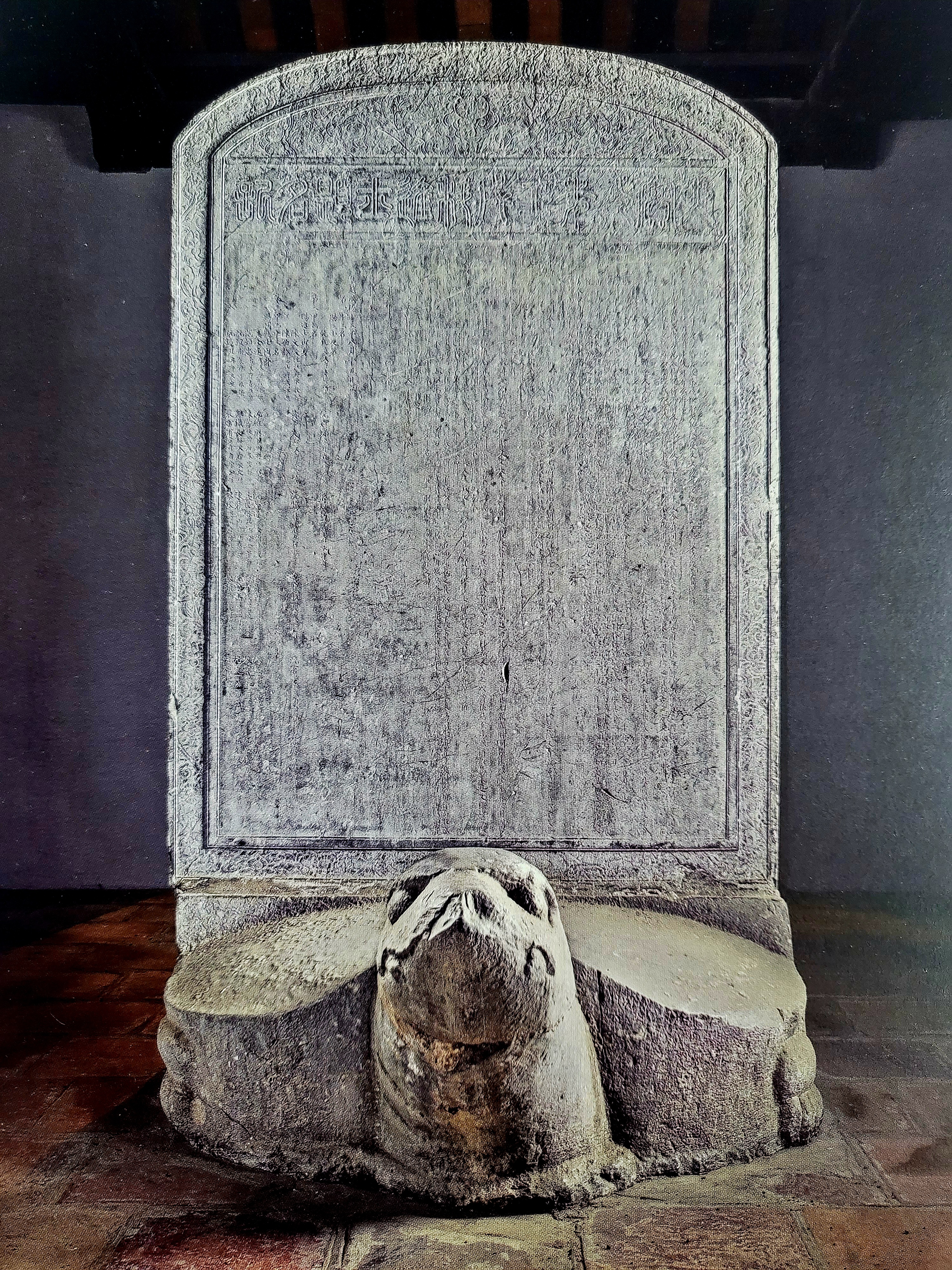
Tấm bia Tiến sĩ khoa thi năm 1442 lưu danh Thám hoa Lương Như Hộc tại Văn Miếu – Quốc tử Giám.
Đại Việt sử ký toàn thư có chép rằng, Lương Như Hộc được vua Lê 2 lần cử đi sứ nhà Minh. Lần đầu tiên vào năm 1443, “vua sai bọn Ngự sử trung thừa là Hà Phủ, Hàn lâm viện tri chế cáo Nguyễn Như Đổ, Ngự tiền học sinh cục trưởng Lương Như Hộc sang tạ ơn nhà Minh sang tế”. Lần thứ 2 nhà vua lại cử Lương Như Hộc cùng đoàn đi sứ sang nhà Minh cầu phong năm 1459.
Có giai thoại kể rằng, khi đi sứ, được thăm thú nhiều nơi, ông nhận thấy người nhà Minh làm nghề khắc chữ và in rất tinh xảo, ông đã nuôi chí muốn học nghề đó. Những lúc thư nhàn, ông cải trang thành thương gia, ở trọ gần các phường khắc chữ và in ấn, lặng lẽ học nghề. Suốt nhiều năm, dù gặp rất nhiều gian khó, nhưng với trí thông minh và lòng kiên trì, Lương Như Hộc đã nắm được tinh hoa của nghề khắc mộc bản và in ấn.
Khi về nước, ông truyền nghề cho hai làng Hồng Lục và Liễu Tràng, xã Hồng Liễu. Để nghề in được bén rễ và có cơ phát triển, ông còn chung sống cùng với những người thợ trong làng. Ông ngày ngày ngồi chỉ bảo cho họ từng li từng tí, dạy thợ chọn loại gỗ tốt và phù hợp để làm mộc bản như gỗ Thị, gỗ Mít, gỗ Táo…. Loại gỗ này mềm mỏng, dễ khắc, không bị cong vênh, mối mọt, lại có rất nhiều ở làng quê Việt Nam.
Ông hướng dẫn người thợ ngâm gỗ để độ co ngót được ổn định; rồi đến cách dùng dao cho phù hợp: dao nào để phạt gỗ, dao nào bào gỗ, dao nào gọt nét, dao nào khắc chữ… Kĩ thuật khắc chữ là khó nhất, vì phải khắc chữ ngược, khi in lên giấy mới thành chữ xuôi để đọc được. Vì vậy khâu in chữ cũng phải học, khâu đóng thành sách cũng phải học. Ở khâu nào ông cũng đều dạy rất tỉ mỉ, kĩ lưỡng… Nhờ đó nghề khắc bản in mộc dần trở nên đắc dụng ở quê ông.
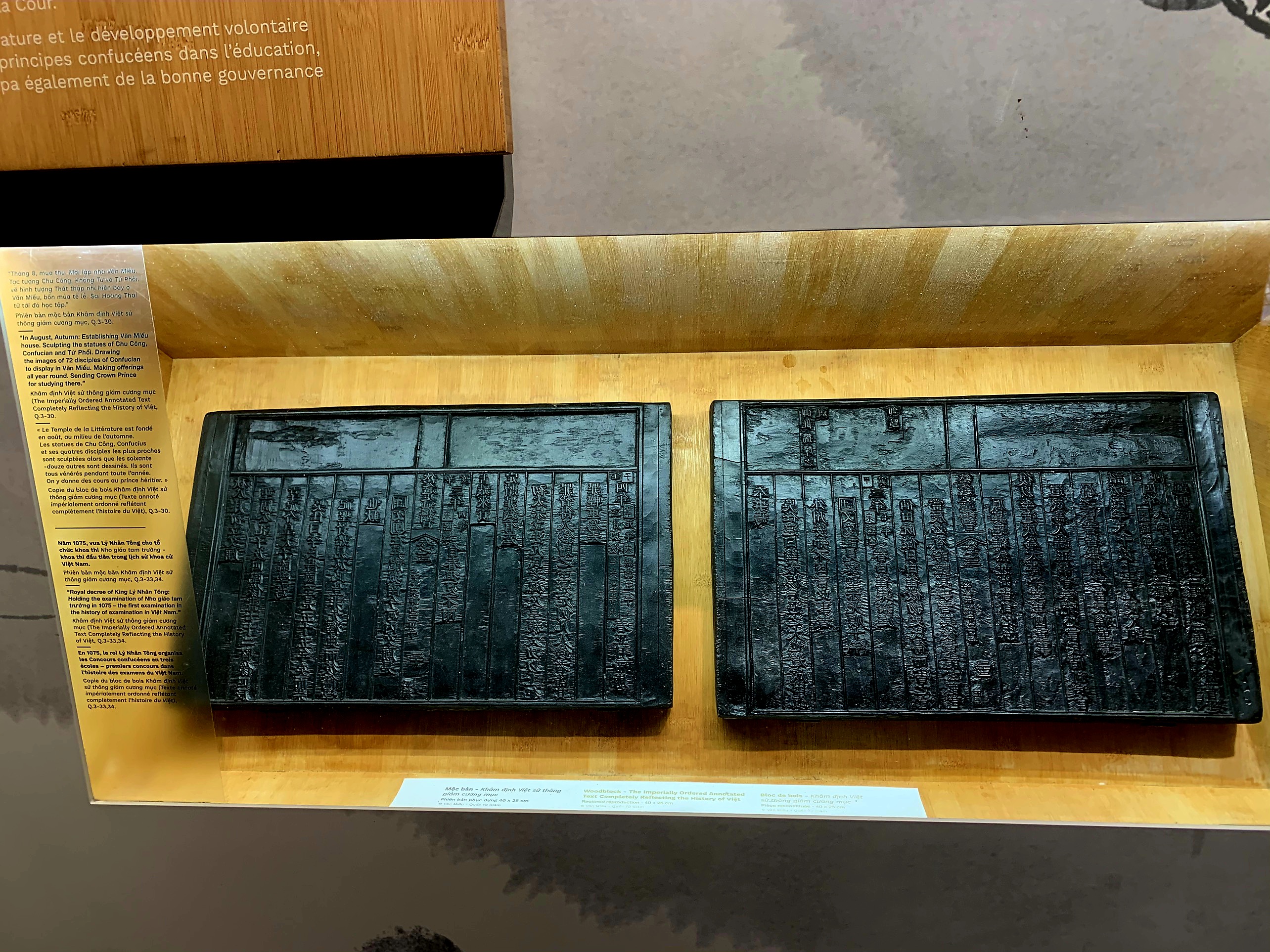
Mộc bản - Hiện vật phục chế tại Trưng bày Quốc Tử Giám – trường Quốc học đầu tiên
Sau người làng Liễu Tràng gần bên cũng sang học, hai làng trở thành làng mở đầu nghề in nước ta, phát triển thịnh đạt. Tương truyền, vùa Lê Thánh Tông nhiều lần ban chiếu cho thợ Hồng - Liễu lên kinh thành để khắc mộc bản và in sách cho triều đình. Thời Hồng Đức, sách được in ra hàng loạt. Bởi thế văn thơ thời Hồng Đức rất phát triển, phổ biến trong đời sống. Nhiều pho sử, sách quan trọng của triều đình được phường Hồng - Liễu đảm nhiệm. Năm 1697, niên hiệu Chính Hòa thứ 18 đời Lê Hy Tông, thợ Hồng - Liễu đã khắc mộc bản và in bộ sách quan trọng bậc nhất của nước ta là cuốn Đại Việt sử ký toàn thư. Từ đó nghề in của hai làng càng nổi tiếng khắp nước, trong “Hải Dương phong vật khúc” có câu ca rằng:
“Phường Hồng Lục, Liễu Tràng khắc chữ.
Bản bộ kinh, bộ sử rành rành,
Văn phòng nấu sử sôi kinh.
Sẵn pho thư tịch, khoa danh nên tài…”
Trường Quốc Tử Giám xưa kia cũng là nơi được triều đình cho phép in sách dùng cho các học quan, giáo thụ và học trò học tập và nghiên cứu. Sách Đại Việt sử ký toàn thư có chép: năm 1467 vua Lê Thánh Tông “ban cấp bản in sách Ngũ kinh của nhà nước cho Quốc Tử Giám”. Năm 1483, vua Lê Thánh Tông khi cho mở rộng nhà Thái Học, dựng Minh Luân đường, Giảng đường, ông cũng cho xây dựng kho Bí thư để in sách học cho học trò. Lê Quý Đôn trong Kiến văn tiểu lục đã mô tả kho Bí thư của Quốc Tử Giám có 4 gian dùng để cất ván in sách.
Năm 1734, triều đình kiểm soát kĩ hơn cả nội dung của sách học, giao cho các quan Quốc Tử Giám “hiệu đính kiểm duyệt năm Kinh theo bản khắc văn của Trung Quốc, rồi khắc thành sách; nay sách đã in xong ban bố cho trong nước, để theo đấy mà dạy học trò, cấm mua sách của Trung Quốc” .
Như vậy, thấy rõ, từ khi nghề in ấn của hai làng Hồng Lục và Liễu Tràng phát triển, thì vai trò xuất bản sách của triều đình nước ta càng rõ ràng hơn, việc sản xuất sách ở trong nước đã dễ dàng hơn trước kia rất nhiều. Đó là công lao to lớn của thám hoa Lương Như Hộc khi ông dày công học tập và truyền nghề cho dân làng, góp phần phát triển việc in ấn, giúp ích cho việc học tập và mở mang kiến thức cho nhân dân cả nước.
Sau khi Thám hoa Lương Như Hộc mất, dân hai làng Hồng Lục và Liễu Tràng nhớ ơn ông, lập đền thờ, tôn làm Tổ Sư. Triều đình cũng ban Sắc chỉ phong ông làm Phúc thần. Ngày nay, tại phường Tân Hưng, thành phố Hải Dương, tỉnh Hải Dương có một ngôi đình lớn, cổ kính, thờ Thành hoàng Lương Như Hộc. Trong đình lưu giữ nhiều hoành phi, câu đối ca ngợi công lao của ông, và nhiều sắc phong của các triều đại tôn vinh ông là Tổ sư nghề khắc ván in sách.
AV
TÀI LIỆU THAM KHẢO:
1. Đại Việt sử ký toàn thư, Ngô Sĩ Liên, dịch giả Viện KHXH Việt Nam, NXB KHXH HN, 1993;
2. Khâm định Việt sử Thông giám Cương mục, Quốc sử quán triều Nguyễn, dịch giả Viện sử học, NXB Giáo dục – Hà Nội, 1998;
3. Kiến văn tiểu lục, Lê Qius Đôn
4. Văn Miếu – Quốc Tử Giám Thăng Long Hà Nội, Nguyễn Quang Lộc, Phạm Thị Thúy Hằng, Trung tâm hoạt động VHKH Văn Miếu - Quốc Tử Giám, 2000.
LÝ THÁNH TÔNG – THE ENLIGHTENED KING OF FOUNDING CONFUCIAN EDUCATION IN VIETNAM
Lý Thánh Tông (1023 - 1072), born in Châu Cổ Pháp, now located in Đinh Bảng commune, Tiên Sơn district, Bắc Ninh province. His birth name was Nhât Tôn, the eldest son of King Lý Thái Tông. In 1028, he was appointed as the Crown Prince. After the passing of King Lý Thái Tông, he ascended to the throne and ruled for 17 years (1054 - 1072).
Lý Thánh Tông was an enlightened king with a spirit of independence and strength, harboring aspirations to build a powerful nation. In addition to implementing humane and people-centered political policies, Lý Thánh Tông made significant contributions to the Confucian education system in Vietnam. The establishment of Văn Miếu in 1070 is a notable event, as recorded in the historical book. He was a wise and compassionate king, genuinely caring for the people, valuing agriculture, helping those in need, comforting those afar, and honoring education. He established clear policies, swiftly executed legal matters internally, maintained peace with Chiêm to the south, and confronted the Song to the north, displaying authority and strength externally. He is remembered as one of the benevolent kings in our history.
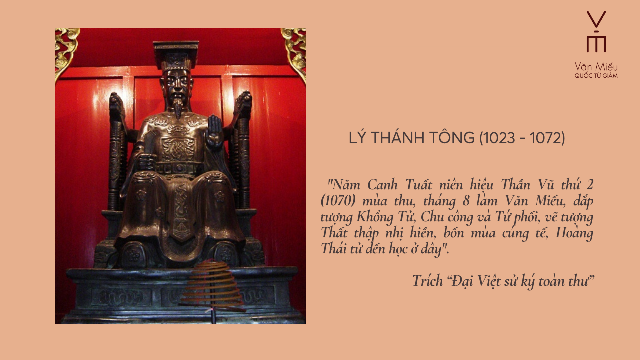
An Nhiên
TL: LH
PHAN KÍNH - THE DIPLOMATIC TALENT IN THE 18TH CENTURY
Phan Kinh (1715 - 1761) was born in Vĩnh Gia village, Lai Thạch commune, La Sơn district (now Kim Song Trường commune, Can Lộc district, Hà Tĩnh province). At the age of 29, he passed theroyal examination and obtained the highest degree, becoming the first-ranked scholar in the examination in 1743 during the reign of Emperor Lê Hiến Tông. In that examination, which had over 2000 participants, only 7 were selected for the Palace examination, and Phan Kính was among them, not requiring the preliminary round and interview.
After passing the examination, he was appointed to various positions by the imperial court, working at the Academy and serving as an examiner for the provincial examination in Kinh Bắc. During the unrest in Sơn Tây caused by the uprising of Quận Hẻo Nguyễn Danh Phương, he was appointed as the Deputy Commander to pacify Sơn Tây. He successfully implemented a stabilizing policy, gradually convincing some of the leaders, while also persuading the court to reduce taxes for the people. Thanks to these efforts, Sơn Tây became more stable.
In 1759, he was appointed by Lord Trịnh Sâm as the Regional Governor of Tuyên Quang. In this border region, he held several meetings with Qing officials at Khai Hóa Prefecture in Yunnan Province to discuss rebuilding boundary markers, establishing control posts at border gates, and jointly leading forces to eliminate bandits, ensuring peace along the border. He passed away in 1761.
His name is engraved on the stele of the Quý Hợi examination in the fourth year of the Cảnh Hưng era (1743) at Văn Miếu – Quốc Tử Giám.
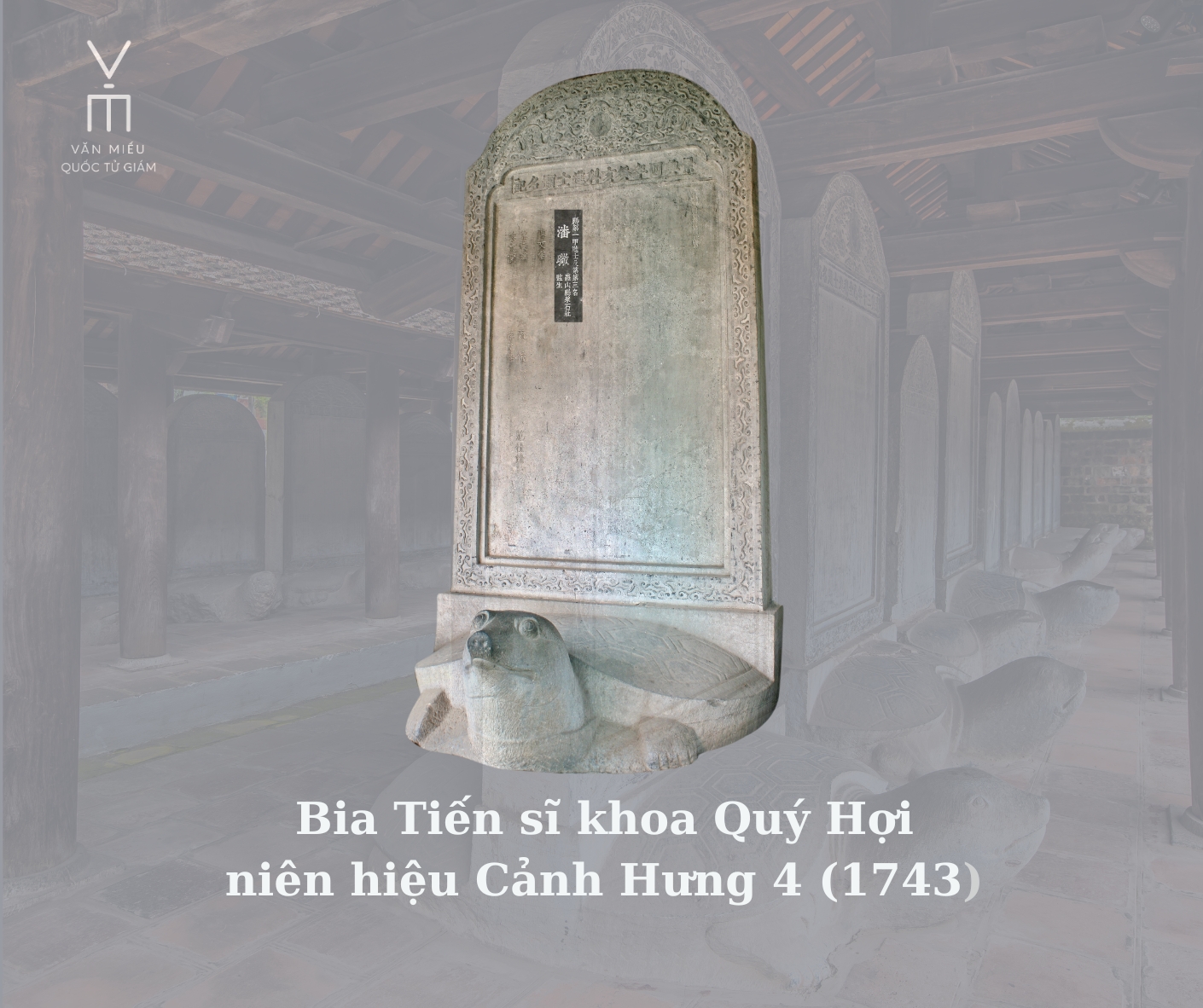
LH
"WHAT YOU DO NOT WANT DONE TO YOURSELF, DO NOT DO TO OTHERS”
This famous saying by Confucius implies that one should not impose upon others what one would not want for oneself.
According to Master Đinh Thị Nguyệt (National Academy of Public Administration) in the article "The basic ethical standards of Confucianism with the moral cultivation of officials and civil servants in Vietnam today" published on October 16, 2019: "Humanity is the first and most fundamental ethical standard in Confucian ethics. All other ethical standards revolve around this central standard. From the virtue of Humanity, other virtues are born, and these virtues gather around Humanity, which is the manifestation of Humanity. According to Confucius, Humanity is the principle of being human, regulating human nature and the relationship between people in social life. Accordingly, Humanity is viewed from two aspects: towards oneself and towards others. Towards oneself, one must be pure, not think or do evil, must uphold proper etiquette, must "cultivate oneself" according to the standards of humanity, propriety, righteousness, wisdom, trustworthiness, thus "cultivating one's family, governing the country, and bringing peace to the world." Towards others, one must show love, without distinguishing between social classes or positions; if one wants to succeed, one should help others succeed; if there is something one does not want, one should not impose it on others. It can be said that Humanity is the ethical standard governing all activities and character of human beings. Therefore, people need to cultivate themselves to attain Humanity in their relationships with themselves and with others."
Reference: "Four Books", National Political Publishing House.
An Nhiên
TL: LH
THE VIETNAMESE DOCTORAL LAUREATE ESTABLISHED THE SCHOLARSHIP FUND TO HELP THE POOR STUDENTS HAVING FONDNESS OF STUDY
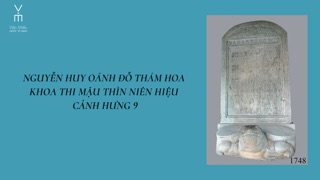
Nguyễn Huy Oánh (1713 – 1789) a native of Hà Tĩnh province passing exam in 1748 with “Thám hoa” rank.
He was appointed as a high ranking mandarin to take important responsibilities. When he was living in hometown, he concentrated on the training to educated the students. Nguyễn Huy oánh had a plenty of contributions with his knowledge and his lifelong passion. There were around 30 doctors among students from near and far educated by Nguyễn Huy Oánh.
Nguyễn Huy Oánh self-established the scholarship fund, helped excellent students those who have no condition for study as well as examinations.He also opened the big Phúc Giang library filled with several hundred textbooks to serve training and study.
An Nhiên
THE TAOIST MONK PASSED THE ROYAL EXAM - LÊ ÍCH MỘC
Lê Ích Mộc (1458-1538), a resident of Thanh Lãng village, Thủy Đường district, Kinh Môn province, now part of Quảng Thanh commune, Thủy Nguyên district, Hải Phòng. He passed the royal examination in 1502 and was entitled Trạng nguyên (1st-grade laureate), and his name was recorded on the doctoral stele at Văn Miếu – Quốc Tử Giám in Hanoi. He is regarded as the Trạng nguyên (1st-grade laureate) of the "Three religions": Confucianism, Taoism, and Buddhism.
From a young age, Lê Ích Mộc was an intelligent and diligent child, loved by his community for his thirst for knowledge and obedience. After assisting his parents, he often went to Ráng pagoda to listen to the monks' teachings and borrow books for self-study. Impressed by his enthusiasm and devotion to learning, the monks accepted him as their disciple and taught him various scriptures.
It is said that Lê Ích Mộc used to write characters in the sand on a flat surface, using his finger to read and memorize them before erasing them. This was a method of "immersing oneself" in learning to improve memory and understanding. With his remarkable scholarship, the senior monks at Ráng pagoda dedicated themselves to teaching Lê Ích Mộc, and in about five years, he had a deep understanding of the Four Books, Five Classics, and Buddhist doctrine.
According to Đại Việt sử ký toàn thư (Complete Annals of Đại Việt), during the royal examination, the king asked a question about ruling the world, but when Lê Ích Mộc took the examination, the king inquired about Buddhism. Given Lê Ích Mộc's early education in the pagoda and his profound knowledge of Buddhist doctrine, he excelled in the exam. His essay was so outstanding that it filled 25 pages, even though the original question required only nine characters in the response. As the results, Lê Ích Mộc was among the top scholars
To this day, Lê Ích Mộc's essay responding to Buddhism is considered a valuable historical and religious document, shedding light on the history of thought and Buddhism in Vietnam. His achievements and mastery of multiple doctrines led to him being hailed as a the Trạng nguyên (1st-grade laureate) of the "Three religions": Confucianism, Taoism, and Buddhism.
After passing the examination, Lê Ích Mộc held official positions, but the complexities of bureaucracy led him to resign and return to his hometown. He renovated the Ráng pagoda, which he renamed Diên Phúc pagoda, and became a renowned educator in the region, contributing to the development of talents in his homeland. In 1538, Lê Ích Mộc passed away, and the local residents established a temple in his memory.
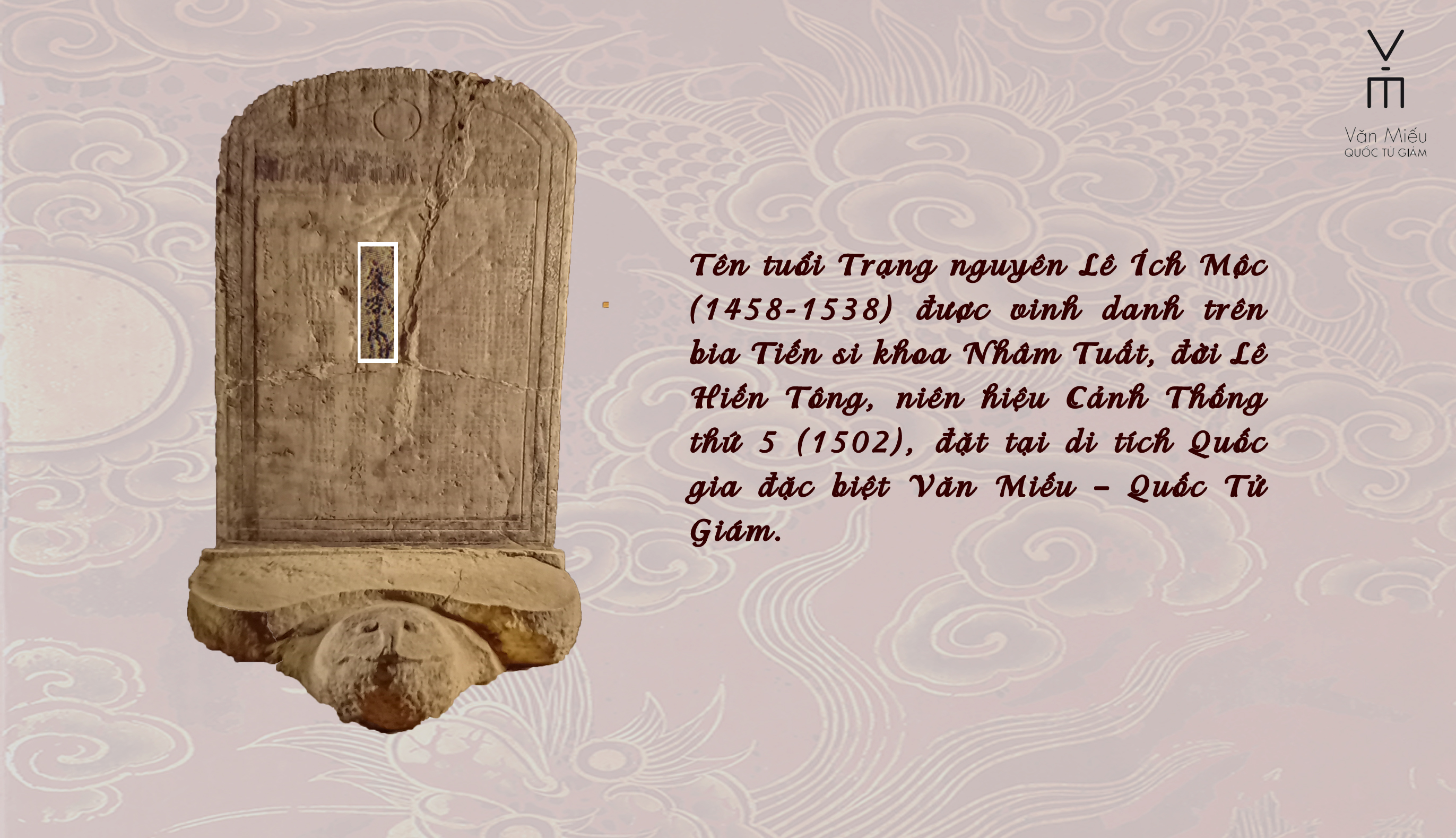
AV
TL: LH
LÊ TUNG - AN EDUCATOR AND STATESMAN OF THE LÊ DYNASTY
Lê Tung (1452 – 1514), whose real name was Dương Bang Bản, hailed from Chảy Hamlet, Liêm Thuận Commune, Thanh Liem District, Hà Nam Province. At the age of 33, he passed the royal examination and obtained the second-level doctoral degree (Hoàng giáp) in the year of Giáp Thìn, during the reign of Lê Thánh Tông in the 15th year of the Hồng Đức era (1484). After gaining favor from the king, he was given a new name and surname, becoming Lê Tung.
In 1493, Lê Tung was sent as an envoy to the Ming Dynasty, successfully fulfilling the assigned royal mission. In the second year of Hồng Thuận (1510), he was promoted to the position of Minister of the Interior. In the fourth year of Hồng Thuận (1512), he was granted the title of Thiếu bảo, retaining his position as the director of the Quốc Tử Giám (the first national University), Minister of Rites. This demonstrates the high esteem in which the court held Lê Tung's talents and virtues, due to his significant contributions to the country.
Lê Tung was a historian and the author of the book "Việt giám thông khảo tổng luận," a crucial historical work in the comprehensive "Đại Việt sử ký toàn thư" collection, engraved in the Chính Hòa 18 year (1697).

The "Đại Việt sử ký toàn thư" states: "In the sixth year of Hồng Thuận, 1514, in the ninth month, King Lê Tương Dực commanded Lê Tung to compose “Đại Việt thông giám tổng luận”. King Lê Tương Dực wanted to summarize the important points of that history book and instructed Lê Tung to create a General Synopsis for ease of reading.
Beyond his contributions to politics and historiography, Lê Tung was also an educator and cultural figure who dedicated himself to his era. He held the position of Minister of Rite concurrently with being director of the Quốc Tử Giám (the first national University) and played a role in training and selecting talents for the nation. His ideas about education and selecting virtuous talents were clearly expressed in the inscription of the doctoral stele for the doctoral examination in the third year of Hồng Thuận (1511), composed by him and erected in March 1513.
In this inscription, he advised and reminded scholars who succeeded in the examination and had their names inscribed on stone tablets to constantly improve themselves and uphold the dignity of the court, as well as the reputation of virtuous individuals: " The Confucian scholars whose names are now seen on this stone stele are very lucky indeed. If they try to perfect their morality in order always to remain loyal, upright, honest and industrious, and worthy of the title they won as Royal exam laureates and highly-valued noblemen, future generations of students of the Thái Học House will point to their names and praise their capabilities and achievements. Good people will draw inspiration from them too. But if any of these laureates turn out to be “stones” rather than “gems”, “hawks” rather than “phoenixes”, are cowardly or seek only their own personal advantage, people will sneer at them and may even make comments such as: “This man has an evil educational background like Công Tôn Hoằng”, or “This man acts at variance with the teachings of the Classics like Vương An Thạch”. This stone stele thus contains both praise of and a warning to Confucian-educated men.
His doctoral inscription exemplified his desire to cultivate and select individuals of true talent, who would contribute their intellect and dedication to the nation, becoming pillars of the country.
Lê Tung served under five reigns. Despite the tumultuous period of the country, he remained faithful to Confucian ideals, maintained his intellectual pursuits, and made valuable contributions to the nation. He truly deserves recognition as an exemplary political figure and educator of the Early Lê Dynasty
LH
Hiền tài là nguyên khí của quốc gia. Nguyên khí thịnh thì thế nước mạnh mà hưng thịnh. Nguyên khí suy thì thế nước yếu mà thấp hèn. Vì thế các bậc đế vương thánh minh không đời nào không coi việc giáo dục nhân tài, kén chọn kẻ sĩ, vun trồng nguyên khí quốc gia làm công việc cần kíp.*
*Trích Bia đề danh Tiến sĩ khoa thi Nhâm Tuất niên hiệu Đại Bảo 3 (1442)
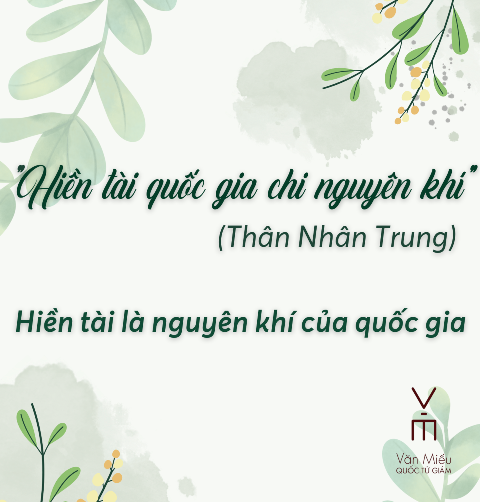
An Nhiên
MENCIUS’ MOTHER MOVED HOUSES THREE TIMES TO TEACH HER CHILD TO BECOME A VIRTUOUS PERSON
Mencius (372 – 289 BC), also known by his birth name Meng Ke, was born in the State of Zou. Mencius's father Meng Ji died when Mencius was very young. His mother Zhăng, or Meng Mu, raised her son alone.
Mencius's mother moves three times. This saying refers to the legend that Mencius's mother moved houses three times before finding a location that she felt was suitable for the child's upbringing.
At first they lived by a cemetery, where the mother found her son imitating the paid mourners in the funeral processions. Therefore, the mother decided to move. The next house was near a market in the town. There the boy began to imitate the cries of merchants (merchants were despised in early China). The third place they settled at was close to several schools. At that time, Mạnh Tử was around 6 or 7 years old. Seeing other students going to school, he also asked his mother to let him attend school. Bà Mạnh Mẫu was delighted and said, "This is the right place for you to stay!"
From that point on, their living situation stabilized. However, when Mencius was young, he was often truant from school. His mother responded to his apparent disregard for his education by taking a pair of scissors and cutting up the cloth she had been weaving in front of him. He was frightened and asked her, "Why did you cut the woven fabric, mother"? She replied, "Your education is the foundation for becoming a great person. If you abandon your studies and return home now, it's like the woven fabric that has been cut in half – you’re giving up on something important!" Upon hearing this, he bowed his head in remorse and apologized to his mother. This was intended to illustrate that one cannot stop a task part way through, and her example inspired Mencius to be diligent in his studies.
From that moment on, he devoted himself to studying diligently. As a result, he became a great and virtuous Confucian scholar, and has often been described as the "second Sage".
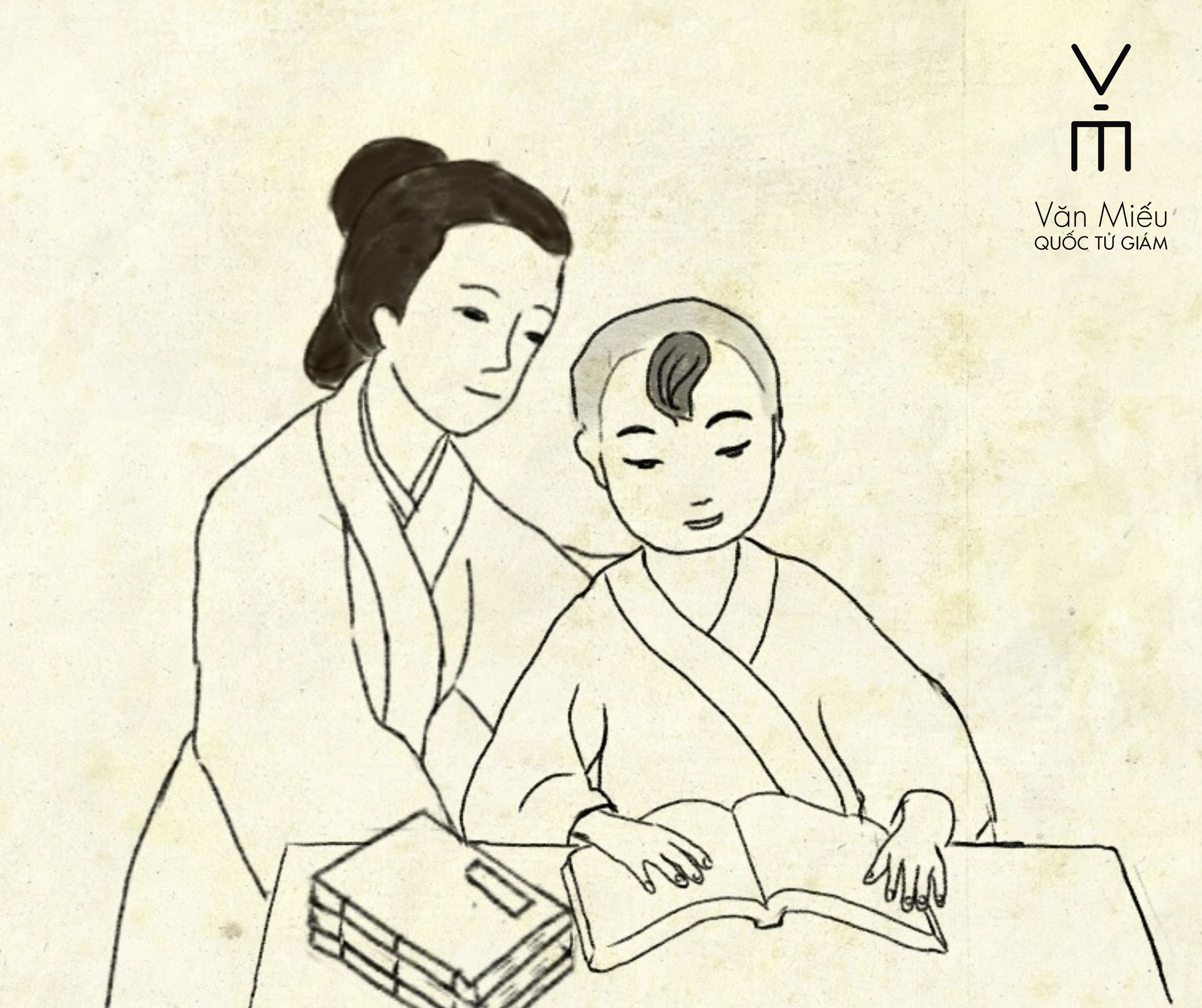
LH
CONFUCIUS’ SAYING
Confucius (479-551 BCE), whose given name was Kong, and whose courtesy name was Zhong Ni, was a famous thinker, philosopher, and educator in ancient times. He hailed from the Lu district of Shandong Province, China. Confucius was the compiler of the Five Classics (Book of Odes, Book of History, Book of Rites, Book of music, Book of Change and Book of Spring and Autumn). For nearly 30 years, he traveled around to spread his ideas and to teach others. His works have become classics of Confucianism, continuing to be propagated and passed down to this day. The main content of his philosophy revolves around the concept of "Ren" (benevolence), which is reflected in his words and responses, primarily recorded in the Analects, one of the Four Books.
The main spirit of his philosophy laid on the Ren (humanity or goodness or benevolence, filialness) is represented through his statements
According to the Analects, Confucius once said, "Do not do unto others what you do not want done to yourself." This means that if there is something you don't want done to you, then you should not do it to others.
This principle applies to interpersonal relationships. It is not right to do to others what you do not wish for yourself. If you want others to treat you in a certain way, then you must treat them accordingly. Everyone desires what is good for themselves, so let us do the same for others, and they will reciprocate. Only by behaving well towards one another can we create a harmonious environment where everyone receives the treatment they desire.
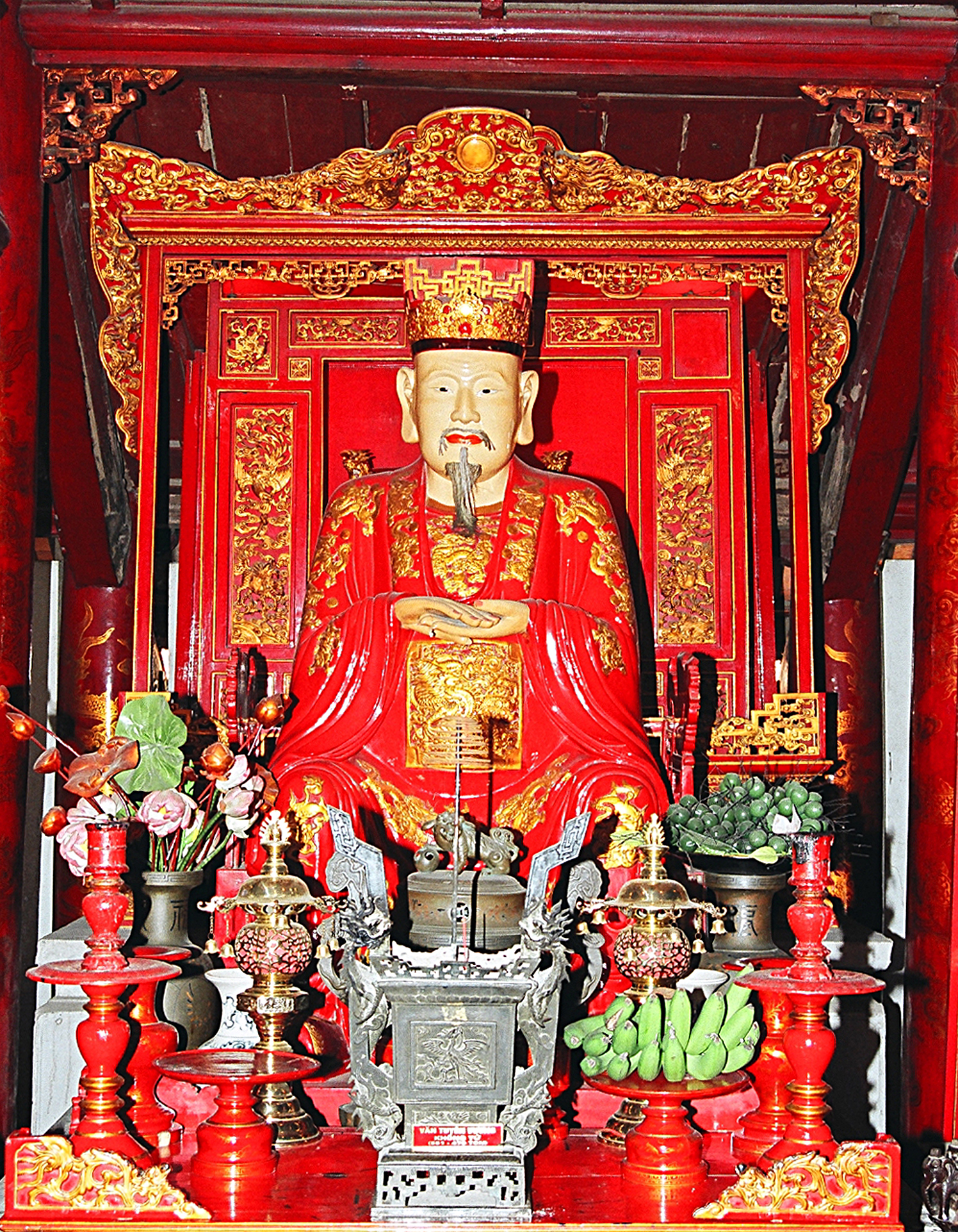
LH
AUTHOR OF THREE TEXTS ON STELES AT VĂN MIẾU - QUỐC TỬ GIÁM
Nguyễn Đăng Minh (1623 - 1696) was born in Hoài Bão village, Tiên Du district, Kinh Bắc province (now located in Hoài Thượng village, Liên Bão commune, Tiên Du district, Bắc Ninh province). He was the younger brother of Doctor Nguyễn Đăng Cảo and the father of Doctor Nguyễn Đăng Tuân and Nguyễn Đăng Đạo.
When he was a young boy, Nguyễn Đăng Minh was intelligent and fond of learning. At the age of 16, he passed the Hương (Regional) examination. In the year Bính Tuất (1646), he and his brother Nguyễn Đăng Cảo traveled to the capital, Thăng Long, to participate in the National Examination. During this examination, the court selected 17 outstanding individuals, and both brothers were among those chosen. The next day, during the Royal Examination, the emperor determined the rankings and awarded Nguyễn Đăng Cảo the title of First-Class Doctoral Laureate, Nguyễn Viết Cử the title of Second-Class Doctoral Laureate, and 15 others the title of Third-Class Doctoral Laureates, including Nguyễn Đăng Minh. After the examination, he and his brother returned to their homeland to pay respects to their ancestors.
After passing the examination, for nearly 10 years (1646 - 1653), Nguyễn Đăng Minh worked as an Academician compiling historical works. He was also one of the talented and virtuous individuals trusted by the court of the Lê Trung Hưng dynasty to be the principal of Quốc Tử Giám (The first national university).
Among the 82 steles inscribed with the names of Doctors at Văn Miếu – Quốc Tử Giám, there are three texts: one inscribed on the stone stele of the exam in 1607, one inscribed on the stone stele of the exam in 1610, and one inscribed on the stone stele of the exam in 1613. All three texts were composed by Doctor Nguyễn Đăng Minh. In these texts, Nguyễn Đăng Minh highlighted the role of virtuous talents for the nation: "A system of governance will surely give birth to talented individuals, and those talented individuals are sufficient to ensure the longevity and sustainability of the system. However, talented individuals must emerge through the examination system." And "Conducting examinations to select scholars is meant to showcase the glory of the present time; inscribing names on steles in the Quốc Tử Giám is intended to achieve lasting notoriety for future generations."
When he was the principal of Quốc Tử Giám, Nguyễn Đăng Minh lived a simple and honest life, avoiding any disturbances with the people. He was also a role model by his knowledge, virtue, compassion for the people, and patriotism, serving as an example for present-day generations.
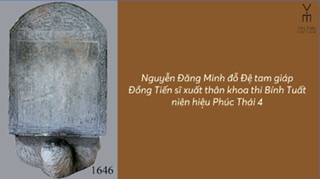
TL: LH
https://youtu.be/GJCUvleRIGc
QUOTATIONS ABOUT LEARNING BY CONFUCIUS
Confucius, whose Chinese name was Qiuo or Zhong Ni, was born in Zouyi, Qufu district of Lu state, now a part of Shandong province, China.
Confucius was clever, kind and fond of studying. He became well known for his learning at the age of 30, and attracted disciples from near and far.
As a teacher, he made every effort to teach and guide his students. One of the important things he mentioned about learning was: "To learn and practice constantly all what you have learned, is that not pleasant?"
Learning is a process of cultivation. For the knowledge one has acquired, they must strictly adhere to it and regularly review it in order to continually discover new things, consolidate and enhance their understanding and knowledge. Each review is an opportunity for new knowledge and a higher level of proficiency.
Initially, learning is about understanding the object of study, while reviewing or practicing is about reinforcing what has been learned and applying it to life, strengthening knowledge to become a talented and virtuous individual in society. Therefore, learning itself brings joy.
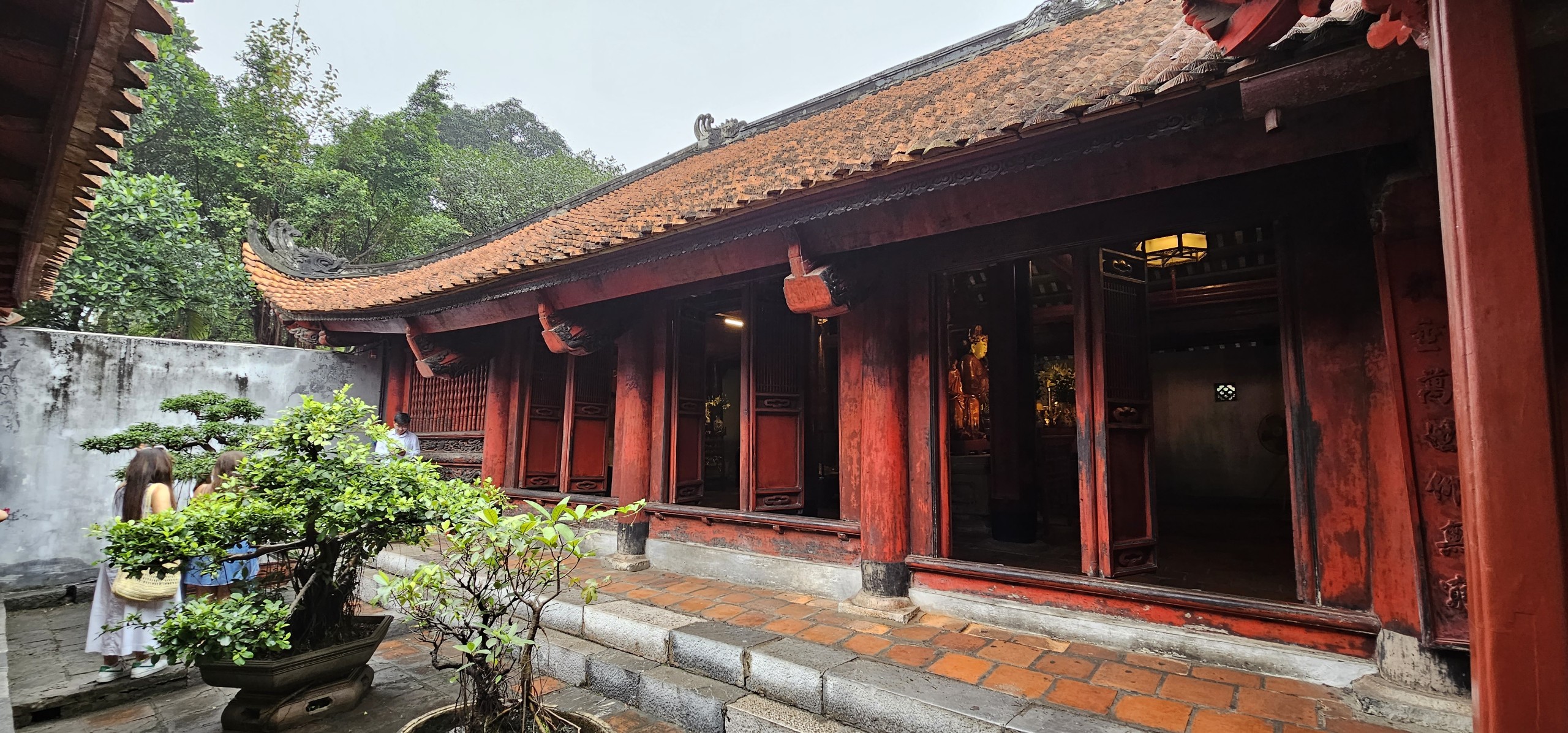
LH
PFD.NGUYỄN NHƯ ĐỔ - PRINCIPAL OF QUỐC TỬ GIÁM
Nguyễn Như Đổ (1424-1525) was from Đại Lan commune, Thanh Đàm district, Sơn Nam town (now Đại Lan village, Duyên Hà commune, Thanh Trì district, Hà Nội). Nguyễn Như Đổ passed the Royal Exam in 1442 under the reign of King Lê Thái Tông when he was only 19 years old.
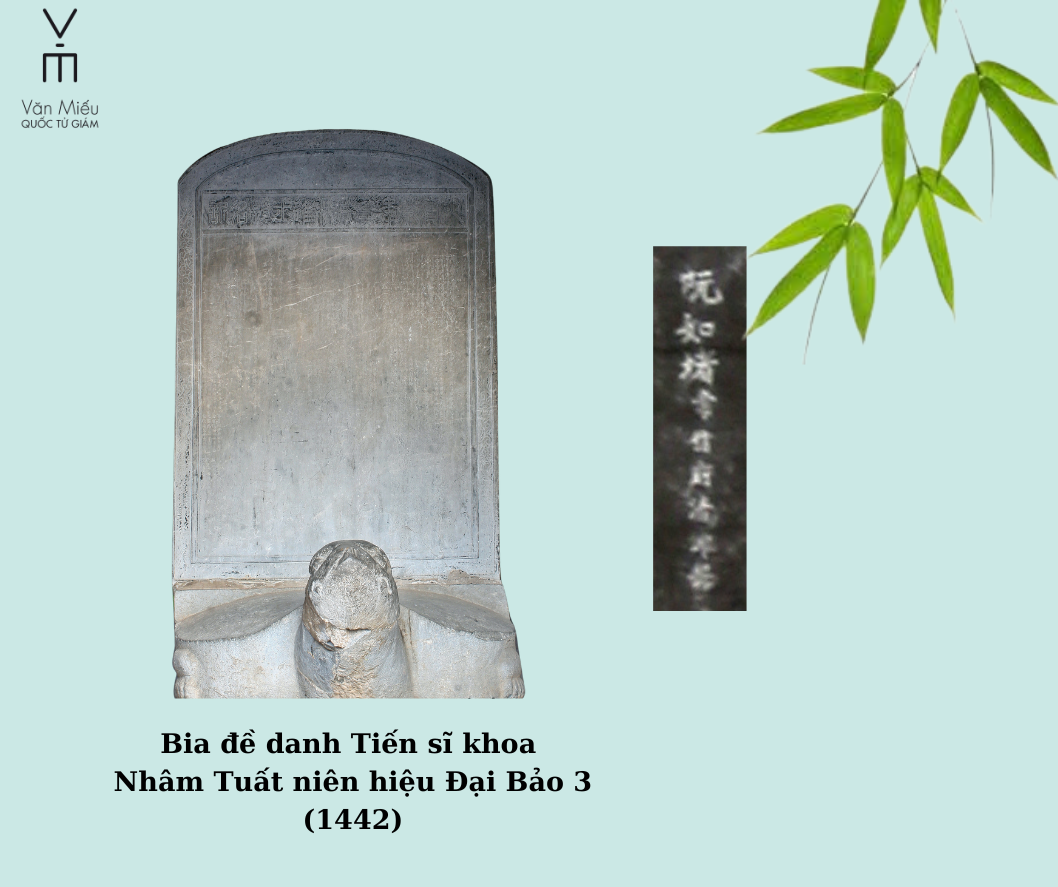
After passing the exam, he was appointed as an official in the Academy. In 1443 he was appointed as a deputy ambassador to the Ming Dynasty. When he came back, he was further promoted to Chairman of Quy Hoá Province. In 1449, he again was promoted and worked in the Academy. After that, he went to the Ming Dynasty as ambassador. All three times when he was appointed as an ambassador, he successfully completed the task, and was highly praised by King Lê. Nguyễn Như Đổ served as a mandarin during the first 8 dynasties of the Le dynasties. He was an upright and honest Mandarin.
Nguyễn Như Đổ was not only an excellent politician and diplomat, but he was also an educator. He had made many contributions to the education and training for the talented people of the country. With his extensive knowledge, he was assigned important tasks in many examinations to select Doctoral candidates. In 1486, he was appointed as the headmaster of Quốc Tử Giám. He was in charge of managing and operating the country's largest national school. He held this position for more than 10 years and then retired.
His name is engraved on the stone stele at Văn Miếu – Quốc Tử Giám. To remember his merits, as well as to promote the talent of Thăng Long – Hà Nội, in 1994, a street in Hanoi, right next to the special national landmark of Văn Miếu – Quốc Tử Giám, was named after him
LH
DFP BÙI SĨ TIÊM - AUTHOR OF 5 TEXTS CARVED ON DOCTOR’S STELES AT VĂN MIẾU – QUỐC TỬ GIÁM
Bùi Sĩ Tiêm (1690-?) is from Kinh Lũ village, Đông Quan district, now in Đông Hưng district, Thái Bình province. He passed the Huong exam (regional exam) when he was 18 years old and studied at Quốc Tử Giám, the first national university. In the monthly commentaries of literature organized in Quốc Tử Giám, he was always ranked first. At the age of 26, he passed Đình exam (Royal exam) in 1715. He got the first rank. He worked as a high ranking official in the court.
Bùi Sĩ Tiêm is an upright mandarin. He opened a private school. A number of students followed to learn, and respected their teacher's profound knowledge and upright personality. Bùi Sĩ Tiêm was good at literature, had a loyal heart, and is respected by people. People said that his literature was better than anyone else's.
In 1717 he was commissioned by the court to compose five texts engraved on five Doctor’s stelea located at Văn Miếu – Quốc Tử Giám. These are the exam held in 1656, 1670, 1685, the exam in 1700, and the exam in 1715.
Through five texts engraved on five Doctor’s stelea he showed the point of education and training of the nation's talents. The text engraved on five Doctor’s stelea in 1700, he wrote: “Virtuous and talented men are the primodial energy of a nation’s vitality; if the nation has many talents, it will thrive and flourish”. The text engraved on five Doctor’s stelea in 1670, he pointed out the role and importance of talents for national prosperity at all times: “A house will be constructed successfully if there is sufficent precious wood for the task. Likewise, State governance must rely on men of virtue and talent; if they are abundant, a peaceful and thriving dynasty will be guaranteed. Thus the saintly Emperors of the past always regarded the identification of talented and virtuous people as an urgent task, employing them inorder to extol the dynasty and contribute to its glory”.
Every sentence and word in the text are his passionate teachings to all the scholars who passed the exam were given the great grace of the court, students and generations must always forge and cultivate the qualities, learning, dedicating talents to the country. The text engraved on five Doctor’s stelea 1656, he wrote: “Nowadays, His Majesty wants their names and achievements to be embedded in stone steles, so that Confucian scholars can treasure education and grasp the signification of talent-seeking exams. When coming to this place of sages, people will immerse themselvesin the enlightenment of our dynasty, look at these stone steles and read the inscriptions. They will try their best to equal good examples and to draw lessons for
The Doctor’s stelea at the Văn Miếu – Quốc Tử Giám is an invaluable cultural heritage, the inscriptions engraved on the stele are documents that reflect the history of education and examinations, the selection of talented people for more than 300 years under the Lê-Mạc dynasty. The texts on stone steles were compiled by highly educated intellectuals and also selected officials by the court, including Bùi Sỹ Tiêm. The five inscriptions engraved on the Doctor's stele compiled by him are the source of historical documents on the education, and training talents and the exams to choose the talented men of the Lê Dynasty that he left us.
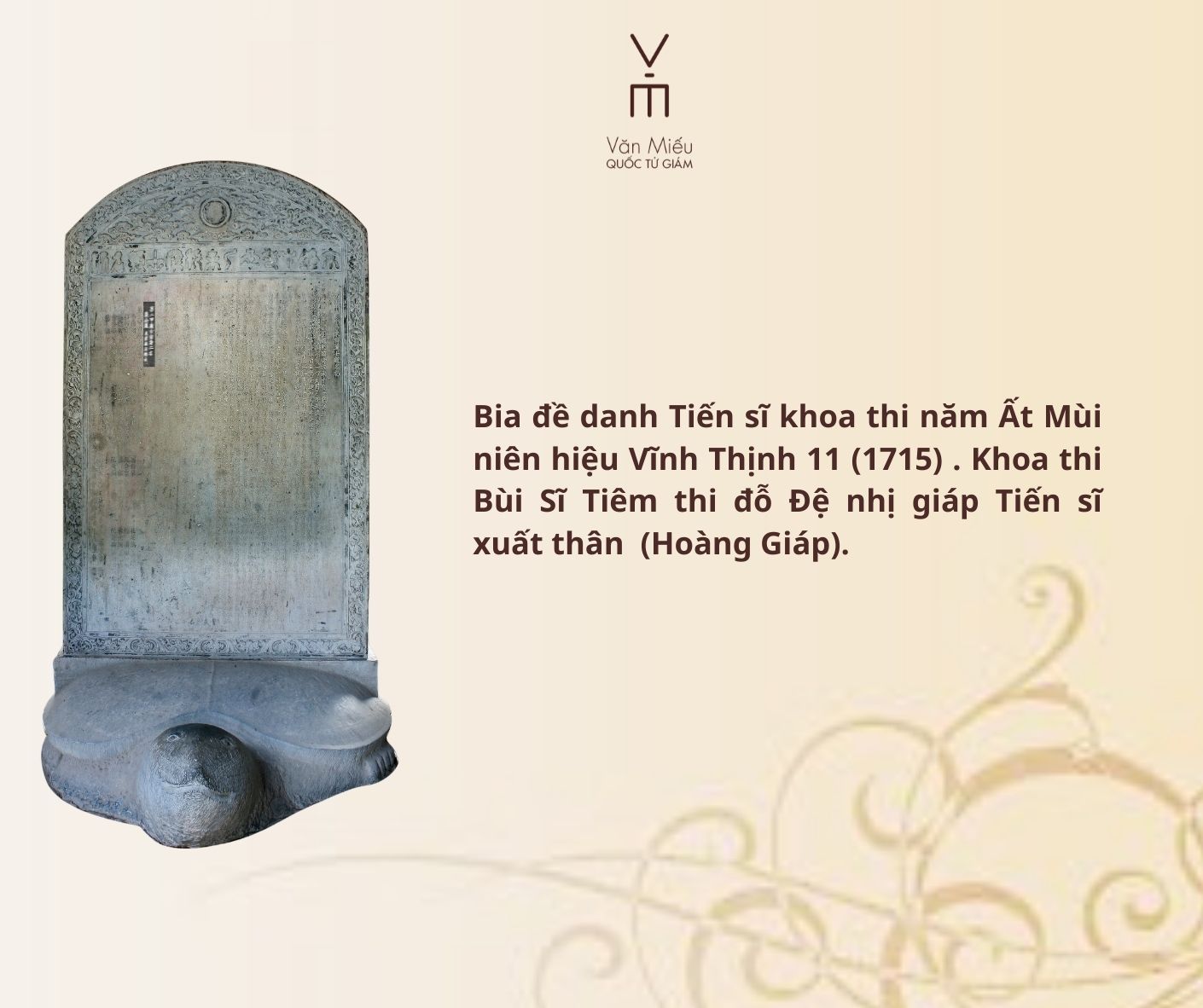
LH
TẢ THANH OAI – THE ACADEMIC VILLAGE
The village, formerly known as Ke To, is located in Ha Noi’s outlying Thanh Tri District.
Ta Thanh Oai Village is famous for its studious and academic tradition. Under the feudal period there were many families, clans, and descendants determined to study and passed Royal exams, with up to 12 people achieving PhDs in the village. These people belonged to the Nguyễn, Ngô Vi, Ngô Thì, Nguyễn Thế clans. And there were also people who passed the Provincial exams.
The first doctor in the village was Mr. Nguyễn Chỉ. He passed the Royal examination in 1453 under the reign of King Lê Nhân Tông. Among the 12 doctors laureates of the village, The Ngo clan had two doctors laureates Ngô Thì Sĩ, father and his son was Ngô Thì Nhậm. Ngô Thì Sĩ was an 18th-century Vietnamese scholar, historian. Ngô Thì Nhậm was a brilliant scholar. He was a writer, a diplomat, and a military official . He was noted for his writings on Vietnamese Buddhism, and was actively involved in attempting to revive the 13th Century Trúc Lâm ("Bamboo Grove") zen sect, the only native Vietnamese school of Buddhism. The revival attempted to harmonize the "Three teachings" of Buddhism, Confucianism and Taoism.
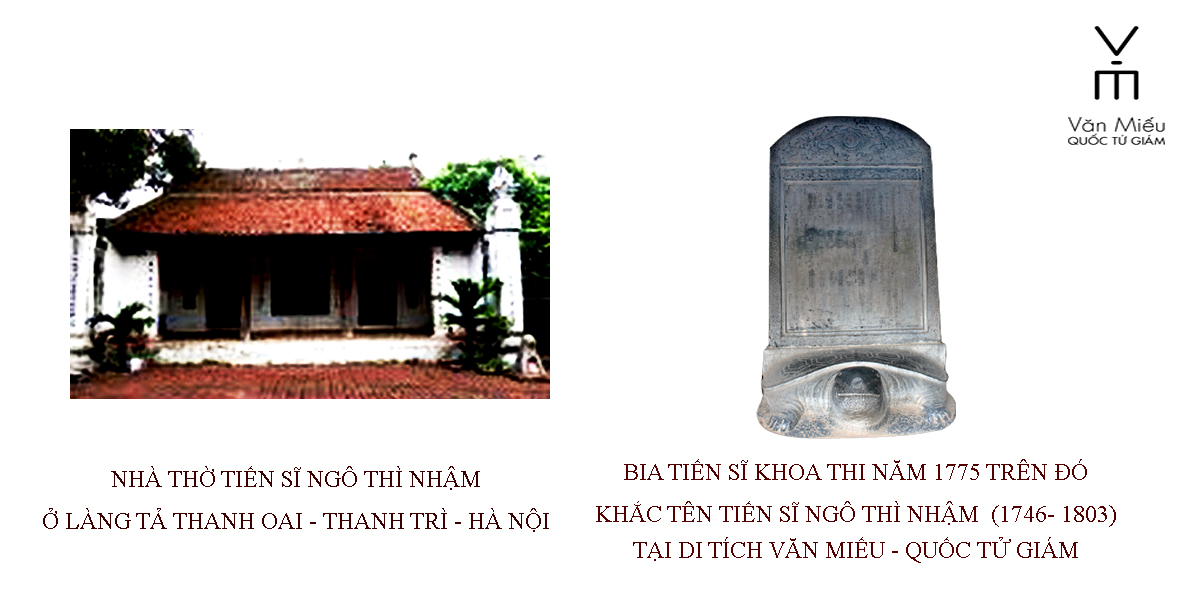
LH
Ph.D LÊ PHÚ THỨ
Lê Phú Thứ (1694 - 1782) was from Diên Hà commune, Diên Hà district (now in Độc Lập commune, Hưng Hà district, Thái Bình province). Later He was renamed Lê Trọng Thứ. He was the father of Ph.D Lê Quý Đôn.
When he was young, he was famous for his intelligence. At the age of 27, he passed Hương exam (Provincial exam). After passing the exam, he was allowed to study at Quốc Tử Giám. He was not only trained in knowledge, but also trained in virtue by the teachers, and later he became a virtuous mandarin. He passed the National and Royal exams in 1724 and got the third class at the age of 31. There were nearly 3,000 participants took part in this exam, but only 18 people were selected. Now the doctor ‘stele of this exam is located at the Special National Landmark Văn Miếu – Quốc Tử Giám.
He was appointed as Minister of Justice. He was a frank and honest official. He submitted petition on pacify the people, reclamation, and organization of military, and he advised Trinh Lord to lay copper pipes to request the people's opinion. In 1778, his hometown suffered a famine, so he used his own money to provide for the people for 2 months. His son - Ph.D. Lê Quý Đôn- also a famous scholar. He made contributions to the country.
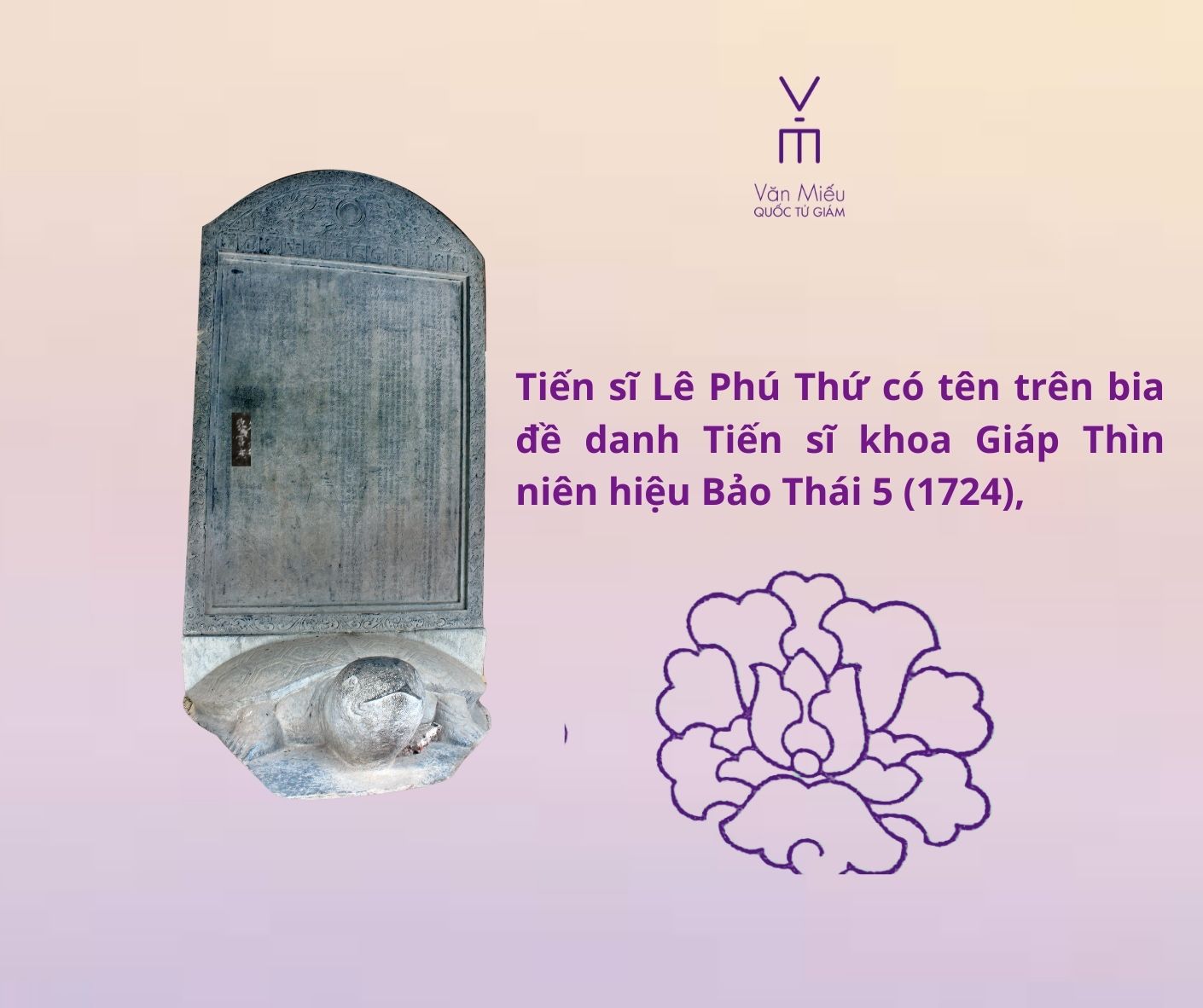
LH
TẾ TỬU QUỐC TỬ GIÁM NGUYỄN CÔNG THÁI
Nguyễn Công Thái (1684 - 1758) người xã Kim Lũ huyện Thanh Trì - Nay thuộc Kim Lũ (làng Lủ), phường Đại Kim, quận Hoàng Mai, Hà Nội. Thuở nhỏ, Nguyễn Công Thái đã nổi tiếng thông minh, ham học. Năm 18 tuổi, ông thi đỗ Giải nguyên khoa thi Hương năm Nhâm Ngọ (1702). Mùa xuân năm 1715, triều đình tổ chức khoa thi Hội, Nguyễn Công Thái đã tham gia kỳ thi và đỗ Đệ tam giáp Đồng Tiến sĩ xuất thân. Sau khi thi đỗ, Nguyễn Công Thái được triều đình cử làm Giám sát Ngự sử đạo Nghệ An, Giám sát Ngự sử đạo Thanh Hoa, Hiến sát sứ của Hiến sát sứ ty Nghệ An, Đông các Hiệu thư, Đông các Học sĩ.
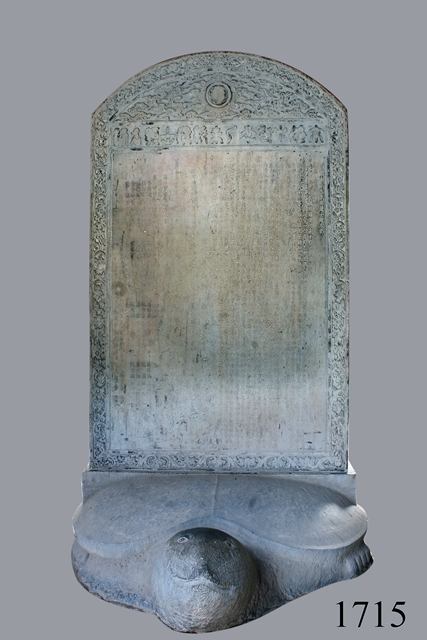
Tên tuổi Tiến sĩ Nguyễn Công Thái được vinh danh trên bia Tiến sĩ khoa Ất Mùi (1715) được lưu giữ tại di tích Văn Miếu-Quốc Tử Giám
Năm 1730, ông đỗ hạng ba trong kỳ thi Đông các. Đông các là kì thi có từ năm 1659, chỉ dành cho những vị quan có hàm từ Tứ phẩm trở xuống, thi viết thơ, ký, luận… Vì đỗ hạng ba nên Nguyễn Công Thái được phong làm Đông các Hiệu thư kiêm Phó Đô Ngự sử, đồng thời được ban tước Kim Lĩnh bá. Năm 1733, Nguyễn Công Thái được thăng chức làm Công bộ Tả Thị lang. Năm 1744, ông được bổ nhiệm làm Tham tụng, Thượng thư Bộ Hộ kiêm Đông các Hiệu thư, hàm Thiếu bảo. Bốn năm sau (1748), ông chuyển sang làm Thượng thư Bộ Lễ - người đứng đầu của bộ giữ việc lễ nghi, tế tự, khánh tiết, yến tiệc, trường học, thi cử, áo mũ, ấn tín, phù hiệu, chương tấu, biểu văn, sứ thần cống nạp, các quan chầu mừng, tư thiên giám, thuốc thang, tăng lục, đạo lục, giáo phường, đồng văn nhã nhạc.
Đặc biệt, từ năm 1728, Nguyễn Công Thái còn được triều đình giao giữ chức Tế tửu Quốc Tử Giám. Mặc dù thời gian đảm nhiệm chức vụ Tế tửu Quốc Tử Giám không dài, nhưng với kiến thức và trách nhiệm của mình, ông đã góp phần không nhỏ vào việc củng cố và phát triển Văn Miếu - Quốc Tử Giám cũng như nền giáo dục Việt Nam. Từng tham gia khoa cử, nhận thấy sự suy thoái của giáo dục Nho học nước ta thế kỷ XVIII, việc được chúa Trịnh chấp thuận xóa bỏ tiền lệ nộp tiền khoa thi Hương năm 1753, thể hiện vai trò của Nguyễn Công Thái góp phần làm trong sạch khoa cử thời đó./.
An Nhiên
BA CHA CON MỘT NHÀ CÙNG ĐỖ TIẾN SĨ
Huyện An Lão, Hải Phòng có một gia đình có ba cha con đều đỗ Đại khoa vào hai kỳ thi cách nhau 12 năm (1502 và 1514). Người cha làm quan tới chức Tả thị lang, còn hai người con làm quan tới chức Thượng thư và cả hai đều được ban tước Văn Đẩu hầu và Mỹ Thọ hầu. Bởi vậy mà ở An Lão, Hải Phòng vẫn còn truyền tụng đôi câu đối:
"Đồng thế đồng triều tam tiến sĩ
Nhất gia nhất nhật lưỡng vinh quy”
Nghĩa là : “Cùng một đời, cùng một triều đại có 3 người đỗ tiến sĩ. Cùng một nhà, cùng một ngày có hai người được vua cho vinh quy”
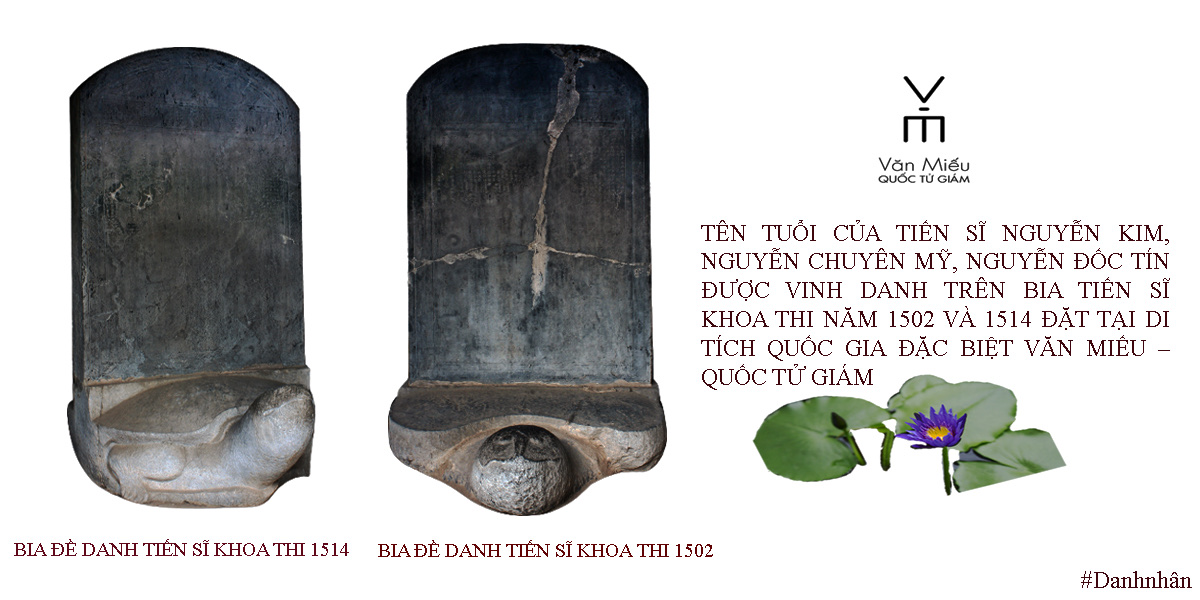
Đó chính là gia đình tiến sĩ Nguyễn Kim (1470- ?). Nguyễn Kim người xã Thạch Lựu, huyện An Lão (nay thuộc xã An Thái, huyện An Lão, Thành phố Hải Phòng). Năm 33 tuổi, ông đỗ Đệ tam giáp đồng Tiến sĩ xuất thân khoa Nhâm Tuất niên hiệu Cảnh Thống 5 (1502) đời Lê Hiến Tông. Ông làm quan đến chức Hiến sát sứ, khi mất được tặng hàm Hữu Thị lang.
Không chỉ ông mà cả hai con trai ông cũng đều đỗ Tiến sĩ. Đó là Nguyễn Chuyên Mỹ, Nguyễn Đốc Tín cùng đỗ Tiến sĩ khoa Quý Mùi niên hiệu Hồng Thuận thứ 6 (1514) đời Lê Tương Dực.
Tiến sĩ Nguyễn Kim sau khi thi đỗ làm quan đến chức Hiến sát sứ. Các con ông là Nguyễn Đốc Tín (đỗ Đệ nhị giáp Tiến sĩ xuất thân), Nguyễn Chuyên Mỹ (đỗ Đệ tam giáp Đồng Tiến sĩ xuất thân) làm quan dưới thời nhà Mạc đến chức Thượng thư. Trong suốt cuộc đời làm quan, ngay cả sau này khi đã về trí sĩ, ba cha con Tiến sĩ Nguyễn Kim đều có những đóng góp nhất định trên các lĩnh vực như văn hóa, và giáo dục cho đất nước. Trạng Trình Nguyễn Bỉnh Khiêm trong “Bạch Vân thi tập” đã có có bài thơ ca ngợi truyền thống học hành của cha con, anh em Nguyễn Chuyên Mỹ như sau:
“Đề Văn đẩu hầu gia
Nhất Môn phụ tử đệ nhị huynh
Đạo học tương truyền bản lục kinh
Tằng bả khoa danh liên quế tịch
Cánh lưu thanh ấm mãn hòe đình
Tâm vô tư lụy thất sinh bạch
Thi hữu cao ngâm sơn đối thanh
Thiên thọ Đẩu, Nam quan thái tại
Niên niên trường chiếu tử vi tinh”
Dịch nghĩa
TẶNG HẦU GIA VĂN ĐẨU
Một nhà có người cha và hai người con
Đạo học đươc thừa hưởng sáu bộ kinh thư
Từng chiếm bảng vàng các đợt thi cử
Nghỉ hưu vẫn vui vẻ rộn rã cả sân hòe
Lòng vô tư cửa nhà thanh bạch
Bạn thơ ngâm vang, núi cũng vọng lời
Trường thọ như núi, lòng thư thái
Tấm lòng son, trên đầu như có Sao tử vi mãi mãi chiếu soi
Hiện nay, ở xã An Thái, huyện An Lão, Thành phố Hải Phòng vẫn còn Từ đường Tam Tiến sĩ thờ ba cha con họ Nguyễn đều đỗ Tiến sĩ. Tên của các vị Tiến sĩ cũng được khắc trên bia đề danh Tiến sĩ hiện lưu giữ tại di tích Quốc gia đặc biệt Văn Miếu – Quốc Tử Giám./.
Thúy Hồng
PRINCIPAL OF QUỐC TỬ GIÁM SCHOOL NGUYỄN ĐỨC VĨ
Nguyễn Đức Vĩ (1700 - 1775), also known as Nguyễn Vĩ, was born in Phật Tích commune, Tiên Du district (now Phật Tích village, Phật Tích commune, Tiên Du district, Bắc Ninh province). He is the son of Dr. Nguyễn Đức Ánh who passed the Royal exam in 1715), father of Dr. Nguyễn Duân (passed the Royal exam in 1778), uncle of Nguyễn Quýnh (passed the Royal exam in 1766).
Nguyễn Đức Vĩ came first in the Regional exam. At the age of 28, he passed the Royal Examination in 1727 and was recognized as a Doctor under King Lê Dụ Tông's reign. After that, he became a mandarin and held many important positions such as Deputy Minister of Administration, Deputy Minister of Laws, Deputy Minister of Infantry, Minister of Public Affairs and Principal of Quốc Tử Giám School. He made a great contribution to the Lê – Trịnh administrations.
At the examination in 1760, he was assigned by the court to be the Deputy President of the Exam Board.
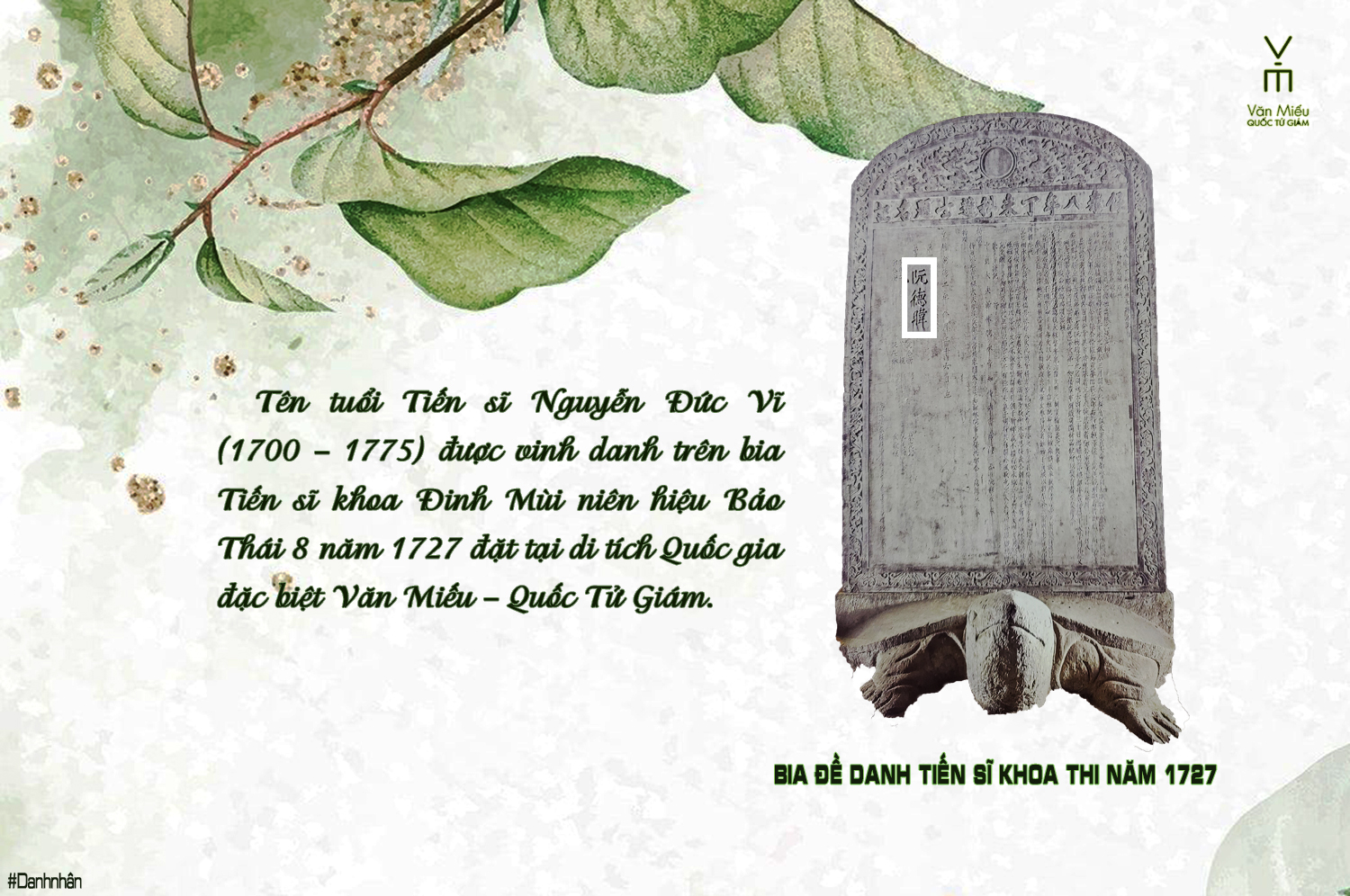
Principal Nguyễn Đức Vĩ is also an honest and careful person. For more than 18 years as a mandarin, he lived only on the Court salary. At the age of 64, he retired, but shortly after, Lord Trịnh Sâm invited him to become a mandarin and promoted him to Minister of Infantry. He died in 1775 at the age of 76.
Today, in Phật Tíchcommune, Tiên Du district, Bắc Ninh province, there is a temple where 4 doctors are worshiped, they are father, son and relative and are all doctors under Lê dynasty, one of them is Nguyễn Đức Vĩ. His name is also engraved on the stone stele that records the exam information in 1727) and located at the Văn Miếu – Quốc Tử Giám.
CT
LÊ QUÝ ĐÔN-A PERSON OF GREAT LEARNING AND ACTIVE LEARNING THROUGH LISTENING
Lê Quý Đôn (1726 - 1784) was born in Doc Lap commune, Hung Ha district, Thai Binh province. When he was 27 years old, he passed the exam held in 1752 under King Lê Hiển Tông and he was awarded the academic title Bảng nhãn (given to the 2nd best candidate). He used to hold many official positions in the court, some of them were Deputy Minister of Finance, Principal of Quốc Tử Giám School... Lê Quý Đôn is known for his many contributions in such fields as philosophy, history, economics, politics, society, literature, arts. During his career as a mandarin, in order to gain a wide understanding, he had set for himself the most important goal, which was to study, to compile and to do researches.
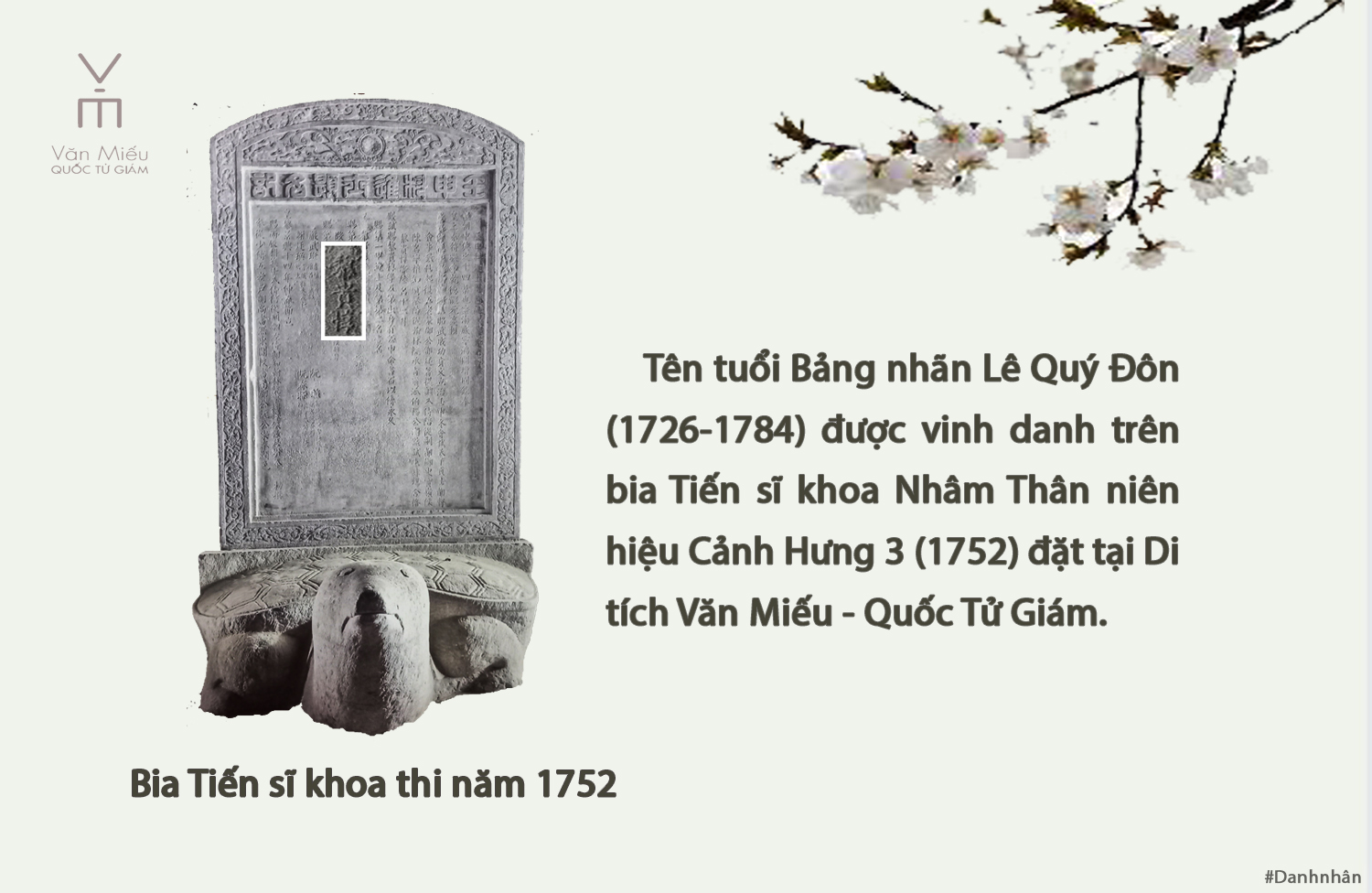
Name of Lê Quý Đôn was engraved on the stone stele recording the names of Doctors of the exam held in 1752. The stele was set up at the Văn Miếu-Quốc Tử Giám
From a young age, Lê Quý Đôn was known for his extraordinary talent: at two years old, he could read the words "hữu" and "vô", at the age of five he could read many texts in the Book of Poetry (Shijing), at the age of fourteen he understood all the Four Books and The Five Classics, and read the books by Zhu Xi, in a day cound do ten poetic essays without writing on a rough draft.
Witnessing the hunger and poverty of the people, the hardships of farmers during crop failure and drought, he was always worried. He tried to find a way from old books, he himself had real experiences in which he took notes and thought through everyday things. Unlike other Confucian scholars who were impractical, he always sticked to social life, tried to become knowledgeable, learn through listening a lot, always thought of ways to help the country and people. He said: “Basically the speech, the deeds and learning are always based on knowledgeability and listening a lot”. “Taking notes and adding comments” were how he did. It can be said that he read all the books he could find. Every thing he read, he took notes. Then he arranged them into different categories, both systematizing his knowledge and providing materials for his students.
He recorded the names of the good books, the good sayings and deeds of the people in the past and put them in the books he compiled… He also devoted a lot of time and effort to compiling many books on history. Not only did he introduce successive dynasties, he also recorded in great detail the customs, practices and characteristics of labor, living, and culture through the periods.
Through the legacies left by Lê Quý Đôn, we see that he was a man who understood the history of Vietnam, daily things such as living and eating, the characteristics of birds and plants, the customs of people of each district, village, religious ideas and scientific perceptions. His works discuss a lot nature, society and people, showing his talent and wisdom.
CT
BÁT TRÀNG – THE ACADEMIC VILLAGE OF THE CAPITAL THĂNG LONG
Bát Tràng is located along the Red River, Gia Lâm district, Hà Nội city. Bát Tràng is famous everywhere for the traditional pottery production and is a typical academic village in Thang Long Capital.
The Doctors Lauereates of Bát Tràng village belong to five families: Vương, Trần, Vũ , Lê Nguyễn, especially in which there are 2 families (Lê, Nguyễn) with 2 brothers who passed the royal exam and got the title doctor laureates.

Doctoral Laureate Vương Thì Trung (1537- ?) was the first man to become a 3rd- class laureate of the royal exam held in 1589. He was promoted to the rank of Head of the justice department. The second was Trần Thiện Thuật (1659 - ?). He passed the royal exam in 1683 and was promoted to Supervisor. The third one was Nguyễn Đăng Liên (1676 - ?). He passed the royal exam in 1706.
Two brothers of the Lê family were Lê Hoàn Viện (1688 - ?) who became a a 3rd- class laureate of the royal exam held in 1715 during the reign of King Lê Dụ Tông and was promoted to the Head of provincial justice. His younger brother Lê Hoàn Hạo (1699 - ?) became a laureate of the royal exam held in1727. He was promoted to Academician. In the Lê family there was Lê Danh Hiển (1757 - ?) who became 3rd- class laureate of the royal exam held in 1785. He was appointed as Supervisor and Head of Thanh Hoa province security.
Two brothers of the Nguyễn family were Nguyễn Đăng Liên (1676 - ?) and Nguyễn Đăng Cẩm (1678 – 1736). Nguyễn Đăng Cẩm became a 3rd- class laureate of the royal exam held in 1718. He was promoted to the Rector of Quốc Tử Giám.
The last laureate of Bát Tràng under the monarch system was Vũ Văn Tuấn (1803 – 1860) who became doctoral laureate of the royal exam held in 1843. He was promoted to the vice - ambassador to Qing Dynasty.
The Doctoral Laureates of Bát Tràng during the monarchy not only made positive contributions to the country but also contributed to a richer culture in the homeland. Although it is a famous craft village and there are many rich people, the Bát Tràng people also highly value knowledge.
LH
PDH TRÂN CẢNH AND VIETNAMES EDUCATION
Trần Cảnh (1684 – 1758) was a native of Hải Dương district passing exam in 1718 with his rank “Tiến sĩ”. He was brought up in the traditional exam of his family.
Trần Cảnh was a uprigh mandarin confided many important tasks by King. It was a fate that his career had a strong attachment to education. The King confided a task as a examineer to him many times. He played a role examiner of regional exam in 1720, 1726, 1727, 1735,1735, 1736, 1738… Trần Cảnh appointed to the headmaster of Quốc Tử Giám.
Trần Cảnh held the post of headmaster of Quốc Tử Giám several months, his literary career identified itself with Vietnamese education. Trần Cảnh complimented on his contributions, and promoted to the post of Quận Công.
Translator BP
PDH NHỮ ĐÌNH TOÀN AND QUỐC TỬ GIÁM
Nhữ Đình Toản (1703 – 1773), being a native of Haỉ Dương district, being brought up in the tradition of study of his family. When he was a child, he was well-known with his intelligence and good learning. Nhữ Đình Toản passed national exam with top rank at the age of 34. Then he had important leadership positiions.
Nhữ Đình Toản was good at literature as well as military affairs that’s why he appointed to command troops as a leader. He worked as a headmaster of Quốc Tử Giám to manage the first national university and to train talented scholars in 1756. Nhữ Đình Toản was a upright man appointed to an important position by Lord.
Nhữ Đình Toản had many contributions to Quốc Tử Giám as well as cause of education of the nation. He also composed the text engraving on the stone stelae recording the names and title of Doctoral Laureates.
Nhữ Đình Toản’s name engraved on the stone stele for exam in 1736 preserved at Văn Miếu – Quốc Tử Giám.

BP
TWO BROTHERS PASSES THE ROYAL EXAM TOGETHER AND GOT THE TITLE DOCTORAL LAUREATES
In the Royal exam organized in 1731 under the reign of Emperor Lê Duy Phường there were 12 men who succeeded including two brothers: Trần Danh Ninh (1703-1767) và Trần Danh Lâm (1704 -1776) from Bảo Triện commune, Gia Định district, now Bảo Triện village, Nhân Thắng commune, Gia Binh district, Bắc Ninh province.
The two brothers Trần Danh Ninh and Trần Danh Lâm were fond of studying when they were little boys. The elder brother - Trần Danh Ninh got the first rank when he took the Huong (Provincial) exam and the Đình (Royal) exam. He was appointed to high ranking positions over the years such as Acadamician, Rector of the Quốc Tử Giám, Minister of Rite…
The younger brother – Trần Danh Lâm (Provincial) took the exam at the age of 21 with his brother Trần Danh Ning and passed the Royal exam in 1731, gaining the titile Doctoral Laureates with his brother as well at the age of 27. He was also appointed in many important positions such as Acadamician, Minister of Construction, Minister of Justice… He worked as mandarin for 39 years.
The case of two children Trần Danh Ninh and Trần Danh Lâm both obtaining Doctoral Laureates together in the Royal exam is one proof of the studious tradition of families and academic villages throughout the country. The names of these two Doctoral Laureates are engraved on the stele and kept at the Special National landmark of Văn Miếu – Quốc Tử Giám.
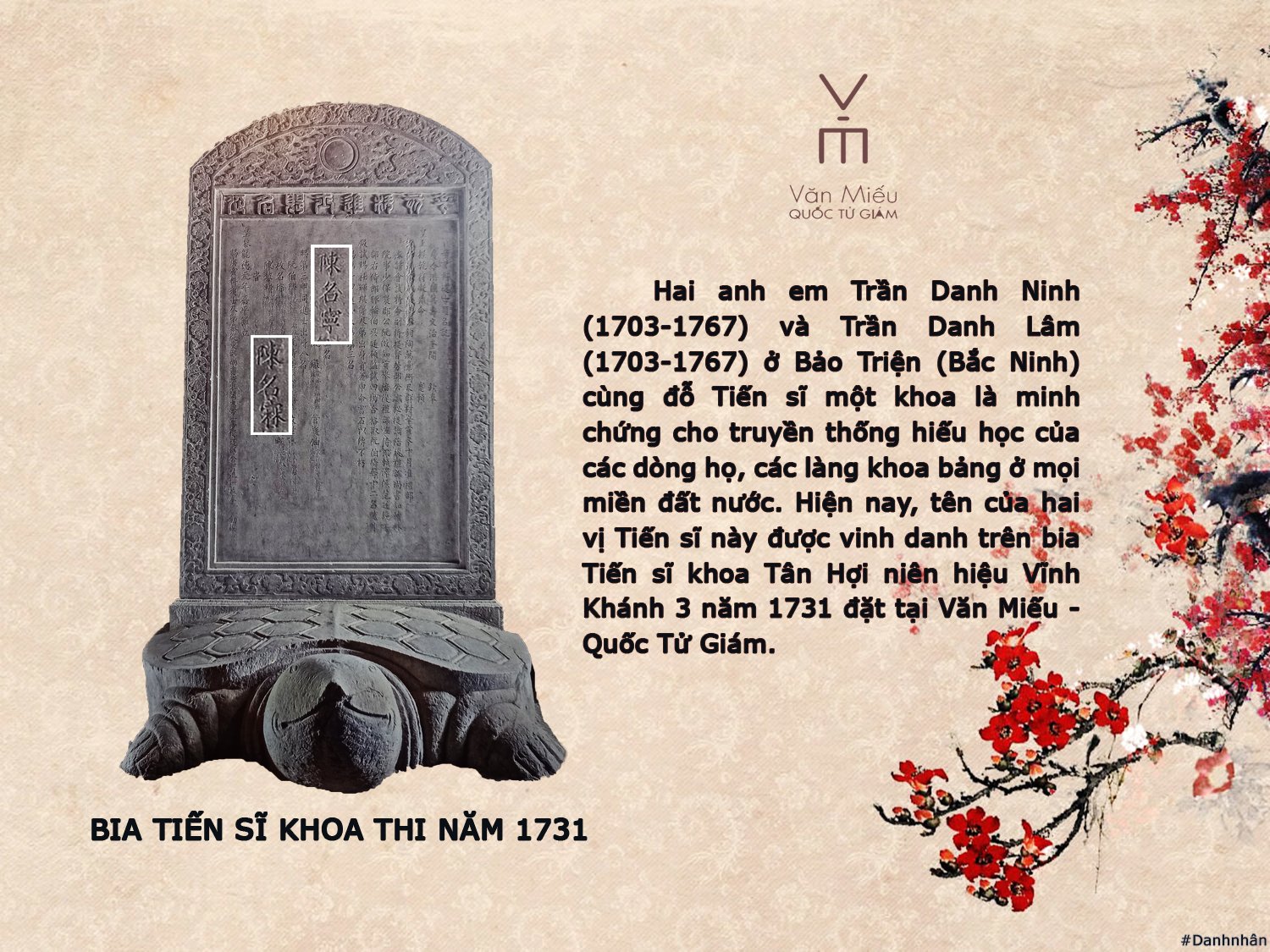
LH
DOCTOR DƯƠNG CHẤP TRUNG (1414-1469)
Dương Chấp Trung was born in Sài Xuyên commune, Kỳ Hoa district - now in Cẩm Xuyên district, Hà Tĩnh province. He was the son of military leader Dương Công Cứ who managed the Imperial Guards of the Lê Dynasty.
When he was a child, he was sent to the capital by his father for studies and was famous for being intelligent, handsome, good at literature, martial arts, loved by the Prince of the Lê Dynasty, so he was sent to serve the crown prince in the palace Tiềm Để when King Lê Nhân Tông had not yet come the throne.
In the exam in 1448 during the reign of Lê Nhân Tông, he passed the exam and achieved the academic title Hoàng Giáp. After that, he was appointed by the King to hold the position of Tham chính Thừa tuyên sứ. Under the reign King Lê Thánh Tông, he was promoted to Đại lý Tự khanh (1467), then promoted to Deputy Minister of the Ministry of Justices. He was loved and respected by the king and mandarins of the Lê dysnaty.
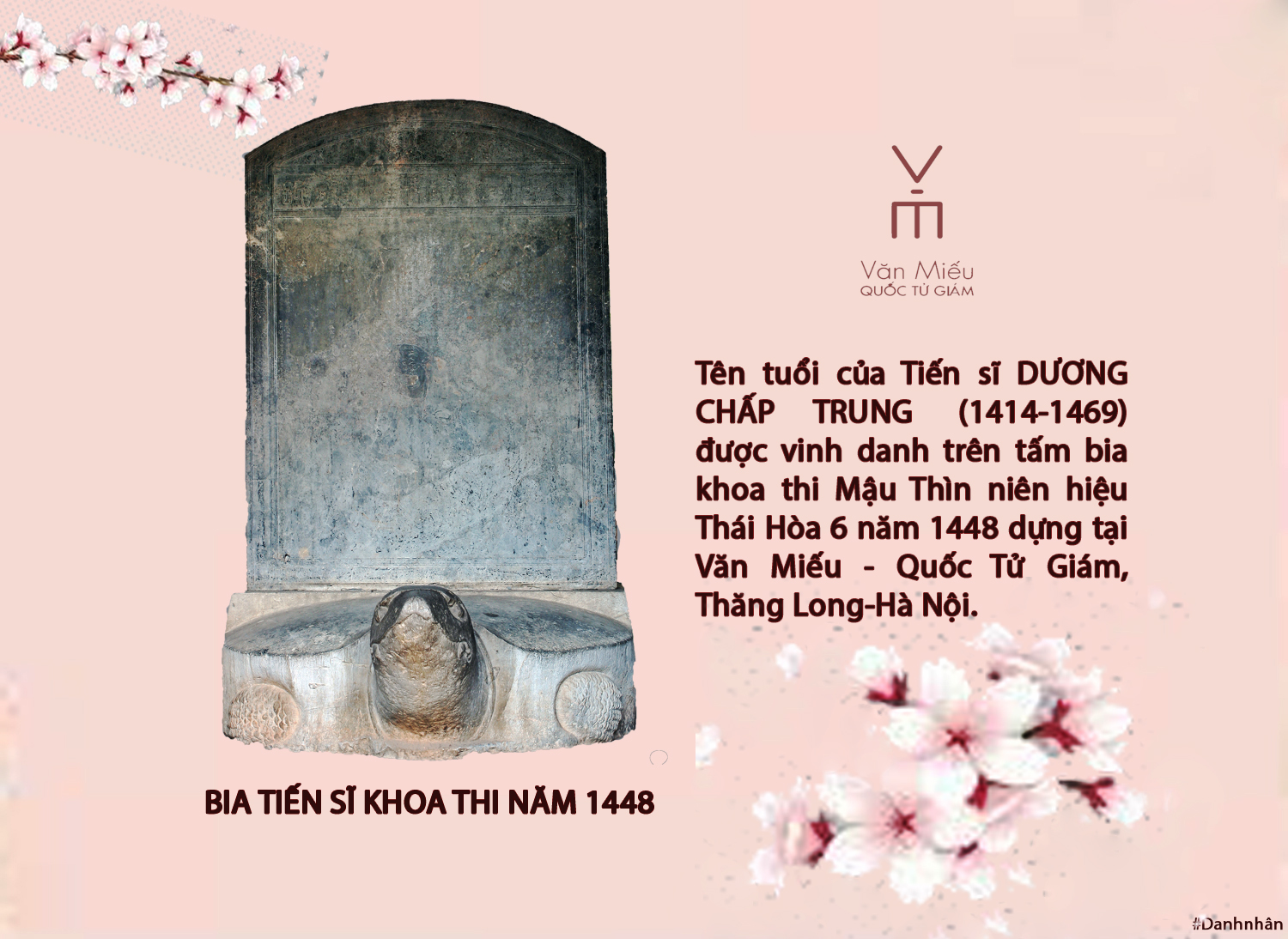
In the examination in 1469, he was chosen by the king to be the Proctor for the Hội examination, at this time he held the position of Deputy Minister of the Ministry of Justices. He was an intelligent, upright, straightforward man who made many contributions to the court and often made contributions to political affairs, so he was trusted by the king.
To commemorate his merits for the homeland, the country and his family, in 2012, the Council of the Dương family in Hà Tĩnh province called upon its descendants to contribute money to rebuild Dương Chấp TrungTemple. Up to now, the temple has been completed and recognized as a provincial historical and cultural relic.
CT
NGUYEN QUAN QUANG – THE FIRST “TRẠNG NGUYÊN” OF VIETNAM
Nguyen Quan Quang (1222-?) being a native of Bắc Ninh province, being fond of study. When he was a child, Nguyễn Quan Quang had to pick up teacher’s lecture from classroom because his parents did not have enough money to pay school fees for him. The teacher felt admiration for Nguyễn Quan Quang and allowed him to enter on study.
Nguyễn Quan Quang being well-known with his intelligence, passing the exam in 1246 with highest rank “Trạng nguyên”. According to Vietnamese history of education, the first examination held in 1076 to select the best doctoral laureates. In 1246, the top of successful candidates being ranked as Trạng nguyên, Bảng nhãn, Thám hoa. Nguyễn Quang Quang was called the first Trạng nguyên in Vietnam.
After returning hometown with his glory, Nguyễn Quang Quan attended an audience give by the king to take office. The king loved and esteemed a man of mettle whom then received a national character and named Trần Quang Quan.
During the war of Mongolian aggrestion, Nguyễn Quang Quan being winning promotion on merits by King. When he worked as a mandarin, he served for the country and the people with all his heart that made the people love and estem Nguyễn Quan Quang. He lived in retirement in his hometown to manage his private class. In order to commemorate Nguyễn Quan Quang, the people recontructed the pagoda calling Linh Khánh pagoda under former of his private classroom.
Translator BP
QUỐC TỬ GIÁM PRINCIPAL TRƯƠNG CÔNG GIAI AND HIS CAREER IN TRAINING, RECRUITING TALENTS
Quốc Tử Giám Principal Trương Công Giai (1665 - 1728), was born in Thanh Tâm commune, Thanh Liêm district, Hà Nam province. From a young age, his name was Trương Công; he was famous for his intelligence and was taught by his talented father. As a talented and highly educated person, he achieved high rankings in Hương and Hội exams (Regional and National Exams).
Participating in the exam held in 1685 at his age of 21 during the reign of King Lê Hy Tông, Trương Công passed this exam and was recognized as a Doctor. He was one of the few young PhDs in the history of the Confucian examination in Vietnam. Later, he changed his name to Trương Công Giai.
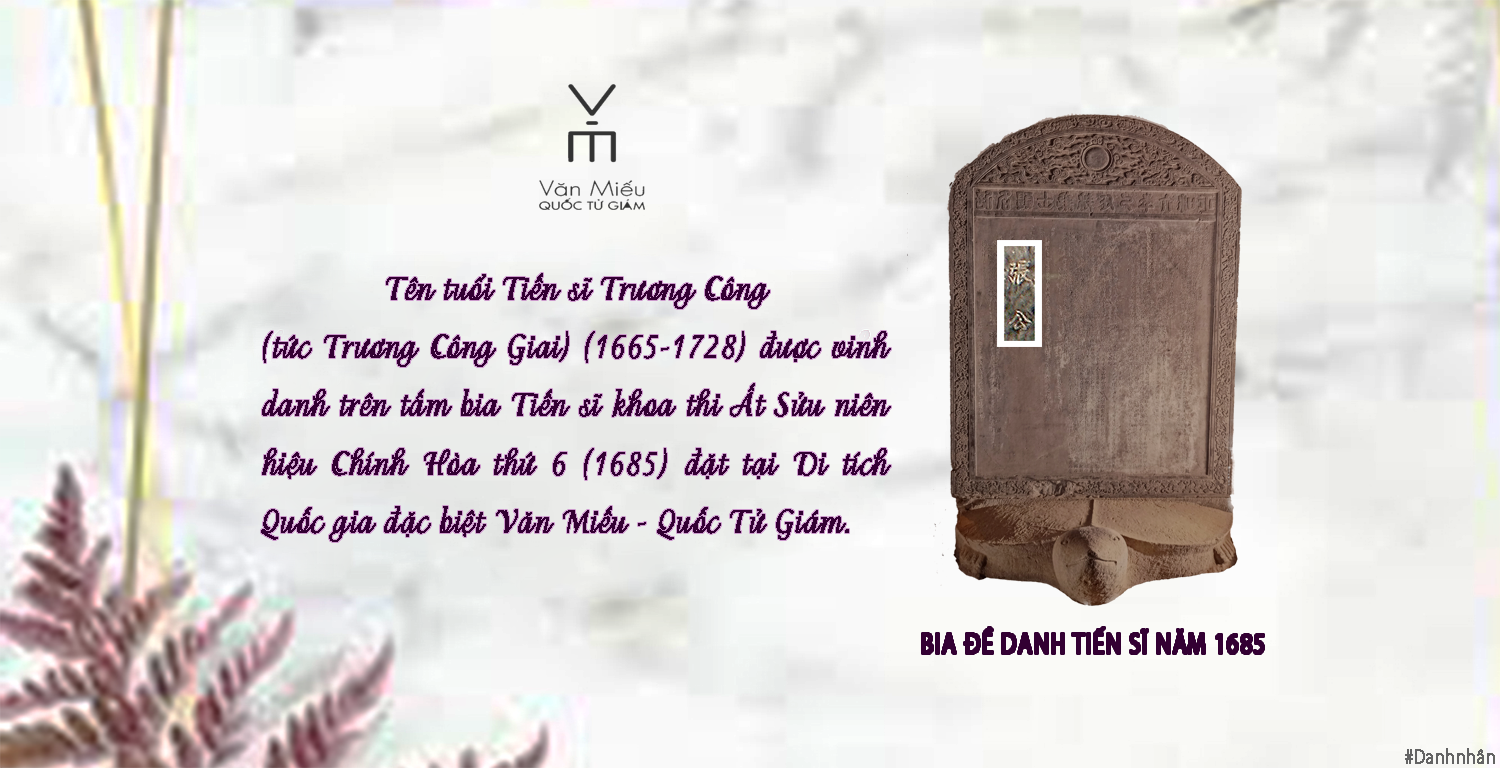
During his 43 years as a mandarin under the Lê – Trịnh dynasties, Trương Công Giai held many positions, some of which include: Deputy Minister of Public Works, Minister of Public Works, Minister of Pictures, Quốc Tử Giám Principal.
According to the book "Văn Miếu – Quốc Tử Giám and 82 stone steles" (Ngô Đức Thọ), Trương Công Giai was successively appointed by the court to be the Deputy of the Board of examiners of 3 exams held in 1718, 1721, 1724. These exam were successful in recruiting many outstanding talents, supplementing the state bureaucracy at that time.
In 1721, Trương Công Giai was appointed as Principal of Quốc Tử Giám. At this time, the Lê – Trịnh dynasties emphasized the importance of training talents, organizing exams of Hương and Hội. Lord Trịnh also stipulated: Principal and Vice Principal of Quốc Tử Giám school directly teach students. With his knowledge and virtue, Trương Công Giai trained many students so that they became good ones who would made great contributions to the country.
It can be said that Trương Công Giai made many contributions to the training and recruiting of talents for the state bureaucracy of his time. His name was honored on the stone stele that records the names of the doctors of the examination held in 1685. Today, the stele is currently preserved at the Special National Landmark Văn Miếu – Quốc Tử Giám.
CT
THE THIRST FOR KNOWLEDGE OF PhD. NGUYỄN QUÁN NHO
Nguyễn Quán Nho (1638-1708), is a native of Vãn Hà commune, Thụy Nguyên district (now Vãn Hà town, Thiệu Hóa district, Thanh Hóa province), was orphaned at a young age. His mother, Mrs. Trịnh Thị Phúc worked for rich families. She worked hard and decided not to get married to raise her son. Legend has it that every day little Nguyễn Quán Nho went to work with his mother, when he saw a teacher teaching the owner's son, he overheard the teacher's lecture. After that, he used a stick to write words on the ground, when at home he wrote words on a cactus or on a banana leaf with a stick. At night, he caught fireflies and put them in an eggplant or eggshell to make a lamp for study. Later, he was accepted as a student by a teacher at Phủ Lý village (now in Thiệu Trung commune, Thiệu Hóa district, Thanh Hóa province).
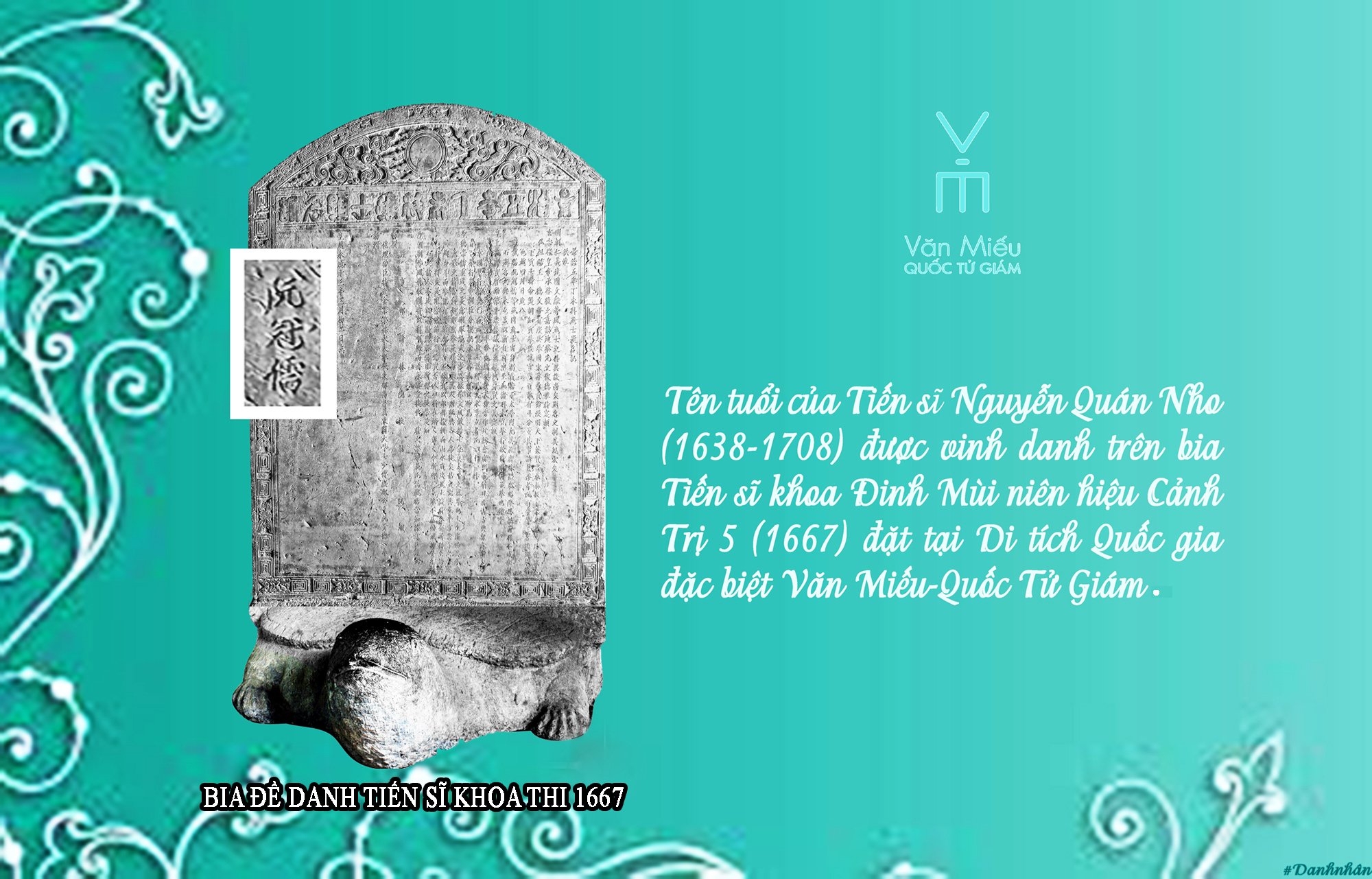
Because of his hard work and strong will, at the age of 30 Nguyễn Quán Nho ranked first in the Đình(Royal) exam in 1667 during the reign of King Lê Huyền Tông. He was once sent as an envoy to the Qing Dynasty (1681), he held a number of officials in the court, one of which was the Minister of Infantry. He made many great contributions to the country. His name is still preserved on the stone stele erected at the Văn Miếu-Quốc Tử Giám.
His thirst for knowledge and strong will be a good example for generations of students to follow.
CT
COT VILLAGE - THE HOMELAND OF 10 DOCTOR LAUREATES
Cot village is also known as Hạ Yên Quyết. Today it belongs to Yên Hòa ward, Cầu Giấy district, Hanoi. It was one of the 21 typical academic villages of our country during the monarchy and also one of the 5 typical academic villages of the capital.
Under the monarchy, the village had 10 doctor laureates, including Nguyễn Nhật Tráng, who passed the exam in 1595, Nguyễn Dụng Triêm who passed the exam in 1602 and Nguyễn Vinh Thịnh who passed the exam in 1659. Now there are doctor stele of those exams at Văn Miếu – Quốc Tử Giám.
After passing the exam, the doctors laureates of Hạ Yên Quyết village held important positions in the court. With the talents and virtues they helped the king to govern the country. Doctor laureate Nguyễn Như Uyên worked as Minister and the head master of Quốc Tử Giám - the most senior school under the monarchy. He was highly appreciated by King Le Thanh Tong for his academic talent and moral qualities
Hạ Yên Quyết as well as other famous academic villages focused on education. Besides 10 doctoral laureates, the village still had many people who have passed the regional exams during the Le dynasty and Nguyễn dynasty.

LH
NGUYỄN PHI KHANH-PRINCIPAL OF QUỐC TỬ GIÁM SCHOOL
Principal of Quốc Tử Giám school Nguyễn Phi Khanh (?-1428), whose real name is Nguyễn Ứng Long, was born in Chi Ngãi commune, Chí Linh district, Hải Dương province. Later, he moved to Ngọc Ổi commune, now Nhị Khê commune, Thường Tín district, Hà Nội. He is the father of the Great Cultural Personality Nguyễn Trãi, The National Hero.
Born and raised in an ordinary family, he was famous for his literary talent since childhood. Therefore, he was invited by Trần Nguyên Đán, an official of a royal family of the Trần Dynasty, toteach his daughter. According to the annals of the Nguyễn Quy family in Chi Ngãi: “Nguyễn Phi Khanh was a talented Confucian scholar who was invited by Trần Nguyên Đán to his palace to teach his daughter, Trần Thị Thái. Later he married that girl and she gave birth to Nguyễn Trãi”.
In 1374, he passed an exam and achieved an academic title called Thái học sinh, but was not appointed as an official. In 1400, after Hồ Quý Ly ascended the throne, Nguyễn Phi Khanh was invited by the Hồ dynasty to help the country. Hồ Quý Ly changed his name to Phi Khanh, and at the same time appointed him to hold the position of Hàn lâm viện Học sĩ, and then promoted him to such positions as Thống chương Đại phu, Đại lý tự khanh kiêm Trung thư Thị lang, Tư nghiệp Quốc Tử Giám(Principal of Quốc Tử Giám school).
In 1406, the Ming army invaded the country, Nguyễn Phi Khanh and the Hồ Dynasty joined the resistance war against the Ming invaders. After that, he and the king and servants of the Hồ Dynasty were captured by the enemy and brought back to Kim Lăng. On the way, his two sons, Nguyễn Trãi and Nguyễn Phi Hùng, asked to follow him to take care of him. But Nguyễn Phi Khanh advised Nguyễn Trãi to return home to figure out a way to take revenge for the country and for him. Nguyễn Trãi listened to his father, and went to Thanh Hóa to help Lê Lợi lead the Lam Sơn uprising defeating the Ming army and liberating the country. In 1428, Nguyễn Phi Khanh died in China at the age of 73. Nguyễn Phi Hùng brought his father's remains to bury at Tam Tiêu mountain (now in Hoàng Hoa Thám commune, Chis Linh). Since then, Tam Tiêu mountain was renamed Báo Đức mountain.
Nguyễn Phi Khanh is not only a talented man who always thought about the destiny of the country, but also a writer highly appreciated by many famous scholars. He wrote many literary works including literature and poems. They express the mind of the feudal intellectuals over the situation of the country and people. Although not many of Nguyễn Phi Khanh literary works are left, they do show his contributions to medieval Vietnamese literature.
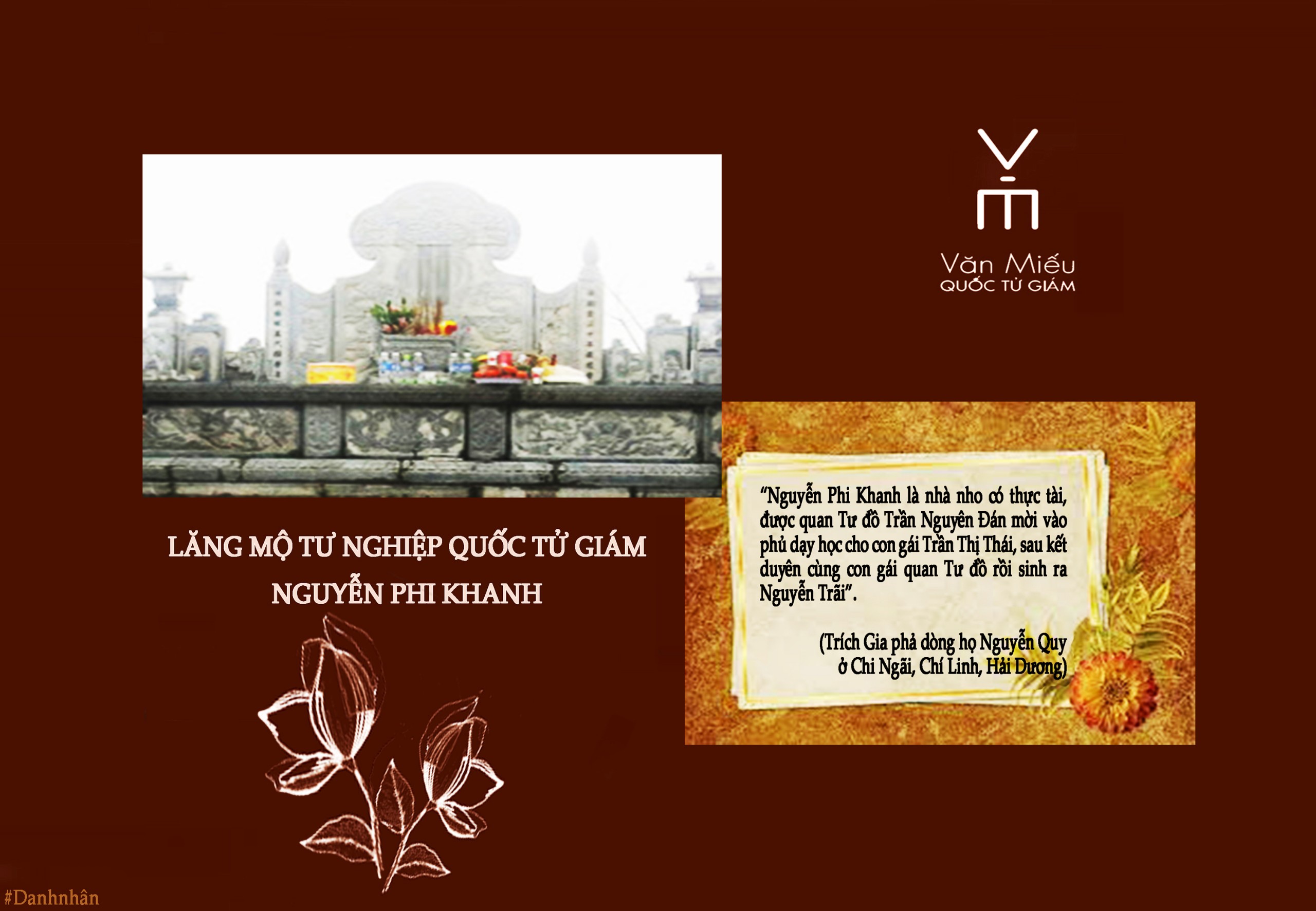
Nguyễn Phi Khanh's tomb
CT
PHD. ĐỖ NHUẬN, A MARKER IN FOUR ROYAL EXAMS
Đỗ Nhuận (1446 - ?), was born in Kim Hoa commune, Kim Hoa district, Kinh Bac (now Bach Đa village, Kim Hoa commune, Mê Linh district, Hanoi). In 1466, he passed the Royal exam and became a PhD. He used to hold many important positions in the court. King Lê Thánh Tông appointed him Tao Đàn deputy marshal, and invited him to attend his poetry reviews. In particular, Đỗ Nhuận was trusted by the court and was assigned to be the marker in the four Royal exams which were to select talents for the country. The exams he served as a marker included the ones held in 1475, 1481, 1487, and 1493.
In the Pre-Court competition exams, the court appointed officials who are talented, learned and have a high sense of responsibility to be markers. Most of these officials were prestigious people, succeeded in exams, and made many contributions to the court. When the king examined exam papers, a marker presented the papers to the him and read the contestants' papers aloud so that the king could rank the candidates based on their scores.
Being a marker in the four Royal exams held by the court, Đỗ Nhuận had made a great contribution to the selection of talents for the country.
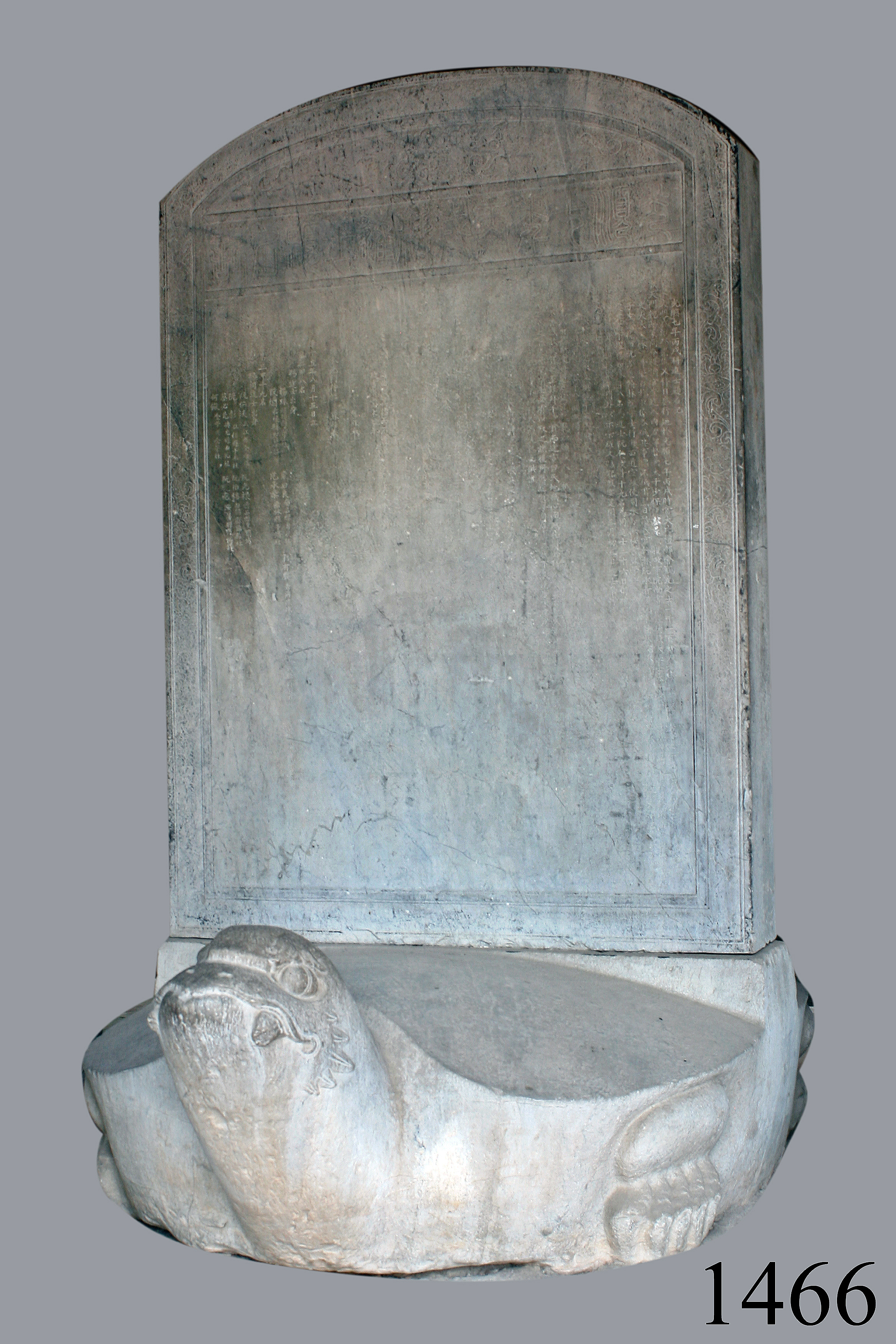
Photo: Đỗ Nhuận’s name and hometown are honored on the stele of the exam held in 1466, the stele is now preserved at the Văn Miếu – Quốc Tử Giám
CT
THE DOCTORAL LAUREATE RETREATING THE TROOPS WITH A POEM
Ngô Miễn Thiệu was a nativw of Tam Sơn commune, Từ Sơn county town, Bắc Ninh province. His family was famous in education and examination with his father being ranked the second and and his uncle being ranked the third.
Ngô Miễn Thiệu was well-known with his intelligence and fondness of study. Ngô Miễn Thiệu taking part in royal exam, being ranked the top title (Trạng nguyên) in 1518 at the age of 20. He was appointed to government official under Lê dynasty. In 1527, when Mạc Đăng Dung usurped the throne of Lê king, Ngô Miễn Thiệu pledged loyalty to Lê King wholeheartedly then declined to serve new empire.
He retired at Tam Sơn to give his whole mind to training. The King in China intriguing to usurp Vietnam long ago, deputing government official to condemn Mạc King. The China government official sent memorandum and a poem giving a content of underestimation to army and people of Vietnam.
Ngô Miễn Thiệu was asked for help by Mạc King to respond to a memorandum and a poem. After the China governent official read a poem given by Ngô Miễn Thiệu, he had decided to order the troops to retreat. As from situation, King Mạc Đăng Doanh hold Ngô Miễn Thiệu in great admiration being appointed to the government official with high leadership position.
Ngô Miễn Thiệu's two sons succeeding to his career, passing exams with the third rank, being appointed to government officials.

The stone stele for exam in 1518 recording Ngô Miễn Thiệu
Ngô Miễn Thiệu was a upright official and virtuous teacher contributing to a cause of protecting a nation and training the talents. His name was engraved on the stone stele for exam in 1518 at Văn Miếu – Quốc Tử Giám./.
Translator: BBP
NGUYẾN NHÂN THIẾP - THE HEADMASTER OF QUỐC TỬ GIÁM
ANDTHE NGUYỄN FAMILY BEING FAMOUS IN EDUCATION AND EXAMINATION
Nguyễn Nhân Thiếp (1452 - ?) was a native of Kim Đôi commune, Võ Giàng district, Bắc Ninh province. He was well-known with his intelligence and studiousness when he was a child. At the age of 15, he and his brother, participated in the royal exam, gained the high ranks under the reign of King Lê Thánh Tông.
After returning hometown with his glory, Nguyễn Nhân Thiếp was appointed to the highest position of Lập Thạch district. Nguyễn Nhân Thiếp kept trying to study hard while he was working as a district cheif. At the age of 16, he passed "Hoành từ " exam and worked at Bí thư giám. Nguyễn Nhân Thiếp was appointed to the headmaster of Quốc Tử Giám and then Minister of Ministry of the Interior under the reign of King Lê Hiến Tông.
Nguyễn Nhân Thiếp achieved success in government tasks under Lê dynasty when he was young.
The Nguyễn Family was well-known with 18 doctoral laureates passing Confucian exam. Nguyễn Nhân Thiếp's brothers working for government under the reign of King Lê Thánh Tông when they were young.
Nguyễn Nhân Bỉ (1448-?),passed exam in 1466 at the age of 19, worked as the Minister of Ministry of War in Feudal.
Nguyễn Nhân Bồng 1451 - ?) passing exam in 1469 at the age of 19
Nguyễn Nhân Dư (1456 - ?) passing exam in 1472 at the age of 17
Nguyễn Nhân Đạc (1458 - ?) passing exam in 1479 at the age of 18
The Nguyễn family at Kim Đôi village achieved the great success in proceeding from the tradition of education and examination to the next generation.
The names and titles of Nguyễn Nhân Thiếp and the Nguyễn family, being natives of at Kim Đôi – Bắc Ninh, engraved on the stone stelae at Văn Miếu-Quốc Tử Giám Hà Nội and Văn Miếu Bắc Ninh. They were bright examples to the generations.
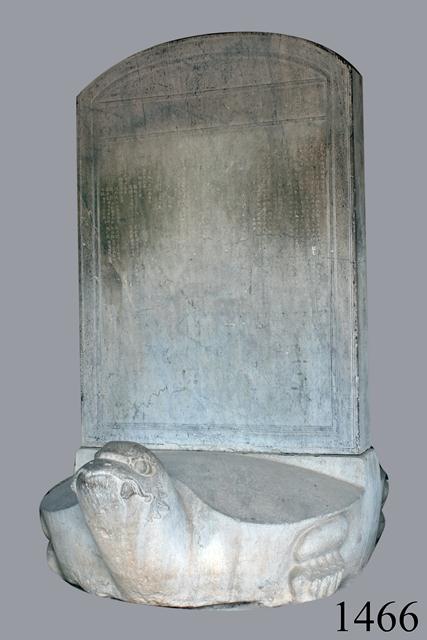
The Stone Stele At The Văn Miếu-Quốc Tử Giám To Record The Names Of Ph.Doctors Of The Exam Held In 1466
BP
PHD. NGÔ THÌ NHẬM
Ngô Thì Nhậm (1746-1803) was born in Tả Thanh Oai, Thanh Oai district, Hà Đông Province (now Hà Nội). He passed the Royal exam held in 1775 (in the reign of King Lê Hiển Tông) at the age of 30. He held many important positions in the court including Vice Minister of Construction, Vice Minister of Interior Affairs, and Minister of the Military.
PHD. Ngô Thì Nhậm was a talented scholar. He frankly proposed to Lord Trinh three major policies in three areas: politics, education and law. There must be a clear policy of politics to be obeyed by all, the law must be strict and the education must be extensive.
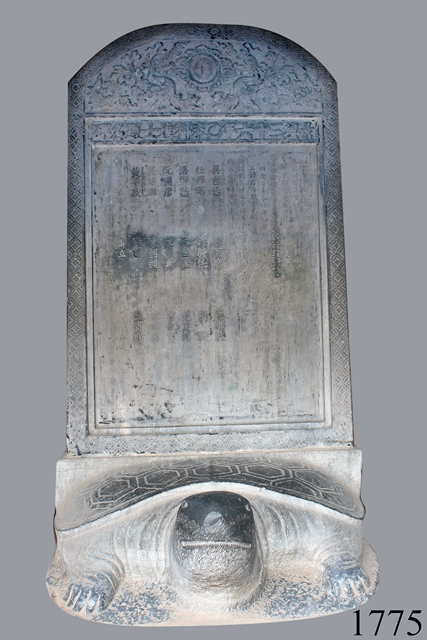
The stone stele that records the name of PhD. Ngô Thì Nhậm, at the Văn Miếu-Quốc Tử Giám
He and Ngô Văn Sở were assigned by King Quang Trung to govern the Bac Ha region. In this position, he persuaded many Bac Ha scholars to return to work for Tay Son Dynasty. This greatly contributed to the consolidation of politics in the north. After defeating the Qing army, King Quang Trung assigned him the task of diplomatic relations with the Qing. With his diplomatic talent, Ngô Thì Nhậm successfully completed the task. He persuaded the Qing Dynasty not to take revenge, to avoid the incident of war. Through letters, official dispatches and going himself three times to the northern border to negotiate, in 1790 Ngô Thì Nhậm convinced the Qing court to receive the envoy of Đại Việt. In 1792, he was appointed as Chief Ambassador to the Qing Dynasty.
Ngô Thì Nhậm was always a man wholeheartedly for the country and people. He always put the interests of the country and the people first. He maintained the noble qualities of a scholar when he was a politician and diplomat under the Lê - Trinh dynasties while society went through many changes. The stone stele that records his name is still preserved at the Special National landmark, Văn Miếu-Quốc Tử Giám.
LH
FATHER AND SON PASSED THE SAME CONFUCIAN EXAM
In 1592, Ngô Trí Tri (1537 – 1628) and Ngô Trí Hòa (1565 – 1626) were natives of Lý Trai Commnue, Nghệ An province who passed the same Confucian exam. Ngô Trí Tri gained the third rank whose son Ngô Trí Hòa gained the second rank (Hoàng Giáp)
This situation was one of a kind.
According to history of education in Vietnam, there were a large number of people those who had blood relatives, passed the same Confucina exams. Especially, father and son passed the same Confucian exam in 1592. Legend has it that the king was moved and fired by fondness of studying of Ngô Trí Tri and Ngô Trí Hòa, gave the baldachin with golden four characters, meaning that father and son passed the same exam was an only situation over the world.
Their names and titles were engraved on the stone stele of exam in 1592 at Văn Miếu – Quốc Tử Giám. The inscription on the stone stele concerning this situation, meaning that father and son passed the same exam, was making people happy those who were living in the peaceful civilized life.
After passing exam, Ngô Trí Tri and Ngô Trí Hòa succeed in playing as a role of leadership positions. Ngô Trí Hòa worked as the headmaster of Quốc Tử Giám and gave petition to the king to order six things releate to politics to be fixed
Ngô Trí Hòa’s son passed a Confucian exam in 1646 whose descendant of next generations succeed in study and career. Ngô Trí Tri and Ngô Trí Hòa were a good examples to generations.
TRỊNH THIẾT TRƯỜNG WHO PASSED THE CONFUCIAN EXAMS TWICE
Trịnh Thiết Trường (1390 - ?) was a native of Thanh Hoá province, a well-known man with his knowledge and intellegence.
In 1442, Trịnh Thiết Trường participated in the Hội exam (national exam) with expectation of being the top rank. He tried to gain the gold, nevertheless, he gain just the third rank (Tiến sĩ),appointed as a mandarin. He was not satisfied with his goal, decided to leave office and retake an exam.
Trịnh Thiết Trường was determined to study assiduously for many years. In 1448, he passed the second royal exam with the second-best (Bảng Nhãn).
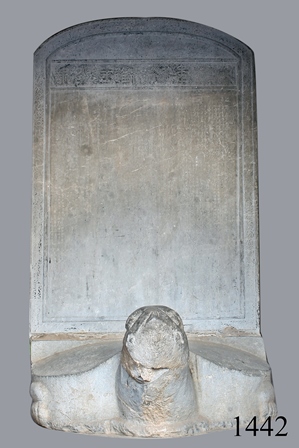

The King was so pleased with Trịnh Thiết Trường's efforts who gave Trịnh Thiết Trường special favors and appointed him to a mandarin. In 1457, Trịnh Thiết Trường was sent to China as a King's envoy.
Trịnh Thiết Trường's name and title were engraved on two stone stelae (1442 and 1448). He was a good example of strong will, great success and assiduity to the next generation.
BP
82 YEARS OLD TOOK PART IN THE EXAM
In 1900, there was a candidate with gray hair and beard who took part in the Hương (regional) examination of Nghe An. His name was Đoàn Tử Quang. He was born in 1818 in Huong Son district - Ha Tinh province.
As a child, he was bright, intelligent, and well-educated but passed three rounds only twice (Huong exam includes 4 rounds): the first time at 49 years old and the second at 66 years old. Listening to his mother’s advice, he took the examination of Canh Ty (1900) under the Nguyen Dynasty when he was 82 years old.
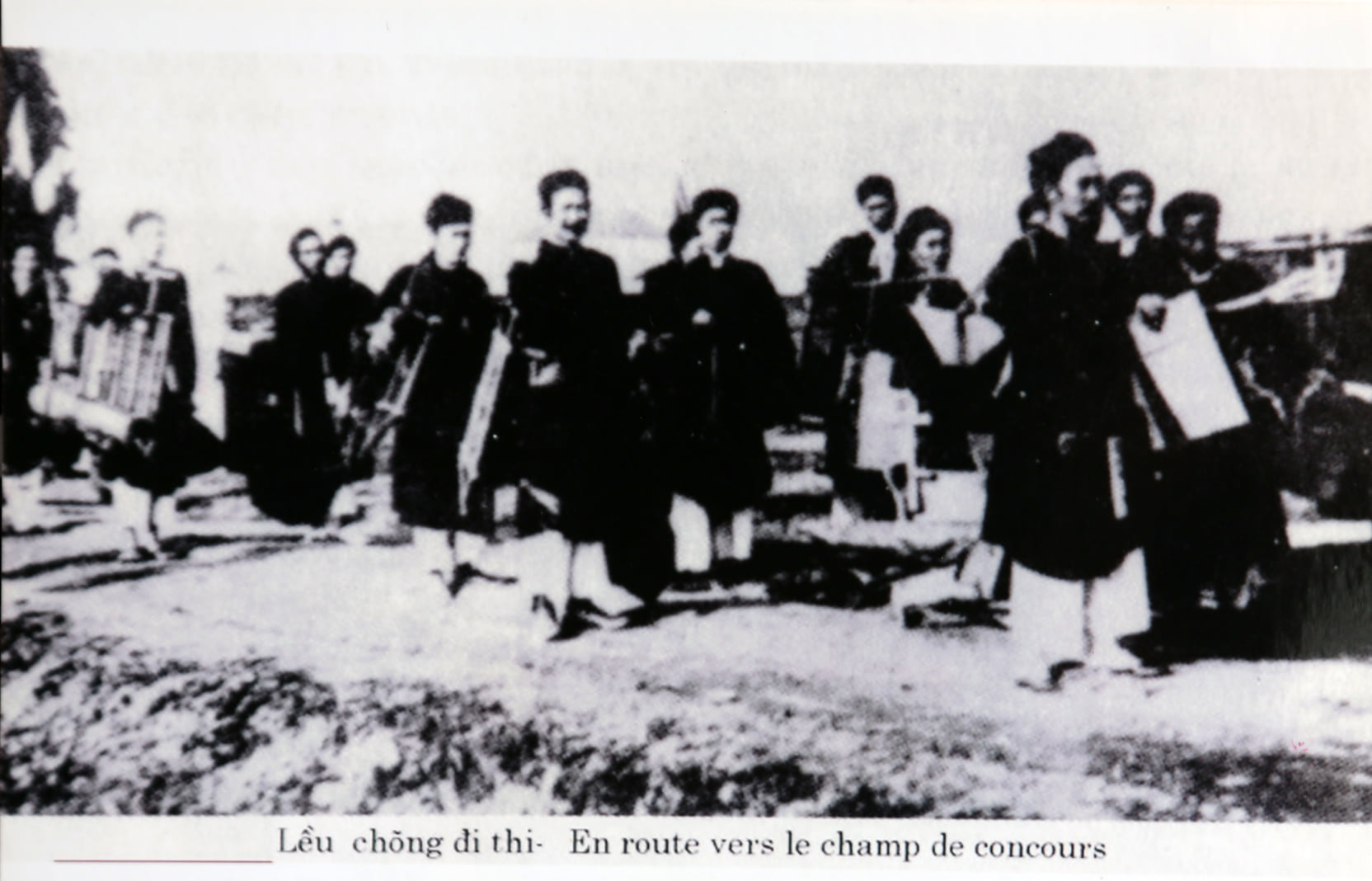
When he entered the exam field, the examiners were worried about his health.
Đoàn Tử Quang also did the exams seriously liked other candidates. After the first round there were only 35 people who passed including Đoàn Tử Quang. The examiners found that his writing was beautiful and clearer than many other candidates. As a result, through the four four rounds, Đoàn Tử Quang ranked the second, but because of violating the examination’ rule, he ứa ranked only 29 out of 30 candidates.
After passing the exam he was appointed as Huan Dao, the official who considers the education at the district level by King Thanh Thai. He lived through 13 kings. He died in 1928, at the age of 110 years old.
LH
BÙI XƯƠNG TRẠCH (1438 - 1516) , THE DIRECTOR OF QUỐC TỬ GIÁM, WAS A MIRROR OF STUDIOUSNESS
He was from Thanh Dam district, now Thanh Tri district, Hanoi, and had been famous for his fondness of studying since he was a child. His parents were farmers, so he was proficient in buffalo breeding, transplanting, and plowing. When he was plowing and working, he also brought books with him and studied at the same time. So he was able to complete the field work and improve his education as well.
In 1478, under King Le Thanh Tong, he attended an exam organized by the court. After completing the exam, he returned to his hometown to continue working in the fields.
Some time later, the court hung a yellow board to announce the pass. Bùi Xương Trạch and 61 others passed the examination in 1478. Meanwhile, he was still plowing the fields.
After passing the exam, Bùi Xương Trạch was appointed to important positions in the court by the king. In particular, the king appointed him to be the headmaster of Quốc Tử Giám. During his work as a mandarin, he did his best to help the people and the country with integrity. He was respected by the people with eternal gratitude.
His name and 61 other who passes the exam are engraved on the stele of 1478 at Văn Miếu-Quốc Tử Giám.
TEACHER – VU THANH (1664-1727)
Teacher Vu Thanh (1664-1727) was from Dan Loan village, Duong An district, which is now Dan Loan village, Nhan Quyen commune, Binh Giang district, Hai Duong province. As a child, he was very smart, fond of learning and good at literature; In 1686, at the age of 22, he passed the Royal exam. He got the third highest grade. He worked as an officer and the Rector of Quoc Tu Giam.
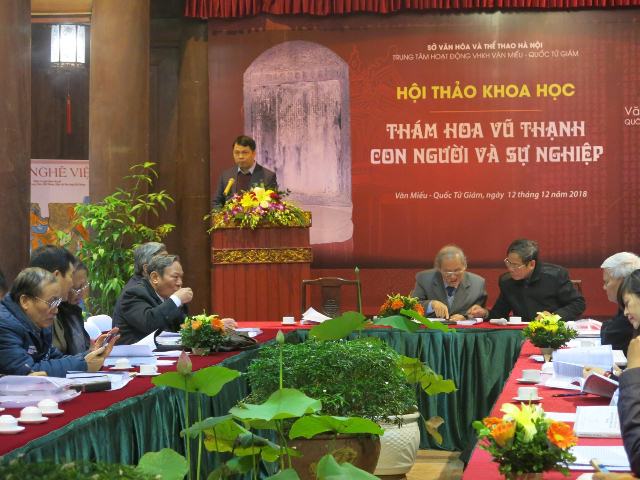
Over 40 years he worked as a mandarin during which he offered more than 30 years of teaching. Teacher Vu Thanh trained many generations of excellent students, many of whom passed the royal exam and held important positions in the court.
In 1698, after resigning, Teacher Vu Thanh opened a school in the Hao Nam (now in Dong Da district, Hanoi). Students from all over the place came to study. Many times the class did not have enough room, students had to borrow bamboo boats to stop by the lake to listen to the lecture. Teacher Vu Thanh always emphasized students' thinking and creativity. He advocated for reform of the style of literature and writing about the practical problems of life.
His name was inscribed on the stele of the 1685 doctoral exam located at Van Mieu-Quoc Tu Giam. /.
Translator: LH
THÂN NHÂN TRUNG, PRINCIPAL OF QUỐC TỬ GIÁM
Thân Nhân Trung (1419 – 1499) was a native of Yên Ninh commune, Yên Dũng district, Hà Bắc province(now Yên Ninh village, Nếnh town, Hà Bắc province). In the reign of King Lê Thánh Tông, He passed the Royal exam held in 1469, and was recognized as a Doctor(PhD). He was the first one to start the examinational tradition of Yên Ninh village. After his success, there were nine other people in the village who passed the Pre-Court competition exams, and three of them were his two sons and one grandson.
Thân Nhân Trung was appointed as “Độc quyển” mandarin (who took in charge of checking the copy of original exam papers). His son, Thân Nhân Tín passed the exam held in 1490 and was recognized as a Ph. Doctor. Thân Nhân Trung held important positions in the court, including Lại Bộ Thượng thư (Minister of Interior) and Head of Royal Academy, Đông các Đại học sĩ, Principal of Quốc Tử Giám.
In 1484, on a King’s order, Thân Nhân Trung composed the text that would be engraved on the stone stele recording the information of the exam held in 1442. As clearly stated in the insription of that stele that: “Virtours and talented men are the primordial vitality of a State. If the vitality is strong, the State will be powerful and prosperous. On the contrary, it will weaken and have a low standing. Therefore, clear – sighted monarchs always attach importance to educating talent and selecting Confucian scholars for the Mandarinate, and regard the fostering of the State’s primordial vitality as an urgent task”. For many years, that statement has become a guideline for Vietnamese education and training.
Thân Nhân Trung temple
In 1495, King Lê Thánh Tông founded the Tao Đàn Poetry Association, then Thân Nhân Trung and Đỗ Nhuận were appointed as Vice Presidents of this Association. He also worked with King Lê Thánh Tông and Nguyễn Trực to compile Thiên Nam dư hạ tập, a great book that took them 10 years to compile. This book fully recorded materials in the field of poetry, literature, classics, laws, wars, civil service system, astronomy, geography, history, which had been produced in the Lê dynasty(from King Lê Thánh Tông and earlier)
Thân Nhân Trung is not only a prestigious and talented mandarin. Moreover, he is also a model educator, an inspiring example of learning to the people in his homeland as well as across the whole country. His words engraved on the stele have become immortal for ever.
BBP
Contribution of Principal Nguyễn Duy Thì to royal exams as an examiner
Nguyen Duy Thi (1571-1651) was born in Yen Lang commune, Yen Lang district, Tam Doi town (now Thanh Lang town, Binh Xuyen district, Vinh Phuc province). When he was 27 years old, he passed the royal exam held in 1598, and was given the academic title Hoàng giáp (under the reign of King Le The Tong). He held many important positions in the Royal Court, and served as Deputy Principal and then Principal of Quoc Tu Giam (School) for many years. He made great contributions to the country's education and exams. In addition, for three times, he was one of the officials who were in charge of organizing exams to select talented people for the nation.
In 1613, he worked as a Court counsellor who was responsible for "inspecting the work of Court officials and consulting with other officials about current affairs. Any officials who did illegal or wrong things were inspected. In addition, he was responsible for checking work of chiefs at departments, and inspecting lawsuits related to noble people in the royal Court. His work helped to maintain the stability and order of the country. Therefore, he was assigned to monitor the exam held in 1613.
Ten years later, when another exam was held in 1623, then he was holding the position of Tả Thị Lang(now similar to Deputy Miniser) of Ministry of Rites taking in charge of work related to rituals, ceremonies, banquets, schools, exams ...,he continued to be trusted by the Court, so he was again assigned to be the Supervisor of the National examination so that the exam could take place in accordance with the court regulations.
During the Royal Exam in 1637, while he was holding the position of Minister of War, and Principal of Quoc Tu Giam School, he was assigned to be the Deputy-Chairman of Board of examiners.
Being an Supervisor of pre-court exams for three times, Nguyen Duy Thi and other officials held high responsibility, helping the court to select 34 Doctors. This has contributed to creating a class of intellectuals and talents in the country. Among those Ph.D., many of them later became important officials of the court. Now, his name is engraved on a stone stele at Van Mieu - Quoc Tu Giam.
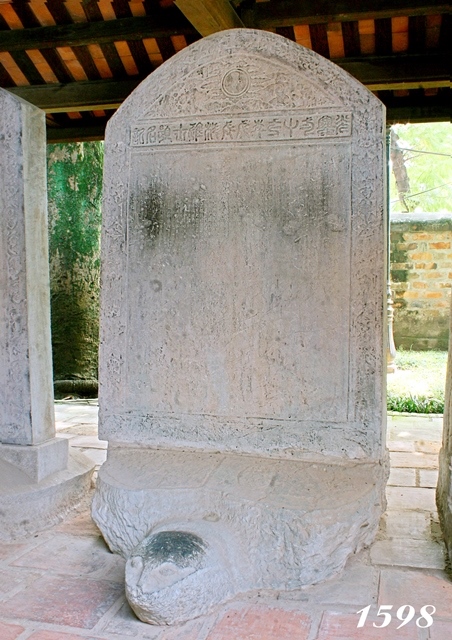
The stone stele that records name of Nguyen Duy Thi
CT
THE LAST TRANG NGUYEN OF HISTORY OF CONFUCIANISM EDUCATION OF VIETNAM
There were 46 Trang Nguyen (the highest rank of doctoral laureate) in the history of Confucianism of Vietnam (1075 – 1919) who were talented and virtuous with their contributions in many fields for a nation. One of them was Trinh Tue, the last Trang Nguyen, who worked as the director of Quoc Tu Giam.
Trinh Tue (1704 -?). He was a native of Vinh Loc district, Thanh Hoa province but he lived in Quang Xuong district, Thanh Hoa province. He passed the exam with highest rank called Trang Nguyen in 1736 under the reign of Le Y Tong King at the age of 33. He was appointed as “Dong cac Dai hoc si quan thiem sai phu lieu” title in 1731. Then he took office as a director of Quoc Tu Giam in 1741 to train talents for a nation.
According to the book “Dai Viet su ky toan thu” , in 1247, the doctoral laureates with the highest scores were divided into three ranks called “Trang Nguyen”, “Bang Nhan”, “Tham Hoa”.At that time, the first doctor passed with highest rank was Nguyen Hien called “Trang Nguyen”. In 1736, the last “Trang Nguyen” was Trinh Tue. Although examinations under the reign of Le dynasty were held continuously, no one was selected to be “Trang Nguyen”. Under Nguyen dynasty from the beginning of 19th century, the King decided to remove “Trang Nguyen” title and from then on, no one was selected as “Trang Nguyen” in Vietnam. Therefore, Trinh Tue was the last Trang Nguyen in the history of Confucianism education of Vietnam.
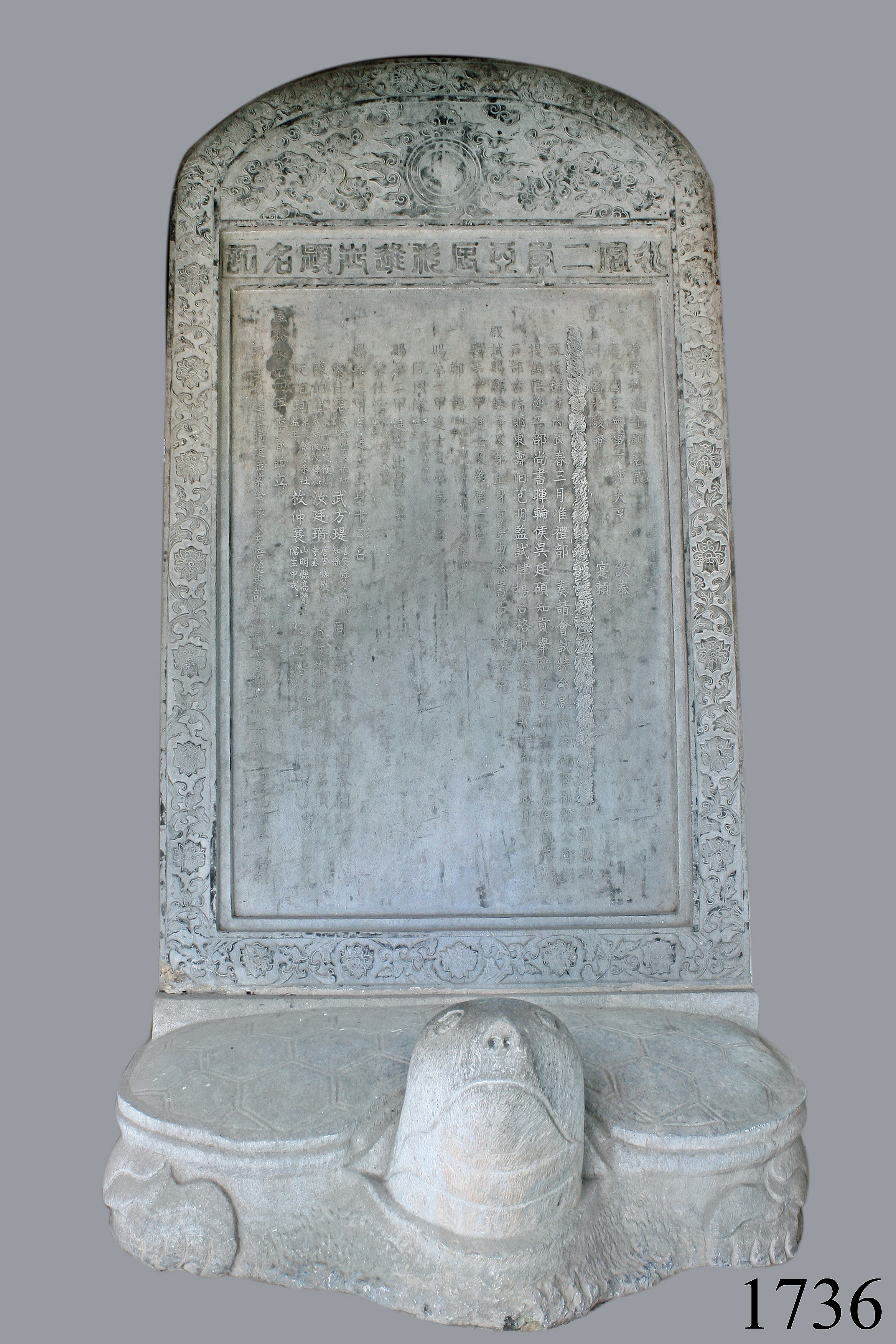
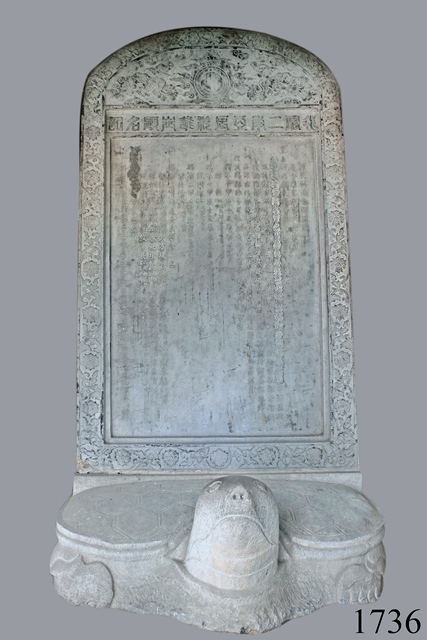
Photo: The stone stele for exam of 1736
Nowadays, his name and homeland are recorded on the stone stelae erected for exam in 1736 at Van Mieu – Quoc Tu Giam. Trinh Tue’s information and his contributions were recorded on the pages of Vietnamese history. He was a bright model for the next generation.
Translator: Bùi Bích Phương
PhD. Trần Cảnh and Agriculture of Vietnam
Trần Cảnh (1684 - 1758) was born in Dien Tri, Chi Linh district (now Truc Truc village, Quoc Tuan commune, Nam Sach district, Hai Duong province). He passed the Royal exam held in 1718 (in the reign of King Lê Dụ Tông). PhD. Trần Cảnh has a lot of things to do with the Quốc Tử Giám school. When he was young, he used to study at this school. Later, he became the Principal of this school. The stone stele that records his name is still preserved at the Special National landmark, Văn Miếu-Quốc Tử Giám.
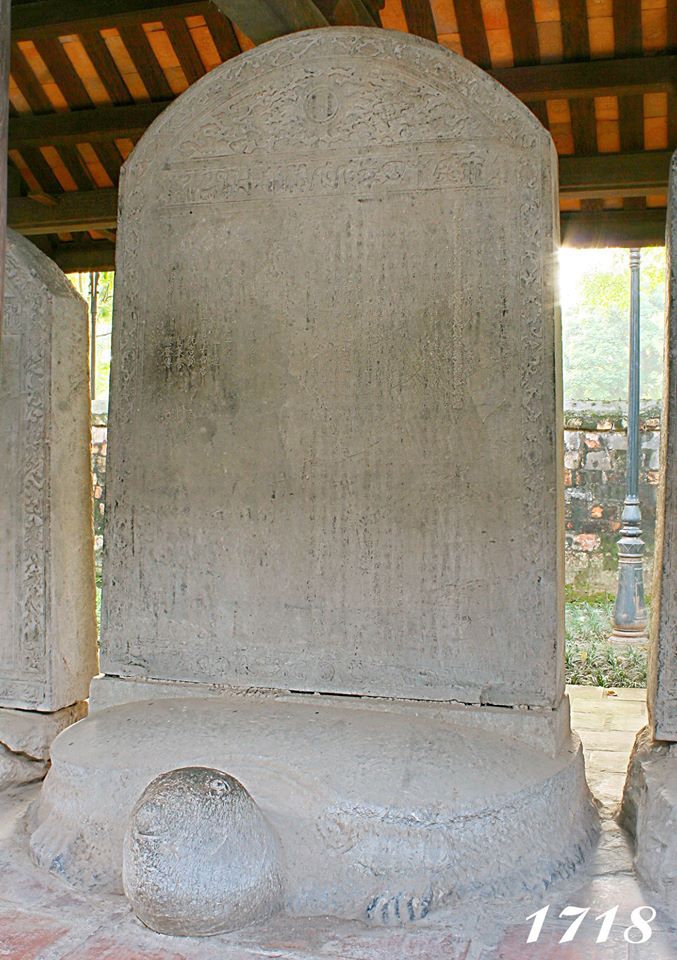
The stone stele that records name of PhD. Trần Cảnh, at the Văn Miếu-Quốc Tử Giám
Having served as a Court mandarin for 40 years, Trần Cảnh held many important positions in the court including Hàn lâm viện Thị chế, Đông các Học sĩ, Governor of Phung Thien district, Principal of Quốc Tử Giám school, Minister of Justice, Minister of War, Minister of Rites.. He had a gift for the agricultural fields, so he was given the task of encouraging agricultural expansion of Nam Sach and Kinh Mon in Hai Duong. Trần Cảnh called upon the people who lived scatteredly in the districts to gather, reclaim virgin soil and establish villages along the Kinh Thay river, from Nam Sach, Chi Linh, Kinh Mon (Hai Duong province) to the Dong Trieu (Quang Ninh province) and Thuy Nguyen (Hai Phong). He was very strict in implementing the land policies issued by the government. By his orders, the land in the areas he managed was redistributed to people
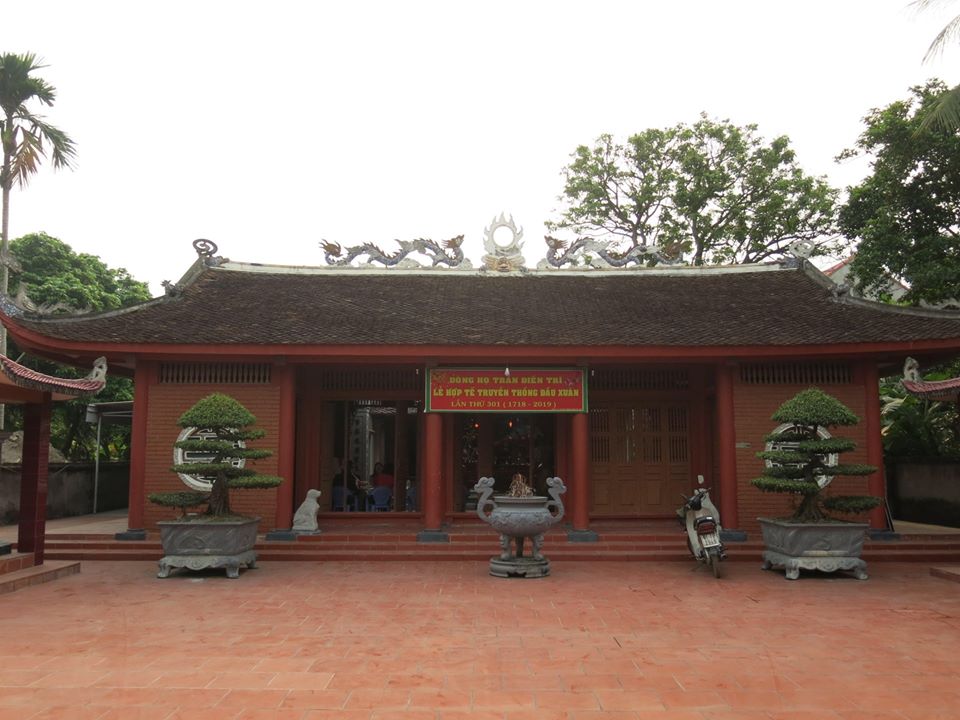
The worship house of Trần family in Hai Duong province
Trần Cảnh also wrote a book about weather, meteorology and farming experience to teach the people of his time. Unfortunately, this book has been lost. For his great contributions to Vietnamese agriculture, PhD. Trần Cảnh is considered as one of the pioneers in the field of agriculture in Vietnam.
CT
Nguyễn Quý Đức(1648-1720)
Nguyễn Quý Đức (1648-1720) was born in Dai Mo commune, Tu Liem district, Hanoi. When he was 29, he passed the Royal examination.
In 1690, he was appointed diplomat to China (in the Qing dynasty). In 1794, he was promoted to Deputy Minister of Rites. In 1695, he was promoted to Imperial Adviser. In 1708, he was promoted to Minister of War. He was an honest mandarin, he forbad his inferiors harassing people. He always felt sorry for the misery of people.
Scientist Lê Quý Đôn wrote about him as follows: "He is a strict, cautious and tolerant man. He held the post of Prime Minister for more than 10 years, always obeyed the law, and appreciated talented people. He was a brilliant Prime Minister when the nation was at peace"
The historian Phan Huy Chú wrote about him: “He was generous and calm. Normally, when he met someone, he was always easy-going . At a discussion, if a problem had not reached a satisfactory conclusion, he tried to keep his opinion, even if it was discussed three or four times, no one could stop him. His literature had deep meanings. Most important documents of the Court were written by him. He was Prime Minister for 10 years as he was highly appreciated for his generosity”.
Nguyễn Quý Đức composed many poems, including two volumes: "Sứ trình thi tập" and "Thi châu tập", but now there are only nearly 90 poems left, which are written in both Chinese and Chinese-Transcribed Vietnamese.

Statue of Nguyễn Quý Đức
Content: Collected
Translator: CT
General Nghiêm Kế’s Temple
General Nghiêm Kế's Temple is located in Gieng hamlet, Quan Do commune, Yen Phong district, Bac Ninh province. In particular, the temple is also the place to worship two famous scholars, Nghiêm Phụ and Nghiêm Ích Khiêm.
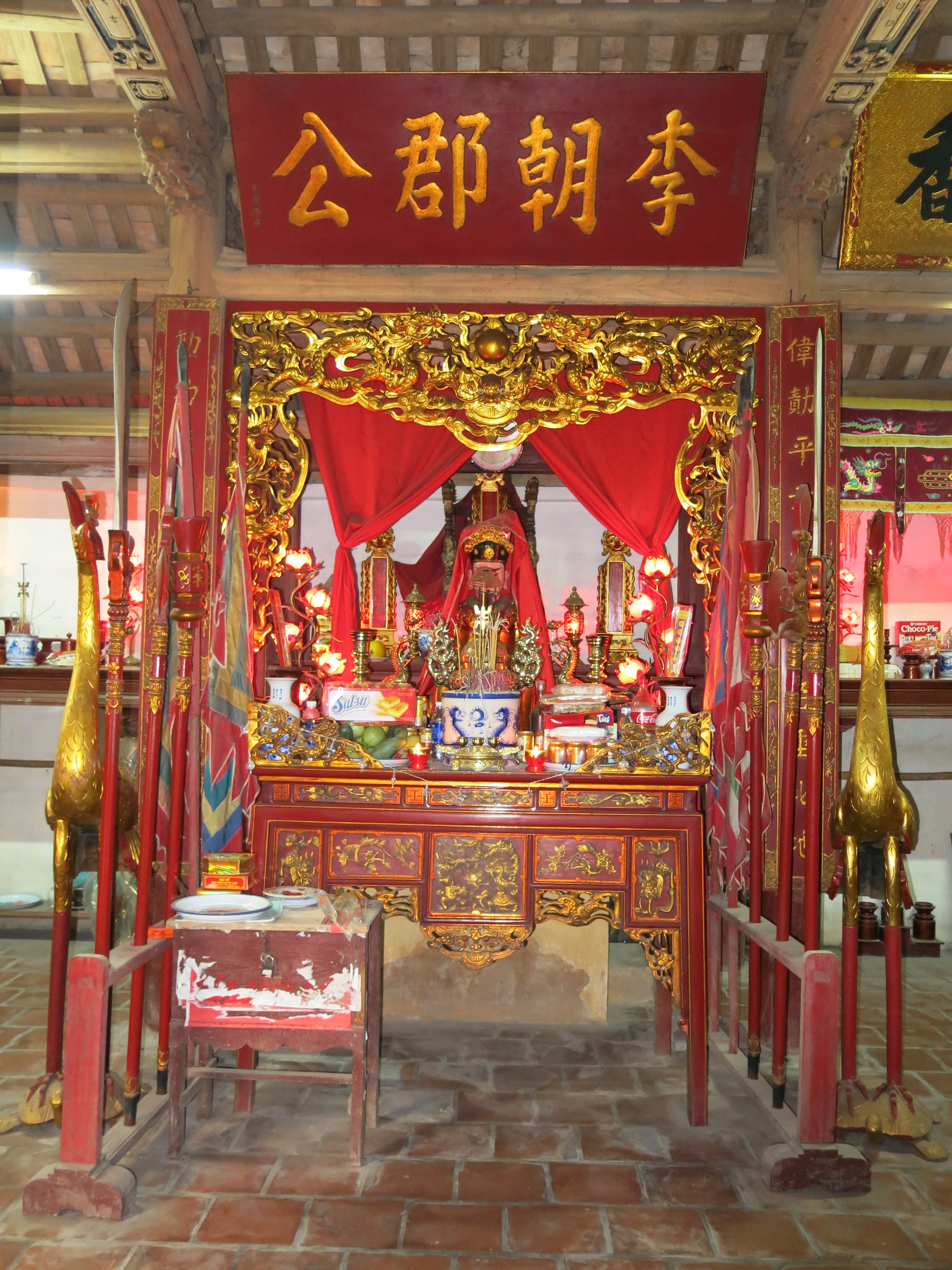
The statue of General NGhiêm Kế
According to the family records of the Nghiem Thi family, Nghiêm Kế belonged to the second generation of the Nghiem family. When the resistance against the Mongols of the Tran Dynasty took place for the first time in 1258, he became one of the generals taking on an important position in the resistance. After the resistance ended in success, he was promoted to general.
The temple is also a place of worship for two scholars: Nghiêm Phụ and Nghiêm Ích Khiêm - Descendants of General Nghiêm Kế. Nghiêm Phụ was born in 1450. In 1473, he took the Local examination and passed four rounds of this exam. In 1478, he passed the Royal examination and was recognized as a Ph. Doctor. After that, he worked as a mandarin in the royal court. Nghiêm Ích Khiêm was born in 1459 and passed away in 1499. In 1490, under the reign of King Lê Thánh Tông, he took the Royal examination and he was second best of the top 3 candidates, so he was given the academic title Hoàng giáp. After that, he became a military mandarin.
The temple was built in the Le dynasty( in the early twentieth century). when a Scorched-earth policy was carried out, the temple was destroyed. When the country was independent, the Nghiem family's descendants rebuilt a new temple on the former ground. Today, the temple consists of such construction items as the three-door gate, Left House, the Tiền tế House and the temple. The worship area includes the Tiền tế House and the temple, which are tile-roofed. Tiền tế House has 5 compartments, this is the place for the meeting and for discussing important events of the Nghiem family.
In 2005, at Tiền tế House, a stone stele was set up to record the history of Nghiem family. The stele has 2 sides, one side is engraved with Chinese inscriptions, the other side is in Vietnamese. The temple consists of 3 compartments, the central area is for the worshipping of Nghiêm Kế, Nghiêm Phúc Tuấn and Nghiêm Yết. The left and right areas are for the worshiping of the ancestors, including two scholars who had passed the Royal examination, Nghiêm Phụ and Nghiêm Ích Khiêm. Behind the altar is a statue of the general Nghiêm Kế. Every year, on the 10th day of the 3rd lunar month, Nghiem family's descendants across the country will gather at the temple to celebrate ancestors’ Commemoration Day
Along with other relics, General Nghiêm Kế's Temple is one of the famous Sites of Quan Do village. On April 20, 1995, this temple was recognized by the Ministry of Culture and Information as a national Site. The temple is of religious and cultural value, contributing to the preserving and promoting of the historical, cultural and artistic value of the country
Writer: Lâm Thùy Ngân
Translator: CT
Hội nguyên, PhD. Nhữ Đình Toản
The Hội nguyên(title given to the best candidate of National exam), PhD. Nhữ Đình Toản (1703 - 1774) was born in Hoach Trach commune, Duong An district, Thuong Hong prefecture, Hai Duong( now Hoach Trach village or known as Vac village, Thai Hoc commune, Binh Giang district, Hai Duong province). He was a famous mandarin in the reign of of the Le King- Trinh Lord. He was born into a family which was famous for a tradition of studiousness, loyalty, and for four successive generations with 5 people passing the Royal exam.
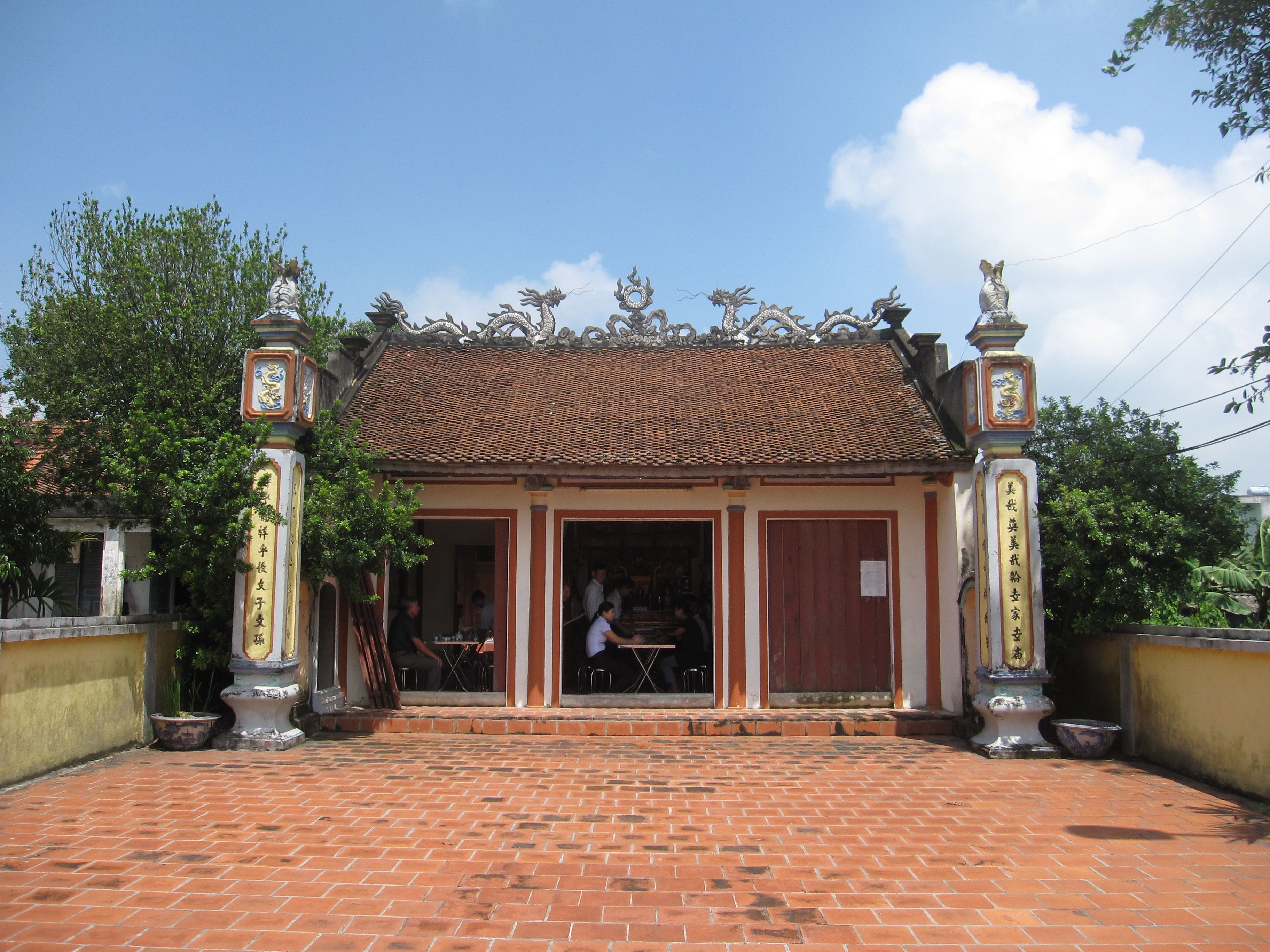
Ph.Dr. Nhữ Đình Toản's temple.
At the age of 34, he came first in the National exam held 1736( in the reign of King Le Y Tong ). The Royal exam held in the same year could select 15 Doctors, and Nhữ Đình Toản was one of the them.
In 1738, Nhữ Đình Toản began his career as a mandarin. For nearly 35 years, working as a military mandarin and civil mandarin, in every position he hold, he also did well; he was well-mannered, so he was highly appreciated by people of his time and also by following generations. Nhữ Đình Toản used to hold many important positions in the court such as: The Great Tutor (1742) and the Minister of the Infantry. Besides, he was trusted by the Lord.
Starting his career as a PhD, Nhữ Đình Toản held many important positions both in the Court and in royal palaces. He was always respected and praised by people of his time as a great mandarin.
Photo, Writer: Minh Thuý
Translator: CT
Great personality Nguyễn Cao
Nguyễn Cao, whose full name is Nguyễn Thế Cao, was born in 1837. His family that is in Cach Bi village, Que Vo district, Bac Ninh province was famous for a tradition of studiousness and outstanding scholars. According to the records of the Nguyen family, the ancestor of the Nguyen family was originally an official of the Le dynasty, his hometown was in Thanh Hoa. He had 6 sons who were mandarins working for this dynasty. Nguyễn Cao belonged to fourth generation of the family
His father was Nguyễn Thế Hanh (1810-1840). When he was 22 , he passed the Local exam, then he became a district Chief. Her mother was Nguyễn Thị Điềm, she was born into a family of high-ranking military mandarins(she was born in Quế Ổ). She was beautiful and virtuous.
Nguyễn Cao lost his parents when he was three, so he lived with his grandmother. When he was ten, his grandmother died, so he soon became self-reliant and studied hard. He was educated by two great teachers of that time: Junior Doctor Nguyễn Phẩm and Hoàng giáp, Ph D. Nguyễn Văn Nghị. The two teachers not only taught him knowledge but also the spirit of patriotism and loyalty.
Nguyễn Cao was not only smart but also hard working. He came first in the Local exam held in Hanoi in 1867. Since then people always respected and called him Thủ khoa Cao(the one came first). When he passed the exam, he did not immediately worked as a mandarin, but went back to his home town where he founded a private school and worked as a teacher.
During the first invasion of the North in November 1873, the French invaders from Hanoi swept to occupy Gia Lam and Sieu Loai. Nguyễn Cao commanded the people of Bac Ninh province to fight against the French, killing many enemies and liberating a large area. When the Nguyen court signed a treaty with the French, he pretended illess as an excuse and then went home. At this time, the Chinese bandits swept into the northern provinces and the mountainous districts of Bac Giang province. They robbed and killed local people cruelly. Nguyễn Cao led the rebellion against Chinese bandits. After that, he was appointed the governor of Yên Dũng district, then the county Chief of Lang Giang. Afterwards, he asked for the permission to go reclaiming virgin soil in the plantations in Nha Nam, Phu Binh, helping local people there.
In 1882, the French colonialists launched an attack on the North for the second time, at that time Nguyễn Cao called on the people to rally their army to fight against the French. In a major battle in Gia Lam, Nguyễn Cao was seriously injured. However, he tried to maintain the position of commander. The Nguyen king gave him 20 taels of silver for treatment. After his recovery, Nguyễn Cao continued to lead the battle against the French, and many other battles in Pha Lai, Yen Dung, Que Duong, Vo Giang, Tu Son, Thuan Thanh, and Ung Hoa district, Ha Tay province.
On March 27, 1887, at a battle in Kim Giang (now Ung Hoa district, Hanoi), he was captured by the French. The enemy tried to seduce and bribe him. However, he refused. Moreover, to keep his uprightness, he committed suicide.
Nguyễn Cao devoted his life to the liberation of the country and the training of talents. His name has been mentioned in history and remembered as a patriot, a leader of the anti-French uprisings, a model teacher, and a great poet.
Nguyễn Cao is truly a great personality of the nation and of his homeland. Streets in Hanoi, Ho Chi Minh City, Bac Ninh City, Bac Giang City and a Secondary School in Que Vo district are named after him. In Hanoi, a temple in Trung Liet is for the worshiping of Nguyễn Cao. In many other places where he went to reclaim, fought and taught people also have temples built. Nguyễn Cao’s Temple in Cach Bi (Que Vo) is recognized by the State as a National historical and cultural Site.
Writer: Trần Thùy Linh
Translator: CT
HOÀNG GIÁP NGUYỄN DUY HIỂU
Nguyễn Duy Hiểu passed the Royal examination held in 1628, (he was the second best candidate of the first-class, so he was conferred the title of Hoàng giáp). His name was engraved on the stone stele at the Văn Miếu-Quốc Tử Giám. After he passed the Royal examination, he work as Hàn lâm viện Hiệu lý. Some months later, he was promoted to Nghĩa Phú tử. In November 1629, he was promoted to Lại khoa Cấp sự trung.
At the end of 1631, according to the Court regulation, those who were descendants of the high-ranking mandarins would be conferred the title of Triều liệt Đại phu, and so he was conferred that title. In less than 2 years, he was promoted to post of Lại khoa Đô Cấp sự trung. About half a year later, he was promoted to post of Ngự sử đài Thiêm Đô Ngự sử.
In 1637, Nguyễn Duy Hiểu went on a business trip to China (Ming dynasty) with Giang Văn Minh and four deputy envoys, Nguyễn Quang Minh, Trần Nghi, Nguyen Bình and Thân Khuê. During this trip, they all died. However, there is no record of Nguyễn Duy Hiểu's death. Today, his descendants still kept a certificate of acknowledment by King Lê Thần Tông, which acknowledged his merit for that mission. The certificate said as follows:
"…He was sent to China in a business trip to pay tributes to China; he completed his mission, then he lost his life while he was still in office….."
It shows that the king and his officials highly appreciated his merit.
We can see that Nguyễn Duy Hiểu is a talented diplomat who made a great contribution to the country and people.
He was also very faithful and upright. For his contributions, he deserves to be remembered by the whole nation for good.

The stone stele that has his name engraved on at the Văn Miếu - Quốc Tử Giám
CT
PHD, DUKE NGUYEN CONG CO
Duke Nguyen Cong Co was one of the typical celebrity of culture in Tu Liem. He was born in 1676 in Xuan Tao village which is now part of Bac Tu Liem district, Hanoi.
Nguyen Cong Cu passed the exam to become doctoral laureate in 1697 under the reign of Le Hy Tong at the age of 22. Nowadays, his name and hometown are carved on the stone stelae at Van Mieu – Quoc Tu Giam, Hanoi .
After becoming the doctoral laureate, Nguyen Cong Co was appointed to be Hanlin Editing Clerk. In 1704, Trinh Luan, Trinh Phat, Dao Quang Nhai plotted to rebel, The incident was investigated and Nguyen Cong Co reported the findings to the King. The King ordered them to be punished and promoted Nguyen Cong Co to be Deputy Minister.
Nguyen Cong Co was sent to be chef envoy to tribute Thanh empire in China in 1715. A year later, Nguyen Cong Co and his delegates returned their hometown to tell Vietnamese King about the imperial edict of Thanh in China. The Chinese King ordered gold bars and sliver bars to be used for offeringsinstead of items and ivory and rhino horn. Afterwards, Nguyen Cong Co was promoted to Minister of National Defence.
In 1720, the court carried out an investigation into the contributions of mandarins for the last 10 years. Nguyen Cong Co was ranked among the best and promoted to “Cao Quan Cong and Tham tung”title at the age of 46
Nguyen Cong Co was an upright mandarin who told the king to reorganize the Huong exam after he found mistakes in the arrangement for Huong exam. The king decided to promote Nguyen Cong Co’s title. He passed away in 1733
There are some literacy pieces and poems in Han writing recorded in “Toan Viet thi luc” book.
The house of worship of Nguyen Cong Co located in Xuan Tao village (Bac Tu Liem district). This area used to be the salt warehouse of the court. After his death, the court endowed families of Nguyen Cong Co with this area to build a temple to honor him here.
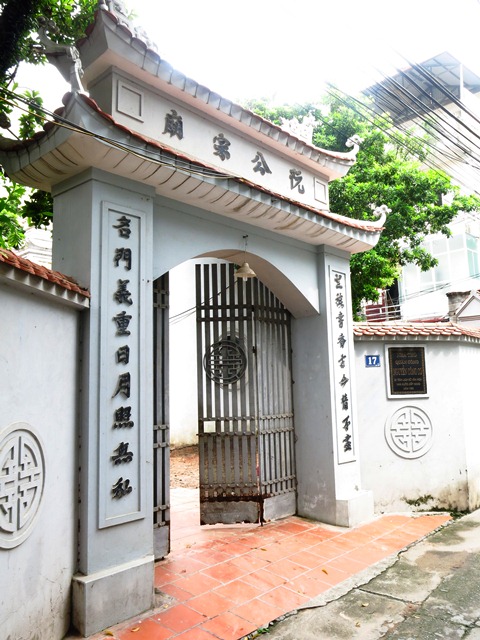
Photo: The main gate of the house of worship of Nguyen Cong Co
The house of worship was founded 300 years ago. In 2008, the house of worship was reconstructed to include a main gate and the house of worship. The main gate was built simply with double floor and eight separate roofs of dragon scale – shape tiles. The ground from the main gate was paved with Bat Trang brick and three step staircase
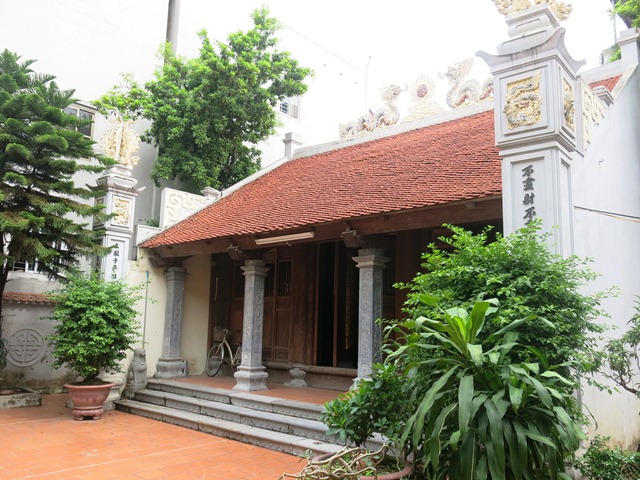
Photo: House of worship of Duke Nguyen Cong Co
The house of worship was designed with three sections. The section is the most important section with an altar of Duke Nguyen Cong Co and twoWorkpalanquin given by King. There are horizontal lacquered boards hanging in the house of worship which praise Nguyen Cong Co’s contributions to a nation. Certificate of Cultural historical site 1993 and the board recording Duke Nguyen Cong Co’s life and his career are hung on the remaining two sections.
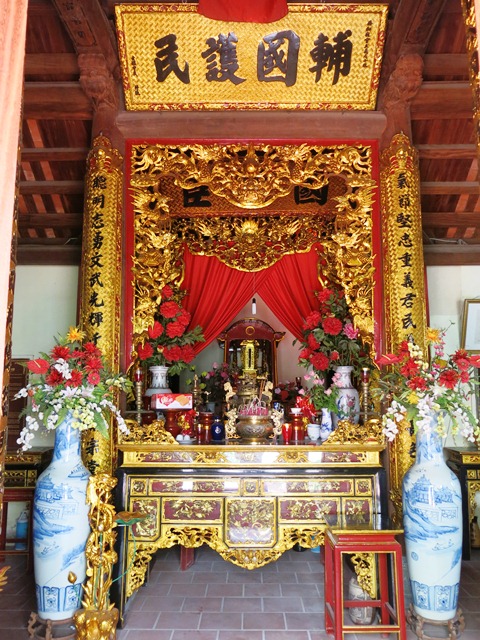
Photo: The altar of PhD, Duke Nguyen Cong Co
Nguyen Cong Co’s life and his career was recorded in historical documents such as Dai Viet su ky tuc bien, Kham Dinh Viet su thong giam cuong muc, Dang khoa luc...He was an upright and clear – sighted man who was envied by many.
Nguyen Cong Co was a founder of examination tradition of Nguyen families in Cao village. Every year, on 23 October of Lunar calendar, Nguyen Cong families hold offerings to commemorate the anniversary of Nguyen Cong Co’s death
Writer and photographer: Thu Hang
Translator: BBP
PHD TRAN CONG XAN
Tran Cong Xan (or Tran Cong Thuoc) lived Khoai Chau district, Hung Yen province. In 1772, he passed exam with the third rank at the age of 42. PhD Tran Cong Xan hold office as many important positions of management board of court.
In 1787, Tran Cong Xan and his delegates were sent to Tay Son as King’s envoy to demand Nghe An to be given back. However this mission was not accomplished. Delegation was incarcerated then they were released and drowned while returning their hometown.

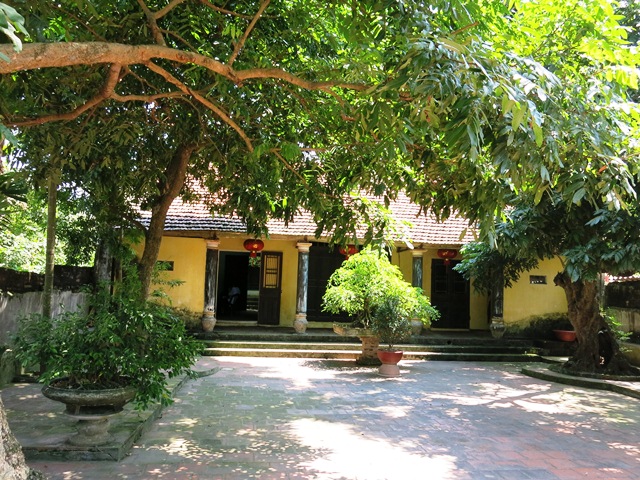
Photo: The temple of PhD Tran Cong Xan
According to village elders’narration, after returning hometown with his glory. Tran Cong Xan and local leadership founded small temple to honor Sage and encourage good traditions in the younger. Now, legend of PhD Tran Cong Xan was recorded in two books in Han writting at Institute of Han Nom studies
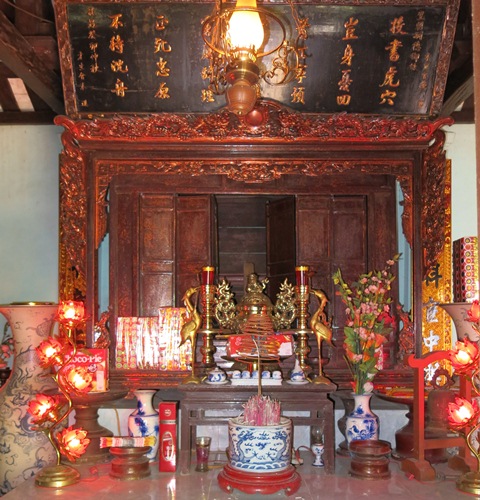
Photo: The altar of PhD Tran Cong Xan
The temple of PhD Tran Cong Xan was built in 1997 including front house and rear house with 5 sections. Distance between front house and rear house is a small ground.
In the middle of rear house is the altar with ancestral tablet of PhD Tran Cong Xan, Some relics were kept at the temple such as horizontal boards, parralle sentences praising PhD Tran Cong Xan. Especially, and ordination of PhD Tran Cong xan under the reign of Nguyen was kept at the temple.
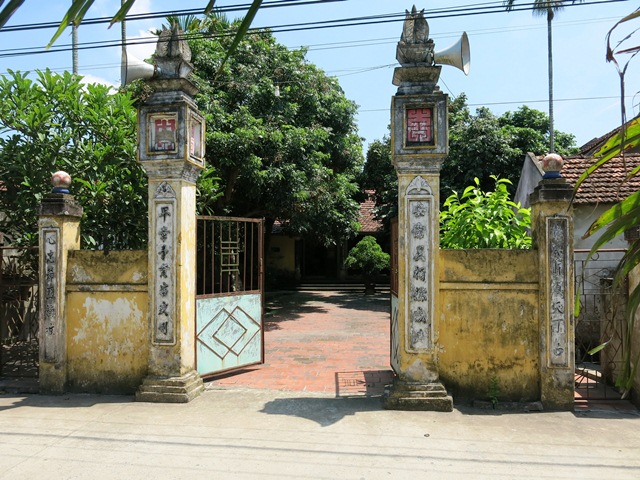
Full name and hometown of PhD Tran Cong Xan engraved on stone stele for examination in 1772 at the Special National Relic Van Mieu – Quoc Tu Giam (Hanoi) and the stone stele at the Xich Dang temple (Hung Yen province)
BBP
HEADMASTER OF QUOC TU GIAM NGUYEN BA LAN (1700 – 1785)
Nguyen Ba Lan was born in 1700 and grew up in a family of traditional fondness for learning at Co Do village (Ba Vi district, Hanoi). He was not only a big author of medieval literature but also a teacher with many contributions to training talents for a nation.
Co Do village was well known as the village of literature , that is the reason why villagers were always proud of the traditional fondness for learning. Nguyen Ba Lan's father was Nguyen Cong Hoan who had a deep understanding of literature literature. It was said that Nguyen Cong Hoan was a talent of literature but did not succeed in exam. He travelled to many areas to teach students, including his15 year old son, Nguyen Ba Lan, who had a strong comprehension and knowledge of literature. In 1731, at the age of 31, Nguyen Ba Lan passed Dinh exam with the first rank .
.After successfully completing his exams, Nguyen Ba Lan was given the title Giam quan by the king in 1737. This recognition by the king opened up opportunities for Nguyen Ba Lan to do great things for the nation.
With love for people, responsibility for country’s border area, Nguyen Ba Lan, Ph.D. completed his mission excellently andwas respected and loved by people.
In 1756, he was appointed as headmaster of Quoc Tu Giam. This was the most successful and important period of Nguyen Ba Lan’s career. Quoc Tu Giam was an education center for thenation, which meantheadmasters were high-ranking mandarins. Headmasters had to take care of incense offerings twice a year (Spring and Autumn) and manage training and studying at Giam. Another important mission of the headmaster was the evaluation of the talents and virtues of students, in order to recommend the talented to a nation. During his time as a headmaster of Quoc Tu Giam, Nguyen Ba Lan always paid attention to students’ study and evaluated students truthfully.
There were many excellent students whom passed the exam who were trained by Nguyen Ba Lan, includingPham Nguyen Dat, and Phan Khiem Thu. In 1770, Nguyen Ba Lan retired.. The king ordered him to live near the imperial to offer opinion in cases of national business
In 1772, Nguyen Ba Lan was reinstated in the position of leader to organize and control education and examination, selecting the talents for a nation.
Nguyen Ba Lan passed away in 1786 at the age of 86. Nguyen Ba Lan was not only intellectual with wide range of knowledge, he also was upright and straight man, who always contributed to a nation with his soul and body.
Nguyen Ba Lan was a famous mandarin with great dignity, worthy of bright example to future generations.
Translator: BBP
HISTORICAL DOCUMENTS RECORDING HEADMASTER VU MIEN
Vu Mien (1718 – 1782) was appointed to official under the reign of Le Hien Tong in the second half of 18th century. He grew up with family of acedamics in Lang Tai district, Bac Ninh province. He worked as a minister of the nation that recorded many historical datas.
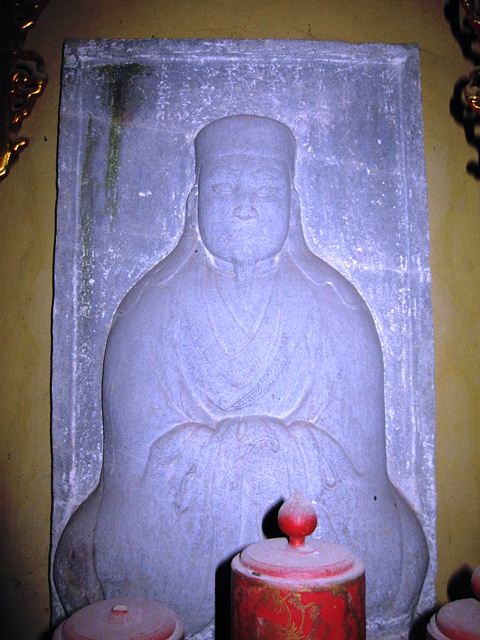
Photo: Vu Mien's statue in the house of worship
Vu Mien’s information was recorded in detail on the stone erected in 1782. Vu Mien was born in 1718. When he was 15, he studies at his local district school, then at age 18 he began his studies at Quoc Tu Giam At the age of 31, he passed Hoi exam with highest scores.He was appointed to chancellor.
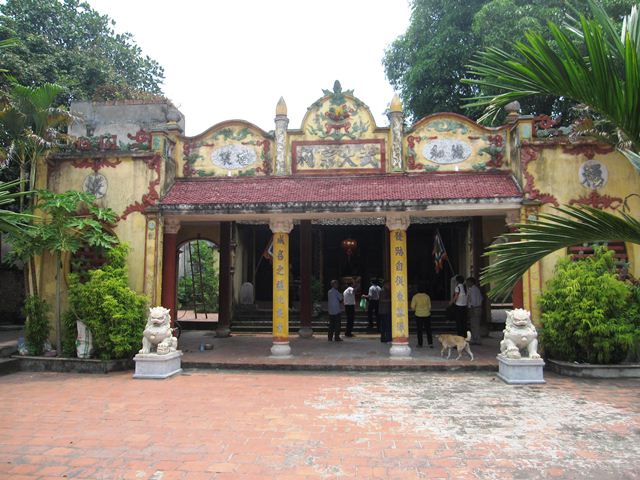
Photo: The house of worship of Vu Mien
Vu Mien passed exams to reach the rank of doctoral laureate in 1748. This information isengraved on stone stele at Van Mieu – Quoc Tu Giam and “Kim bang luu phuong” stone stele at Van Mieu in Bac Ninh.
After succeeding in exams, he worked as an official under the reign of Le – Trinh. His titles were written in “Dai Viet su ky tuc bien” book and “Kham dinh Viet su thong giam cuong muc” book in detail.
When he worked as a consul at the national historiographer’s office, he chaired to compile “Quoc su tuc bien” book with 6 books concerning situations from 1676 to 1739. Then Vu Mien and Nguyen Hoan, Uong Si Lang, Phan Trong Phien compiled “Dai viet lich trieu dang khoa luc” in 1779 recording the list of successful doctoral laureates with their ranks and passed exams from 1075 to 1787
Vu Mien was a loyal man who always contributed to his nation wholeheartedly. Vu Mien is regarded as both a scholar and a warrior who had a glorious career in politics and the army, provided many contributions to politics, as well as, stabilized situations on the frontiers.
Translator: BBP
DUKE NGUYEN NGHIEM (1708-1775)
Nguyen Nghiem (or Hy Tu) was a native of Nghi Xuan district, Ha Tinh province. He was a famous scholar with high glory and not only virtue in favour with the court, but he was respected as Khue constellation and Dau constellation.

The horizontal board “Co kim nhat nguyet” (Like the sun and the moon shining through time – past and present)
Nguyen Nghiem’s family had many contributions to examination tradition of Nghi Xuan. His younger brother was Nguyen Hue who passed philosophy exam in 1733. His son was Nguyen Du who a preeminent poet respected as a World Cultural Personality with “Truyen Kieu”
When he was a child, Nguyen Nghiem was so smart and fond of study and at the top of a list of successful candidates in exams. After passing Huong exam 1723, Nguyen Nghiem studied as an official student in Quoc Tu Giam in 1724. He got high marks in the essays which displayed notice on Thai Hoc gate (giving names of successful candidates in examination). In 1731, Nguyen Nghiem passed Dinh exam with second rank (Hoang giap) as the youngest candidate of that exam.
After that, Nguyen Nghiem took office as a literacy official, then he was appointed as many to many significant positions. In 1761, Nguyen Nghiem was appointed as a headmaster of Quoc Tu Giam. He retired at the age of 64. In 1774, Trinh Sam king recalled him to be Minister of a nation. Nguyen Nghiem passed away at the age of 68.
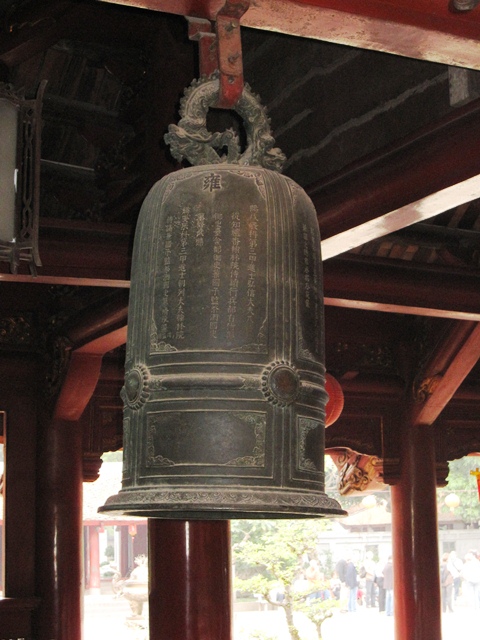
Photo: Bich Ung bell
When Nguyen Nghiem worked as headmaster of Quoc Tu Giam, he ordered the horizontal board “....” and 4 small bells and Bich Ung bell to be made and put aside. Nowadays, only the Bich Ung bell and the horizontal board hang at House of Ceremony at Van Mieu – Quoc Tu Giam of Hanoi. While students make offerings to honor Sage and Saint, Bich Ung bell is rung.
Nguyen Nghiem was also famous author with valuable works on many subjects including two texts engraved on the stone stelae erected in 1760 and 1766.
High ranking Duke Nguyen Nghiem was a smart and diligent man, skilled in strategy and appointed to many important positions. He always put his attention to the country’s fate. With his career in training students, Nguyen Nghiem recognized his responsibility clearly for development of study of a nation. Therefore, he summoned up all his strength and love for students at Quoc Tu Giam when he worked as a headmaster of Quoc Tu Giam. His contributions to Van Mieu - Quoc Tu Giam and culture of a nation were extremely great.
Collect and edit: Mai Ngan An
Translator: BBP
HEADMASTER OF QUOC TU GIAM NGUYEN TRI VI (1670 -1744)
Nguyen Tri Vi was born in 1670 at Son Dong village, Hoai Duc district, Hanoi city. Son Dong was a well – known land with long-lasting tradition of fondness of study, including 20 families with 8 doctoral laureates and Nguyen Tri family among them with PhD Nguyen Tri Cung and Nguyen Tri Vi.
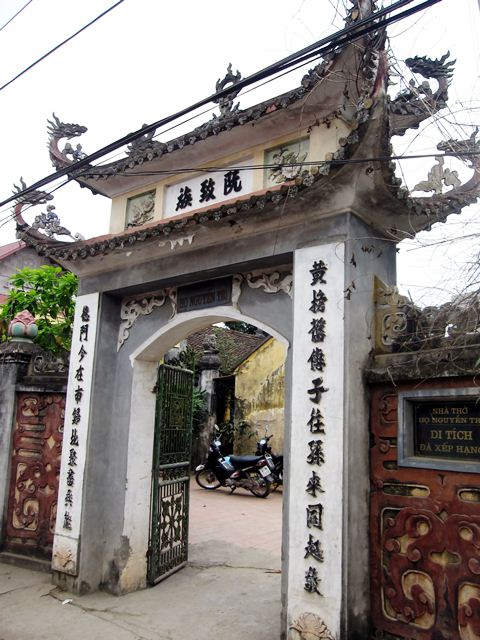
Photo: The main gate of the house of worship of Nguyen Tri Vi at Hoai Duc district, Hanoi city
Nguyen Tri Vi was a studious person. He and his cousin, Nguyen Tri Cung, were both received doctoral laureates after exams.
Nguyen Tri Vi took exam in 1703, reached third rank, took it again in 1710, passed with same third rank and took again in 1712 and passed with same third rank. His title and homeland were engraved on stone stele at Van Mieu – Quoc Tu Giam. After that, the king conferred a title on Nguyen Tri Vi to praise for successful exams, appointed him to be supervisor of court counsellor of Hai Duong. In 1714, he received a promotion.
Nguyen Tri Vi was a dedicated official, and highly appreciated highly by the king. The kingrecalled Nguyen Tri Vi to the imperial court and appointed him “Han lam vien dai che” with theresponsibility for editing administrative documents.
In 1737, he was appointed to Headmaster of Quoc Tu Giam, one of the most important officials for the education and training of virtuous students for the nation
As headmaster of Quoc Tu Giam, he took responsibility for thecare of Van Mieu, and ratedthe progress of students’ studies equally as a base to be nominated for a position. Nguyen Tri Vi fulfilled his responsibility as headmaster and contributed to and developed education for the nation.
During his time as a public official, Nguyen Tri Vi remained a virtous and talented individual who contributed to the nation and fostered the will of future generations. In 1716, he contributed the effort to build Van Mieu in Dan Phuong, where he compiled the text engraved on “Van Mieu Dan phuong huyen but ky” stone stele at Van Mieu in Dan Phuong. This text is important to scholars because it provides history aboutNguyen Tri Vi, as well as, informing us about Van Mieu in the districts, cultural life and ethics ofVietnamese villages in the beginning of the 18th century.
Nguyen Tri Vi passed away in 1743 in his homeland at the age of 74. The King conferred two titles on him and 500 cents for funeral and 200 cents for offerings every year. With his contributions to a nation and development of culture of Dan Phuong, he has eraned his place in history as a great scholar andteacher of Dan Phuong
Translator: BBP
THE HEADMASTER OF QUOC TU GIAM NGUYEN CONG THAI (1684 – 1758)
Nguyen Cong Thai was born in Thanh Tri district, Hanoi city. Kim Lu commune was well – known with tradition of fondness of study and exam in Thang Long. Nguyen Kim Lu was a member of one of the famous families with many doctoral laurates who served the nation in positions of high leadership, such as Nguyen Cong Thai, Nguyen Sieu, Nguyen Trong Hop...
When he was a child, Nguyen Cong Thai, was a smart person and good at studying. He passed Huong exam in 1702 at the age of 18. In 1715, he passed exam with the third rank and was appointed to supervisor of Court counsellor.
In 1733, Nguyen Cong Thai was pormoted to Vice Minister. He made many contributions to the nation and received more promotions.
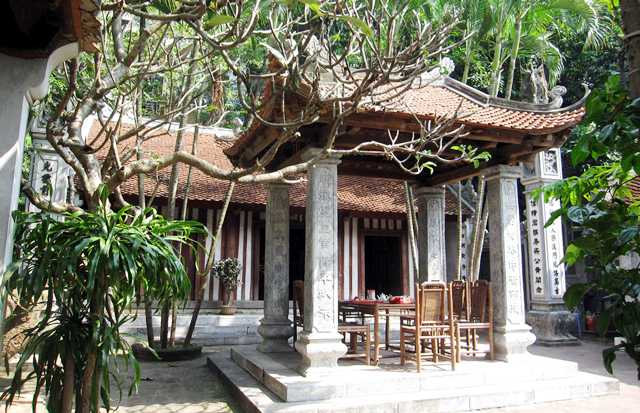
The house of ceremony of Nguyen Cong Thai, Hoang Mai district, Hanoi city
Nguyen Cong Thai undertook many different positions over his 40 year career. In 1728, he was appointed to headmaster of Quoc Tu Giam, where he contributed to the development of education and training of talents for the nation.
Nguyen Cong Thai not only was a public official but he was also an author. He compiled seventexts engraved on stone stelae at Van Mieu – Quoc Tu Giam and Chu Van An’s temple praising the spirit of tradition of honouring teachers and sharing his knowledge, and fostering a tradition of fondness of study
Năm 1717, Nguyễn Công Thái là người soạn văn bia Văn Trinh công Từ bi kí(2) cho Miếu thờ Chu Văn An tại xã Huỳnh Cung tổng Cổ Điển huyện Thanh Trì (Hà Nội).
In 1717, Nguyen Cong Thai compiled text for Chu Van An’s temple at Thanh Tri district, Hanoi city.
Nguyen Cong Thai compiled7texts engraved on stone stelae at Van Mieu – Quoc Tu Giam.
Text engraved on stone stele, family annals are real evidence of the importance of Nguyen Cong Thai as well as an example of highly valuable heritage of a nation. He was a famous official, and scholar in the 18th century. Nguyen Cong Thai’s life and career is an example for future generations. He earned his place in history as a famous scholar, and remains the pride of Kim Lu villagers in Hanoi as well as all of Vietnam.
Translator: BBP
HEAD MASTER OF QUOC TU GIAM – PHUNG KHAC KHOAN (1528 – 1613)
Phung Khac Khoan lived in Bung village, Thach That district, Hanoi . It was said that he was Nguyen Binh Khiem’s half-brother on Nguyen Binh Khiem’s father’s side. Phung Khac Khoan was well-known with his knowledge of literature and divination but he did not participate in any exams and worked as mandarin under the reign of Mac dynasty.
Under the reign of Le Trung Tong, Phung Khac Khao followed and aided Le Ba Ly to liquidate Mac dynasty. He passed Huong exam with the first rank in Thanh Hoa at the age of 29 then he worked as a leader, taking responsibility for the army and the people of the nation,and attended important and secret business at Ngu dinh of Trinh Kiem.
In 1580, Phung Khac Khoan participated in Hoi exam with the second rank (Hoang Giap) then he was appointed as mandarin under the reign of Le The Tong.
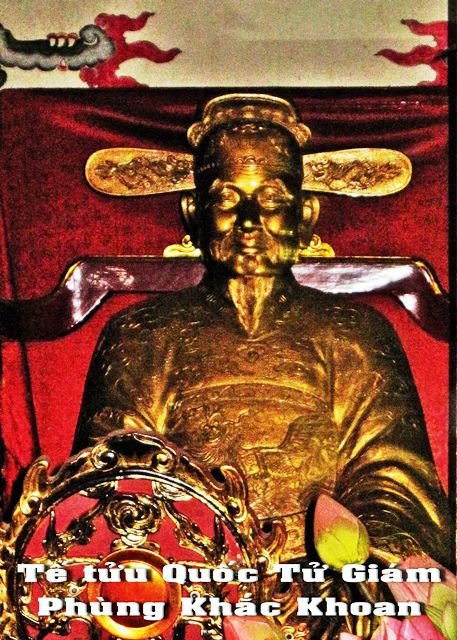
Phung Khac Khoan was an excellent politician and diplomat. Although he lived in a period of domestic struggles, he always demonstrated the duties of a Vietnamese scholar. He was good at diplomatic relations, and protected national prestige earning the respect of the Chinese King.
Phung Khac Khoan authored many literary works which showed his passion, spirit and concern as a patriotic scholar. Over 500 remaining poems and letters in Han and Nom writing illustrate the confidence of Phung Khac Khoan as a person who wanted to repair the virtue of a fallen society. His poems in Han writing were standard and model and his poems in Nom writing were simple leaving a mark on Nom Vietnamese poetry.
Phung Khac Khoan was not only famous author but he was also a responsible teacher for people and the nation. When he worked as a headmaster of Quoc Tu Giam, he played a role as an officiating priest to train talents for a nation wholeheartedly. When he retired, he opened private school called “Hoang dao thu duong” to teach people with his friends, to share literature and enlighten people’s minds. He also built Nhat Tien Kieu and Nguyen Tien Kieu at Thay pagoda to make sightseeing of the village more beautiful. According to a legend, he also taught villagers how to plough and dig a ditch, plant and knit to provide a life of comfort.
Phung Khac Khoan was a talented teacher, expert of culture and diplomat in the 16th century. He was respected by Trinh Tung king and call Sir Phung. In order to commemorate Phung Khac Khoan’s contributions, people honor him as Trang Bung ( a doctoral laureate with highest rank of Bung village). Phung Khac Khoan passed away in 1613 at the age of 86 and is honoured at his temple located in his hometown.
Writer: Hoàng Thị Tuyết Hương
Translator: BBP
NGO SI LIEN – DEPUTY HEAD OF QUOC TU GIAM
Ngo Si Lien was born in Chuc Ly village, Chuong My district, Hanoi . Unfortunately, historians are uncertainwhen Ngo Si Lien was born. Ngo Si Lien took part in Lam Son struggle to rise up in arms with Le Thai To leader to fight Minh invaders from China. Oncethe nation was independent, the Le Dynasty was founded . In 1442, Le Thai Tong opened the first examination under the reign of Le Dynasty to seek out talents to support the administration board. There were 450 examinees and 33 doctoral laureates among them. Ngo Si Lien passed exam with the third rank called doctor, then his name written on the stone stele at Van Mieu – Quoc Tu Giam.
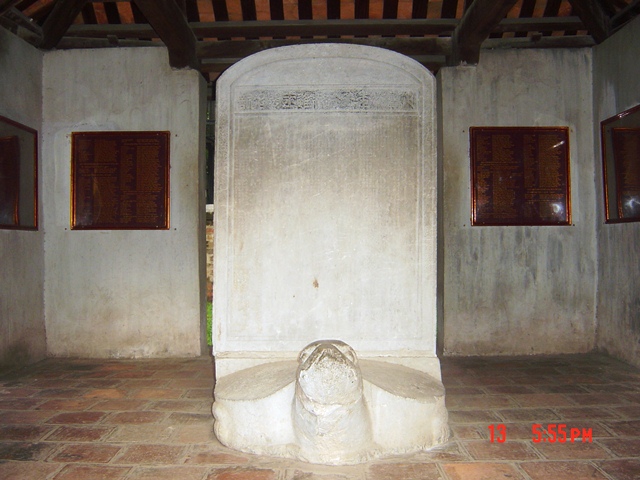
After Ngo Si Lien passed the exam with the third rank, he was appointed to many official roles at the court. Under the reign of King Le Thanh Tong , Ngo Si Lien was tasked with the responsibility for compiling history of National Institute of Historical Research. There was many condition to be a historian such as: talent, knowledge, and learning aptitude. King Le Thanh Tong recognized Ngo Si Lien’s talent, virtue and true worth and selected him to be an official of history. After eight years, the book series of “Dai Viet su ky toan thu” (national history) was completed.
The national history series compiled by historians includes writings by Ngo Si Lien. The series includes 15 books broken into two parts; Part 1 with five books recording historical situations from Hong Bang to the end of 938; Part 2 with 10 books from 938 to 1428. A bonus part was new, which was compiled by Ngo Si Lien recording historical situations from Hong Bang to the end of An Duong Vuong – the first period of history was recorded and recognized as a national history.
Ngo Si Lien was honored as a teacher of historian with wonderful intelligence and strong patriotism by his comments during compiling events, characters as well as his method of compiling historical events
“Dai Viet su ky toan thu” by Ngo Si Lien was the first complete series of national history at the present. This document iss indispensable to researchers of history, culture and education. It is a precious cultural heritage of Vietnam.
Ngo Si Lien not only contribute to history, but he also worked as a teacher with his achievements for education of a nation. While he was working as a historian at the National institute of Historical Research, he also worked as a deputy head of Quoc Tu Giam. He was responsible for the teaching program at Quoc Tu Giam under Le Thanh Tong.
Nearly 30 years under the reign of Le Thanh Tong, education and examination of Vietnam were developed, offering12 examinations to select 500 successful candidates.
In 1478, Ngo Si Lien played a role as an examiner to compare original exam with copy of original exam paper (when a candidate finished his exam, it was stamped and rewritten by the examiner in case his teacher recognized his exam and correctedit. After that, another examiner read again to compare the copy to the original exam).
Ngo Si Lien passed away in his hometown. Villagers built a house of worship to honor him in August of Lunar month, unfortunately, house of worship of Ngo Si Lien no longer exists. His name and tittle are immortal on the stone stele, streets, a school in Hanoi and in the nation. He is remembered as an important educator, historian and a scholar of Hanoi.
MA. Lê Thị Thu Hương
Translator: BBP
NGUYEN TRUC – HEADMASTER OF QUOC TU GIAM (1417 – 1473)
Nguyen Truc was born in 1417 and local of Thanh oai district, Hanoi city. He was a person of good lineage with examinational tradition. According to legend, he was a child prodigy, understood thoroughly classics and history, fond of poems at the age of 12. He passed Huong exam with the first rank at the age of 18, passed Dinh exam in 1442 with the first rank called Trang Nguyen. He was the first Trang Nguyen under the regin of Le dynastyy then his name was recorded on stone stele at Van Mieu – Quoc Tu Giam.
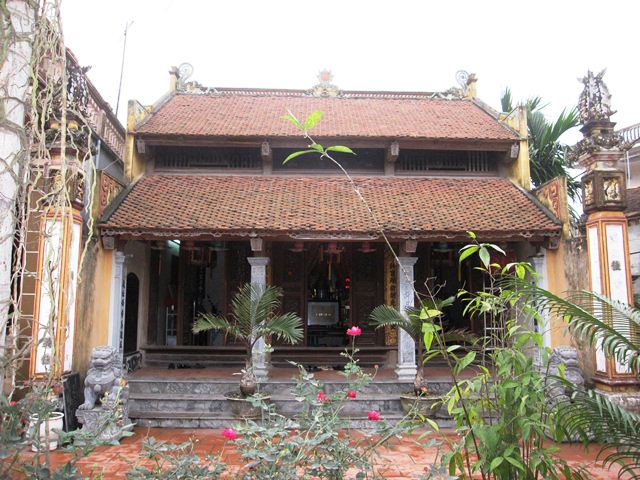
Photo: The house of worshipping of Nguyen Truc in Thanh Oai district, Hanoi city
Nguyen Truc contributed his knowledge and talent to support King and aid his nation. Nguyen Truc was sent as King’s envoy to China, he was repected by Minh dynasty in China with his talented repartee and commended as a Trang Nguyen of China and Vietnam. He was a well – known poet, a member of Tan Dan group who respected by king and subjects. It was said that Le Thanh Tong king always sent his new poem to Nguyen Truc to read before reciting a poem.
Nguyen Truc was not only upright mandarin, excellent politican but he was alo eminent educator of a nation.
HISTORICAL DOCUMENT ABOUT
THE 2ND CLASS DOCTORAL LAUREATE NGUYEN DUY THI
Nguyen Duy Thi, a famous Vietnamese scholar, was born in 1572, in Yen Lang commune, Yen Lang district (now Thanh Lang town, Binh Xuyen district), located in Vinh Phuc province.
Nguyen Duy Thi passed Mau Tuat exam in Quang Hung 21 (1598) and received the 2nd class grade when he was 27 years old. This information was recorded in many historical books. Contents of the nomination in 1651 (currently kept in the family ancestral house of worship), Đại Nam nhất thống chí, Complete History of Great Viet states that Nguyen Duy Thi died in 1651, at the age of 81 years old. After his death, he was given the name Hanh Do, and awarded the title Thai te.
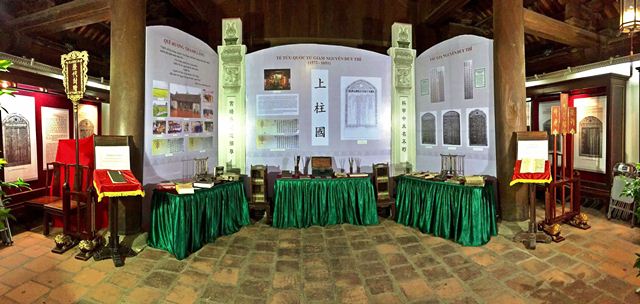
Photo: Exhibition about the career and life of Nguyen Duy Thi at Van Mieu – Quoc Tu Giam
For more than 50 years as a mandarin, through Historical documents such as Lịch triều hiến chương loại chí, Khâm định Việt sử thông giám cương mục (Complete History of Great Viet), provide details about the 50 years Nguyen Duy Thi spent as a manadarin. In addition, he was appointed as: Minister of Construction, Minister of Military Affairs, and Minister of Interior.
He was also appointed many other positions in the fields of diplomacy, culture and education such as Te Tuu Quoc Tu Giam (director of the first University), a position he held for over 30 years (about 1620 to 1651); Examination Supervisor of Hoang Dinh 14 (1613) and Quy Hoi exams in Vinh To year (1623); and The Second Examiner of Duong Hoa 3 exam (1637). These events are recorded in the nomination of the Nguyen Duy family in Thanh Lang and the three steles of the three examinations are now kept at the Temple of Literature
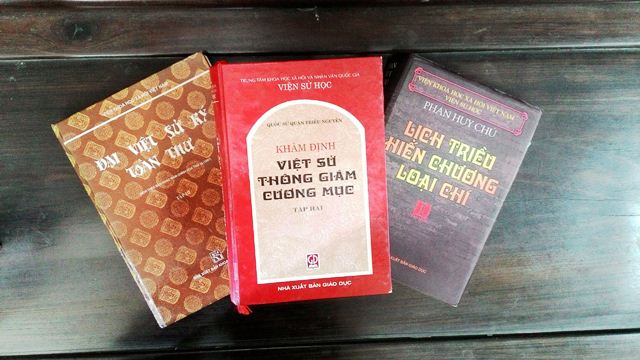
Photo:Historical books recorded about career and life of Nguyen Duy Thi
Only three of his works remain, which can be found on rubbed copy which are kept at the Institute of Sino-Nom studies. Two poems in Chinese titled Bạc chu Bành Thành ngộ tuyết thứ Chánh sứ Nguyễn Phác Phủ vận và Bành Thành hoài cổ họa Chánh sứ Nguyễn Phác Phủ , were written on the way to the Ming dynasty in 1606, and recorded in Toàn Việt thi lục (a collection of Chinese poetry of Viet Nam).
Translator: Thu Huong
The temple of Mandarin Nguyen Duy Thi
Nguyen Duy Thi Temple now belongs to Doan Ket quarter, Thanh Lang town, Binh Xuyen district, Vinh Phuc province. The temple was built about 400 years ago, on the grounds of Binh Quan Palace- the palace of Thuong Lang Mandarin Nguyen Duy Thi. The temple is a place of worship and memorial of the descendents of the Nguyen Duy family to his ancestor Te Tuu Quoc Tu Giam (The Rector of Quoc Tu Giam) Nguyen Duy Thi and his son – The 3 rd class doctoral laureate Nguyen Duy Hieu.
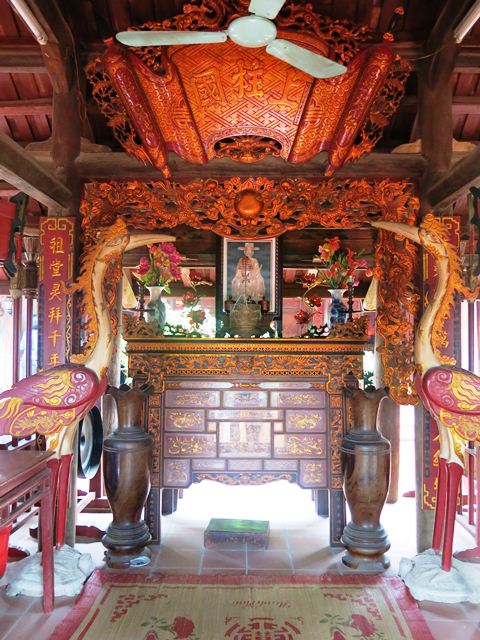
Photo: Worship House of Nguyen Duy Thi Doan Ket quarter, Thanh Lang town, Binh Xuyen district, Vinh Phuc province
Nguyễn Duy Thì (1572-1651), posthumous was Hanh Đo, passed the exam in 1598 of the Le The Tong Dynasty. In the 7th Hoang Dinh year (1606), he was trusted by King Le - Lord Trinh and was appointed as Deputy Chief of Diplomatic Delegation to pay tribute to the Ming dynasty and a number of other court officials to give thanks to King Ming for the ordination of King Le.
In 1612, Nguyen Duy Thi and other court officials from 13 areas offered a proposal called "The way to manage the Nation" which revolved around promoting the role of the Head of State and the people to stabilize the country after natural disasters and troubles of the society in XVII century. For more than 50 years serving King Le - Lord Trinh, Nguyen Duy Thi held many positions including: Rector Quoc Tu Giam, Tham Tung, Minister of Interior Affairs and Academic... After his death, he was posthumously awarded title Thai te.
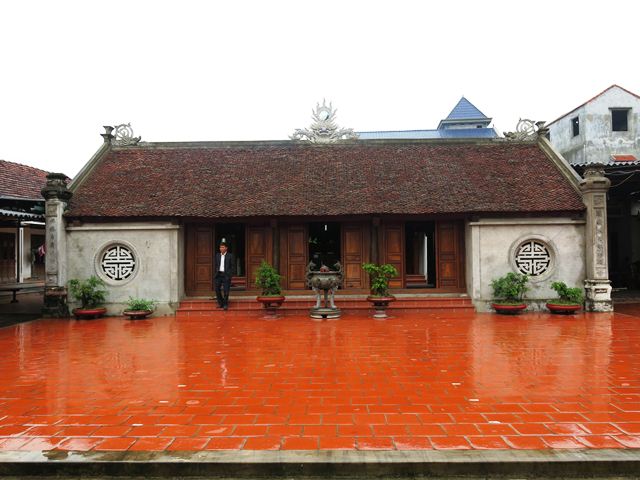
Today, at the temple of The Rector of Quoc Tu Giam Nguyen Duy Thi, there are precious books on display. The temple provides space formeetings and discussions of important events of the family. The middle space is the place of worship of Madarin Nguyen Duy Thi, the other two spaces are the worship of grandparents and parents of Madarin Nguyen Duy Thi and his eldest son Nguyen Duy Hieu.
In 2013, the family cast a bronze statue of Nguyen Duy Thi and placed it in the center of the altar. The statue is about 1m high, carved with a sitting posture on the throne, legs balanced in front of the head, wearing a hat, wearing a long tunic, right hand placed on the knee, left hand holding a card. The sculptural lines of the statue of Nguyen Duy Thi propvide an appearance of an official who was wholeheartedly devoted to the country.
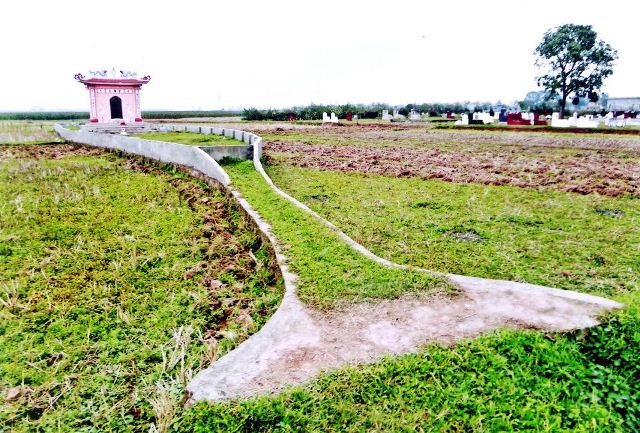
Photo: Nguyen Duy Thi's grave
Every year, on the 11th of September (lunar month), descendants of Nguyen Duy throughout the country will gather at the temple to celebrate the anniversary of the death of their ancestors. There are two precious artifacts preserved by the Nguyen Duy Thi family, which include the Chinese family genealogy book and 34 nominations for Nguyen Duy Thi, and his relatives. These items have important meanings and historical value. In 1993, the temple was recognized as a provincial cultural and historical landmark, becoming one of the traditional relics of Thanh Lang, in particular, Binh Xuyen district, and Vinh Phuc the province in general.
Translator: TH
HOANG GIAP NGUYEN DUY THI AND VAN MIEU – QUOC TU GIAM THANG LONG
Hoang giap (2nd –class laureate) Nguyen Duy Thi was born in Yen Lang commune, Yen Lang district, Tam Doi province, now belonging to Thanh Lang town, Binh Xuyen district, Vinh Phuc province. He was a scholar and a high-ranking official who made great contributions to the country in many fields. He was also a teacher with many contributions to the Temple of Literature - Quoc Tu Giam (The school for children of royal families and civil mandarins of the Capital) and advanced the national education of the country in the first half of the 17th century.
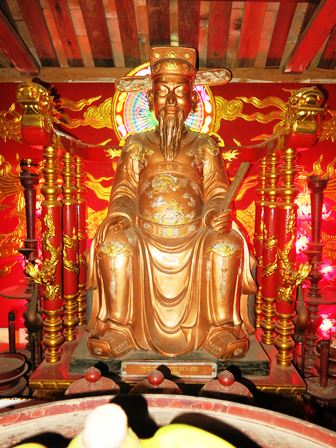
Photo: Statue of Nguyen Duy Thi at the worship house of Nguyen Duy family
Nguyen Duy Thi passed the examination in 1598 with the title Hoang giap (2nd –class laureate). He was appointed to important positions such as Deputy Minister of Rite and the Vice Rector of Quoc Tu Giam. Later he worked as Minister of Construction, and The Rector of Quoc Tu Giam in 1640. He died in 1651. For more than 50 years, he was an honest, assertive and trustworthy official who worked diligently and with integrity in all fields, especially in the field of culture and education where he made many contributions to the country.
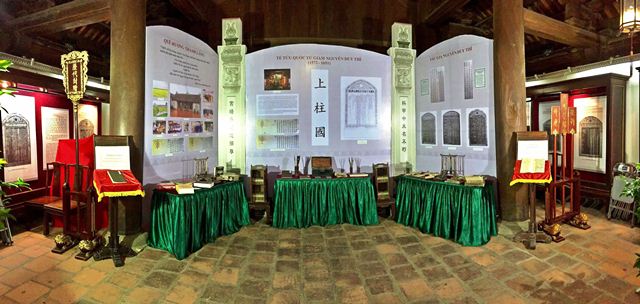
Photo: Nguyen Duy Thi Exhibition at the Seminar of career and life of Nguyen Duy Thi at Van Mieu – Quoc Tu Giam
From the 1620s, Nguyen Duy Thi was in charge of educating and training talented people for the nation in Quoc Tu Giam. Quoc Tu Giam was also the agency of managing and directing the education and nomination of the state, so the prosperity of training and fostering talents of the country depended on the prosperity and development of Quoc Tu Giam, and vice versa, the talent was due largely to the strategy, orientation and development of Quoc Tu Giam.
For more than 30 years working as Vice- rector and then Rector of Quoc Tu Giam, Nguyen Duy Thi and the officials of Quoc Tu Giam contributed to consolidate the national education and the examination system of selecting talents for the country
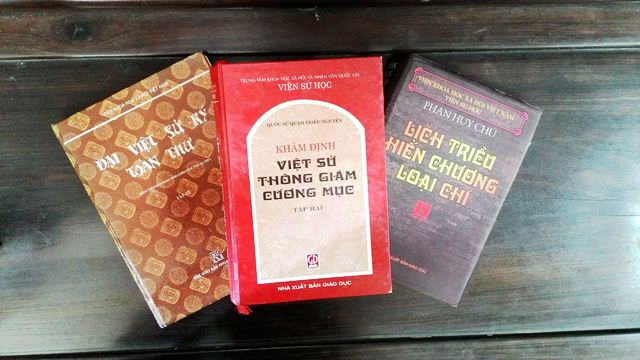
Photo: Historical books recorded about Nguyen Duy Thi
Hoang Giap Nguyen Duy Thi and the officials were also entrusted by the court to organize three examinations in 1613, 1623 and 1637. He was appointed as Supervisor, Second Examiner. These three exams are recorded on a doctoral stele at the Temple of Literature - Quoc Tu Giam, Hanoi.
Translator; Thu Huong
The rector of Quoc Tu Giam Nguyen Duy Thi, his life and career
Minister Nguyen Duy Thi (2nd class doctoral laureate, rector of Quoc Tu Giam), was a famous Vietnamese scholar in the early XVII century. For a long time, he was a pillar of the community and the Le - Trinh court.

Photo: Traditional craft village in his hometown
Nguyen Duy Thi (1572 - 1651) was born in a traditional Confucian family. As a child he was studious, intelligent, big-minded, and full of ambition. He soon succeeded and made a name for himself, his family and his clan.
Nguyễn Duy Thi began working as a mandarin after passing the examination in 1598. According to the Le Dynasty's rule, doctor laureates, after visiting their village to pay respect to the ancestors, parents and teacher, returned to the royal court and were appointed. Hoang Giap (2nd class doctoral laureate) was appointed as the title Hieu Uy while the other Doctor Laureates were appointed as Supervisor. After being appointed, these officers usually worked for a period of nine years to be considered for promotions or remission. Nguyen Duy Thi was in charge of reviewing and refuting six ministers of unfair questions, or correct appointments to the Ministry of Interior.
In 1606, Nguyen Duy Thi was appointed as a deputy envoy (vice ambassador) to the Ming dynasty for tribute. After this mission, he was promoted to (title: Thiêm Đô Ngự sử tước Phương Tuyền bá).
In 1626, he was promoted to Minister and Duke, the highest title for an official. After being promoted to Minister, Nguyen Duy Thi was continuously assigned important positions by the government. He also worked as Minister of Construction, Minister of Military, and Minister of Interior.
Nguyen Duy Thi also worked in other positions in the fields of culture, education, and science, such as the Deputy Rector of Quoc Tu Giam and then Rector of Quoc Tu Giam. Quoc Tu Giam was a specialized agency of the State, and was the first and only university of the feudal state. Officials in Quoc Tu Giam were tasked with serving Thai Hoc (Quoc Tu Giam under Le dynasty), by training students monthly, according to the schedule of study to train talents for the country.
 Photo:Nguyen Duy Thi’s tomb at home
Photo:Nguyen Duy Thi’s tomb at home
Nguyễn Duy Thì was born at a time of turmoil for society. The court of King Le and Lord Trinh were in a state of decentralization, highly bureaucratic, with staggering officials, and the people lived in tough conditions. His dedication to the people is clearly shown in the Proposal to Trinh Lord in 1612. The content of the proposal was very profound, a rare case recorded by the historian.
The main idea of the Proposal was: "The people are the root of the country, the ruler of the country must love the people".
Translator: Thu Hương
CHU VAN AN AND HIS CONTRIBUTIONS TO VIETNAMESECULTURE.
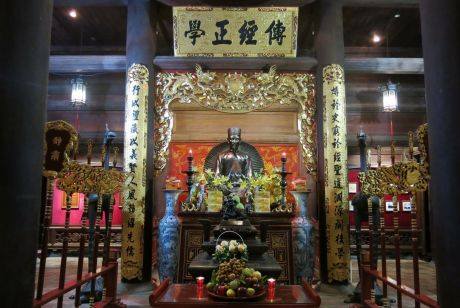
Chu Van An, “a model educator of all time,” is not merely a teacher, an intellectual, an official, or poet but also a cultural activist. He was a great contributer to national culture.
During his life, Chu Van An compiled many works. His works included Tứ thư thuyết ước (10 volumes of explanatory notes about the Four Books – Confucian Classics), the collection of Tiều Ẩn thi tập Poetry (1 book), and Quốc ngữ thi tập (1 book).
In addition, he also wrote books on geography (Địa đạo dẫn giải chương cú tập chú ), the universe and astronomy (Thiên văn chiêm nghiệm tập chú) and a book of medicine (Y học yếu giải tập). Chu Van An was straightforward, talented and a virtuous teacher. He was an intellectual, an educator, and a cultural person "who did not ask people to know him but only worried that he did not have the virtue to be known" and "learning success for himself is to succeed for people, enrich the people, and gracefully leave behind knowledge for generations ",
He was a shining example for generations to follow. For the past 650 years, Chu Van An’s thoughts about culture and education are still intact and have great positive educational meaning in the modern society.
Writer: Truong Thuy Hong
Translator: Le Thu Huong
CHU VAN AN AND PHUONG HOANG MOUNTAIN
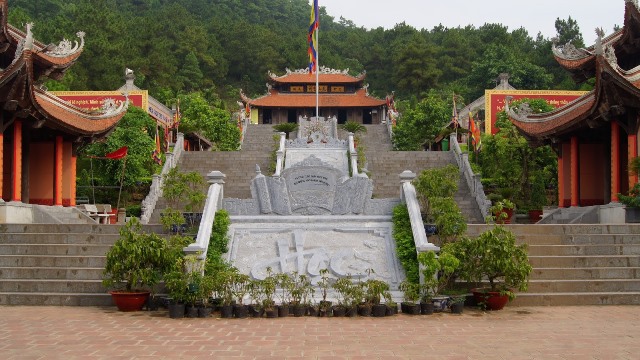
(Photo: Chu Van An's temple on Phuong Hoang mountain)
While working as as director of Quoc Tu Giam, Chu Van An contributed to the training of talents and the King's son. Under Tran Du Tong King (1341 - 1369), state affairs were confusing and the King neglected his attention to the nation which caused the courts to abuse their authority. In protest, Chu Van An presented his petition to the King to order seven bad mandarins to be executed. After the King refused Chu Van An's petition, he left office to live in seclusion on Phuong Hoang Mountain, Hai Duong district. According to "Kien Van Tieu Luc", Le Quy Don (1726 - 1784) wrote: "There were five moral and upright talents under Tran dynasty. Chu Van An's petition to order seven bad mandarins to be executed, affected everyone inside and outside of town then he retired and did not care about material things. Chu Van An was respected by lords and admired by mandarins, he was the loftiest talent".
Phuong Hoang Mountain is a beautiful sight to see with an immense pine tree forest, fresh stream, old pagodas and towers and 72 quaint mounts. This was a place to entertain great men's minds under Ly – Tran. Chu Van An gave his whole mind to writing, teaching and writing medical prescriptions for poor people and composing poems. Today, almost all of his writings have been lost, only 12 poems were written in Han character and book of medical prescription. Although some of his writings were written at the end of his life on Phuong Hoang, his poems expressed composed spirit from a retired talent.
Chu Van An's writings were full of a sense of purpose and uprightness expressing the intense emotion he felt for his nation. Chu Van An passed away in 1370 when he was 78 years old. In order to commemorate his contributions, villagers built a temple to honour him in Hai Duong (Luu Quang temple). His tomb was on Phuong Huong Mountain and near Luu Quang temple. On September, 14, 1994, Luu Quang temple was ranked as a National Historical site.
In 2000, Ministry of Culture, Sports and Tourism authorized Hai Duong Museum and Institute of Archaeology to research and excavate Phuong Hoang Mountain. They discovered many archaeological relics and items under Tran and Le dynasty concerning Chu Van An (tomb, Son well and stone statue). .
Nowadays, Chu Van An's temple on Phuong Hoang Mountain is one of the famous cultural attractions, visited by domestic and foreign tourists. Especially, many students throughout the country always visit to show deep gratitude and respect to one of the greatest educators in Vietnam.
Bùi Bích Phương
WHAT MADE CHU VAN AN BECOME A GREAT MAN
(Attendants of the seminar in the ceremony to commemorate Head Master Chu Van An)
1.Chu Van An (1292 – 1370) was a contemporary of Truong Han Sieu (1274-1354), Doan Nhu Hai (1280-1335), Nguyen Trung Ngan (1289-1370), who were high-ranking mandarins under the Tran dynasty.
King Tran Minh Tong (1300-1314-1357) had eyes for Chu Van An and appointed him as a teacher to train royal princes. Chu Van An improved his personal life and career by himself instead of taking the opportunities in history.
2. Chu Van An’s father was a common man from Northern Vietnam. He and his wife had a simple wedding in his wife’s hometown.
Chu Van An did not come from a good lineage, although this did not hold him back with his successful career.
3. Chu Van An and his family lived in Thanh Liet village – his mother’s hometown. Customary to village rules, Chu Van An and his father were not recognized as natives of the village.
Researchers thought for a long time that there was a matter with the relationship between Chu Van An and the place he lived then. After 700 years, the residents of Thanh Liet village honoured Chu Van An as an outstanding man. When Chu Van An decided to found his own school, he selected another place instead of Thanh Liet village.
During the reign of Tran Du Tong, the King overindulged, causing the ruin of the court. Chu Van An submitted a petition to the King requesting the beheading of seven dishonest mandarins, but the King refused. Chu Van An was so upset by this that he moved to the mountainous area of Phuong Hoang in Chi Linh District, Hai Duong province to open a school and lived in this area until he died. It was thought that the place Chu Van An lived was not as important as the things he achieved.
4. In fact, Chu Van An spent his life studying and improving himself. He epitomized the dutiful man.
Chu Van An successfully brought Confucianism to Vietnam. He summarized four Confucianism books (Dai hoc, Trung dung, Luan Ngu, Manh Tu) to create a schoolbook for himself. Chu Van An’s book was famous for illustrating ways to be a great man for contemporary students.
Chu Van An tried to self – improve to become an exemplary, everlasting educator and spread the system of education to the nation.
Chu Van An is engraved in Vietnamese people’s memories as a self – made man who madegreat contributions to train the talents of the nation and develop a traditional education system for Vietnam.
Author: Historian Le Van Lan
The text extracted from “Chu Van An – his life and career” seminar
Translator: Bich Phuong
CHU VAN AN AND HIS CONTRIBUTIONS TO VIETNAMESE CULTURE
Some additional evaluations of Chu Van An’s contributions to Vietnamese culture from today’s persepctive.
- 1.Timeline of honoring Chu Van An during the renewal of the country
In 1994, the Communist Party of Vietnam implemented the Resolution of the Fourth Plenum focusing on education and training of the Vietnamese culture. The goal was to revitalize the role of teachers and honor them. During this period of teacher appreciation, there was a new found interest and understanding of Chu Van An and his influence of Vietnamese education and culture. Restoration of monuments in the hometown of Chu Van An, and other memorial activities began to take place. Continuing today, Van Mieu – Quoc Tu Giam Culture and Science Center not only honors Chu Van An as a traditional teacher but also as a cultural icon. Chu Van An is honored nationwide.
- 2. Main ideas from the 1994 article “Chu Van An – a Vietnamese teacher’s personality”
Chu Van An dedicated his life to be a teacher to all; forgoing the opportunity to be a mandarin. He felt responsible to train talents for the nation with his teachings. He thought that teaching a future king would be the best for the country. His teachings and beliefs have been handed down in the history of Vietnam from generation to generation. Chu Van An is best described as a wise man, a talented and virtuous teacher, who over time has had a profound influence on contemporary culture and education.
- 3. New reflections on Chu Van An’s contribution to Vietnamese Culture.
Chu Van An, “a model educator of all time,” is not merely a teacher, an intellectual, an official, or poet but also a cultural activist. It has been expressed that nowadays Confucian education is no longer appreciated (Chinese characters and Confucian ideology), therefore it is illogical to say that Chu Van An is an exemplary educator of all time Vietnamese scholars disagree with that statement because he was a great teacher providing students with both knowledge and a moral compass. If an individual understands Chinese characters and Confucian ideology, he/she has the opportunity to examine and perfect themselves. As a result, Confucian ideology and Chinese characters help to make society better. Chu Van An’s educational ideology is still applicable in modern time. He always appreciated the importance of intellectuals; education and culture that help develop and maintain social order. His life, career and the period in which he lived provide future generations valuable lessons. He placed importance on culture which still holds true today. The development or decline of a nation depends crucially on its cultural, and spiritual basis.
His life and career leave us a clear proof of a great intellectual. For hundreds of years, historians and cultural activists have deeply respected Chu Van An for his personality along with his intellect, virtue and responsibility for the nation. Living in the time when the country witnessed a chaotic political situation, he was not afraid to lose his career and even his life submitting a petition called ‘That tram so’ to the King Tran Du Tong to demand that seven bad mandarins be executed immediately. Being a courageous official, he never yielded to violence; moreover, fame and wealth were not the things that desired. His courageous act was an initiation for people to resolve the conflicts between authorities and intellectuals. It was because only when intellectuals overcame the lures by their desire for power and fame could they show their real abilities.
His lifestyle and lofty soul are as a good example for people of all generations. Furthermore, it does make sense in modern time when the nation is growing faster and faster. As a result, people tend to run after money, fame and technology, so they forget traditional beliefs. They became increasingly dependent on material conditions; their souls became insensitive, empty and filled with mixed-up information. With his courageous spirit, Chu Van An led a meaningful and modest life in a disorganized society. His lifestyle initiates a positive orientation for future generations, despite differences between the time he lived and present day.
Author: Associate Professor and Dr. Le Quy Duc
Translator: Chuong Van
THE INFLUENCE OF CHU VAN AN TO THE COMTEMPORARY
Teacher Chu Van An had been respectfully known as a role model for teachers throughout the ages because of his high moral standards and for his excellence in teaching.
Many scholars were well known for their knowledge but some of them obtained prosperity and high leadership positions from cunning instead of virtue and wisdom. Chu Van An was a brilliant but unlucky man. The king did not recognize his helpful contributions to rule the nation.
Historians said that from a young age, Chu Van An was known as a respectable man of pure, moral integrity who did not seek fame and wealth and only liked to stay at home to read books. After passing the doctoral examinations, he refused to work as a mandarin and returned to his native village to open a school and worked as a teacher. He had many students who came from different parts of the country. Many of them were successful in learning and after passing the examinations they became high ranking mandarins in the court, such as Pham Su Manh, and Le Quat. When they visited their old teacher, they still observed high etiquette and were received by him. While those who failed to meet his standards, were scolded and he refused to meet with them. His serious noble conduct and intelligence made his reputation spread far and wide, and attracted more and more students.
Due to people’s compliments for his virtue and talent, Chu Van An was invited by the court to the capital city to be in charge of Quoc Tu Giam; the first national university. During the reign of Tran Du Tong, the King overindulged, causing the ruin of the court. Chu Van An submitted a petition to the King requesting the beheading of seven dishonest mandarins but the King refused. Chu Van An was so upset by this that he moved to the mountainous area of Phuong Hoang in Chi Linh District, Hai Duong province to open a school and lived in this area until he died. In order to express gratitude towards Chu Van An for contributions he made, villagers of Nguyem Bao and Hai Duong villages built the Temple for Chu Van An on Phuong Hoang mountain to commemorate him forever. Today, the temple is recognized as a historical monument in Hai Duong with inscriptions of parallel sentences in Chinese in praise of the everlasting exemplary educator
With a lofty soul and immense knowledge, Chu Van An was worthy of being an outstanding teacher in the national education system. It was King Tran Nghe Tong who ordered the statue of Chu Van An to be erected at Van Mieu. The King wished to recognize the most virtuous and excellent man as an example to all generations at Van Mieu.
Chu Van An is honored as the most outstanding Vietnamese educator. He successfully brought Confucianism to Vietnam. His ideology and viewpoints in education are of great significance for all generations.
Author: Pro.PhD Nguyen Duc Nhue (Institute of History)
The text extracted from “Chu Van An – his life and career” seminar
Translator: Bich Phuong
CHU VAN AN AND HIS CAREER FROM THE SOURCES OF HAN - NOM DOCUMENTS
According to The Complete Annals of Dai Viet (Dai Viet Su Ky Toan Thu), Chu Van An was born in 1292 in Van Thon village, now part of Thanh Tri District in Hanoi. After he passed doctoral examinations, he refused to work as a mandarin and returned to his native village to open a school and worked as a teacher
His syllabus mostly revolved around Confucian teachings, thus making him one of the most important figures in spreading Confucianism to Vietnam. His decision not to enter into government service was a wise one, as he had a real gift for teaching. He strongly believed that a good teacher must be strict and act as a role model, both intellectually and ethically, for his students. During his teaching career, many of his students became top officials in the Vietnamese government, including Emperor Tran Minh Tong’s son Tran Vuong, who later went on to become Emperor Tran Hien Tong.
While Chu Van An’s professional career was straightforward in official historical documents, his fame and ability as an educator have inspired many a myth among the common people. In one such story, his teaching ability was so remarkable that even river spirits attended his classes.
Chu Van An was dedicated at Van Mieu in Hanoi from 1370 to 1809. When Nguyen Dynasty moved the new capital to Hue, thedynasty founded another university as the highest examination center. During this time, Van Mieu in Hanoi, was no longer the biggest national university, and was used as a small school. Since 1837, Chu Van An has been honored in Hue. He is honored as the greatest educator of the nation both in Hanoi and Hue.
Throughout the country, Chu Van An is honored in the community temple in every village as a Sage or Saint and an educator. In addition, other well – known scholars who passed doctoral examinations and inspired and supported their village are also honored.
During his career, Chu Van An wrote many famous books in Chinese. Some of these books have survived and inspired historians and scholars to achieve great things.
Chu Van An spent his entire life teaching and training students in three different areas of Vietnam, including his hometown, Quoc Tu Giam (The first national university) and Hai Duong. One Chinese document states Chu Van An was the first man to open a private school that attracted many students from near and far with his lofty soul and immense knowledge. Through the ups and downs of life, Chu Van An made contributions to rule the nation and train the talents. He is revered among the Vietnamese people
Writer: PhD. Nguyen Huu Mui (Han Nom Institute)
The text extracted from “Chu Van An – his life and; career” seminar
Traslator: Bich Phuong
LIFE AND CAREER OF SCHOLAR CHU VAN AN THROUGH HISTORY WRITTEN BY IMPERIAL COURT AND PRIVATE DOCUMENTS
The ancient documents (history written by Imperial court and private documents) wrote about the life and career of Chu Van An.
I. The first historical book written about Chu van An was Đại Việt sử ký toàn thư (Complete Annals of Dai Viet). The writers wrote about the life and career of Chu Van An during the recession society of Tran dynasty (the 13th – 14th century).
The following historical books such as: Đại Việt sử ký tiền biên under Tay Son dynasty, Khâm định Việt sử thông giám cương mục under Nguyen dynasty, and works of writers such as: Nam Ông mộng lục – Ho Nguyen Trung, Kiến văn tiểu lục - Le Quy Don, Hoàng Việt thi tuyển – Bui Huy Bich…also used information from Đại Việt sử ký toàn thư to write about Chu Van An.
Records about Chu Van An in the history written by Imperial court and private documents:
1. Chu Van An was born in Thanh Liet commune, Thanh Đam district, which now is part of Thanh Tri, Ha Noi. He died in 1370 at Phuong Hoang mountain, Chi Linh province (now part of Van An precinct), Chi Linh town, Hai Duong province. Chu Van An is the first Vietnamese Confucian scholar to be worshiped in The Temple of Literature by King Tran Nghe Tong. He is also worshipped in many places throughout the country.
2.Chu Van An was straightforward, talented and a virtuous teacher and scholar under Tran dynasty. He was known for being straight forward and not being concerned with fame and advantages. During the Tran Du Tong Dynasty (1341-1369) the affairs of the court were not good. Mandarins abused their power, so Chu Van An submitted a petition requesting the killing of seven bad madarins. Unfortunately, the King did not reply to his petition. Chu Van An resigned and lived in seclusion in Kiet Đac hill of Chi Linh district, Hai Duong province.
The Vietnamese historians and scholars all respect his frank manner and honoured him as the venerated educator.
3. Chu Van An studied by himself for many years and became an outstanding educator who made great contributions in education for Viet Nam.
It was said that Chu Văn An was awarded the title Thai Hoc Sinh (doctor degree) under the Tran dynasty. However, he did not work as a mandarin,. He founded a private school to train many talents for the nation, including Pham Su Manh and Le Ba Quat who worked at the court as Nhập nội hành khiển (chief mandarin) under Tran dynasty. His students always paid respect to him because he was full of integrity. His students, some of whom were even a minister or prime-minister, treated him as teacher, and those who were invited in usually knelt to listen to him. Those who were not good mandarins would be driven away.
After he resigned and came to live in seclusion in Kiet Đac hill of Chi Linh district, Hai Duong province.
King Tran Minh Tong (1314-1329) invited him to the Capital to instruct Tran Vuong crown prince (who later became the King Tran Hien Tong ) and appointed him as Tư nghiệp(Director) of Quoc Tu Giam, looking after the training in Quoc Tu Giam and ceremony in the Temple of Literature.
All the ancient books noted that in 1370, he died at the age of 79. King Tran Nghe Tong was so upset, he gave Chu Van An the posthumous name “Khang tiet”, awarded him the title Văn Trinh Công and ordered him honoured in the Temple of Literature. Chu Văn An is the first Vietnamese Confucian scholar to be worshiped in the Temple of Literature.
Chu Van An spent his life for education and training talents for the nation. He continues to be respected as the everlasting teacher of generations.
4.Chu Văn An wrote Tứ thư thuyết ước as the textbook for students.
II. Decoding the life and achievement of Chu Van An.
Firstly about his name, from Nguyen dynasty in the time King Tu Duc (1848-1883) all the historians wrote about his name being Chu Van An.
Secondly about the year he was born. Historical documents do not write about his birthday, only his death day in 1370. So now we should research more.
We should research about whether he was awarded the title Thai Hoc Sinh (doctor degree) under the Tran dynasty or not.
In a word, Chu Van An always worried about country and training talents (including the princes and students from different parts of country under 14th century.
Writer: Doctor Nguyen Huu Tam – Institute of History
Excerpted from Science Seminar “Chu Van An scholar – Life and career”
CHU VAN AN – LIFE AND CONTRIBUTIONS TO THE EDUCATION OF THE NATION
Chu Van An was a confucian scholar and educator under feudal society. But he had many valuable contributions for future generations of the nation.
Life and career of Chu Van An (1292-1370)
Chu Van An was born in 1292, and died in 1370. He was also called Chu An. He lived in Thinh Liet commune, Thanh Đam district, which now belongs to Thanh Tri, Ha Noi. When he was young, he was renowned for being full of integrity and righteousness and he only stayed at home to read books and teach.
Chu Van An was a famous confucian scholar and a great teacher under the Tran dynasty. King Tran Minh Tong (1314-1329) invited him to the Capital to instruct Crown Prince Tran Vuong (who later became King Tran Hien Tong) and appointed him as Tư Nghiep of Quoc Tu Giam (Director of Quoc Tu Giam), looking after the training in Quoc Tu Giam. During the reign of King Tran Du Tong, the court was in disarray; mandarins abused their power. He submitted a petition recommending seven bad mandarins to be killed. Unfortunately, the King did not reply to his petition. Chu Van An then resigned and lived in seclusion in Kiet Đac hill of Chi Linh district, Hai Duong province. Later, King Tran Nghe Tong invited him to the Capital to work as a mandarin and help the king in governing the country. But he only went to the court to congratulate the king and returned home. In 1370 he died at the age of 79. King Tran Nghe Tong decreed that Chu Van An be honoured in Van Mieu
Chu Van An wrote Tứ thư thuyết ước a textbook for students plus 10 other books. Unfortunately, these books cannot be found today. In his education activity Chu Van An tried his best to introduce Confucian doctrine and created a positive environment for Confucianism to reach a higher importance above Buddhism among Vietnamese. His students always paid respect to him because as a teacher he was full of integrity and righteousness. Former students who rose to the ranks of minister or prime-minister, continued to treat him with respect. Students who were invited to visit usually knelt to listen to him. Those who were not good mandarins would be driven away.
He composed poems such as: “Tiểu Ẩn thi tập” và “Quốc ngữ thi tập” but the manuscripts do not exist today.
Generations of Vietnamese have considered Chu Van An as the everlasting teacher for all. After the revolution in 1945, a tree-lined street and a secondary school, the most renowned in the country, were named after him to commemorate his righteousness and achievement.
Chu Van An’s contributions to the education of the nation
The moral, prestige and capacity of the teacher: Chu Van An identified, the teacher must always be a model of morality, prestige and talent. Throughout his life, he devoted himself to education. With the opening of a private school, he contributed to making the academic atmosphere of the Tran dynasty more active.
Chu Van An determined the task of a teacher. He taught: “Confucian scholar’s obligation is that our success in studying is for the other’s success, merit to people, to give favour for the next life”.
Chu Van An’s opinion about education principle: He always advocated that education was for everyone. Under Tran dynasty some public schools were opened for the sons of royal families by the court. Chu Van An opened private school in his native village for the poor students in order to improve their talents to help the country. Chu Van An got love and respect from his students.
Chu Van An’s opinion about education content: Through his teachings, Chu Van An directed people to a model of kindness and righteousness in their daily lives. He taught his students to respect the workers and be in charge of their life.
He taught his students to be brave, high – minded, abolish what is unjust and be willing to sacrifice for the nation.
Chu Van An’s opinion about education methods: Chu Van An always emphasized the rigor of education for the younger generation. The strictness must first come from the teachers. He confirmed: “Teacher must be strict.” According to Chu Van An “strictness” provides rules and discipline as a model for education.
Chu Van An’s opinion about teaching materials: Chu Van An was always interested in the compilation of materials for learners. Chu Văn An wrote Tứ thư thuyết ước as the textbook for students, but these books have not been found today. He also wrote traditional medicine books, and composed poems.
Writer: Prof. Doctor Duong Hai Hung – Doctor. Mai Quoc Khanh
(HaNoi National University of Education)
Translator: Le Huong
Excerpted from Science Seminar “Chu Van An scholar – Life and career”
THE WAYS TO EXPRESS GRATITUDE TOWARDS CHU VAN AN
Chu Van An who is engraved in the memories of Vietnamese was a self – made man, who made contributions to train the talents and develop traditional education system of Vietnam.
- 1.Temples dedicated to Chu Van An
Throughout Vietnam, there are many temples dedicated to Chu Van An. In Hanoi, Chu Van An is honored at Van Mieu as the greatest, everlasting educator. In his hometown temples are dedicated to him and his mother as a Sage or Saint and the teacher of the nation.
There is a temple dedicated Chu Van An in Hai Duong. After leaving office, Chu Van An moved to the mountainous area of Phuong Hoang in Chi linh District, Hai Duong province to open a school and lived in this area until he died. In order to express their gratitude towards Chu Van An, villagers of Hai Duong built the Temple for Chu Van An on Phuong Hoang mountain to commemorate him forever. Today, Temple of Chu Van An on Phuong Hoang mountain is recognized as a historical monument in Hai Duong with inscriptions of parallel sentences in Vietnamese and Chinese in praise of the everlasting exemplary educator.
There is a temple in Hung Yen dedicated to Confucius, Chu Van An and native scholars. The temple was built in order to encourage the talents and heighten the education of the people. Locals come to the temple to make a wish for their children to be prosperous in studying and be lucky in life. In recent years, several temples were reconstructed throughout the country to honor the great men of the nation such as Chu Van An in Vinh Phuc, Dong Nai.
2. Making offerings and organizing festivals to Chu Van An.
As a Vietnamese tradition, people came to Van Mieu – Quoc Tu Giam to make offers to the great men, dedicated in Van Mieu; Chu Van An among them.
On the first day of Lunar New Year, the beginning new year writing ceremony is organized with the cooperation between Department of Education and Training Hanoi and People’s Committee of Thanh Tri District. Before opening the event, representatives from People’s Committee in Hanoi, the Department of Education and Training Hanoi and People’s Committee of Thanh Tri District make offerings to Chu Van An and report all results they achieved during the last year. Four characters are ordered to commence a new year’s writing: nation, prosperity, people, and desire to consolidate the country and improve the talents of the nation.
In Tam Hiep Commune, the festival is held by villagers around the first four days of the Lunar New Year to offer guardian of village and Chu Van An. It is customary for villagers in Tam Hiep Commune to wish for themselves luck and the best things in new year.
In Hai Duong, the temple of Chu Van An on Phuong Hoang mountain is one of the well - known historical sites. There is an annual ceremony held by Chi Linh villagers. The ceremony includes making offerings to Chu Van An, picking up the sedan chair used to usher god, and organizing traditional games.
Some ceremonies are held for young students from high schools in the Temple of Chu Van An with activities such as: camping trips, playing traditional games, and discovering historical sites by themselves. This provides a chance to learn about Vietnamese history and Chu Van An for the younger generation.
3. Giving the name Chu Van An to streets and schools
The Vietnamese government decided to publish regulations for naming streets and schools after great men who made contributions to the nation. . Because of Chu Van An’s influence and contributions his name is often used on streets on schools.
There are 50 schools named Chu Van An throughout the country including a high school in Ha Noi originally built in 1908 by the French. The school changed its name to Chu Van An in 1945 and is now one of the most prestigious schools in Hanoi.
4.Statues of Chu Van An
Statues of Chu Van An can be found in Van Mieu – Quoc Tu Giam, Chu Van An high school and Van Mieu in Tran Bien – Dong Nai. The various forms of Chu Van An’s statue express him as a role model and educator with a lofty soul and immense knowledge.
There is no doubt that in the last 600 years, Chu Van An has influenced Vietnam. His career became a precious moral value of culture for the nation. Every Vietnamese is proud of Chu Van An and honors him as the greatest man with highest personality and human dignity.
Author: NTM
The text extracted from “Chu Van An – his life and career” seminar
CHU VAN AN – THE GOD OF HAPPINESS – IN TRADITIONAL BELIEF
According to Viet Dictionary by Prof. Hoang Phe, chief editor the phrase “God of Happiness” is explained: “the god always does the best things (a person who does good things will be honoured after death) is dedicated as God of Happiness by villagers”
In historical books, Gods of Happiness honoured by people are heros. They were willing to sacrifice themselves to protect the country and people. In addition, gods of happiness make great contributions to develop the education of the nation such as Ly Dao Thanh under Ly dynasty, Chu Van An under Tran dynasty, and Nguyen Trai under Le dynasty.
The phrase God of Happiness Chu Van An was wrtten in Tối linh từ thực lục. This book is kept at the Institute of Han-Nom Studies and was published in A.1323. The contents of the book is about the admiration of Vietnamese Scholar Chu Van An. The book also illustrates the text of the stele Huỳnh Cung huyện từ bi ký placed at the Temple of Thanh Tri district. The stele contains text praising Chu Van An for his contributions. The author of the text was Dortor Nguyen Cong Thai. He passed the royal exam and received the title Doctor Laureate in 1715. The text showed that God of Happiness Chu Van An has been worshiped at two places:
1. God of Happiness Chu Van An has been worshiped at Huynh Cung village.
Chu Van An opened a school in Huynh Cung village. The ancient geographical books wrote that besides Huynh Cung village, God of Happiness Chu Van An also was worshiped in eight other villages. These villages worshiped Chu Van An at the same Cat temple at Xa Can. And two of Chu Van An’s students have been worshiped there as gods of Happiness.
2. God of Happiness Chu Van An worshiped at Chi Linh
The temple of God of Happiness Chu Van An has been worshiped at Chi Linh district, Hai Duong province.
In the middle of the temple there is a horizontal lacquered board: “God of Happiness of Confucianism in Viet Nam”
In the history of Vietnamese beliefs, individuals who made great contributions to the people and the nation have been dedicated as Gods of Happiness and worshiped at the Communal House. However, it is rare for an individual to be worshiped as God of happiness of Confucianism.
3. God of Happiness of Confucianism
On the text of stele Huỳnh Cung huyện từ bi ký, Dortor Laureate Nguyen Cong Thai wrote about the effects of God of Happiness Chu Van An to develop education and improve the life and wellbeing for people.
In 1370, God of Happiness Chu Van An passed away at the age of 79. King Tran Nghe Tong gave him the posthumous name as Khang Tiet, awarded him the title Văn Trinh Công and ordered him to be honoured in the Temple of Literature. He was honoured in the Temple of Literarure from the Tran dynasty (14th century) to the Le trung hung dynasty (18th century). Since 1837 he has been honoured at the temple till present day. Many villages built temples to worship Chu Van An as God of Happiness.
Author: Prof. Nguyen Ta Nhi (Institute of Han – Nom Studies)
Excerpted from Science Seminar “Chu Van An scholar – Life and career”
CHU VAN AN IN THE HEARTS OF THE RESIDENTS LIVING IN THANH TRI DISTRICT
Chu Van An(1292 -1370) was born in Quang Liet Village, Thanh Liet Commune, Thanh Tri District, Hanoi. History records indicate he achieved the most honorable position of his time. He was studious and founded a private school. Chu Van An was invited to work as a mandarin-head master of Quoc Tu Giam School. When he passed away, King Tran Nghe Tong decided to give him a posthumous name “Van Trinh” in recognition of his excellent morals and talent. Then the King ordered that Chu Van An be worshipped in Van Mieu like other Confucian deities. This privilege bestowed on Chu Van was very unusual in his time.
In the hearts of the residents living in Thanh Tri District, his modest way of living was as a good example to everyone of all time. Consequently, Chu Van An was worshipped as a tutelary god in a spacious temple near To Lich riverside. In addition, to show their respect for him, they address him as “Duc thanh Chu-Chu Saint” or “Duc thanh Van-Literature Saint”.
It can be said that: “ a dead person is a completely dead if he or she leaves no contributions to mankind”. In fact, 700 years after his death, Chu Van An is still thought of as a talented, and virtuous educator.
Chu Van An- a brilliant philosopher:
The history book “Dai Viet Su ky Toan thu-Complete Annals of Dai Viet” states that: “ He stayed inside reading books; he was a man of great learning; many students heard of that then came to ask to study from him, his students then occupied high positions in court”. His students were not only taught to become talented but virtuous as well. No matter what position they occupied, they always kept his teachings in their minds and tried to be good men of the nation. According to Chu Van An, the goal of education is not merely for knowledge but virtue.
Chu Van An-An upright man not to yield to violence
Chu Van An is not only remembered for his talent but also moral integrity, as a result, he has many other admirers apart from his students. He always heightens decency and the ability to work independently. He demands that his students be honorable and brave not to yield to violence. His teachings focused on the responsibility for people and the nation. When he was a head master looking after training students, he always followed state affairs. When the nation witnessed a chaotic political situation, many bad mandarins abused their power and stole state property. Chu Van An decided to submit a petition to the King, requesting that seven bad mandarins be executed. The petition reflected his righteousness and courage and served as a reminder for everyone to raise their voices to protect reason.
Chu Van An’s enormous contribution to Vietnamese education.
His personality is reflected by his “Reformed teaching methodology”. He was an exemplary educator. He stressed that teachers had to create big changes in their students’ careers and do more for the nation. He founded a private school in Huynh Cung Village (now in Thanh Tri District). His school was open for all students regardless of their social status. After the foundation of the school, education under the Tran dynasty became more exciting. Chu Van An devoted his whole life to education for the development of the nation, not for any private benefits.
Approximately 700 years since his death, many of documents about Chu Van An have been lost; the Temples in which he is being worshipped have changed remarkably in their appearance. However, the image of Chu Van An is still in the hearts of people, especially the residents in Thanh Tri District, as a upright, talented educator and Confucian philosopher.
The Administration and residents in Thanh Tri District have proved a sense of responsibility for the conservation of the temple to Chu Van An. The conservation work has been carefully done to keep the original condition. With an investment of more than 7.8 billion VND from State budget and another 700 million VND as a donation from locals and visitors, the temple was restored. After the restoration, the temple still looks ancient with traditional architecture. The conservation of the temple reflects the respect that Vietnamese have for Chu Van An, an exemplary educator of all time.
Particularly, Thanh Tri residents feel proud that the temple was constructed in their homeland, Thanh Liet Commune. Every year, on the 4th of Lunar New Year, The People’s Committee of Thanh Tri hold Khai But ceremony (Begin a new year by writing) to commemorate Chu Van An, as well as, to show respect for traditional fondness for learning. Many other ceremonies to honour the great educators of Vietnam are organized in Thanh Tri District, the homeland of Chu Van An, including:
-‘Mua Khai truong’(The ceremony to start a new school year) on August 15th(Chu Van An’s Birthday)
‘Le hoi ve nguon’(Novenber 26th , the ceremony to commemorate Chu Van An’s Death)
-‘Le hoi mua thi’(the ceremony to pray for a lucky school year)
- Vietnamese Teachers’ Day on November 20th : the ceremony to commemorate Chu Van An
The above-mentioned ceremonies reflect deep respect of the residents in Thanh Tri and Hanoi paid for Chu Van An. This gives proof of long-lasting existence of Chu Van An in the hearts of Vietnamese people, especially the residents in Thanh Tri District.
Source: Seminar “Chu Van An, life and career”
Translator: Chuong Van
PRINCIPAL CHU VAN AN AND VAN MIEU-QUOC TU GIAM IN THANG LONG
Chu Van An, also known as Linh Triet, was born in Quang Liet Commune, Long Dam District(now Thanh Liet Commune, Thanh Tri District, Hanoi) in 1292. As an upright, talented educator, he made considerable contributions to Confucian education of Vietnam, especially to training talents and defining the role of Confucianism in national management and development. For many years, he has become a model educator for many generations in Vietnam. Today, Chu Van An has been still considered as the first Head Master of Quoc Tu Giam who had a significant influence on Van Mieu-Quoc Tu Giam and education system of Vietnam in the 14th Century.
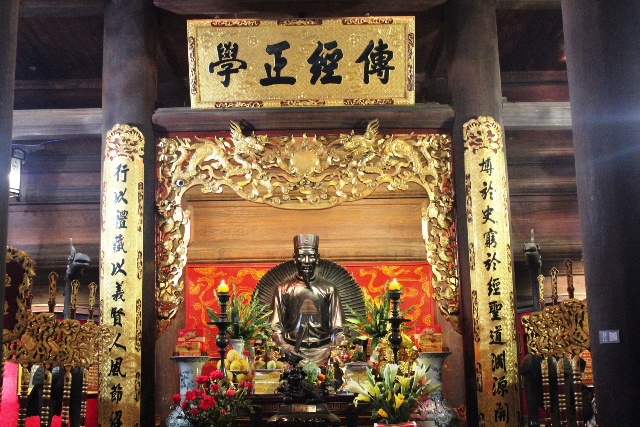
Statue of Chu Van An in Van Mieu-Quoc Tu Giam
Van Mieu and Quoc Tu Giam in Thang Long were established in the late 11th century. Van Mieu- the Temple of Literature was founded in 1070 under the reign of King Ly Thanh Tong to worship Confucius and the Confucian scholars. It was also a place to educate Crown Princes. Six years later (1076), an official state school called Quoc Tu Giam was established as a royal school for royal children.
Under the Ly dynasty, Van Mieu - Quoc Tu Giam did not receive much attention from the court, so education was not fully fostered. During this time, only a few events were recorded, such as in 1075, the court held the first examination to select talented men. This exam can be considered as the first examination in the history of Confucian education. Subsequently, in 1077, the Ly dynasty held another examination, the candidates had to take a written test, then did the maths and answered law questions. However, this exmination was not really a confucian examination. The importance and use of Confucianism had not been appreciated until 1156 when King Ly Anh Tong ordered the foundation of the Temple of Confucius, and 10 years later in1165 confucian examinations were held. Until the end of the Ly dynasty, there are several events recorded as in 1171, the Temple of Confucius was rebuilt; in 1195, the Three- Religion examination (Confucianism, Buddhism, Taoism) was held. Apparently, under Ly dynasty, Confucian studies began to be noticed by the court, but not seriously. Van Mieu and Quoc Tu Giam were founded to honor the ancestor of Confucianism and for the noble children to study there. However, Confucianism and Confucianists had not been really valued in the Ly dynasty.
Tran Thai Tong(Tran dynasty) came to the throne in 1225, ruling over Tran dynasty. The King was interested in training and looking out for talents. In 1232, Tran Thai Tong ordered to hold the first Confucian Examination. The successful candidates would be classified into three ranks based on the levels they had achieved in the exam. Four years later, in 1236, Tran Thai Tong chose not only confucian students but also a special official who was responsible for the work in Quoc Tu Giam. In 1243, King Tran Thai Tong ordered the repairs of Quoc Tu Giam; later in 1246, the king issued a decree that said a doctoral examinations was held every 7 years. After that, in 1247, an examination was held and Nguyen Hien was the best candidate that achieved the title Trang Nguyen, Le Van Huu was the second best one - Bang Nhan, Dang Ma La was the third best one-Tham Hoa. In 1253, the king ordered the establishment of the National Academy and in September that year, he invited his Confucian scholars to the National Academic to teach the Confucian Classics
A series of events proved the importance of Confucianism and Confucian education in society. In particular, the court recognized the role of the teacher in Quoc Tu Giam, so in 1272, King Tran Thanh Tong issued a proclamation for looking out for talents for the position of Principal of Quoc Tu Giam. Thus, Van Mieu-Quoc Tu Giam had truly become the highest education center of Dai Viet. Because it is the place of study for managers, leaders of country, moreover, the training had become better and the person in charge of the school's affairs was a Thuong thu(Now Minister). Candidates would take the exams to obtain Ph.D. certificates-the highest degree. The study here was also the highest level: classics of Confucianism: Four Books and Five Classics Chu Van An was born in the countryside of Thang Long, he was famous for his Confucian knowledge. There is no evidence that he participated and passed any exams but his status and talent were recorded in many documents and handed down among generations. The Complete Annals of Dai Viet by Ngo Si Lien said "An (a native of Thanh Dam district), an upright and disinterested man, he is at home reading books and comprehensively understands confucian teachings, so his class is always full of students. His students then are successful in studies and work for the government. One of his successful students are Pham Su Manh, Le Ba Quat, the both are civil mandarins, however, when they came to visit the teacher, they would kneel down next to his bed talking to their teacher a few sentences and then went away. any bad students were seriously scolded, even got no permission to meet him again. " It is also said by Ngo Si Lien that, Chu Van An was invited by King Tran Minh Tong to the capital to teach the Crown Prince Tran Vuong, and was appointed as the Principal of Quoc Tu Giam.
In the context when the court needed talented people who are interested in teaching Confucianism as mentioned above, so the finding a qualified and wise person like Chu Van An is a good fortune. That King Tran Minh Tong invited him to work as a Principal and at the same time to teach the Prince proves his prestige and talents in academia and society. So far there is no information on exactly what year he was invited to serve as a Principal of Quoc Tu Giam, but there are two things we can say for sure: First, Chu Van An held the highest position in Quoc Tu Giam. Second, he was the first Principal to be officially recognized.
Historically speaking, since Quoc Tu Giam was officially mentioned in 1076, until 1272 it was mentioned that the selecting a Principal for Quoc Tu Giam was carried out, and that the chosen person should be "Good, ethical and expert in Confucian Classics" , but no documents say, in this election, King Tran Thanh Tong selected whom to appoint, and no documents clearly explain What a principal did in Quoc Tu Giam. To further understand, let's try to find out what responsibilities a principal of Quoc Tu Giam took. According to Dr. Dang Kim Ngoc, "Tu nghiep (or Principal), literally, is the person in charge of the education and training of talents" , Therefore, Tu nghiep was the highest position in Quoc Tu Giam.
Thus, it can be seen that Chu Van An was King Minh Tong invited to Quoc Tu Giam and taught the Prince about the end of 1328. The following year, in1329, Prince Vuong came to the throne, it was King Tran Hien Tong . Chu Van An worked throughout the life of Emperor Tông (1329-1341), into the Trần Dụ Tông (1341-1369). In this time, the history said that Chu Van An submitted a petition to the King but was not replied, so he resigned and then secluded himself from society. Thus, the time he submiited the petition to the King was the time he left Quoc Tu Giam, and that is when the court got into a chaotic political situation, many bad civil mandarins abused their power. Said about King Tran Du Tong in the Complete Annals of Dai Viet by Ngô Sĩ Liên, the period of chaos was during the period of Dai Tri (1358-1369). Thus, it can be predicted that in the early 60s of the 14th century, Chu Van An found that King Tran Du Tong did not care about the fate of his nation, so he tried to persuade the king. In contrast, the king did not give him any responses. Thus, the time Chu Van An worked in Quoc Tu Giam is from 1328 to about 1360. With more than 30 years of holding the position of a Principal in charge of education and the training of talents in Quoc Tu Giam, Chu Van An did specific work that contributed to the development of Confucianism, and to training talents for the country. There are no specific records of the work that Chu Van An did at the school, but it is certain that, in addition to teaching the Prince, Chu Van An took responsibility for education in Quoc Tu Giam. He must have planned and prepared for the content of learning and training for the children at the school. Perhaps the lectures, educational content of Chu Van An during his career were summarized from the lectures when he was a teacher at the school in Huynh Cung, and then, gathered into the book Tu thu thuyet uoc that the later generations have been still referring to (unfortunately, we have not found this book yet). During the period when Chu Van An was still in office(from about 1328 to 1460), the court did not hold any examinations (or it did but the events were not recorded in historical documents). Except in 1345, the document did not list the name of the people who had passed, as well as their significant contributions to the educational development of the country. Possibly, the court had no need for personnel, or held examinations but not excellent people were found. This needs more evidence, but there can be a hypothesis that at that time, Quoc Tu Giam had trained enough personnel for the court, so the court had no need to look out for more talents in the society. If so, then the contribution of Chu Van An is so great. That explains why later generations highly appreciate Chu Van An's contribution to education, consider him "the model Confucianist to be worshiped in the Temple of Literature "
Chu Van An left the Quoc Tu Giam at the age of 60, even then he was invited to hold another positions (not Principal of Quoc Tu Giam), but he refused. But his life, born to have a special relation with the Temple of Literature, so when he died in 1370, he was worshiped here. This must have been a big decision of the court at the time, and a special blessing to Chu Van An. He was the first Vietnamese to be worshiped in the Temple of Literature. After that, Truong Han Sieu and Do Tu Binh were two other Vietnamese people who were worshiped by Tran dynasty in 1372 and 1380. The worship of the three men in The Temple of Literature marks the important step in the reception of Confucianism. However, among the three who were worshiped in the Temple of Literature under the Tran Dynasty, only Chu Van An was the one who was considered by the following generations to be the most worthy.
Over the course of history, even when Confucianism is no longer used since the last examination held in 1919, Chu Van An has always been a symbol of Vietnamese education, always honored and respected in Van Mieu. In particular, to honor the study, honor the model teacher of Vietnam, the state had the statue of Chu Van An made in 2003 and honored him at the first floor of Rear building(Thai Hoc section) where he taught his students.
the statue of Chu Van An at Van Mieu-Quoc Tu Giam is now put in the middle of the Rear building, where thousands of people come to offer incense. It is a reverence, honor of this generation. Hopefully, the generations of Vietnamese, as well as tourists always pay their respects to the moral teacher. Hence, they try to follow the good example of the predecessors . Chu Van An - the model teacher of Vietnamese education, who has associated with the development of Van Mieu - Quoc Tu Giam has become a symbol of education in Vietnam.
Writer: Nguyen Van Tu Source: Scientific seminar “Chu Van An-Life and Cereer”
Translator: Chuong Van
Chu Van An – The principal of Quoc Tu Giam (1292 -1370)
Chu Van An (1292 – 1370), his given name was Linh Triet, his pen name was Tieu An. It was said that Chu Văn An was awarded the title Thai Học Sinh (doctor degree) under the Tran dynasty. However, he did not work as a mandarin, instead he founded a private school to train many talents for the nation. His life can be divided into three main periods: the period of opening a school in his homeland, the period of working as the rector of Quoc Tu Giam Thang Long and the period of retreating to live in Phuong Hoang Mountain, Chi Linh district. Education was considered his career throughout these three periods.
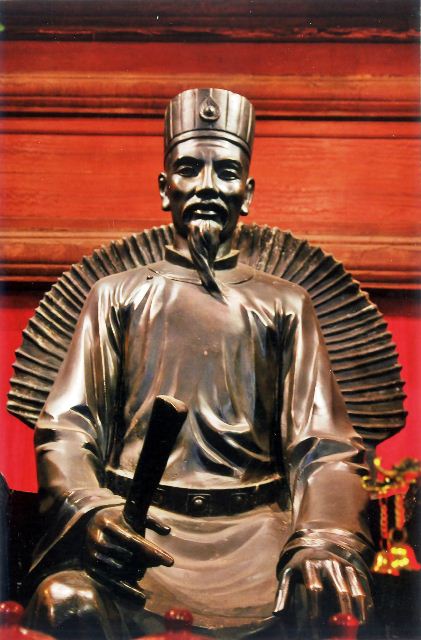
The statue of Chu Van An at Thai Hoc buiding
When he was in his homeland, Chu Van An opened a school in Huynh Cung, located along the To Lich river. The school was famous from near and far, students from everywhere came to study. Many of them passed and advanced on the way of the mandarin, including two famous figures: Pham Su Manh and Le Quat. They were two scholars who have made great contributions to the country, and they were also two great authors who were listed in the history of Vietnamese literature.
His students always paid respect to him because he was full of integrity, and was uprighteous. His students who were even a minister or prime-minister, treated him as teacher, and those who were invited in usually knelt to listen to him. Those who were not good mandarins would be driven away.
Tran Minh Tong King (1314-1329) invited him to the Capital to instruct Tran Vuong crown prince (who later became the Tran Hien Tong King) and appointed him as Principal of Quoc Tu Giam, looking after the training in Quoc Tu Giam.
During his time as the headmaster of Quoc Tu Giam, he made a lot of contributions to completing the teaching program of the Confucianist ideology and talent training for the country. He was one of the first principals of the National School of the country. Over 30 years in this position, from teaching princes to writing textbooks, proposing criteria for collecting students, curriculum, examinations for training and selecting the talents for the country Chu Van An made a great contribution to the education of the country.
Teacher Chu Van An was entrusted by the court to teach Prince Tran Vuong (who later became King Tran Hien Tong). He also devoted himself to help Prince Hao who succeeded the throne and became King Tran Du Tong (1341 - 1369). However, during the Tran Du Tong King (1341-1369) the court affaire was not good, mandarins abused their power. Even as a teacher of Quoc Tu Giam, Chu Van An still worried about the country, so he submitted a petition requiring to kill seven bad mandarins. Unfortunately, the King did not reply to his petition. Chu Van An resigned and lived a life in seclusion in Kiet Đac hill of Chi Linh district, Hai Duong province. He was a shining example for all generations to follow.
During this time, he remained devoted to teaching, researching medicine, making medicine, writing books, and writing poems. Dien Luu Quang relic - where Mr. Chu Van An used to live and teach,... forever marking the last years of Chu Van An's life. In addition to teaching, he also researched and compiled textbooks. Legend has it that in the last years of his life at Phuong Hoang mountain, Chu Van An wrote a number of works such as: Tư thư thuyet ước (the excerpts of the Confucian classic textbooks: The Four Books), Y học yeu giai (Medicine book), some other books and 12 Chinese poems. His poems were elegant and gentle, but with a fear of concerns for the country and love for the people.
It can be said that Chu Van An devoted his whole life to the cause of education and training talent for the country. He was not only a teacher who had succeeded in imparting Confucian knowledge to train students, but also a person who combined imparting knowledge and teaching the behavior of being a kind human to mandarins. On November 26, Canh Tuat year (1370), he passed away in Phuong Hoang mountain. Chu Van An is the first Vietnamese Confucian scholar to be worshiped in Van Mieu (The Temple of Literature).
Translator: LH
FONDESS OF STUDYING AND DOCTORAL LAUREATES TRADITION OF NGHIEM FAMILY, YEN PHONG DISTRICT, BAC NINH PROVINCE.
For over eight centuries, Nghiem family in Quan Do village has built and developed the fine traditions of the nation such as martial arts and civilization.
Many members of the clan have become notable historical figures. Besides those who dedicated their talents to protect the country through defense and military during the feudal society, such as Nghiem Tinh and Vo Nghiem Ke, there were many famous doctoral laureates. In feudal society, the Nghiem family in Quan Do village had many exemplars of intelligence, studiousness, the will to progress with education and examinations such as Nghiem Thuc, Nghiem Phu, Nghiem Ich Khiem, Nghiem Ly, Nghiem Khac Nhuong, Nghiem Cong Cuong, Nghiem Xuan Dien, Nghiem Truc Phuong, Nghiem Kinh Gian ...
Each member of the Nghiem family was hard working and studious; many of them, such as Nghiem Thuy and Nghiem Huan, took the exam multiple times without success but had not dampen their spirits, such as. There were many members of the family who took the exam in both dynasties, such as Nghiem Xuan, Nghiem Truc Phuong and Nghiem Danh Soan.
Not only working as officials and dedicating talents to the people and the country, many doctoral laureates of Nghiem family in Quan Do village also participated in the education and training of talents for the country such as Nghiem Kinh Gian. He retired at age 56, then he opened a school in his hometown. There were many students, up to 300 in total. A different member of the family, Nghiem Xuan Dien received a Bachelor's degree under King Le Than Tong, and also returned to his hometown to open a school, where many students gathered. According to historical records, there were 400 students. Nghiem Soan, got Bachelor's degree under Tay Son dynasty, but did not pray for fame and prosperity. He worked as a teacher educating over 500 students.
Many generations of Nghiem family in Quan Do village have succeeded in education and examination. There are16 family members graduated from college, 53 people have university degrees (including 17 engineers, 1 doctor) and 6 have achieved Master's degrees. The generations of Nghiem family in Quan Do, whether they are in their hometown or working away from home, whether they are successful in the government agencies, or successful in business, they all feel a connection to their hometown and donate money, to renovate and preserve the historical relics of the clan such as: worship house, temples, tombs of families (Dai Tu Ma temple, temple of North guard General Nghiem Ke, Nghiem Quy Cong tomb ...)
Looking at examination records and the educational literature, historians know the Nghiem family in Quan Do has contributed many talents for the country. Nowadays, Nghiem's descendants in Quan Do not only contribute human resources and wealth for the defense of the country but also have the hard working spirit of building their homeland. They always try their best to preserve and promote the tradition of the family in general and the tradition of studious – doctoral laureate in particular.
Translator: TH
TEACHER CHU VAN AN - YEARS OF TEACHING AT HUYNH CUNG SCHOOL
Thanh Tri - the land along Thang Long capital is known for many talents of the nation, including the prominent teacher Chu Van An (1292-1370). Legend has it that when Chu Van An was young, he was very keen on reading books and studied by himself . Later Chu Văn An was awarded the title Thai Hoc Sinh (doctor degree) under the Tran dynasty. However, he did not work as a mandarin. He founded a private school to train many talents for the nation.
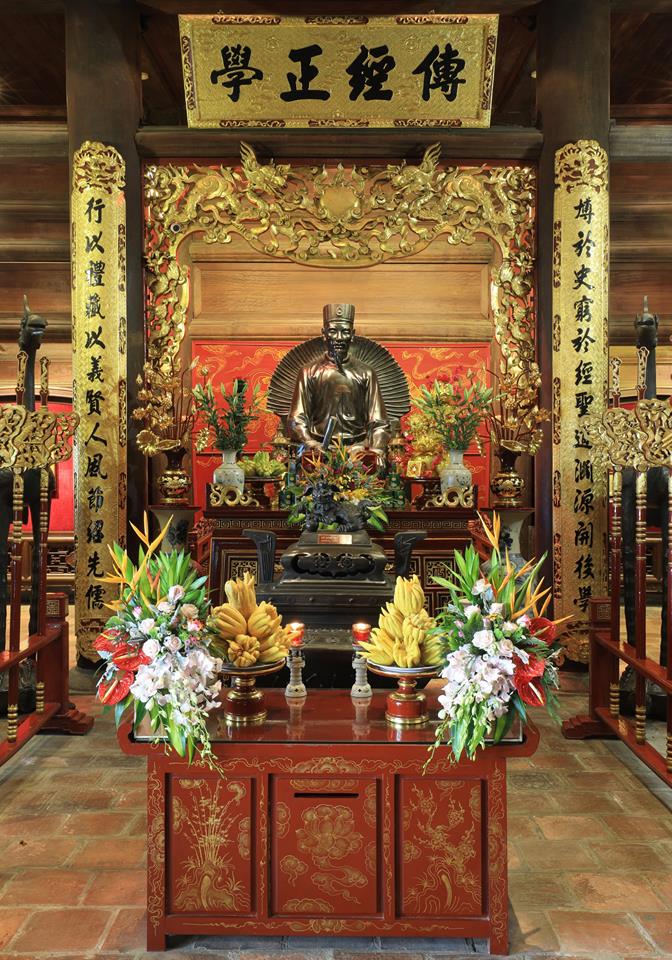
Chu Van An statue being worshiped in Văn Miếu-Quốc Tử Giám
The first part of mylife is associated with Huynh Cung school on the banks of the To river (To Lich). The school was built right on the mound adjacent to the two villages of Quang Liet and Cung Hoang (now belonging to Thanh Liet commune, Thanh Tri district, Hanoi). Chu An’s school soon became full of students from all over Thang Long Citadel, Kinh Bac province, Chau Ai province , Chau Hoan province, Thanh province, Nghe province... school full of students.
Well-known for his profound education, and strict discipline, Chu Van An not only imparted knowledge about benevolence, righteousness, rite, knowledge, and loyalty but also focused on forging his students' serious virtue in work, moral lessons, love and respect for their families, and to teach mandarins to respect people and care about their life ... etc.
His students always paid respect to him because he was full of integrity. His students, some of whom were even ministers or prime-minister, treated him as a teacher, and those who were invited in usually knelt to listen to him. Those who were not good mandarins would be driven away.
During Chu Van An’s tenuret Huynh Cung School, it should be emphasized that: Starting from the Ly dynasty (XI-XIII century), under Tran dynasty (XIII-XV century), Le (XV-XVIII century), Nguyen (XIX-XX century), a system of Confucian schools was established from the central to local levels, starting from Quoc Tu Giam Thang Long (1076) (the first University) and then spreading to provinces and districts throughout the country.
In 1281 the court established a school in Thien Truong province, in 1397 placed educational officials in Kinh Bac, Son Nam and Hai Dong; Schools and classes were opened throughout the regions from Thang Long Citadel, Red River basin, Thai Binh River to Thanh Hoa, Nghe An; By the end of the eighteenth century, most of the provinces and cities had public schools, all villages in the country had private schools, contributing to training of the talented men for the nation. Huynh Cung School, founded by Chu Van in Thanh Tri was one of the first private schools in Vietnam.
Translator: Le Huong
CHU VAN AN – THE STATUE OF A TEACHER IN THE HEART OF VIETNAMESE NATION
Every year from March to May hundreds of schools inside and outside of Ha Noi capital visit Quoc Tu Giam (the first University of Viet Nam) to offer incense to teacher Chu Van An and encourage students to study and follow Chu Van An. In 2018 over 700 schools with more than 120.000 students offered incense to honour scholar Chu Van An at Van Mieu – Quoc Tu Giam.
Chu Van An was a famous confucian scholar and a great teacher under the Tran dynasty. Chu Văn An was awarded the title Thai Học Sinh (doctor degree) under the Tran dynasty (1226 – 1400). However, he did not work as a mandarin, but instead founded a private school to train many scholars for the nation. He was renowned for his integrity and righteousness when he was a teacher at a private school, Director of Quoc Tu Giam (the first University) and even when he taught a prince. He devoted all his time to education.

The statue of Chu Van An at Van Mieu-Quoc Tu Giam
He always advocated that education was for everyone. Chu Van An directed people to a model of kindness and righteousness in their daily lives. He taught students that learning must be practiced, focusing on developing skills and knowledge, encouraging students to "think, arouse and discover the truth, as well as, the hidden ability of each person" in order to fulfill their responsibilities to the family and society.
Throughout our country, there are currently 50 schools named Chu Van An and 22/64 provinces and cities have roads and streets named Chu Van An. On the occasion of the 650th anniversary of his death, the scholar Chu Van An Profile was developed by the Hanoi Department of Culture and Sport and submitted to UNESCO for expected approval in April 2019.
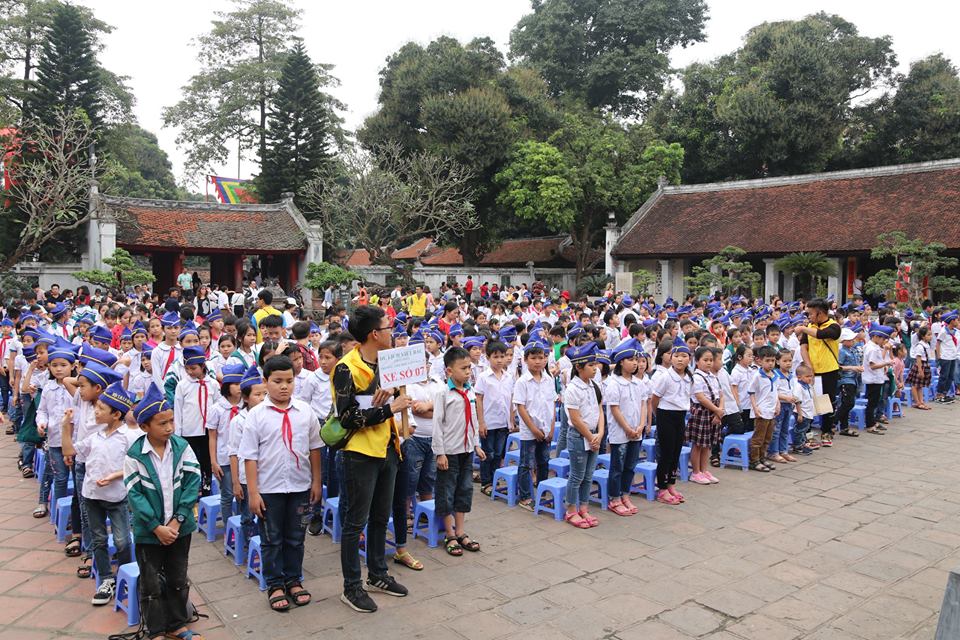
Pupils in the incense offering ceremony to commemorate teacher Chu Van An
(Data extracted: Yearbook of Chu Van An Scientific Workshop - The Centre for Scientific and Cultural Activities Van Mieu-Quoc Tu Giam)
Translator: Le Huong
TƯ NGHIỆP QUỐC TỬ GIÁM CHU VĂN AN
Chu Văn An (1292-1370) sinh tại làng Quang Liệt, huyện Thanh Đàm (nay là thôn Văn, xã Thanh Liệt, huyện Thanh Trì, thành phố Hà Nội, Việt Nam). Ông là một nhà giáo mẫu mực của dân tộc Việt Nam. Cuộc đời Chu Văn An gắn liền với việc dạy học, làm thầy ở ba không gian: quê hương Thanh Liệt (Thanh Trì), Quốc Tử Giám (Thăng Long) và Chí Linh (Hải Dương). Năm 1324, Chu Văn An được vua Trần Minh Tông mời ra giữ chức Tư nghiệp trường Quốc Tử Giám. Quốc Tử Giám - Trung tâm giáo dục cao cấp nhất của Việt Nam thời quân chủ để đào tạo nhân tài cho đất nước. Chu Văn An chính là vị Tư nghiệp Quốc Tử Giám đầu tiên.
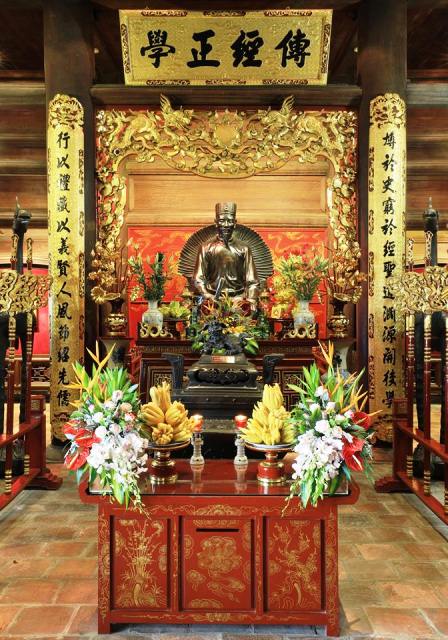
Tượng thờ Tư nghiệp Quốc Tử Giám Chu Văn An tại Khu Thái Học
Chu Văn An tấm gương mẫu mực về đạo đức, trí tuệ và tinh thần, trách nhiệm với đất nước. Ông không chỉ dạy chữ và tri thức mà còn dạy làm người (tư tưởng, đạo đức, phẩm tiết) dạy học trò biết ứng xử với xã hội, với chính mình và với thiên nhiên - đây cũng chính là giá trị nhân sinh trong thời đại ngày nay.
Sinh thời, Chu Văn An luôn đề cao vai trò của tri thức, của giáo dục, đào tạo và của văn hóa trong công cuộc xây dựng quốc gia, dân tộc vững mạnh, yêu hòa bình. Nhân dân Việt Nam lưu truyền câu nói của ông: “Ta chưa từng nghe nước nào coi nhẹ sự học mà khá lên được”.
Hiện tại có tới 22/64 tỉnh, thành phố trải dài trên khắp đất nước Việt Nam có đường, phố mang tên của ông gồm: Hà Nội, Hưng Yên, Hải Dương, Hải Phòng, Quảng Ninh, Lạng Sơn, Thái Nguyên, Vĩnh Phúc, Lào Cai, Thái Bình, Ninh Bình, Thanh Hóa,… Trong số 22 tỉnh, thành phố có tên Chu Văn An có 09 phố, 23 đường.
Bên cạnh đường, phố, còn có rất nhiều trường học ở các cấp mang tên Chu Văn An. Trong cả nước có 50 trường học mang tên Chu Văn An gồm: 10 trường Tiểu học, 19 trường Trung học Cơ sở, 17 trường Trung học phổ thông, 03 trường Liên cấp và 01 trường Đại học. Năm 2018, Trung tâm Hoạt động VHKH Văn Miếu - Quốc Tử Giám được giao nhiệm vụ xây dựng hồ sơ để trình UNESCO đề nghị cùng kỷ niệm 650 năm ngày mất của Chu Văn An vào năm 2020.
